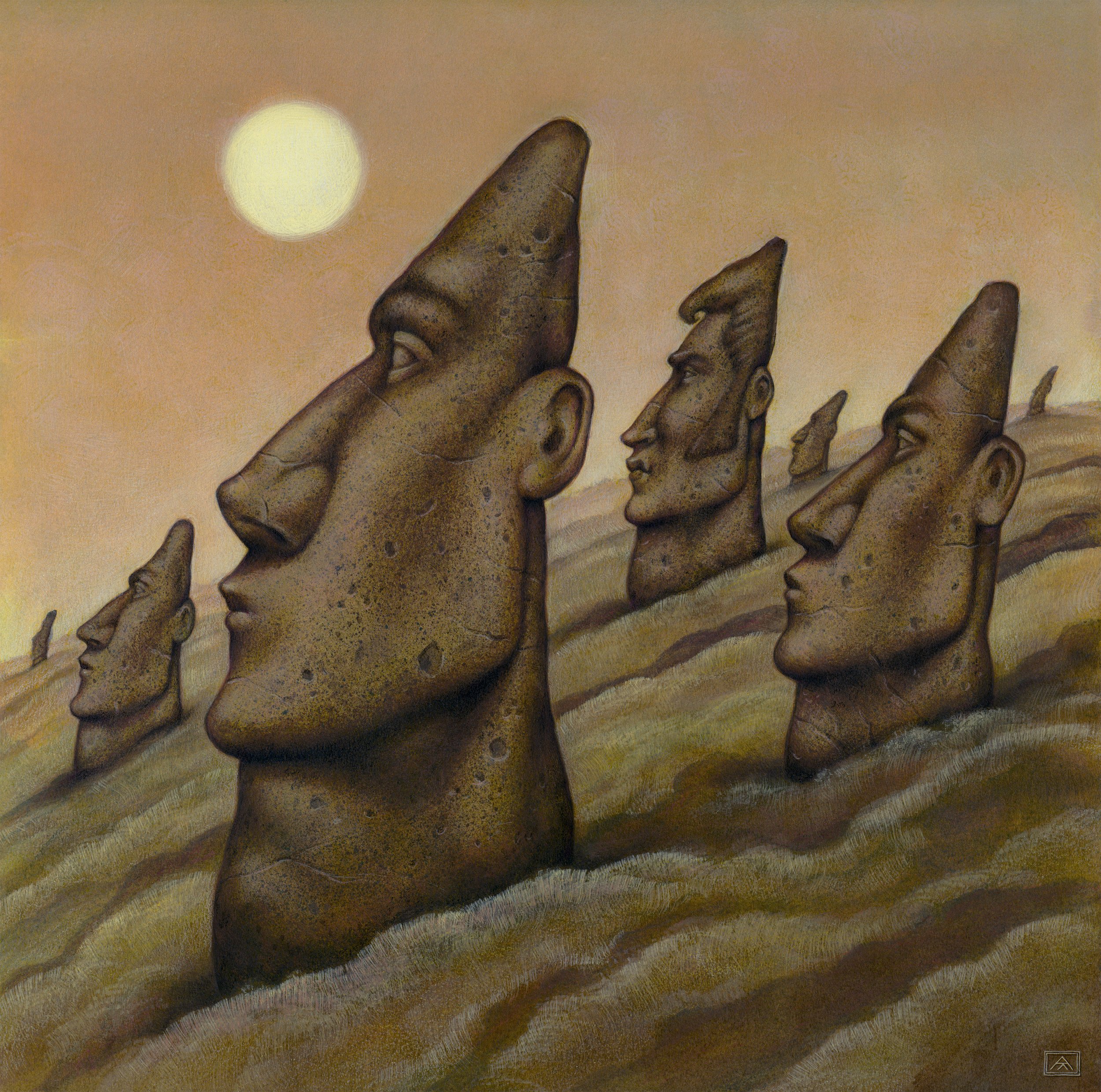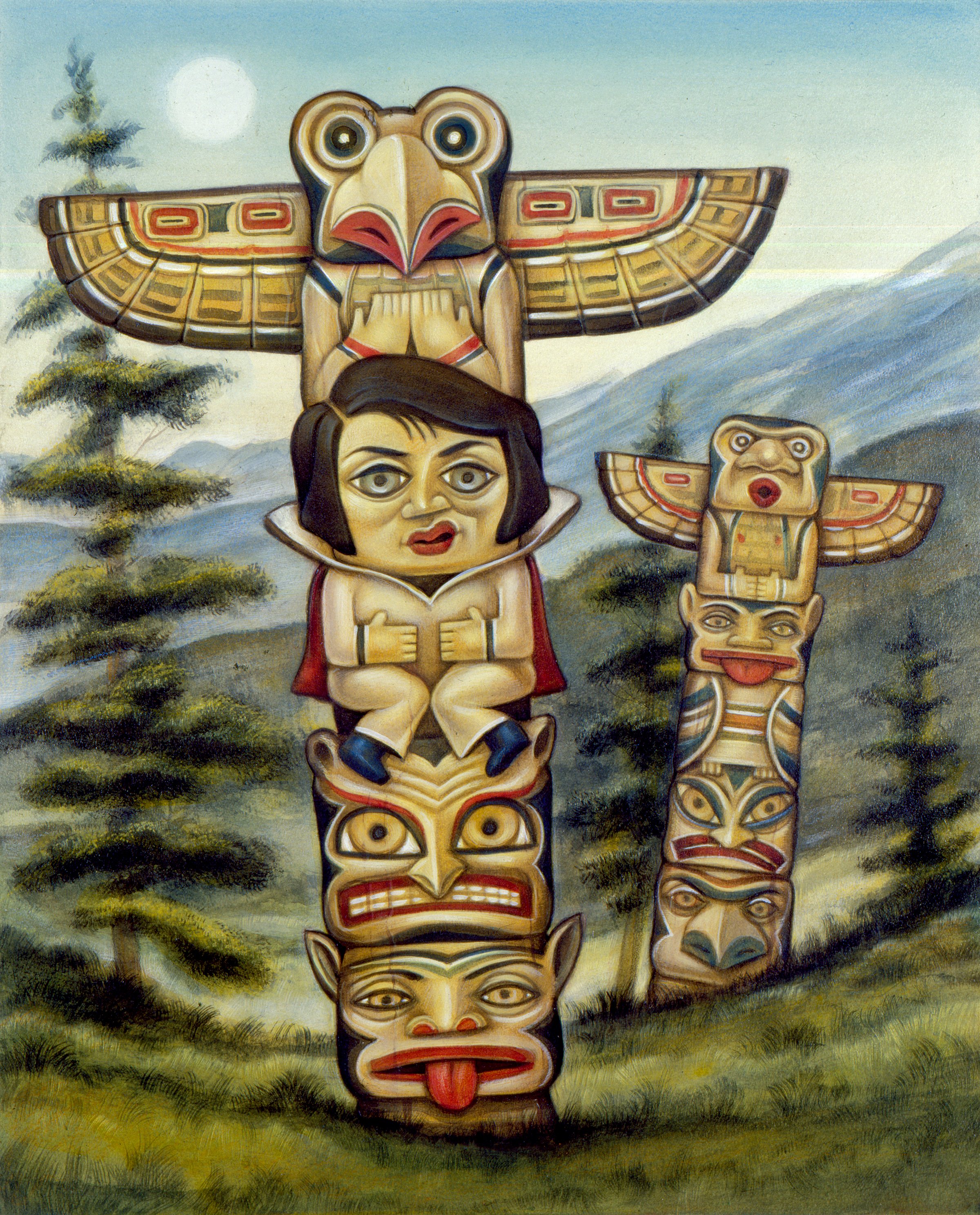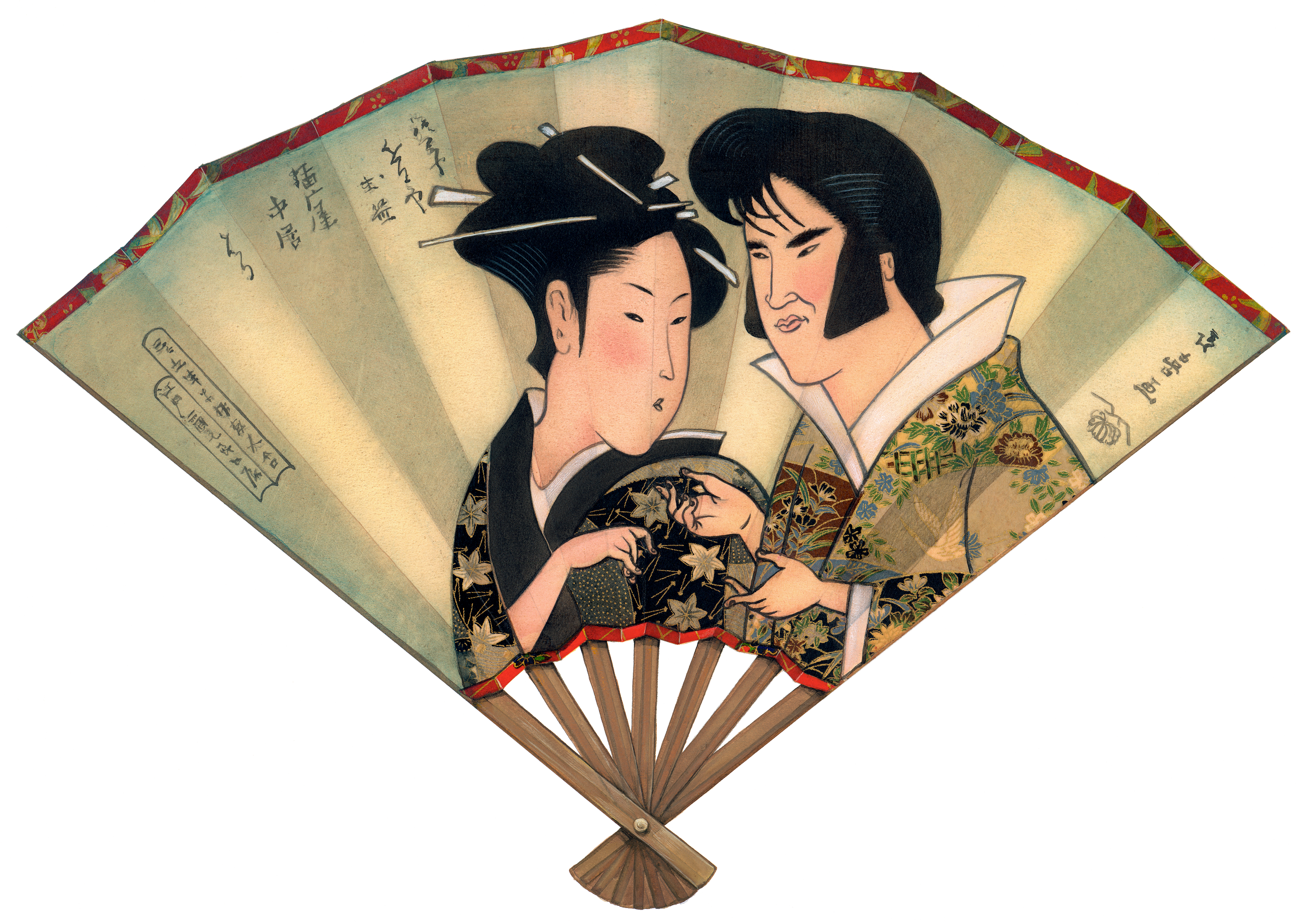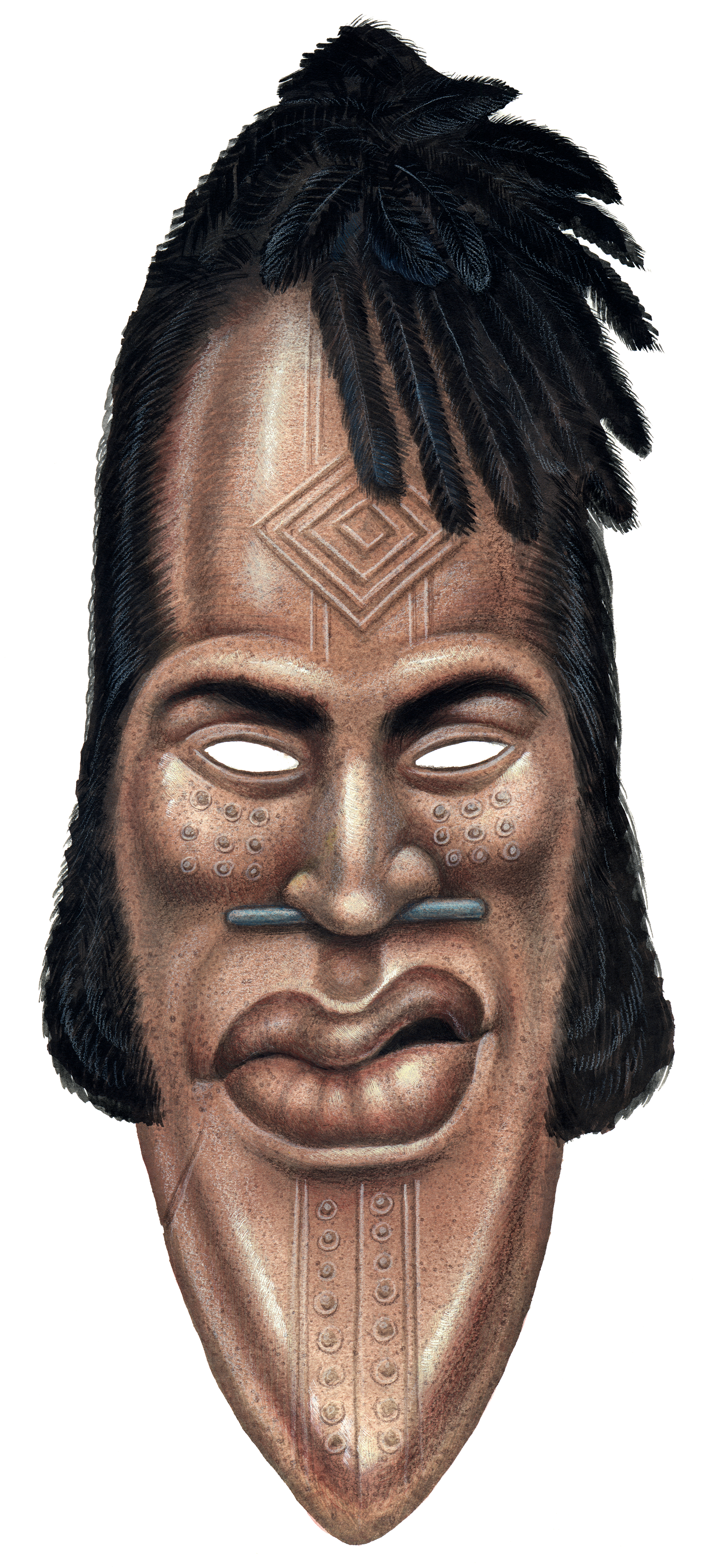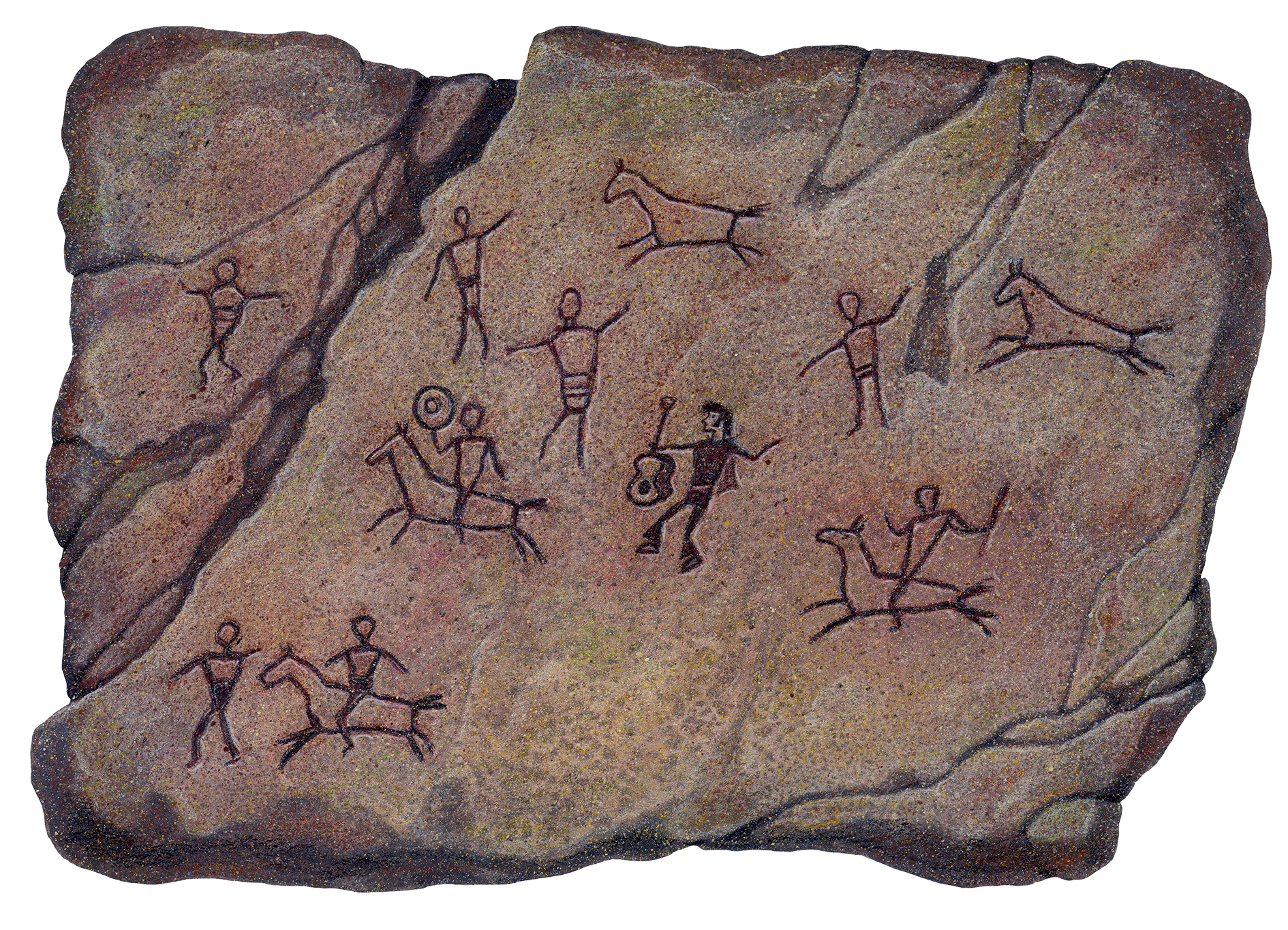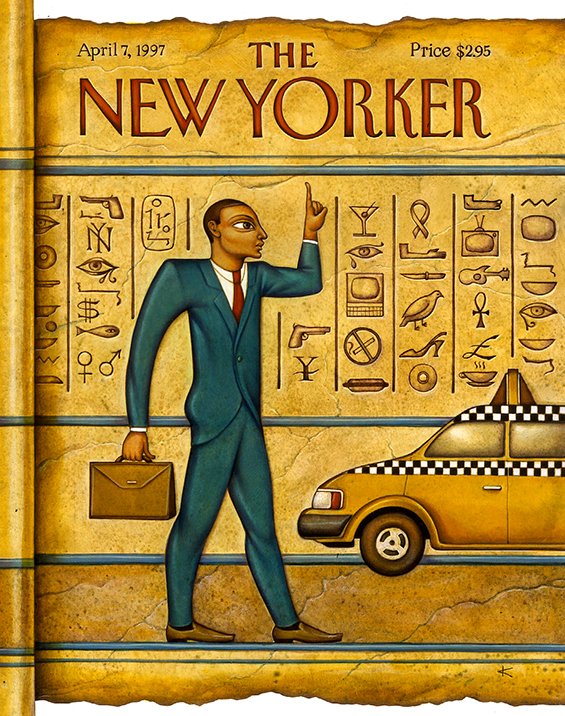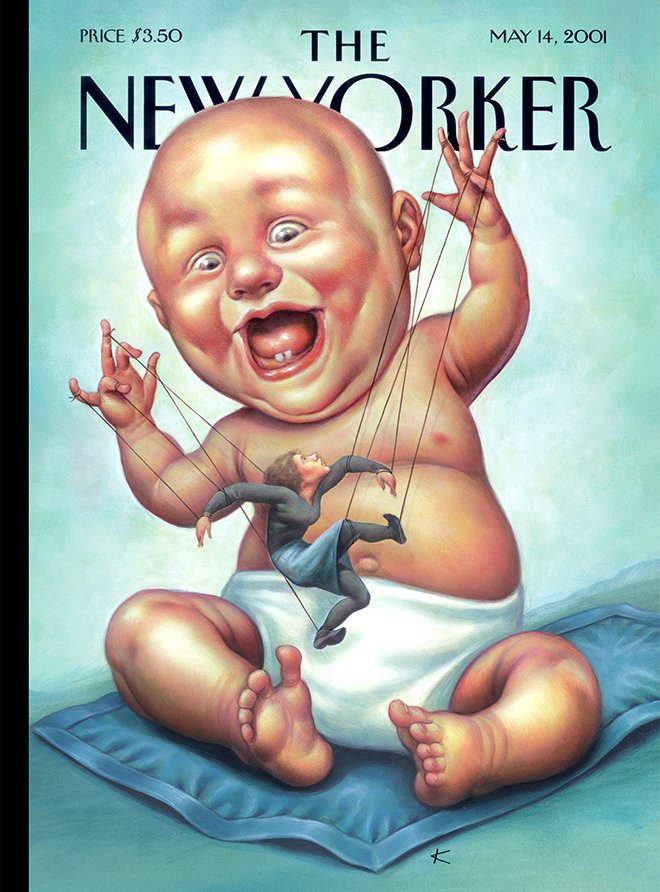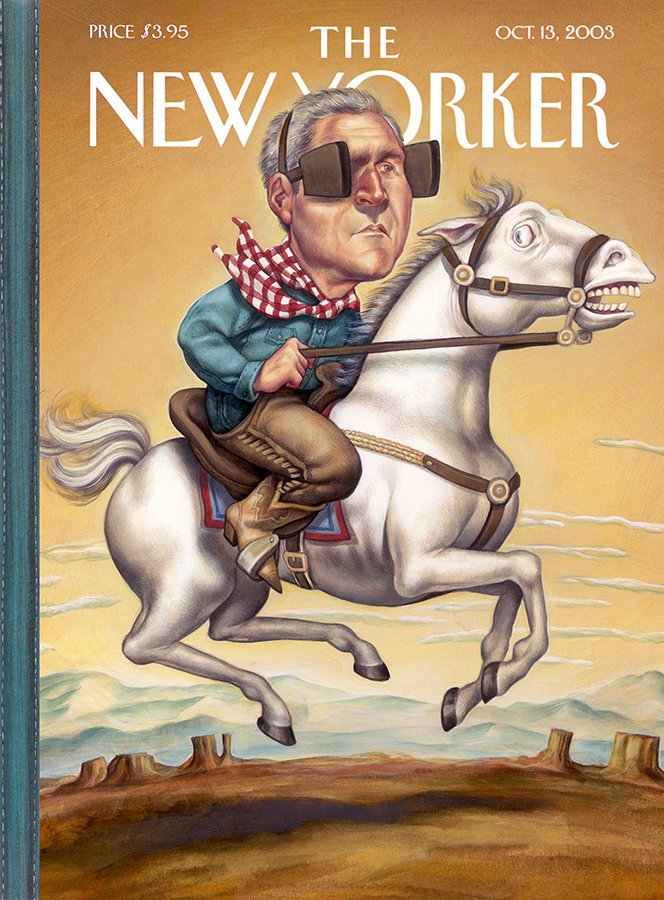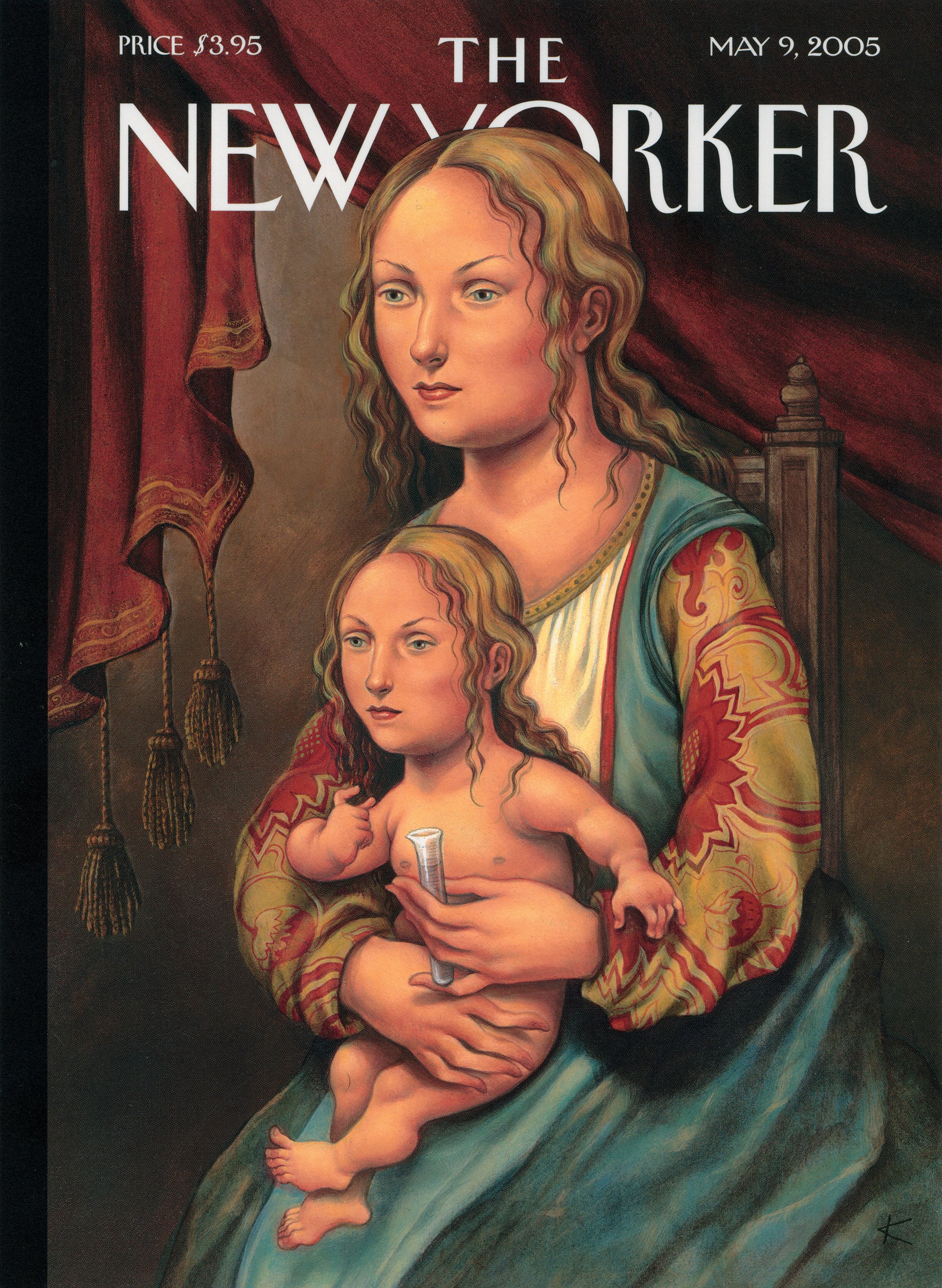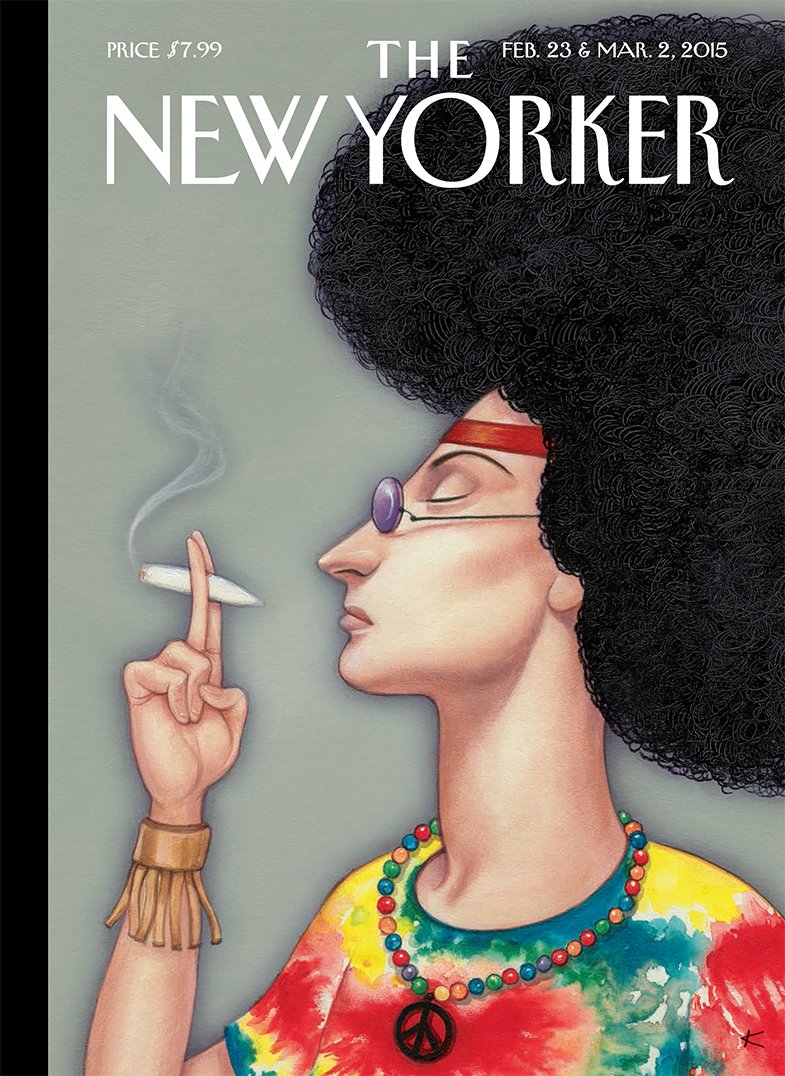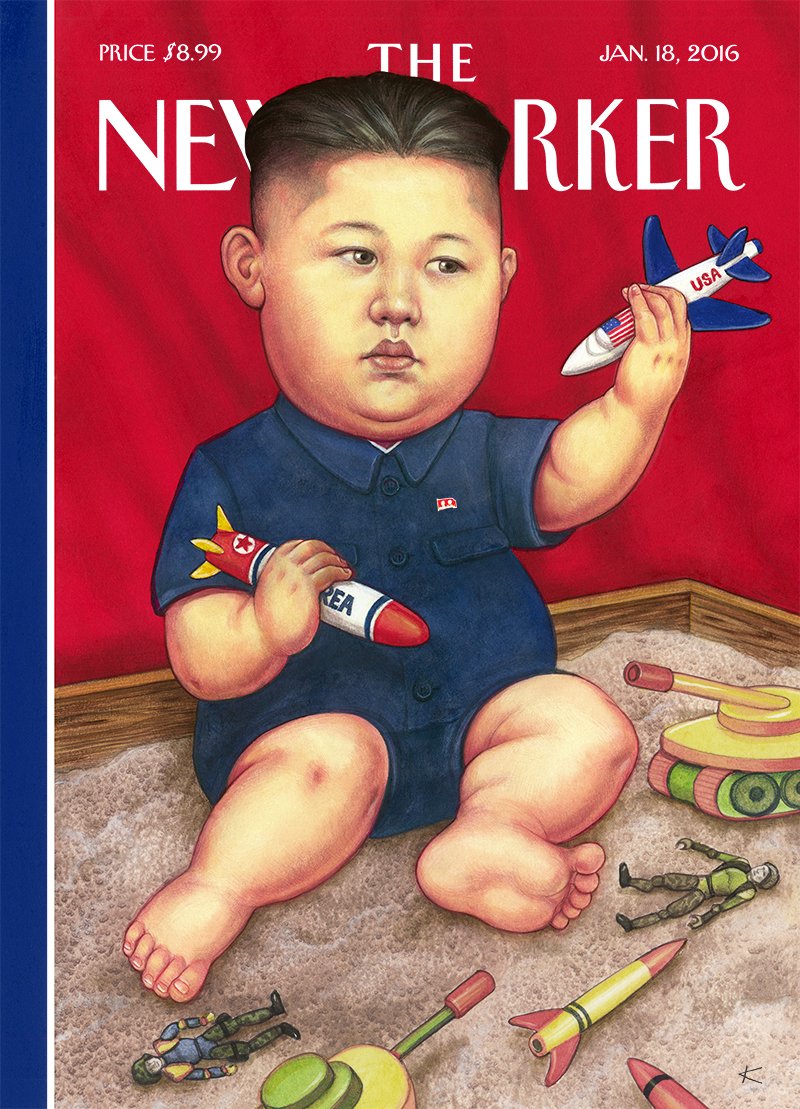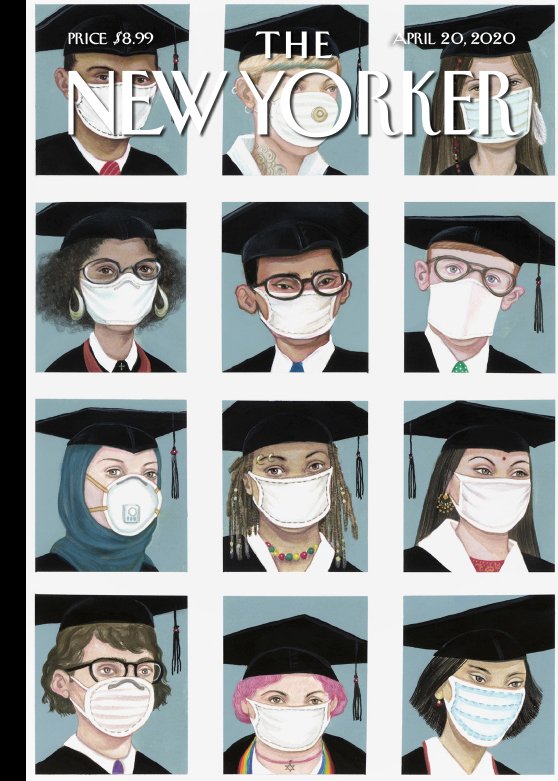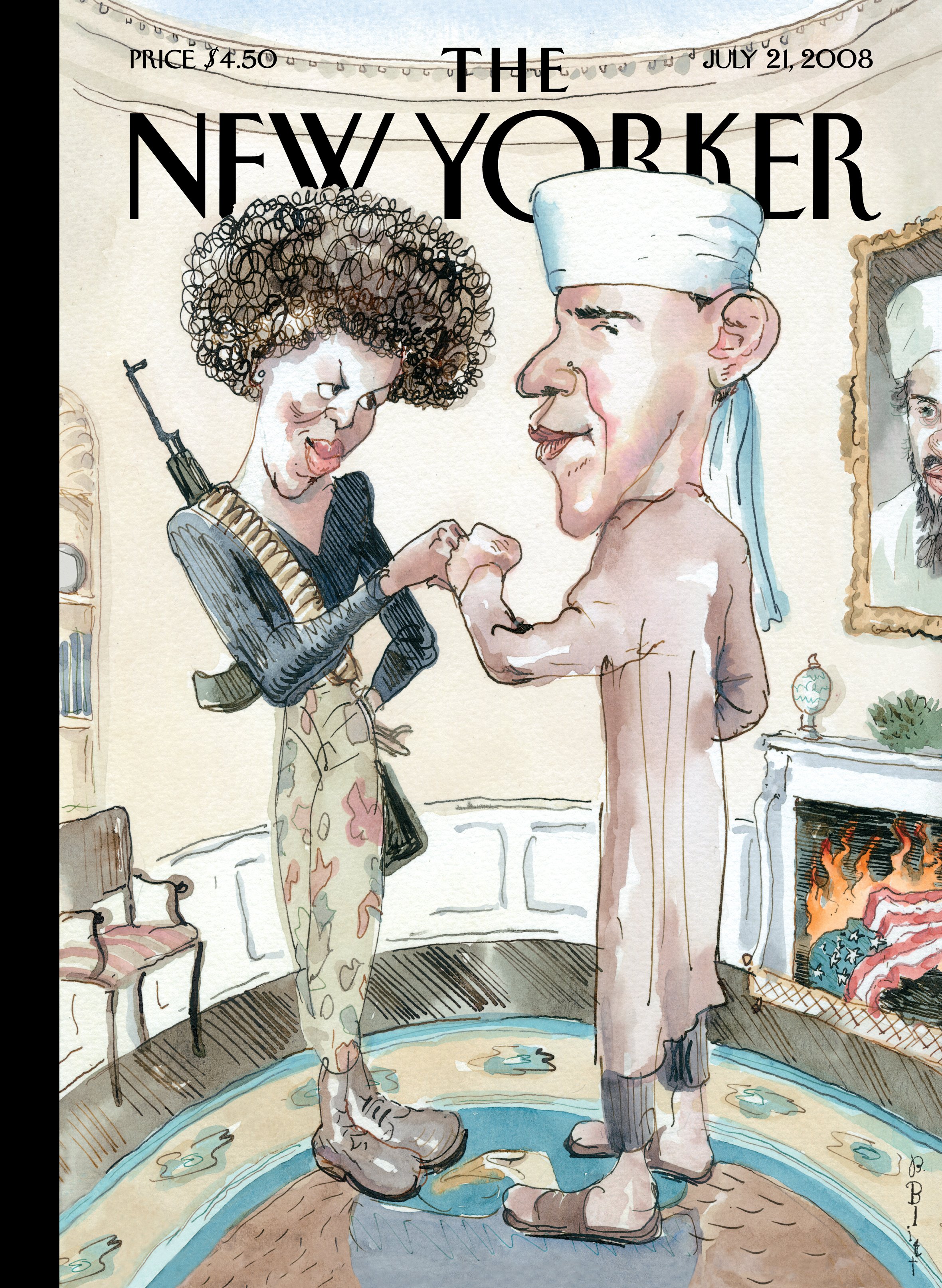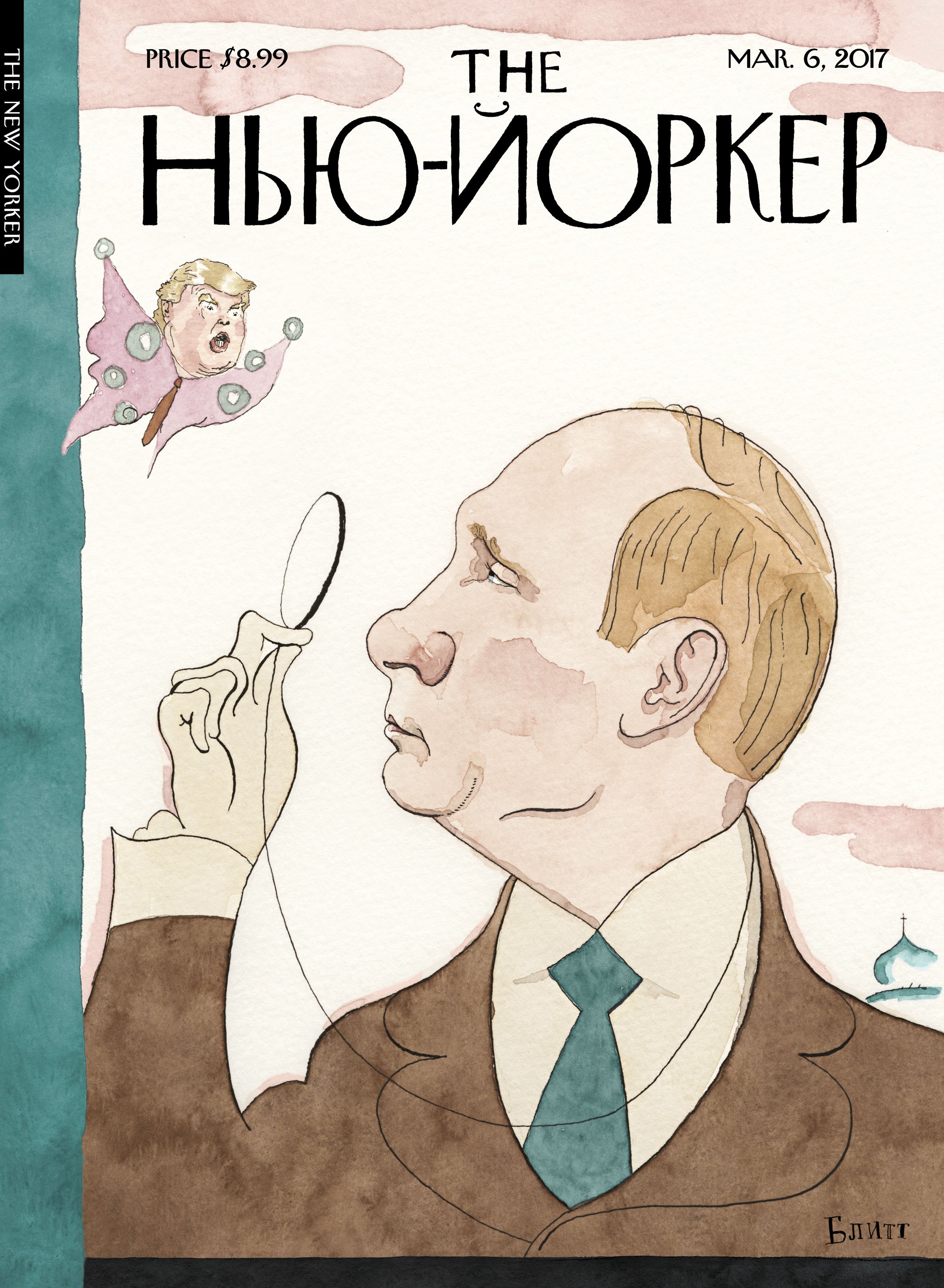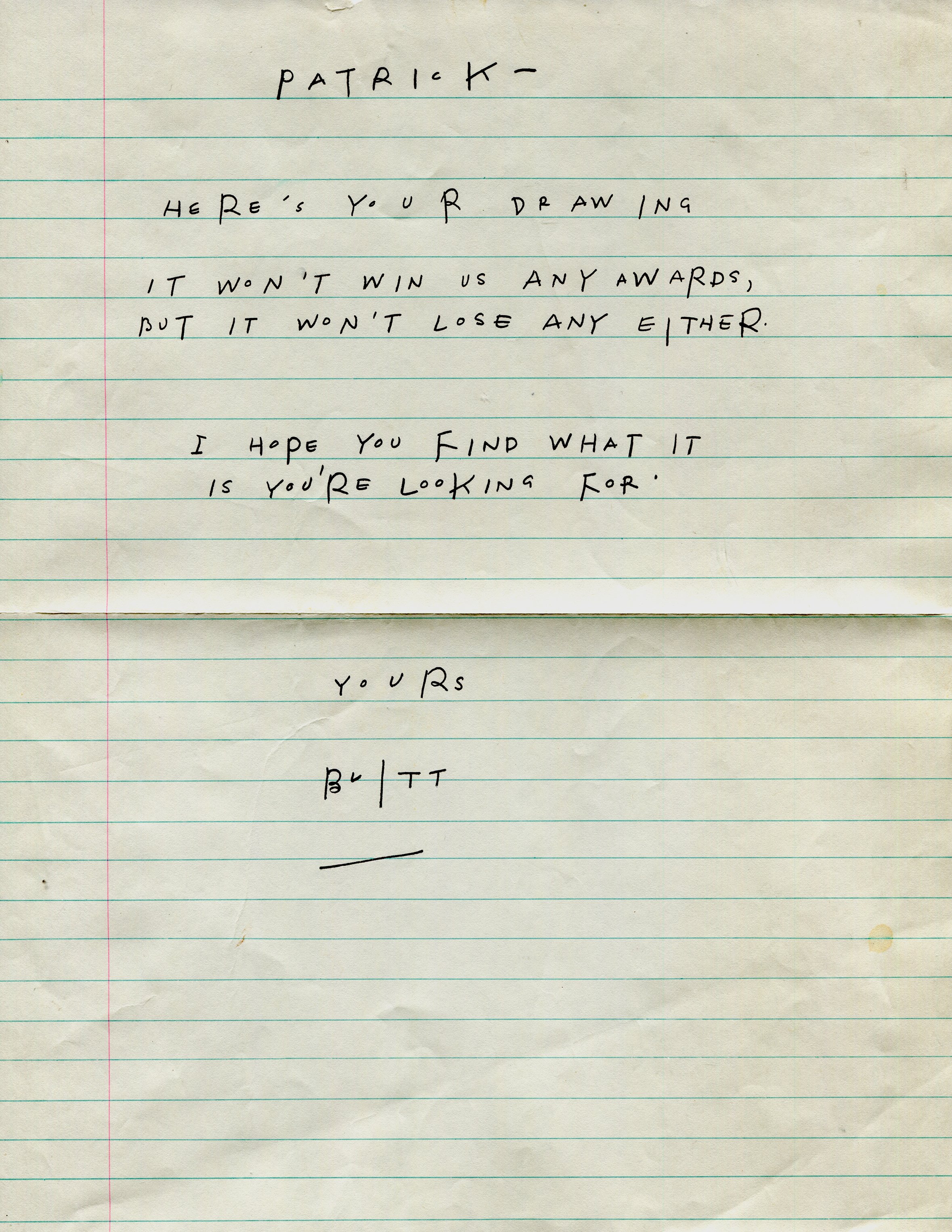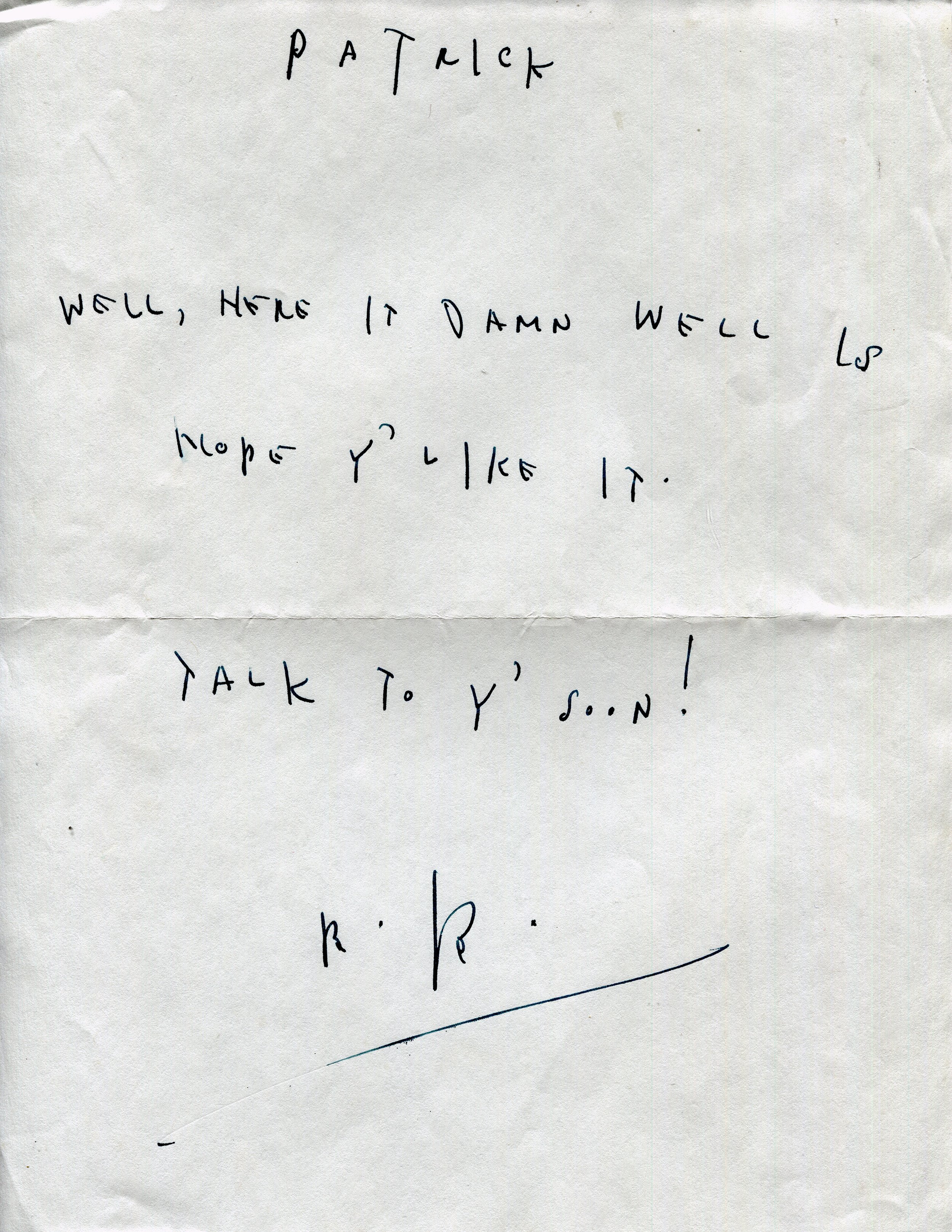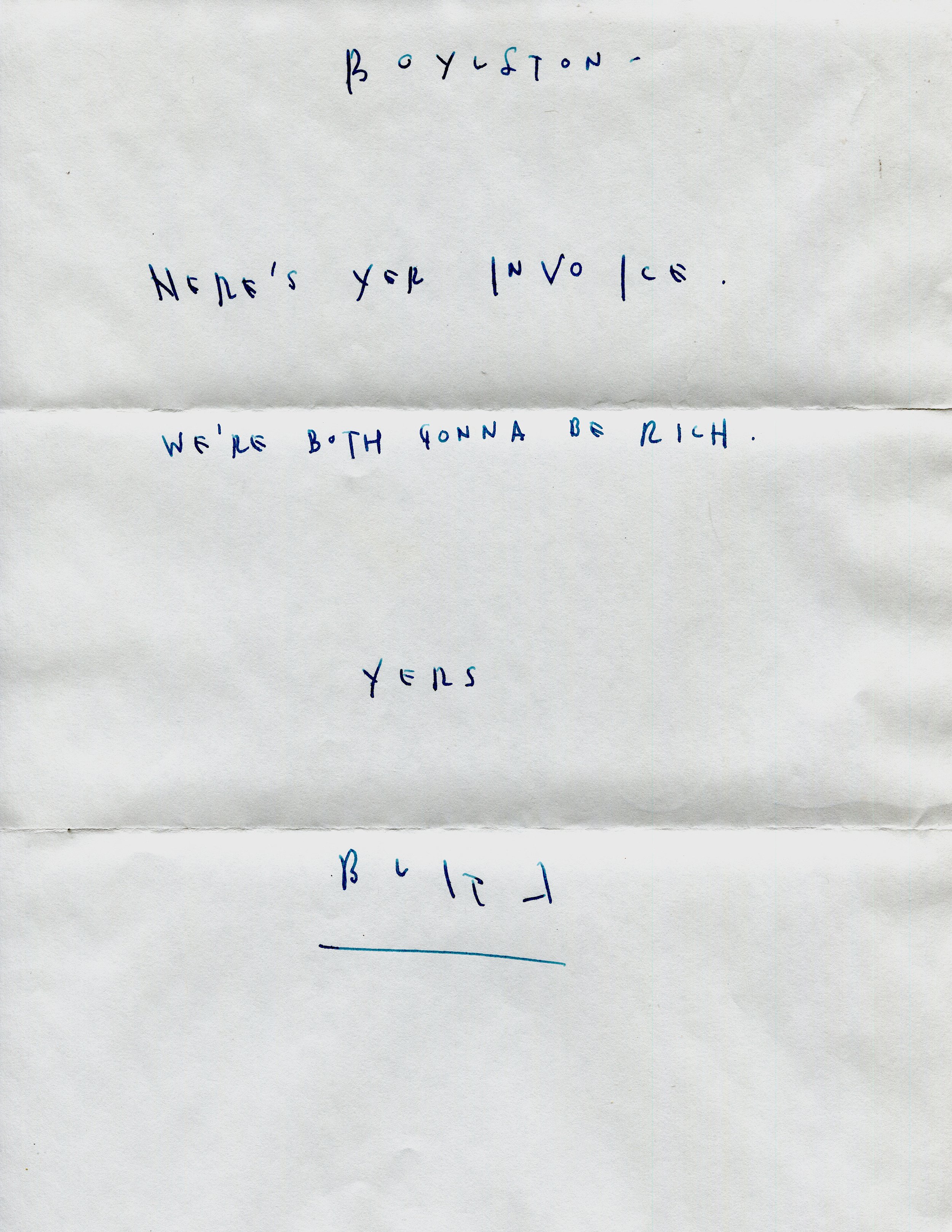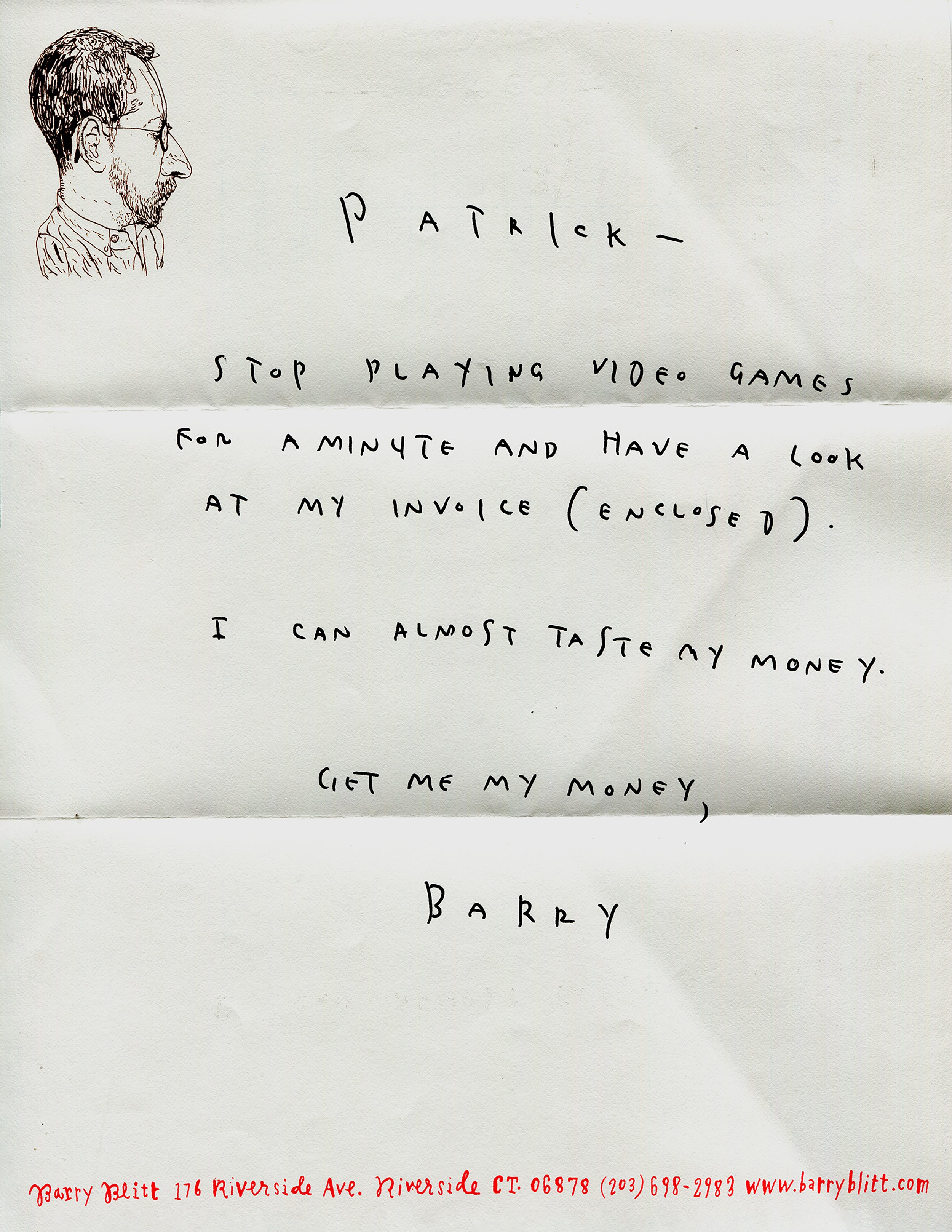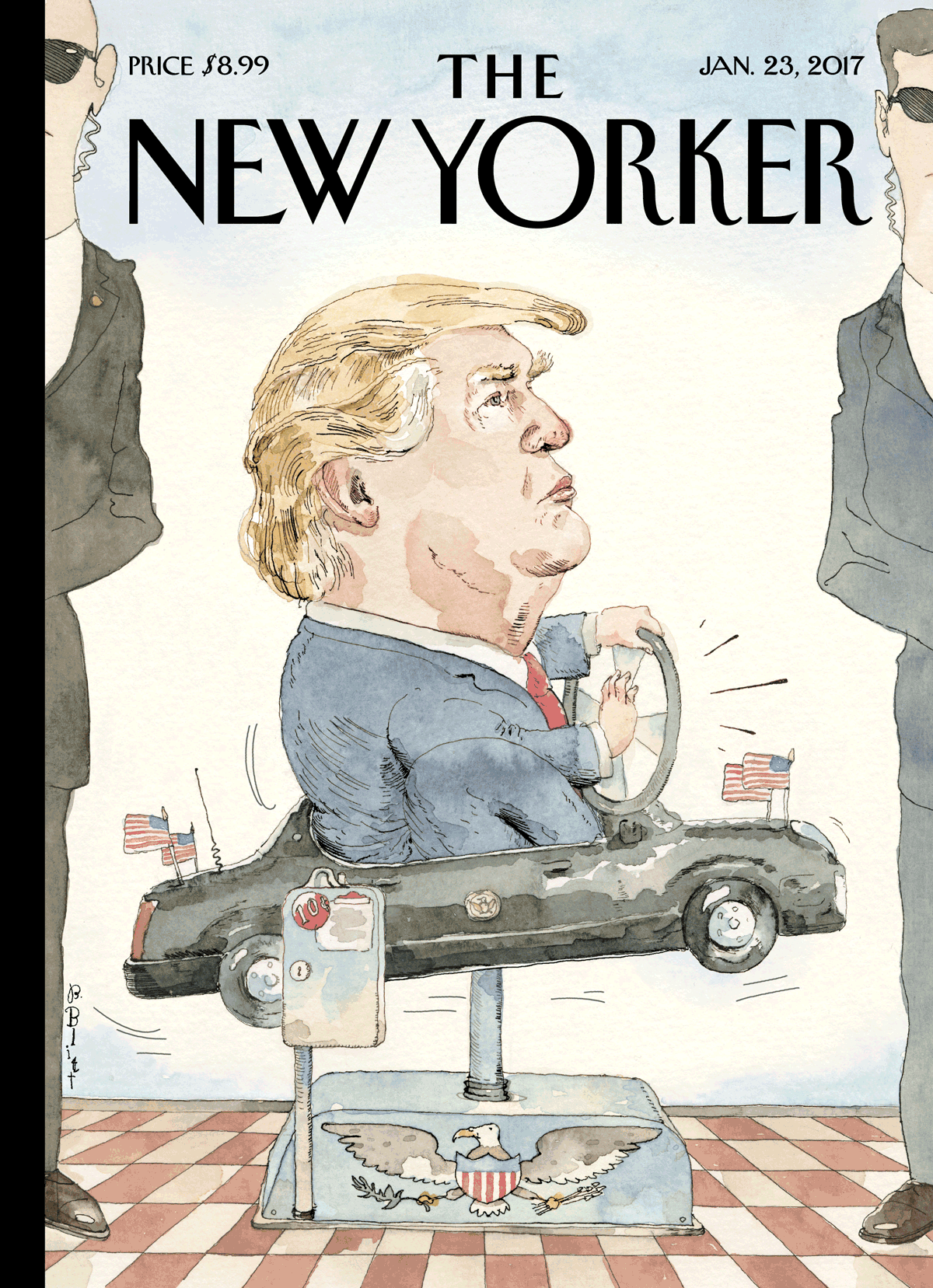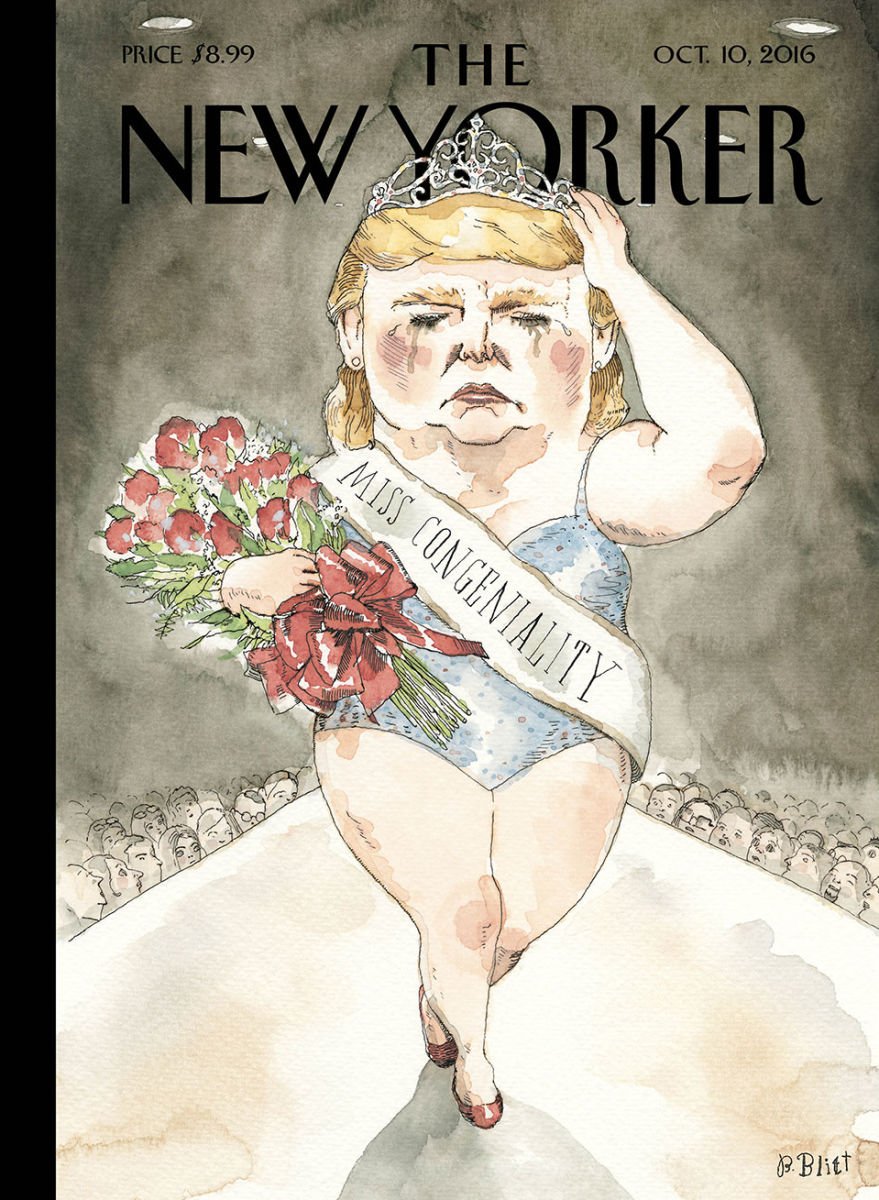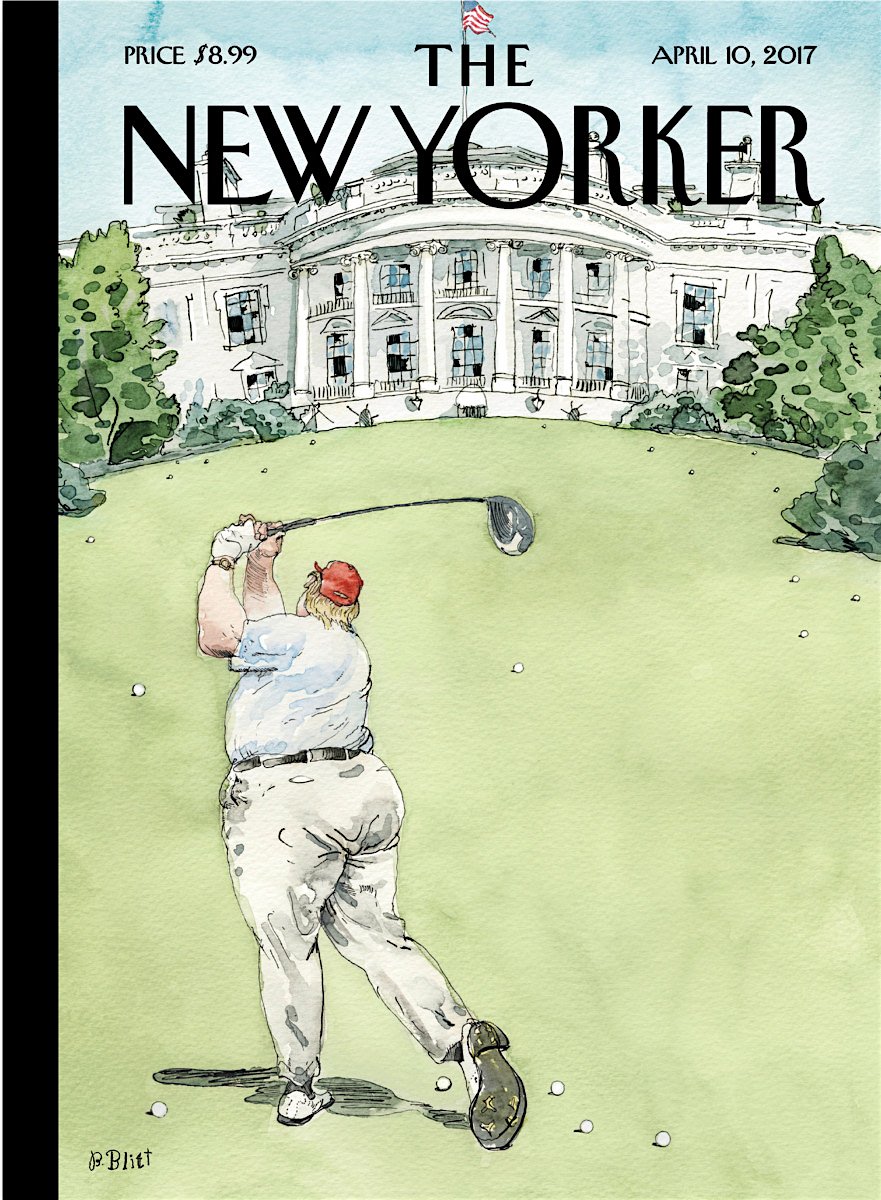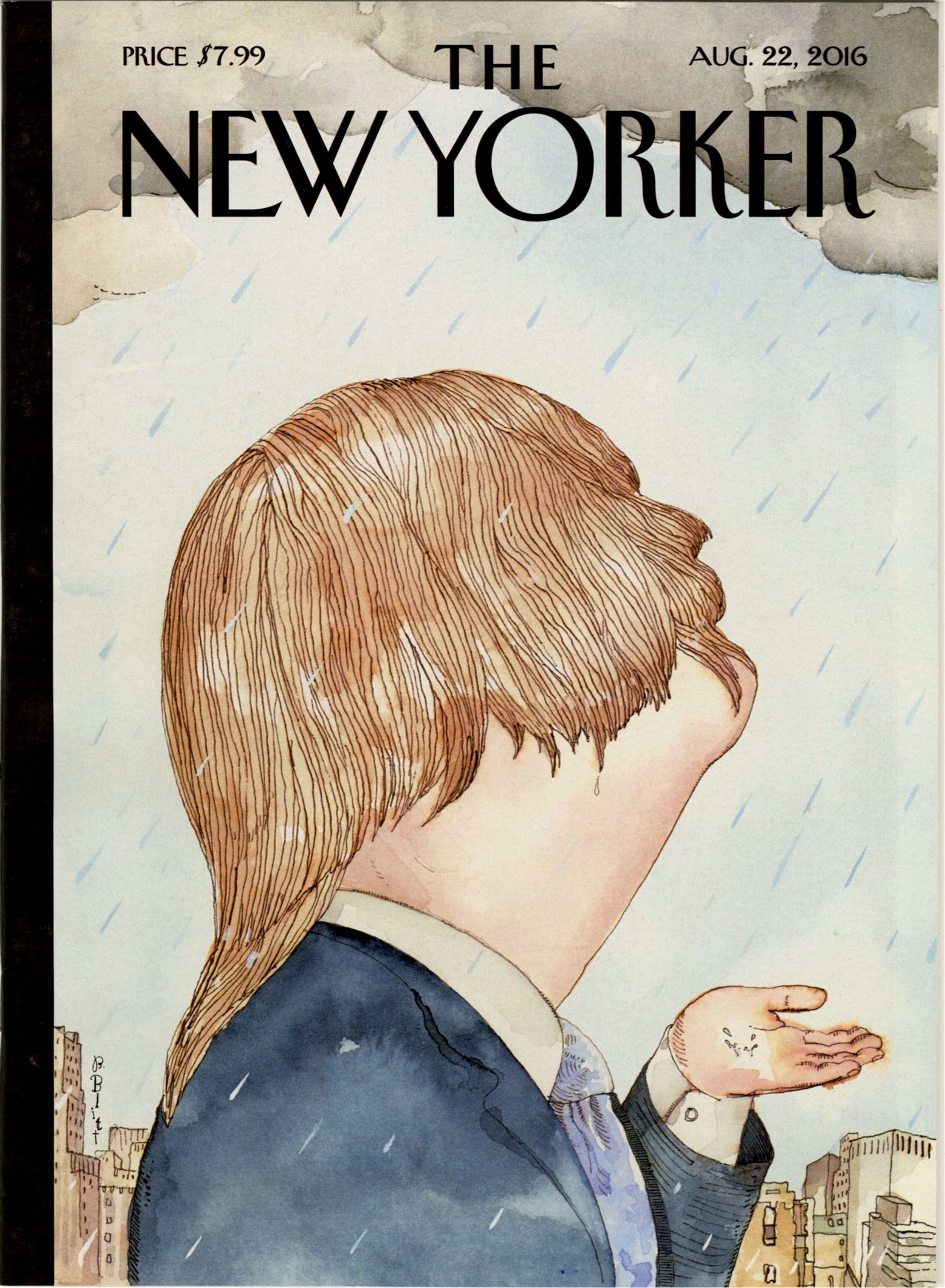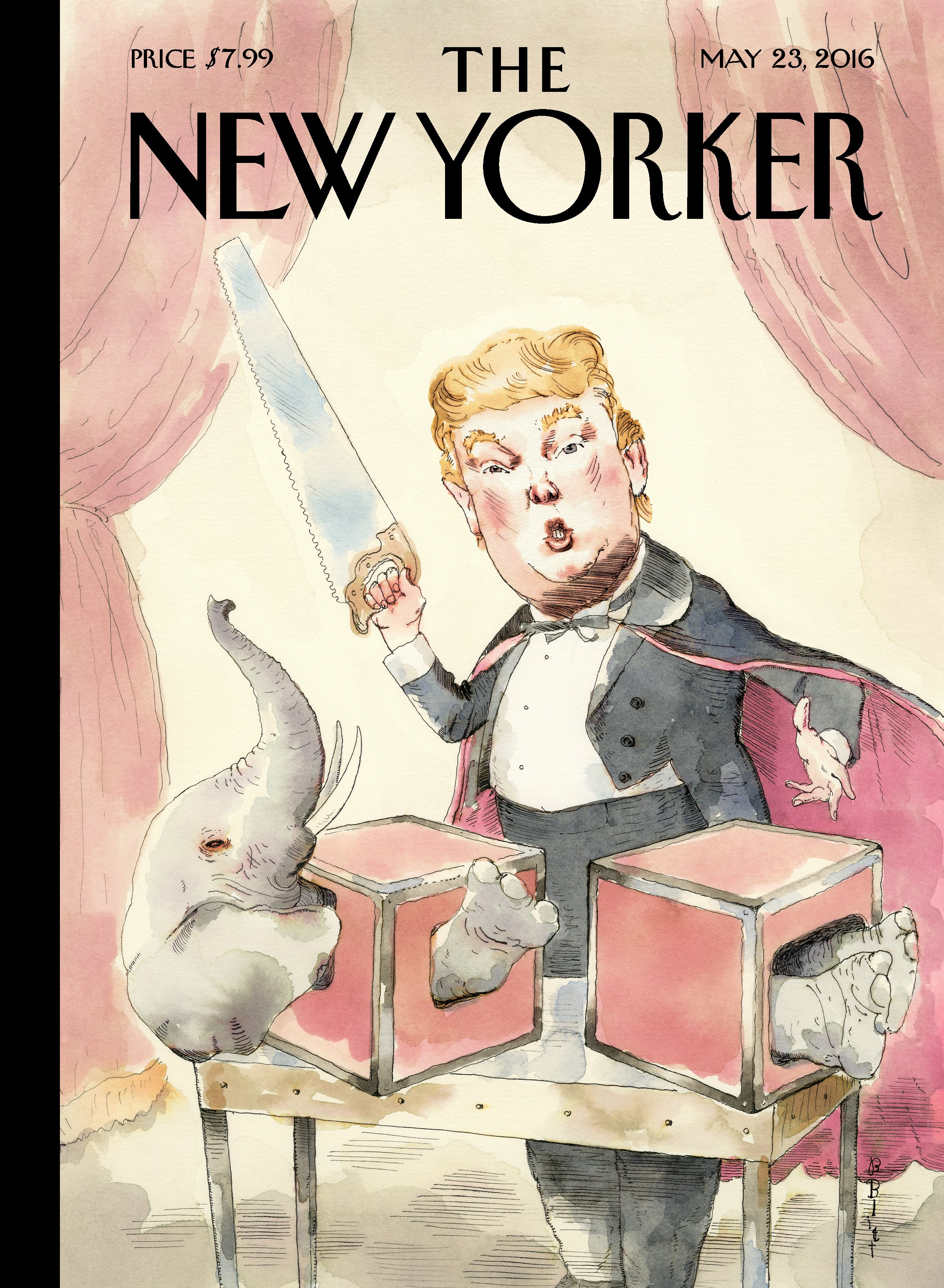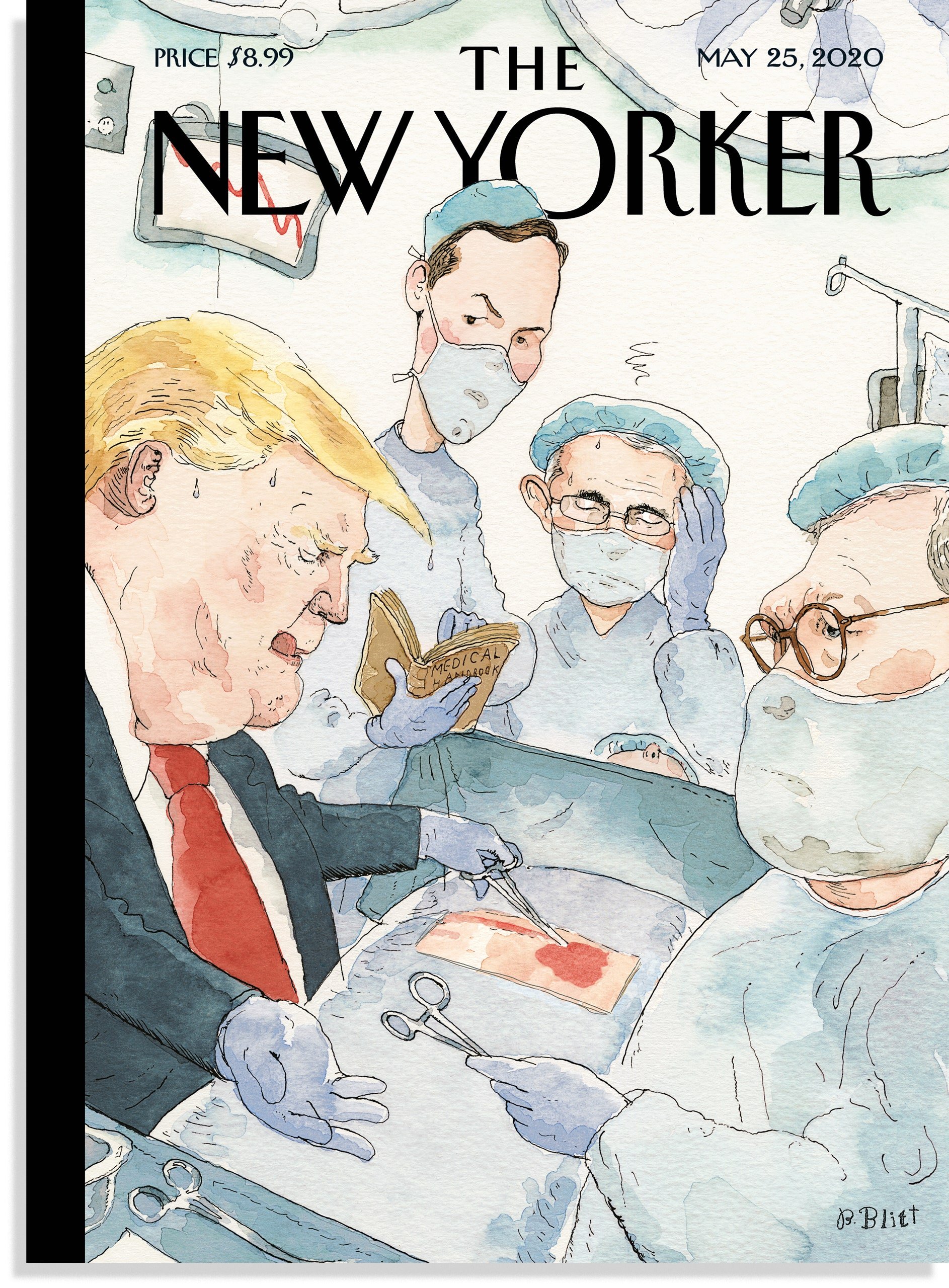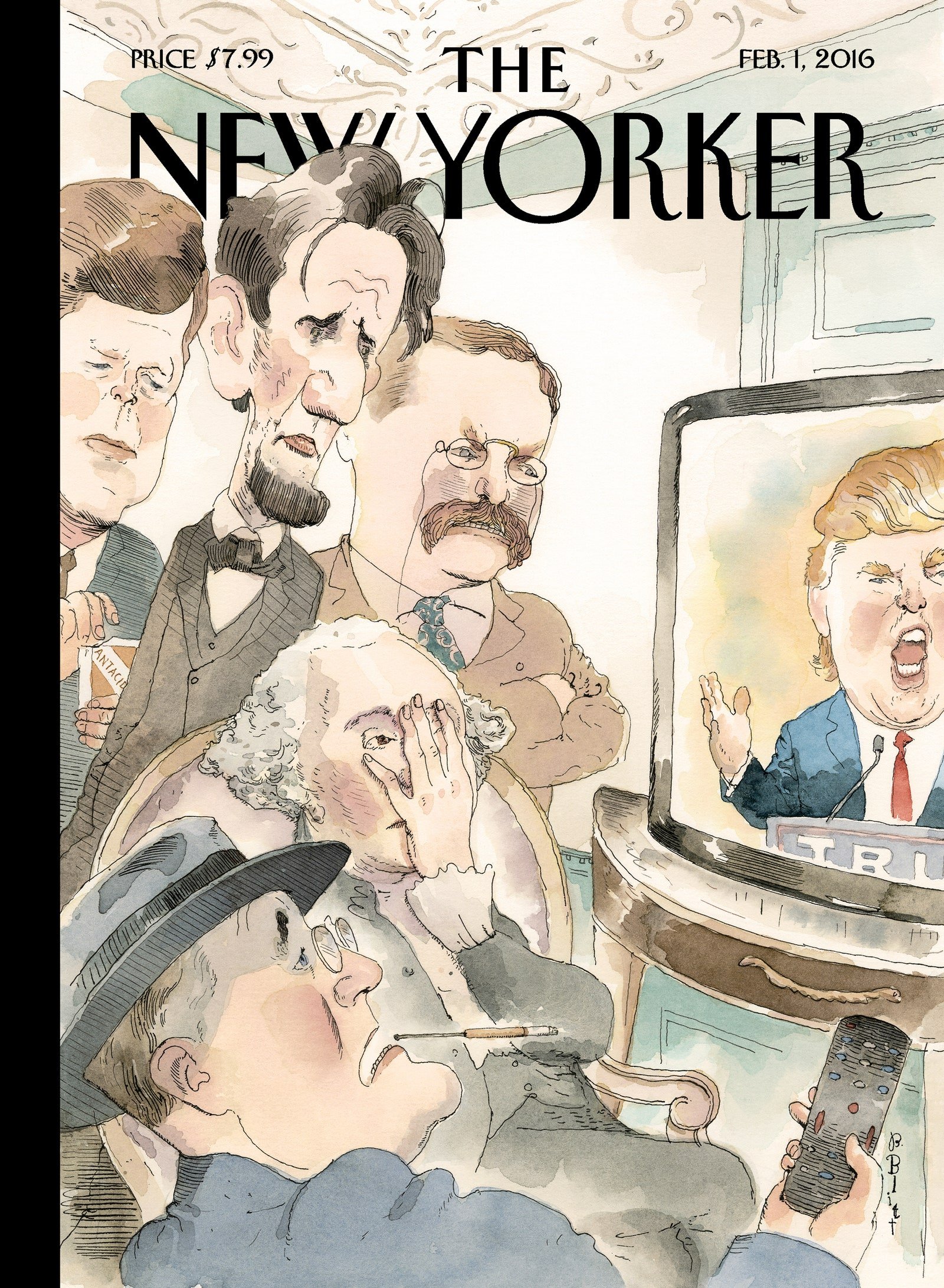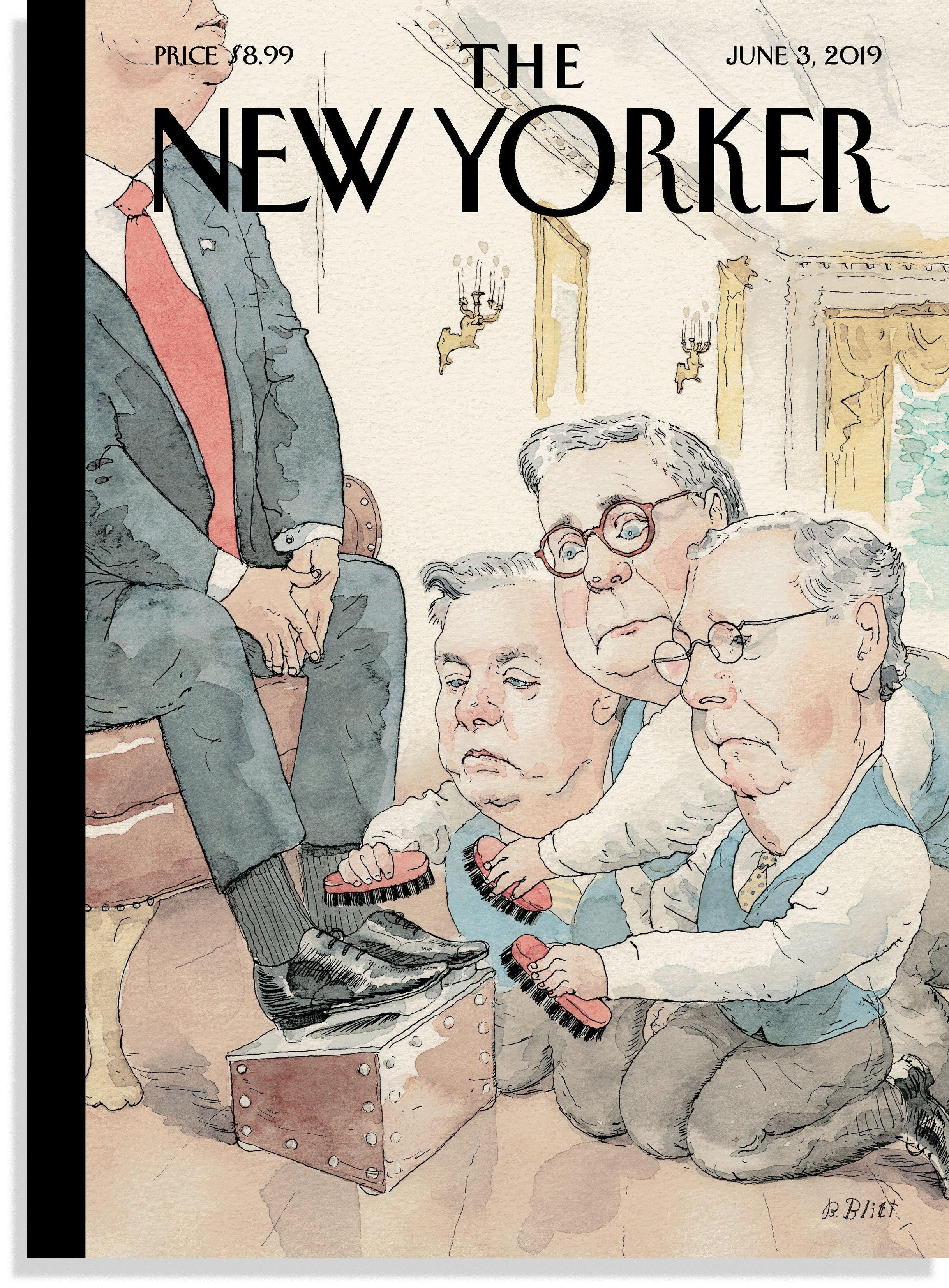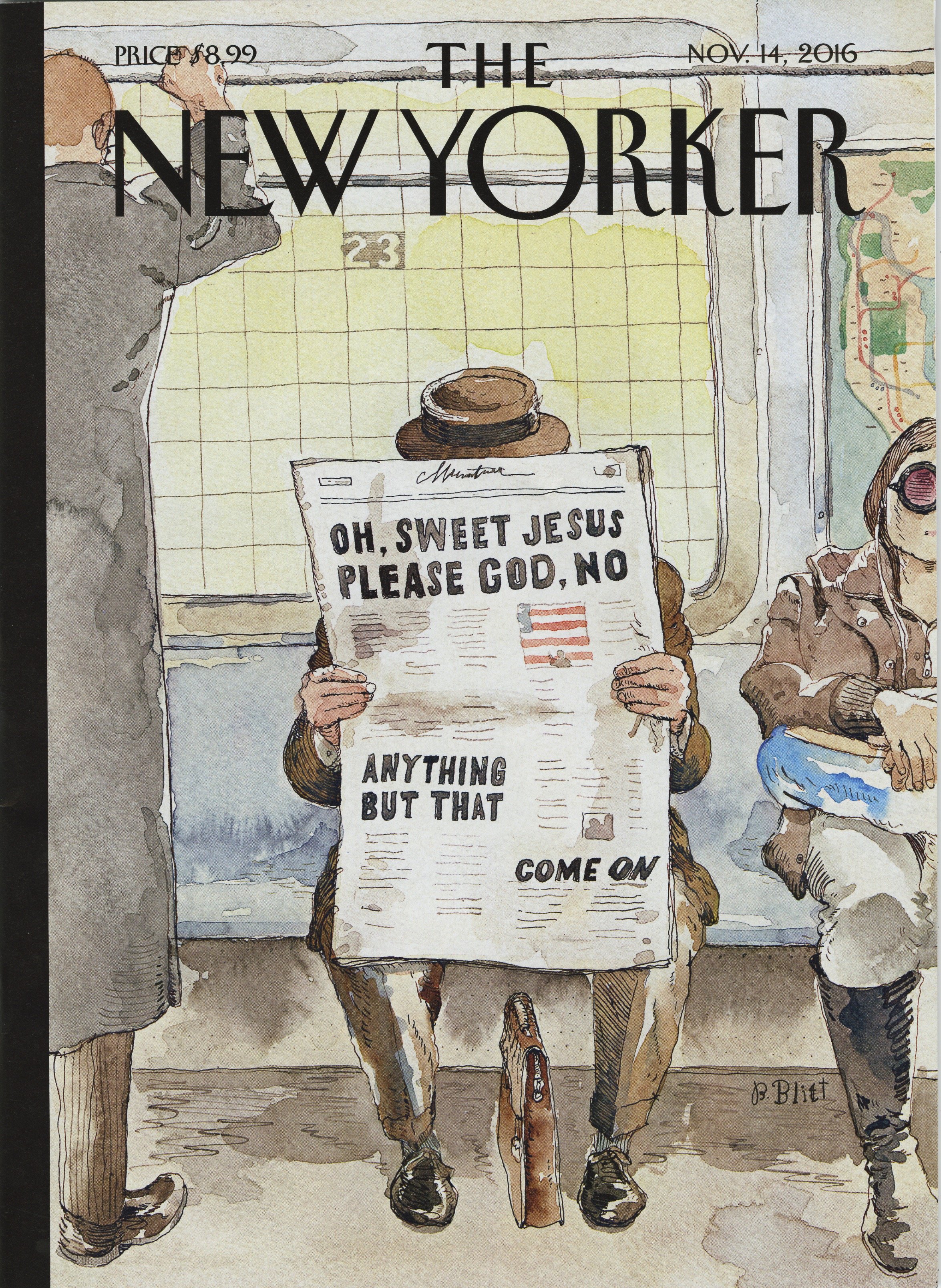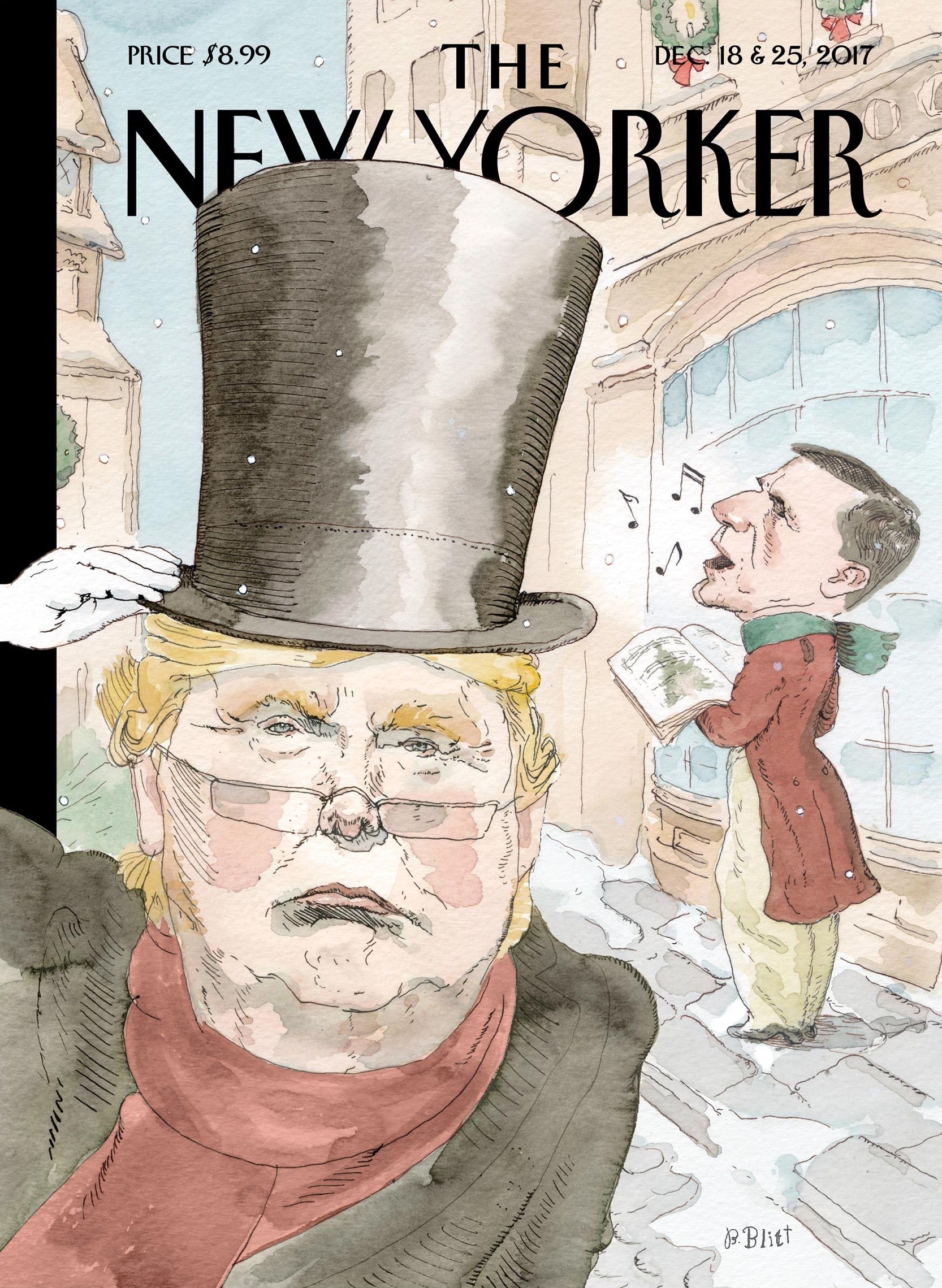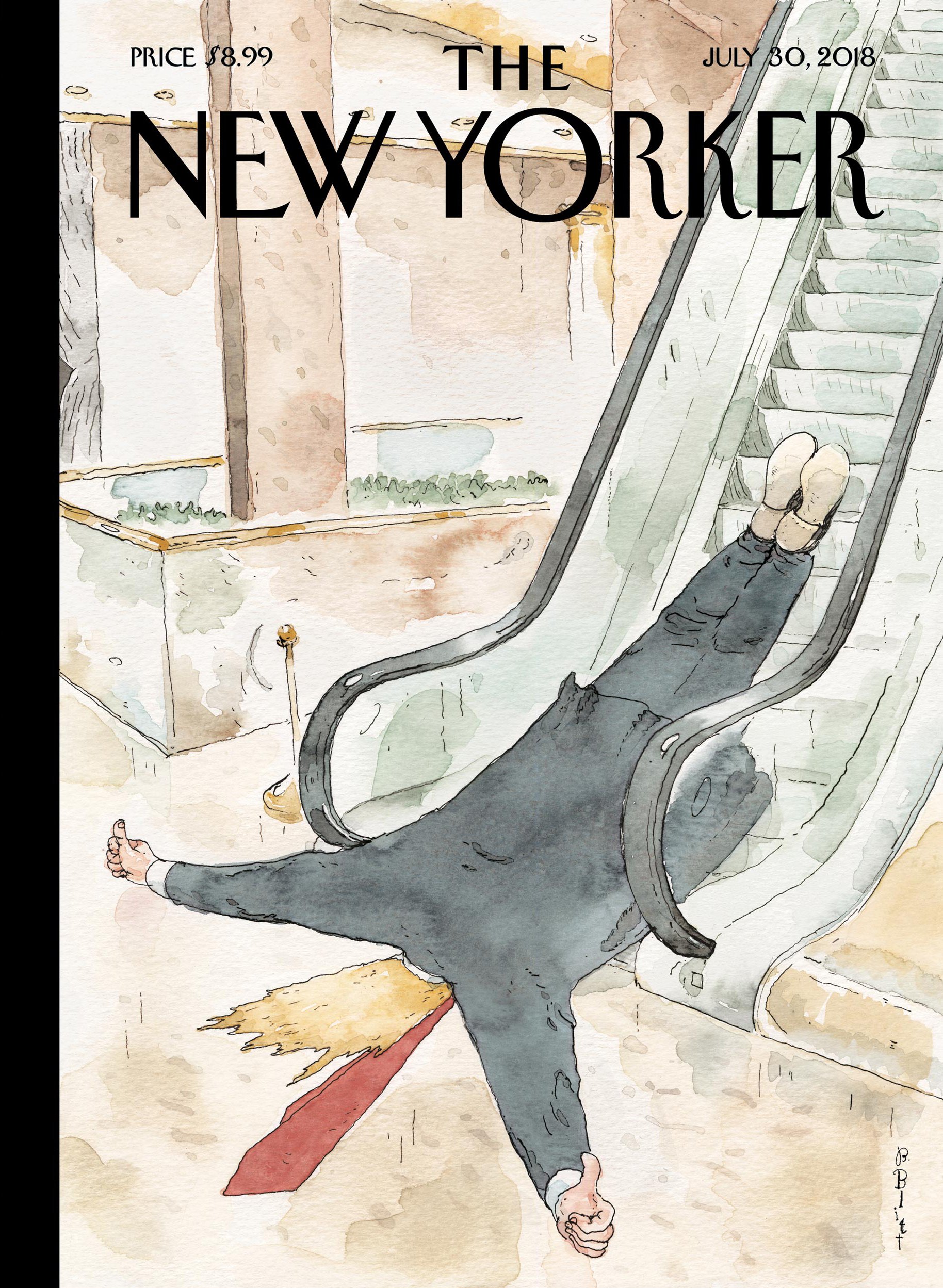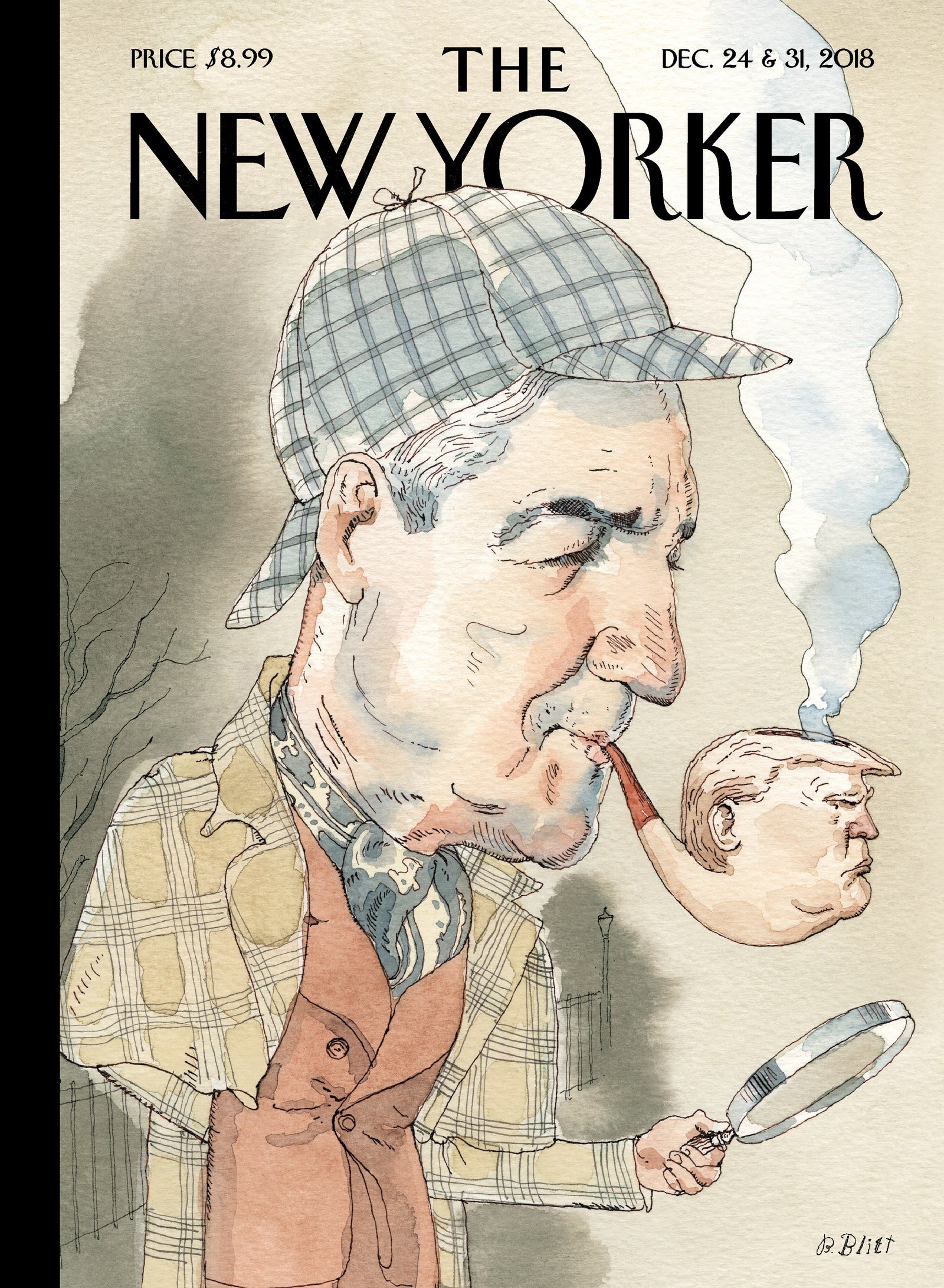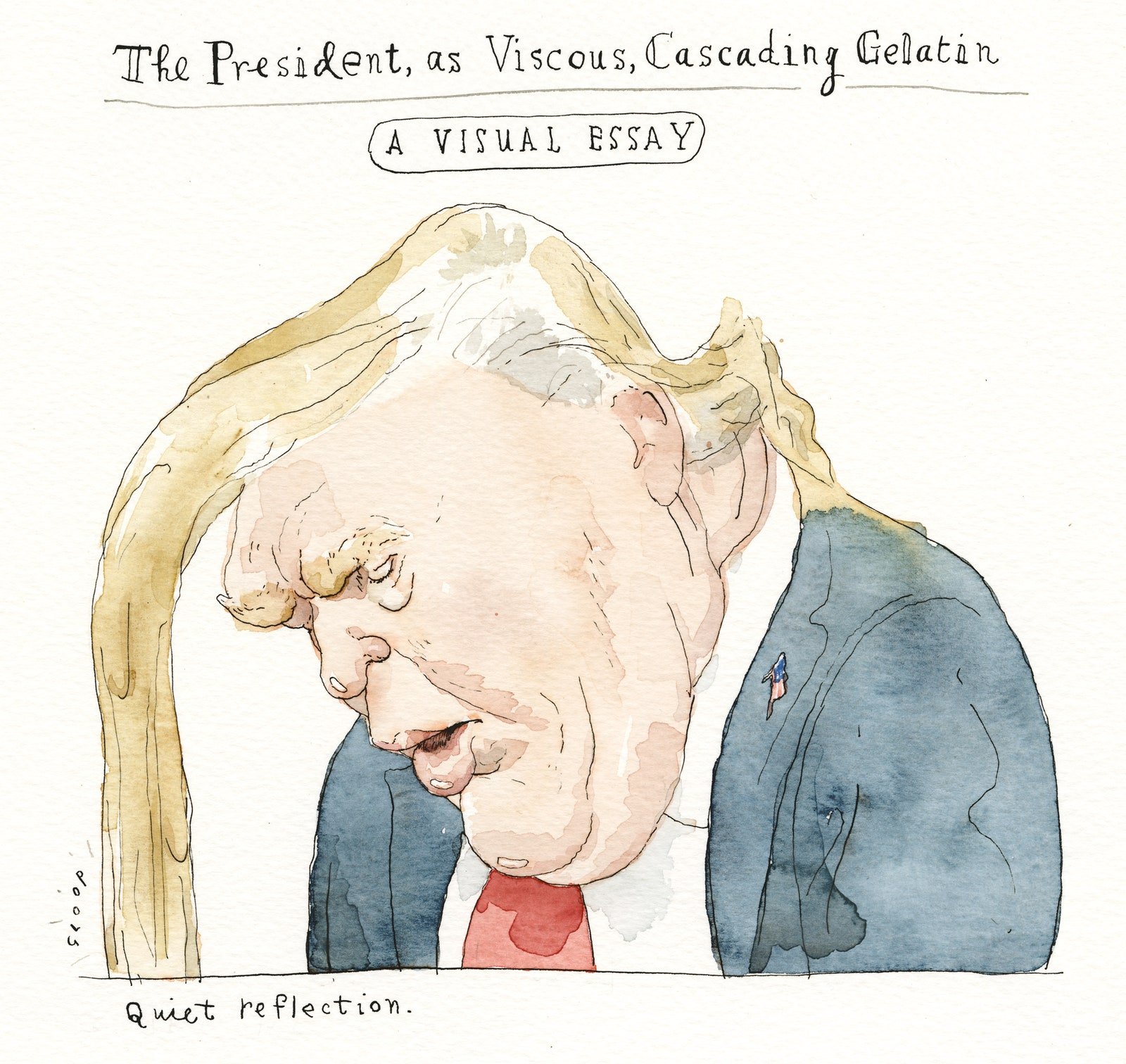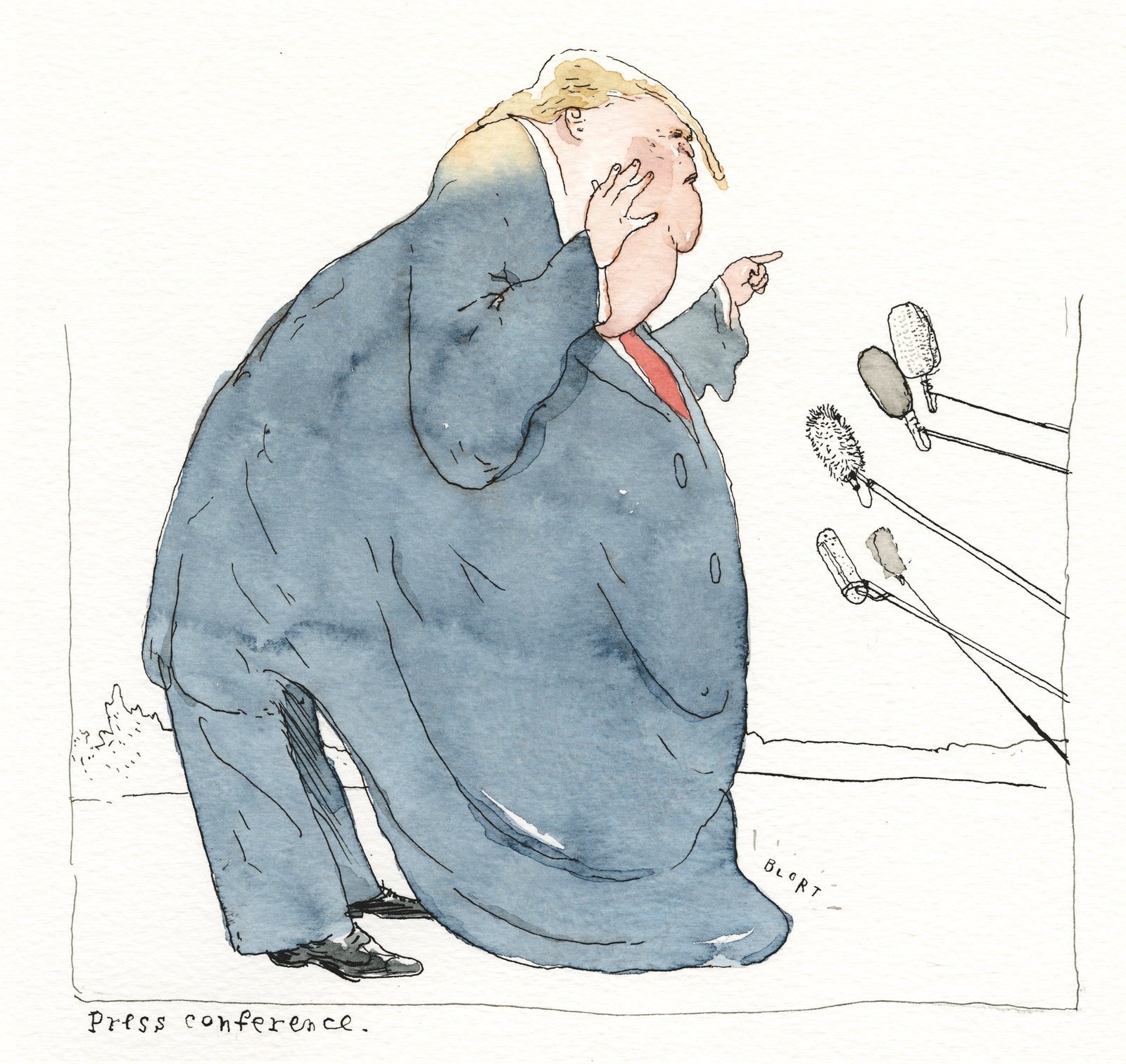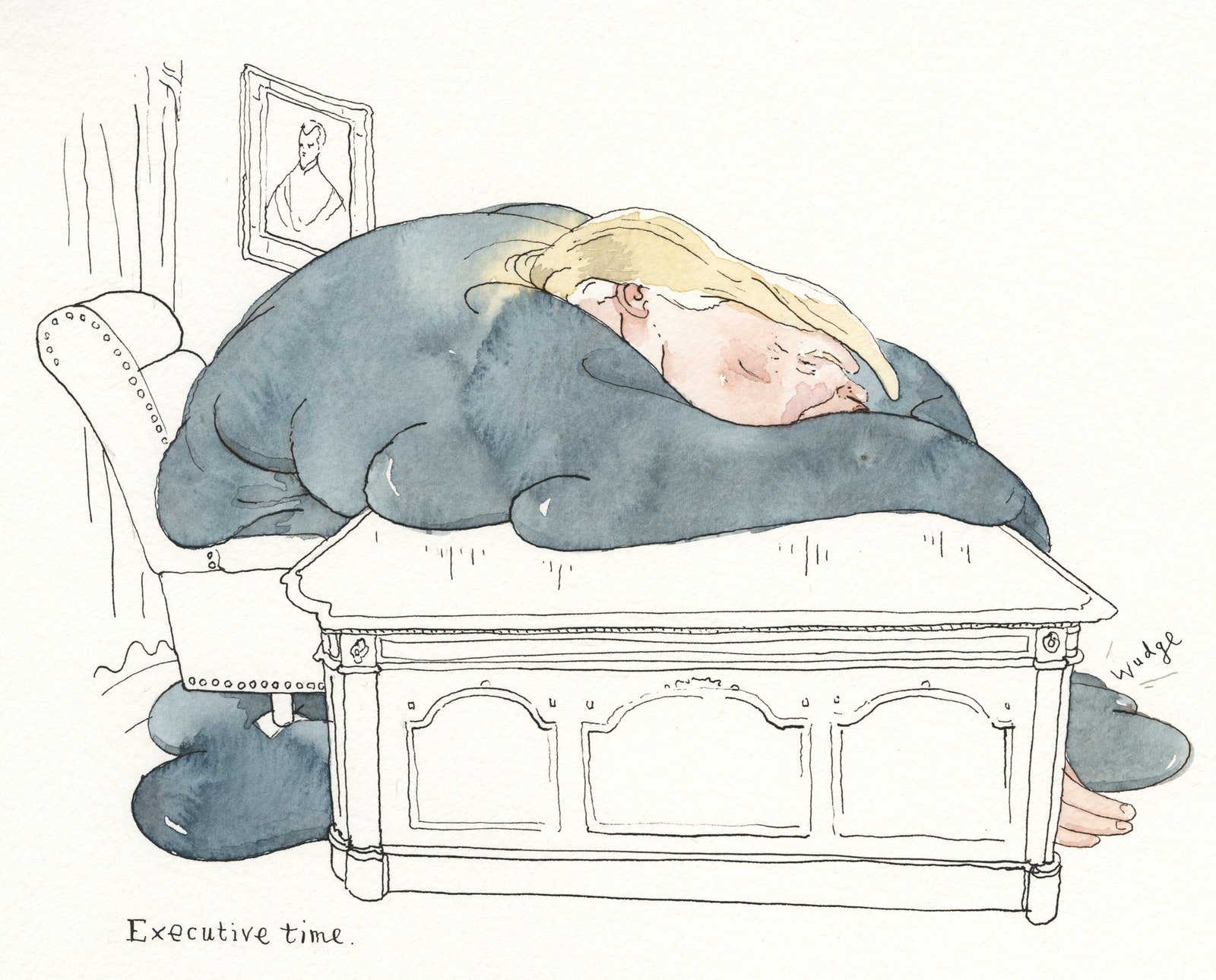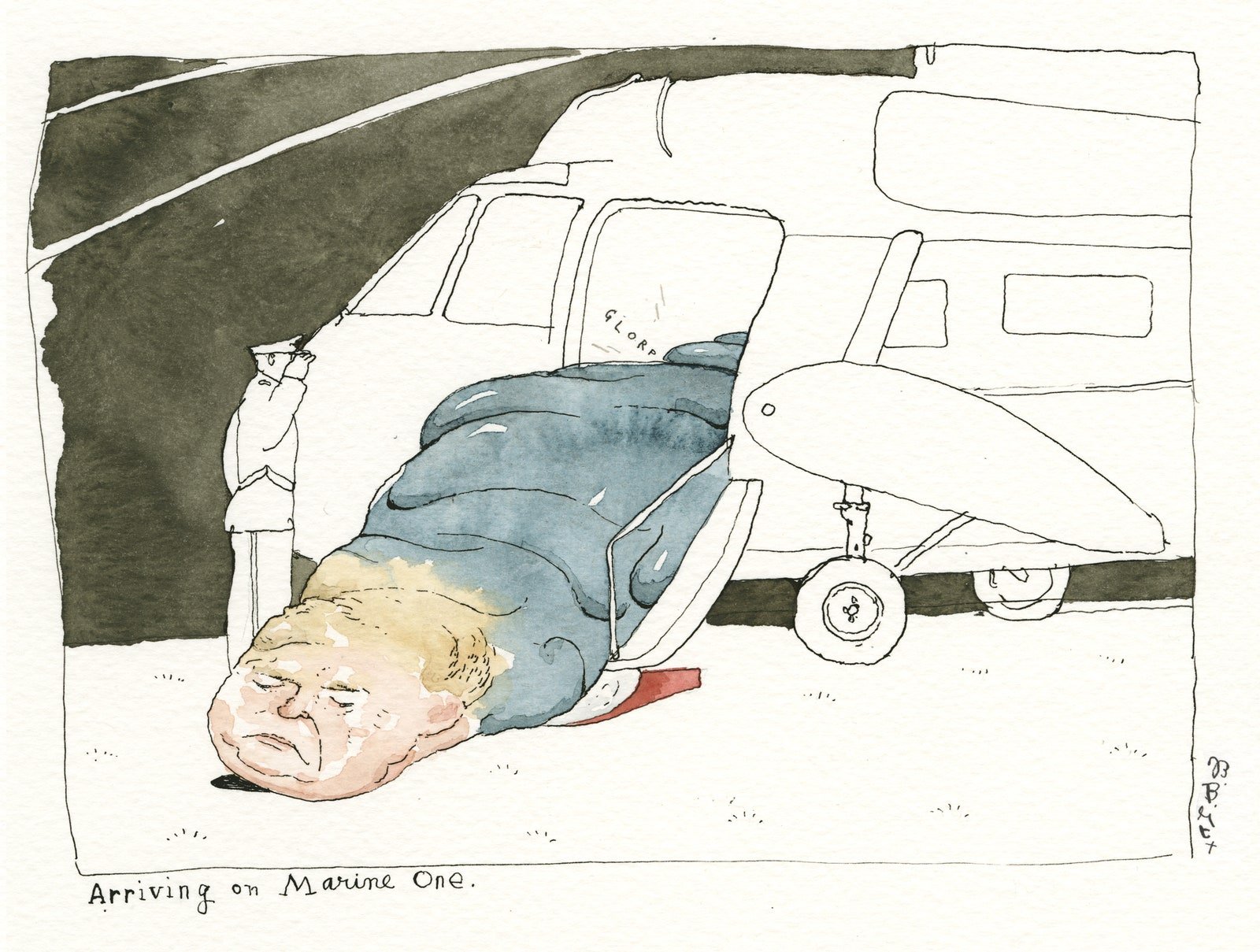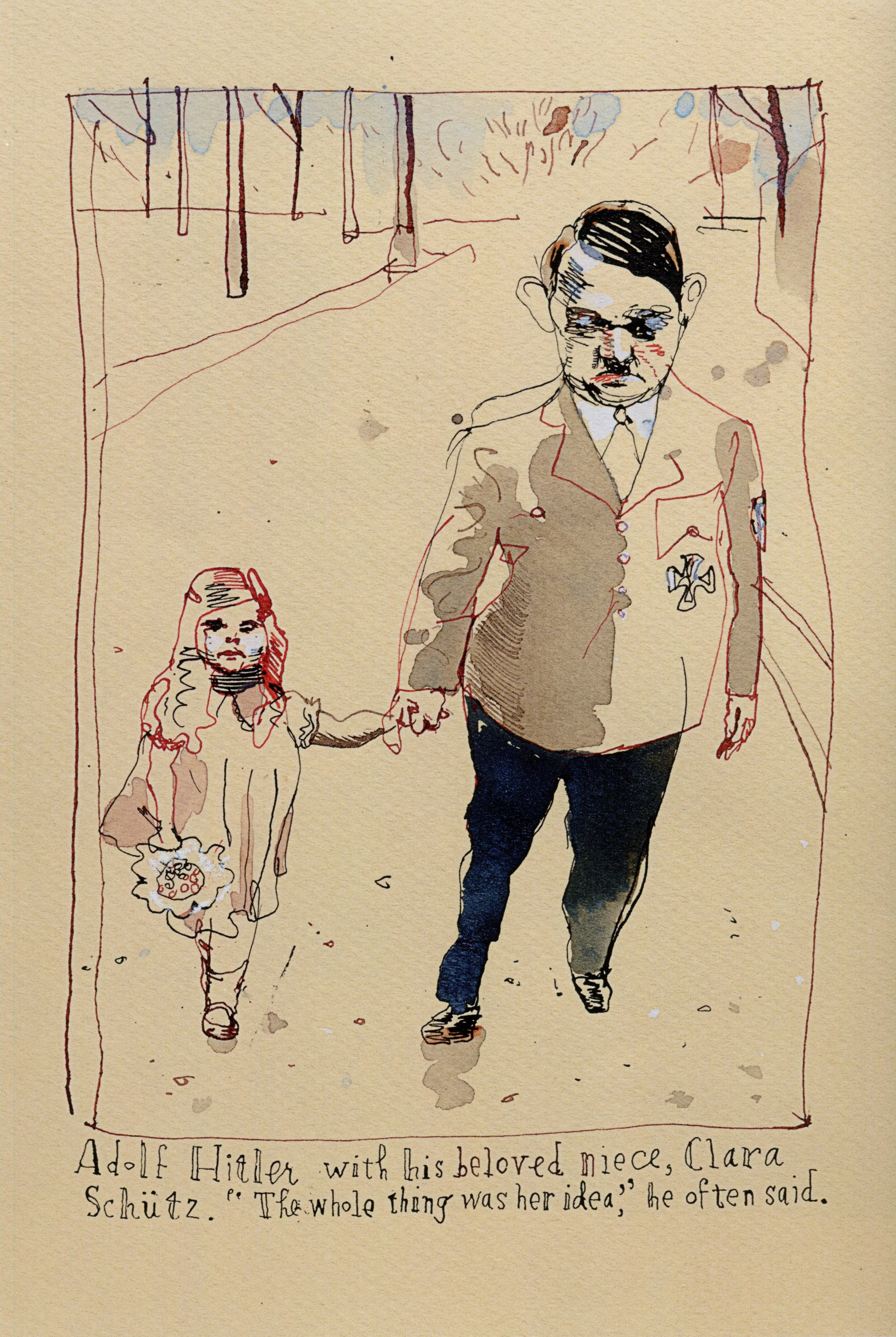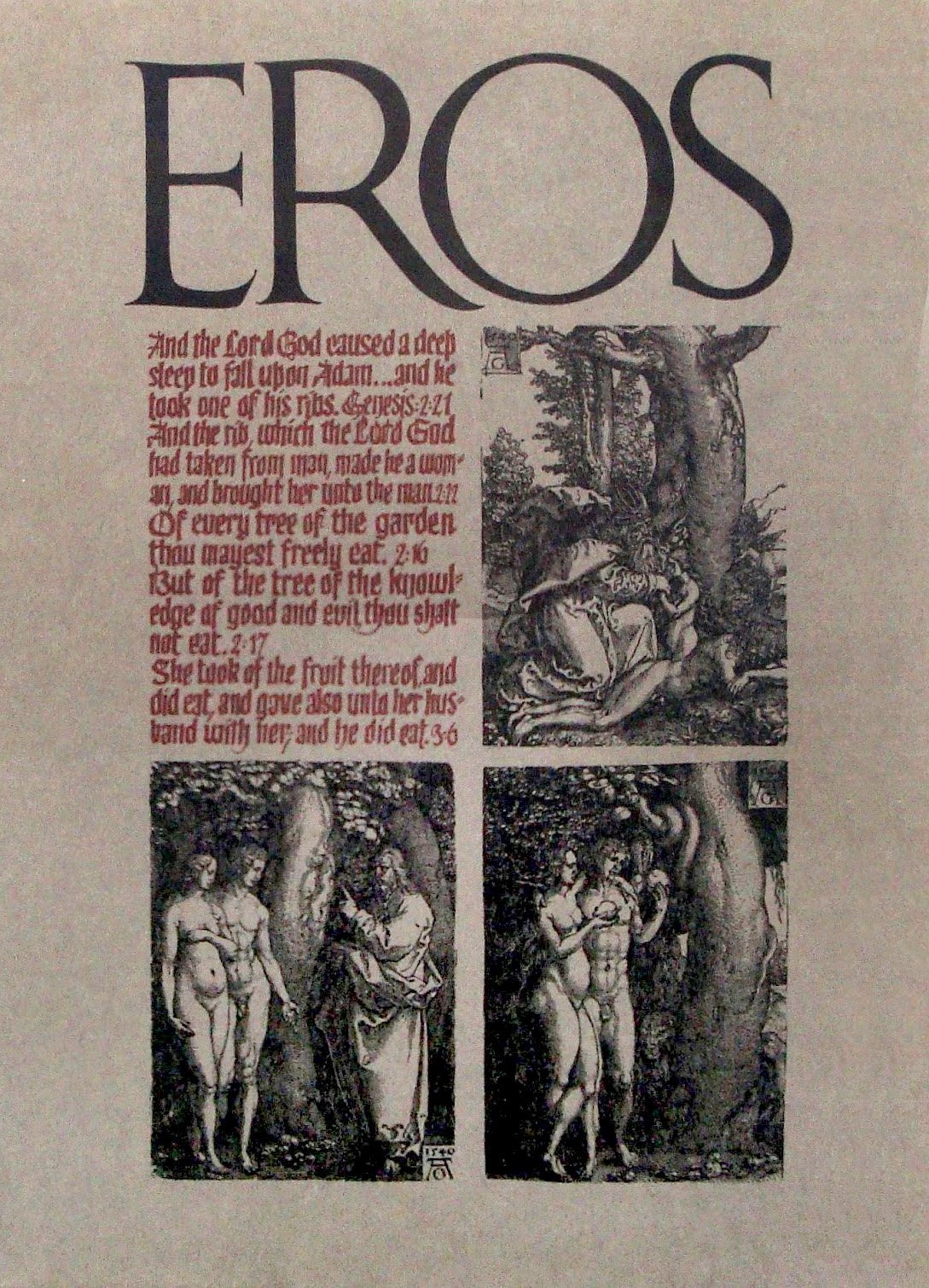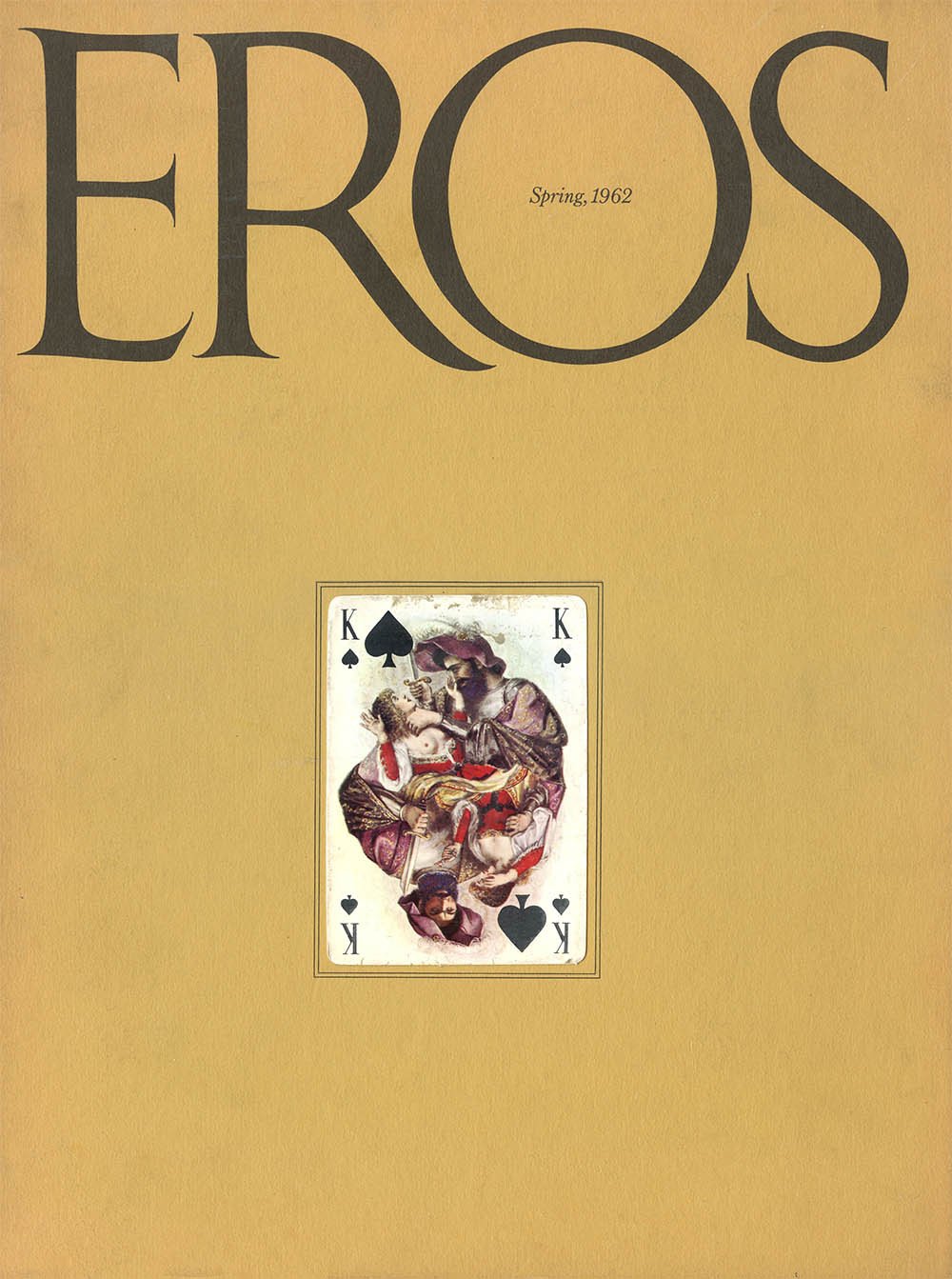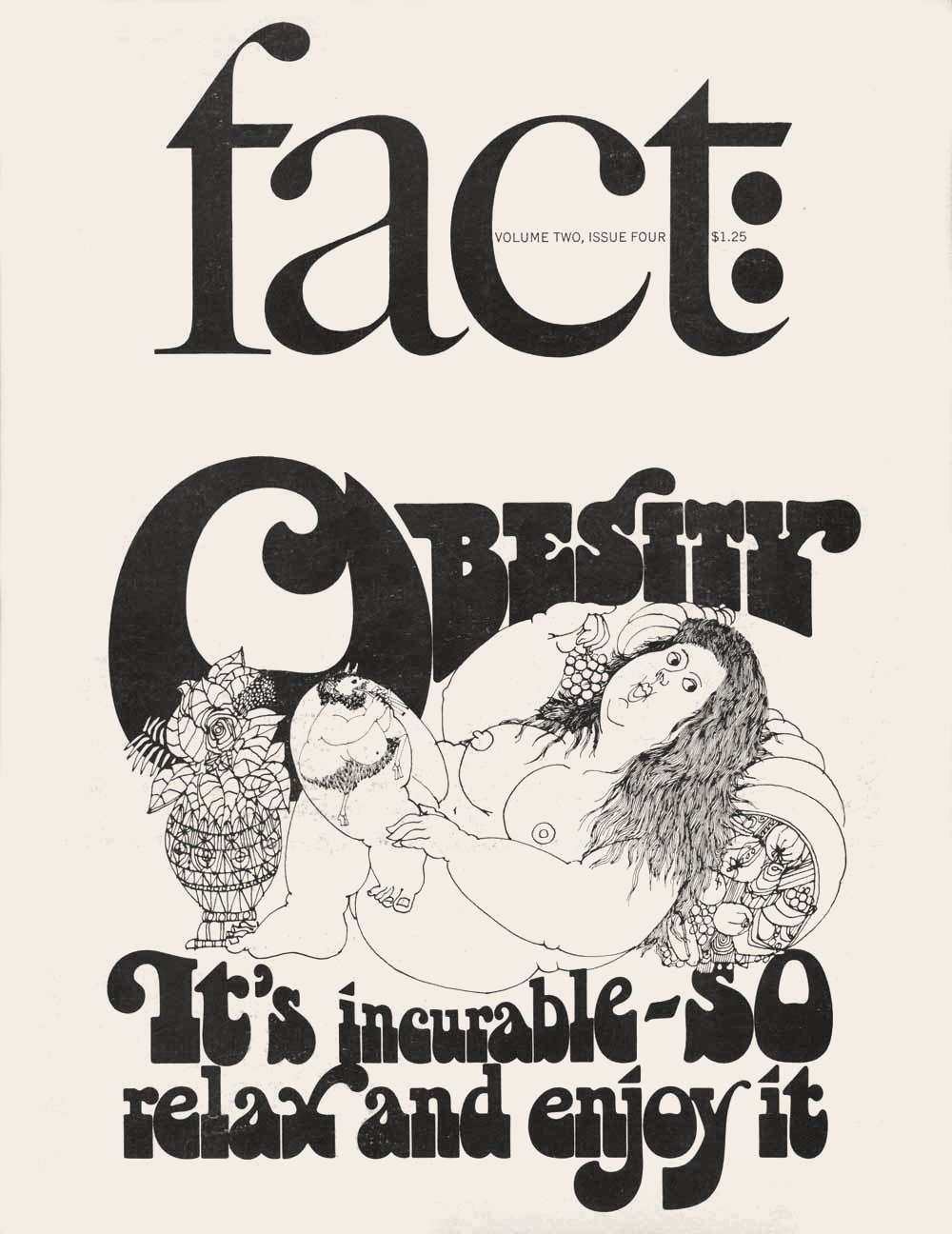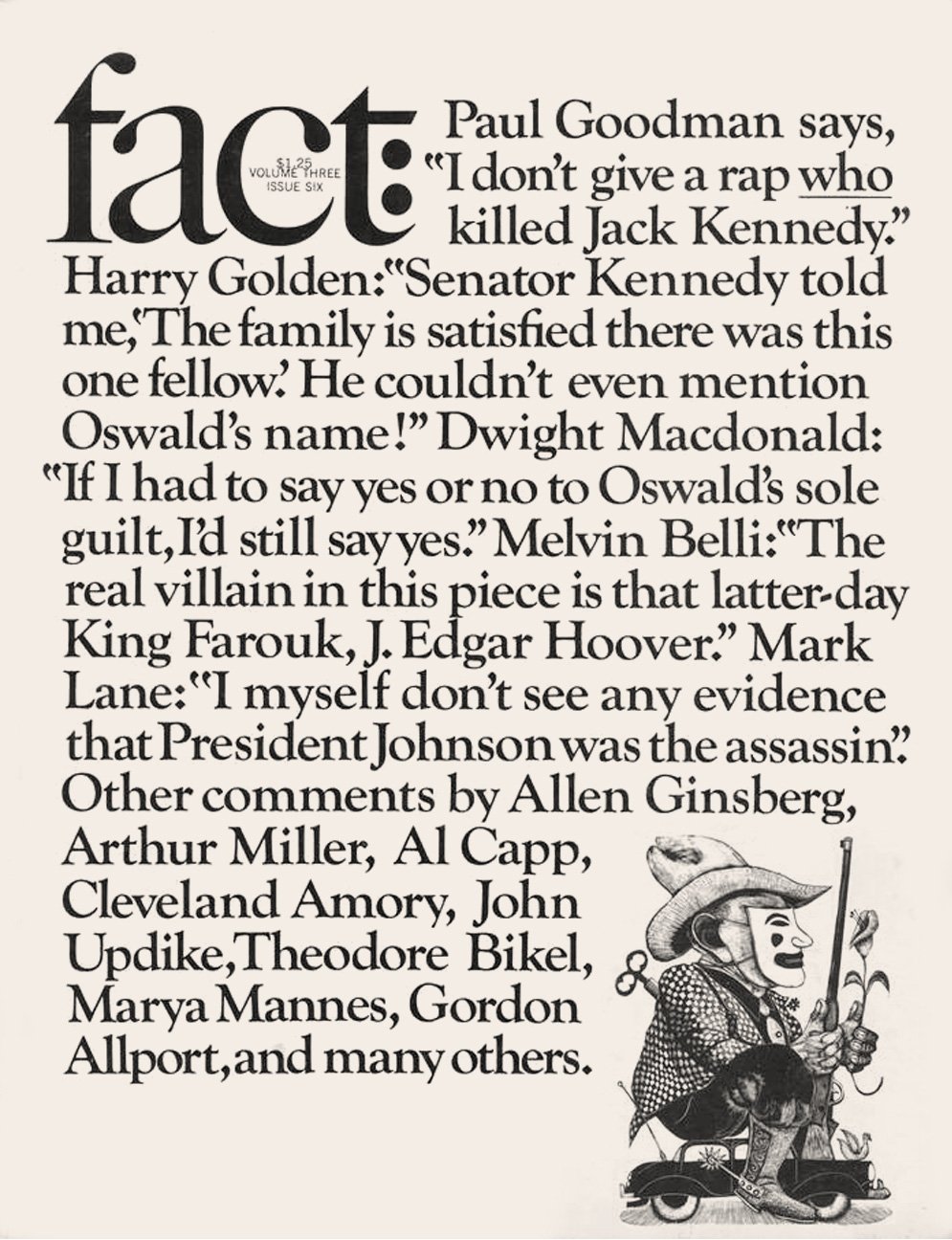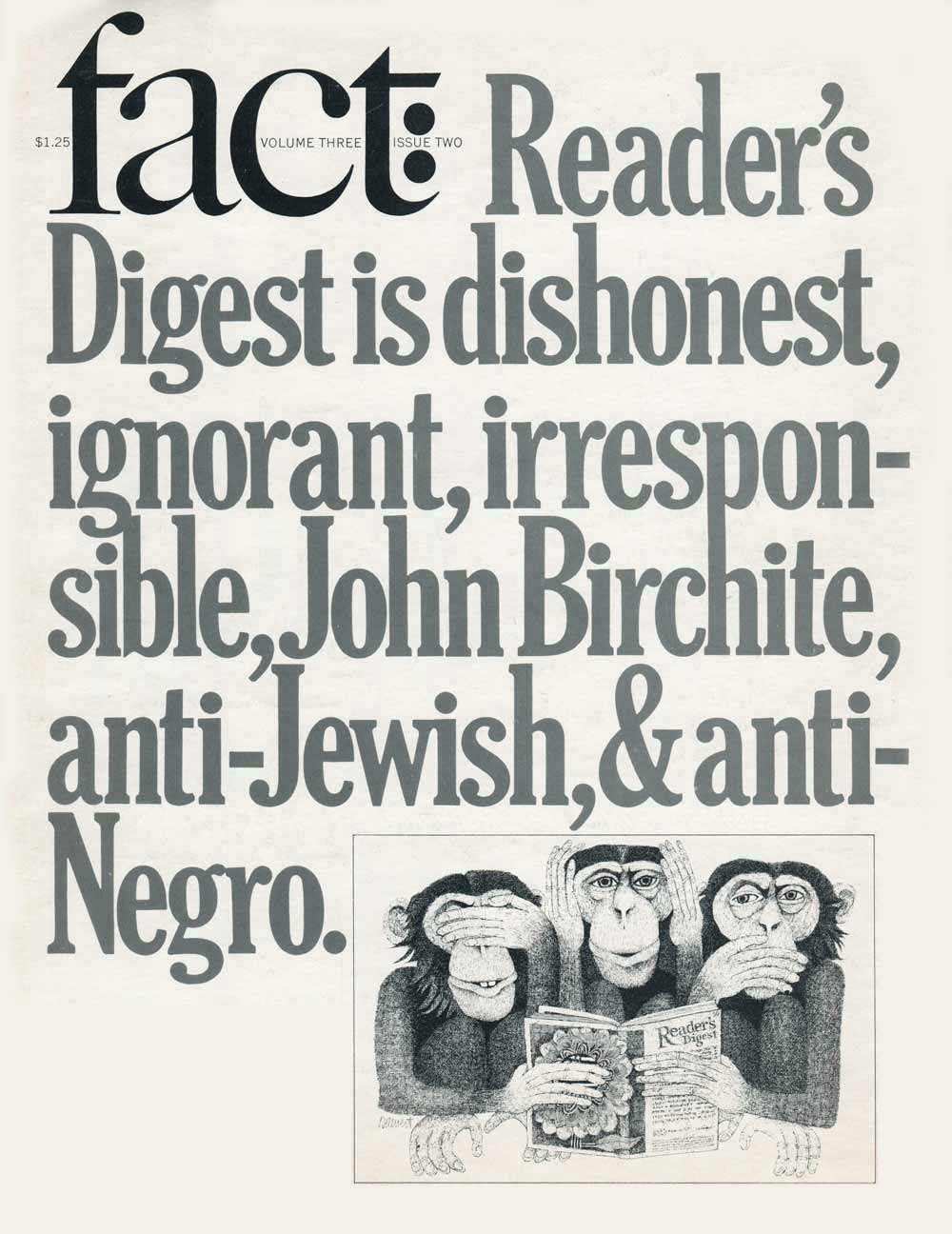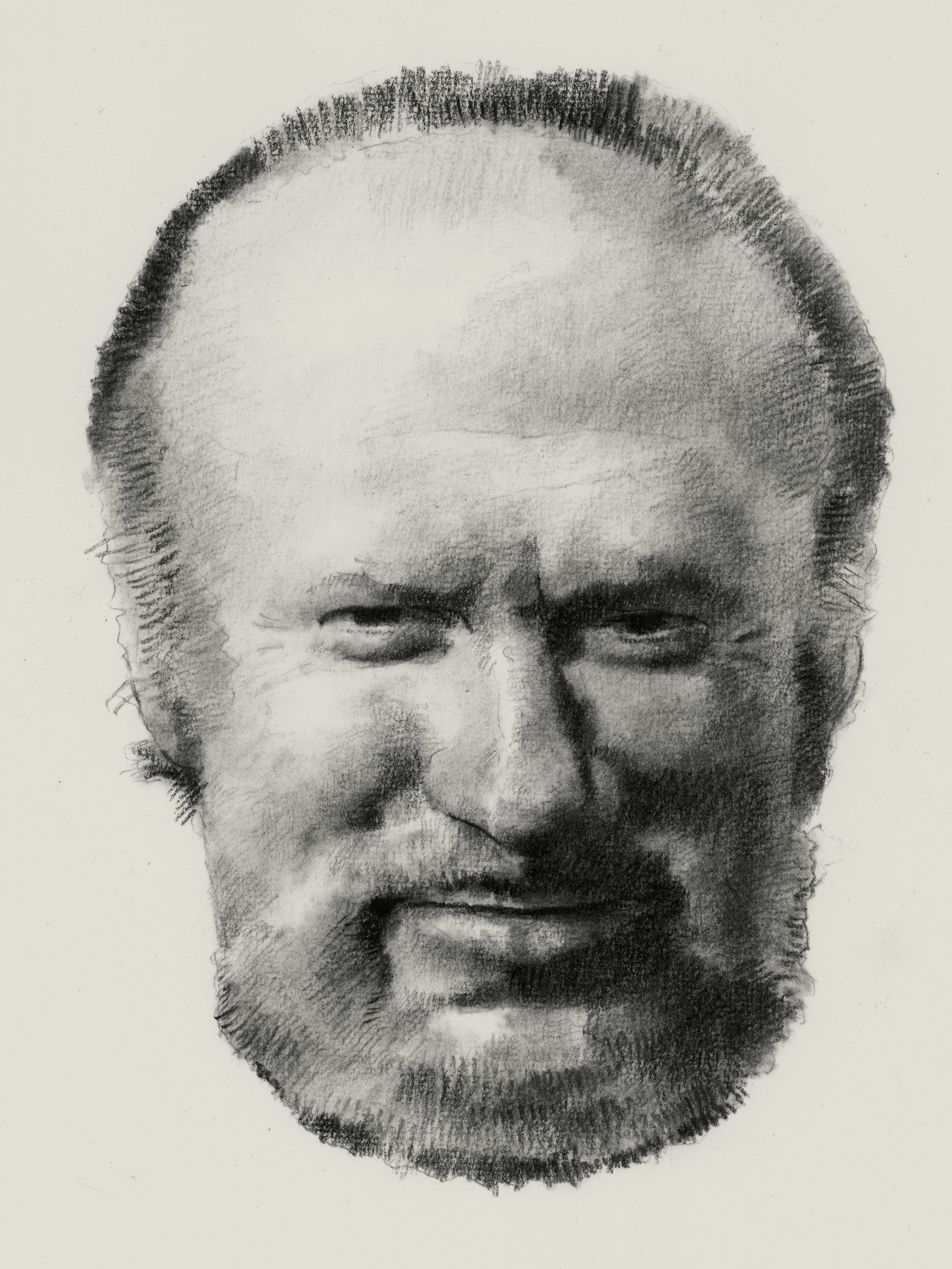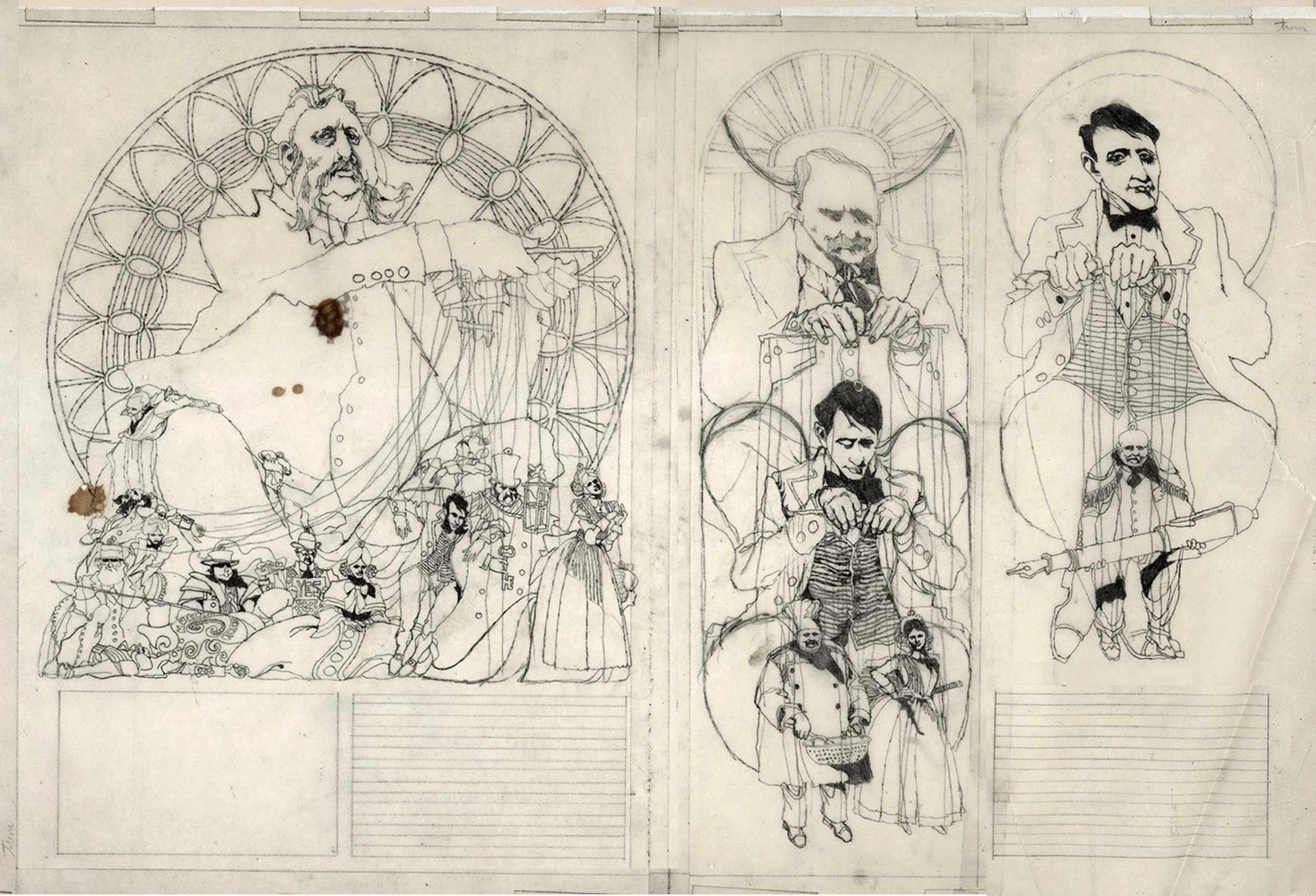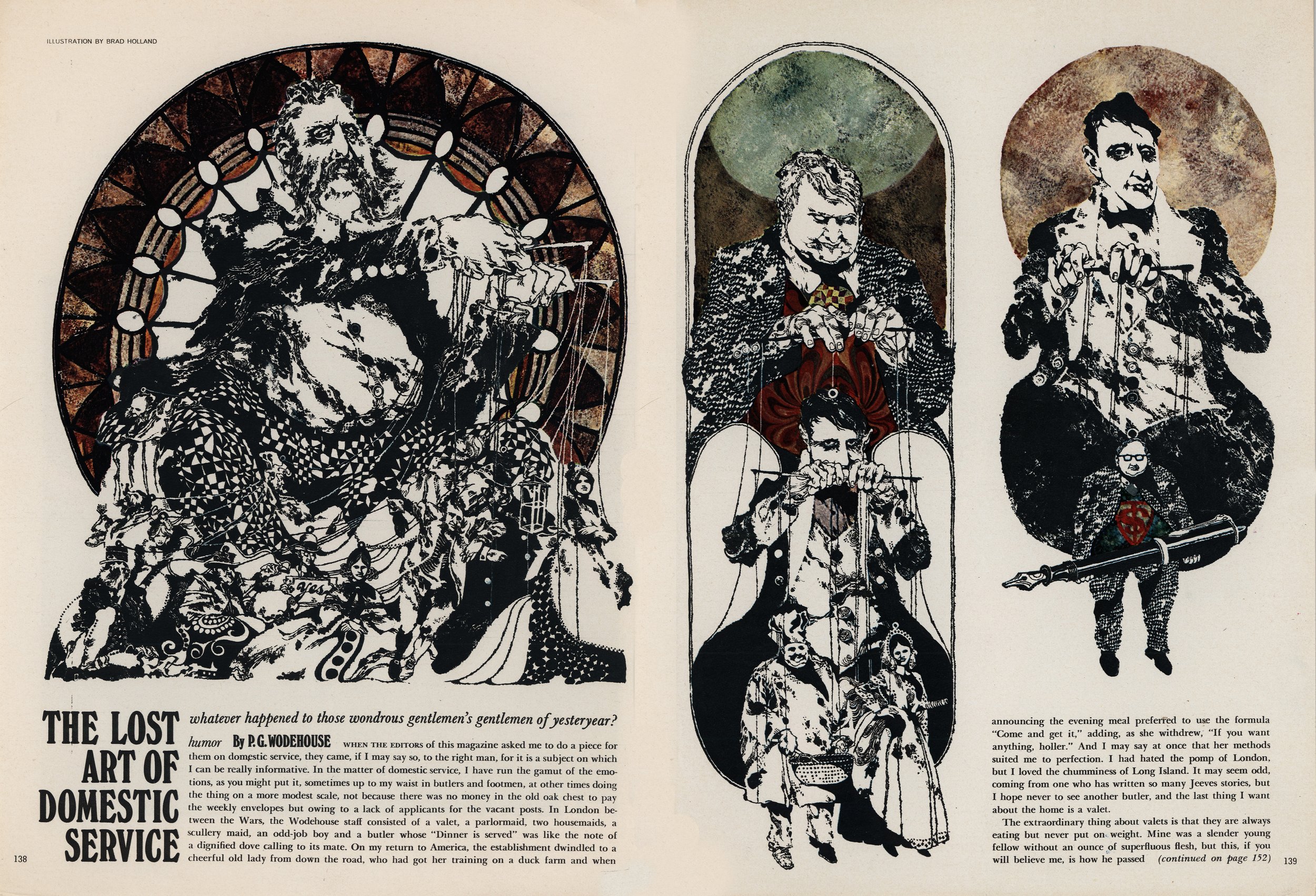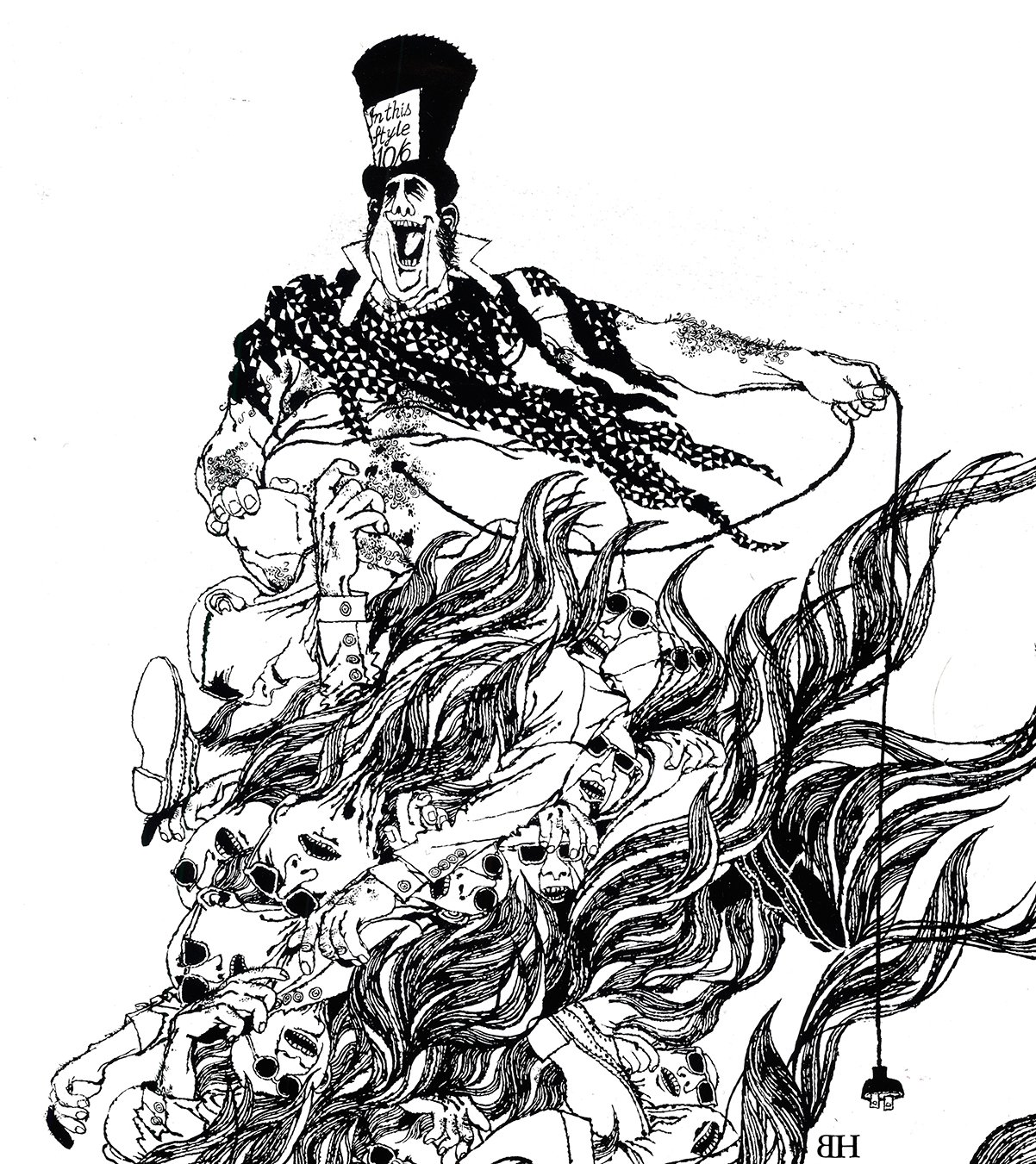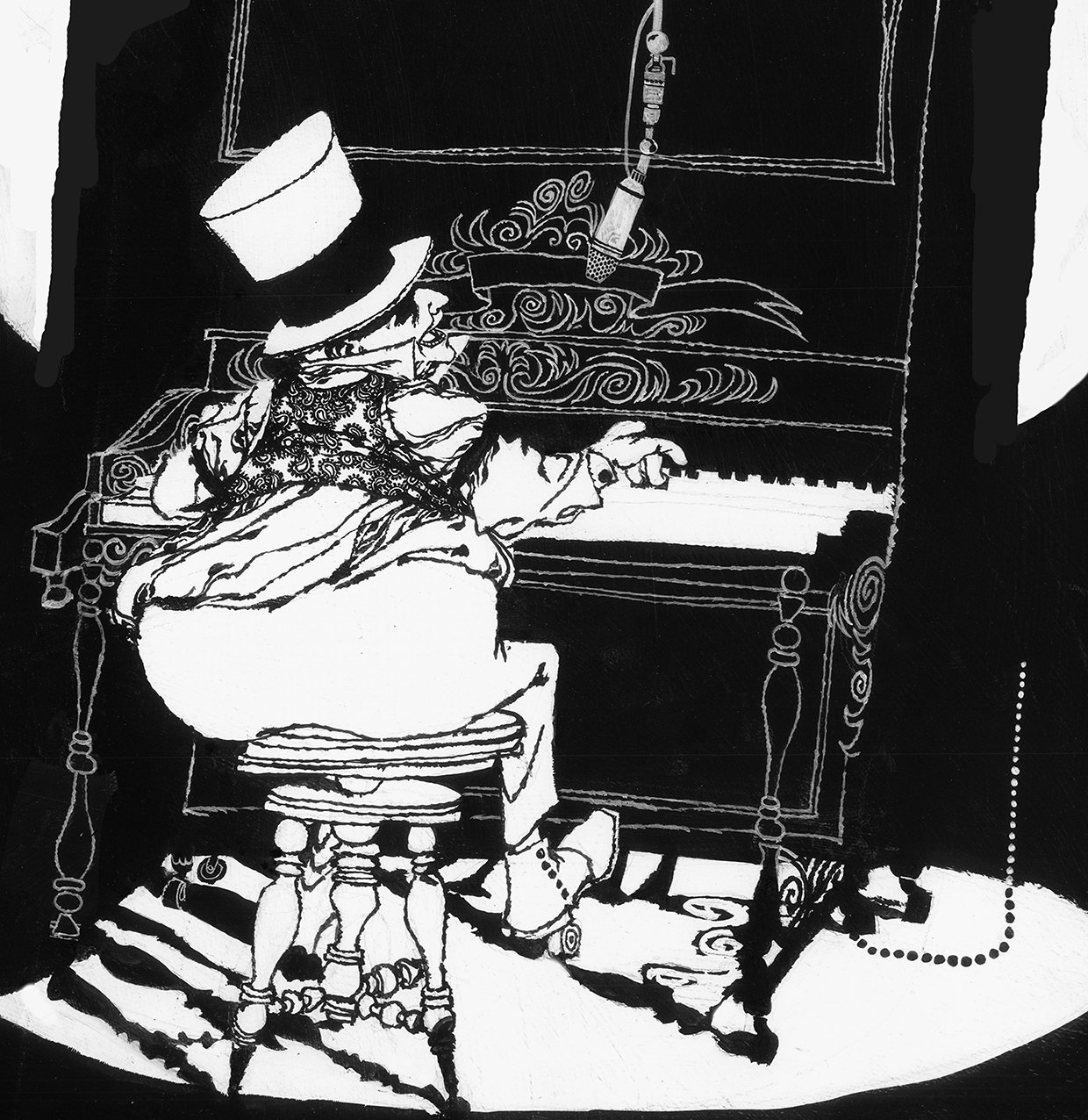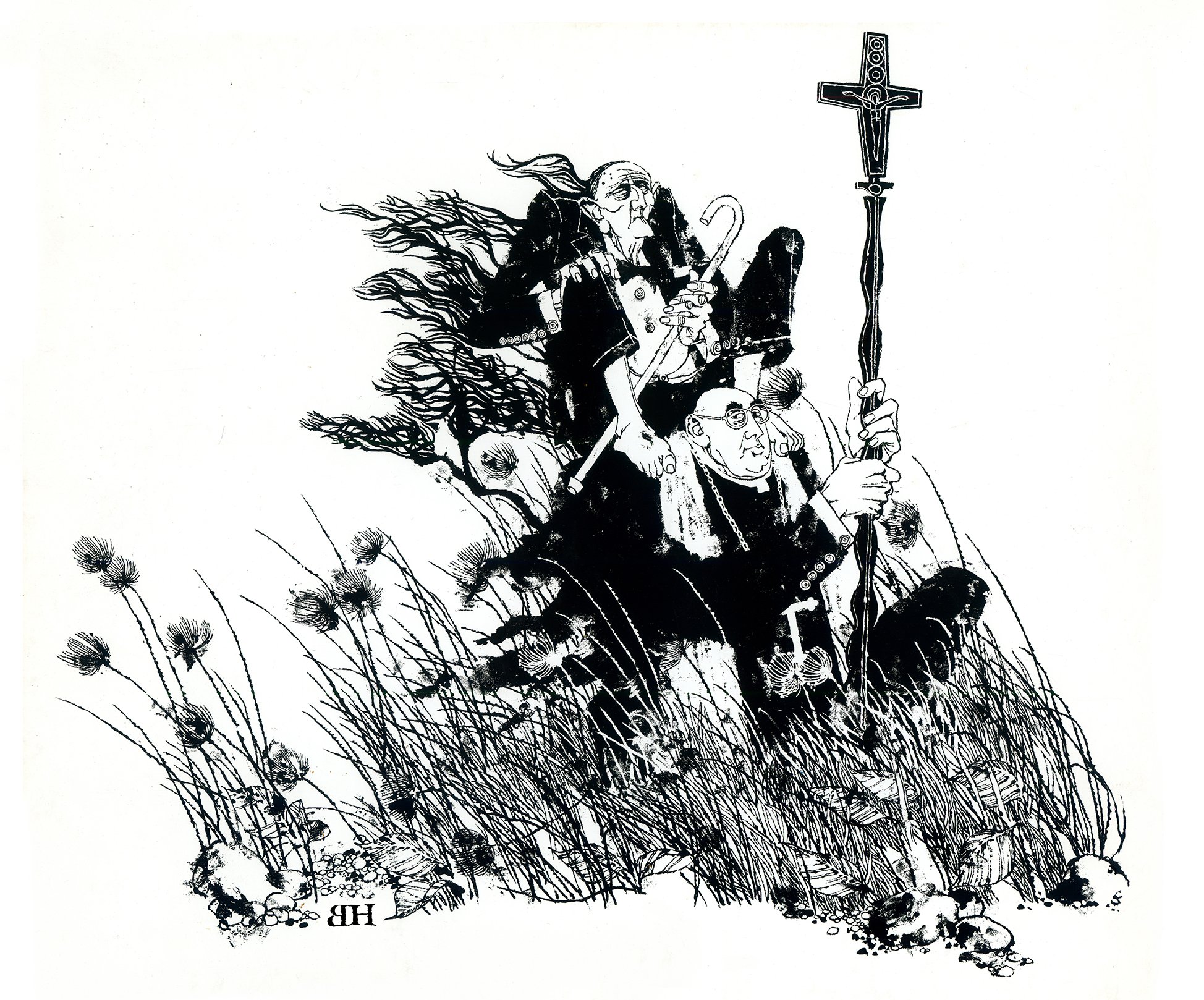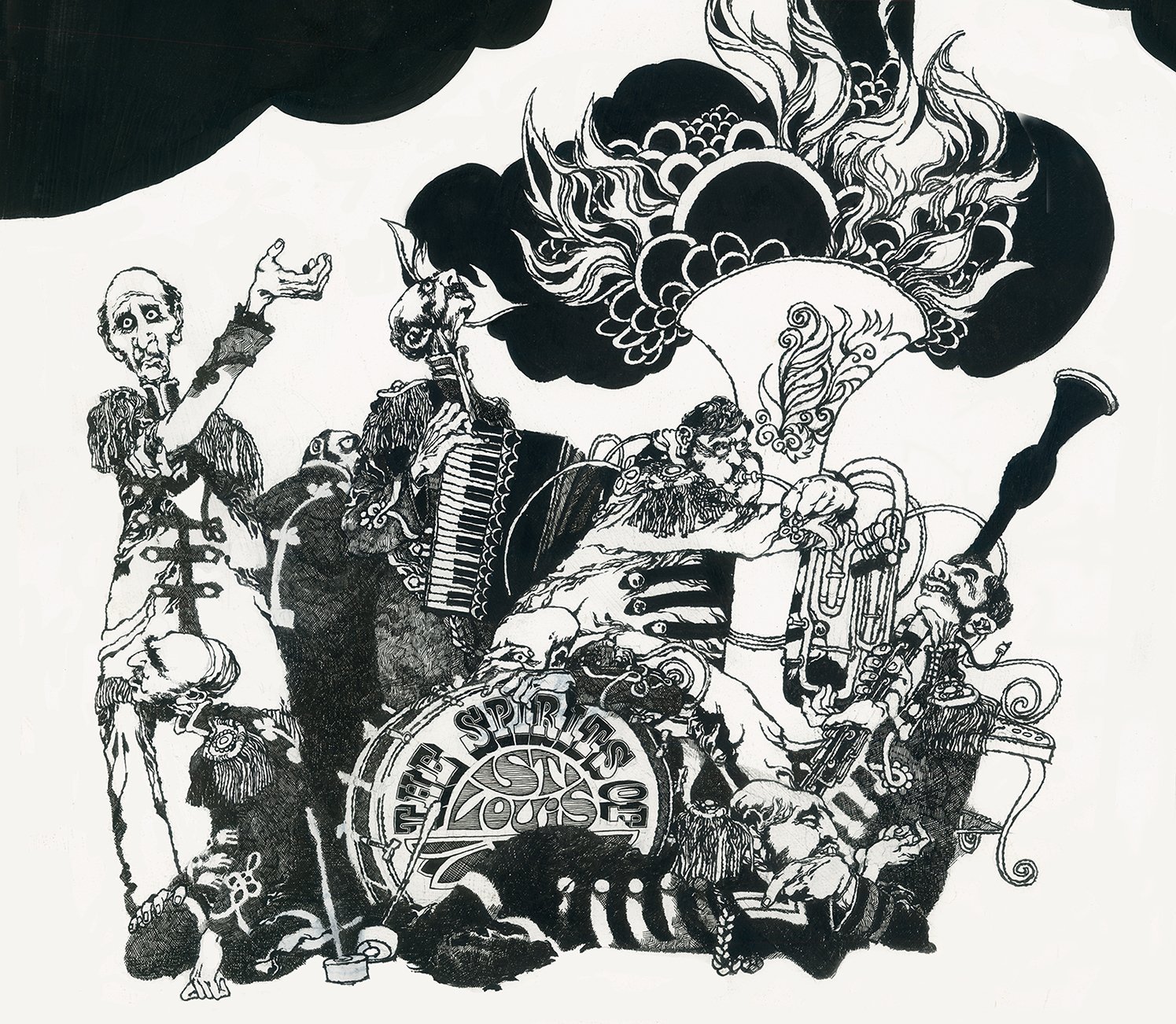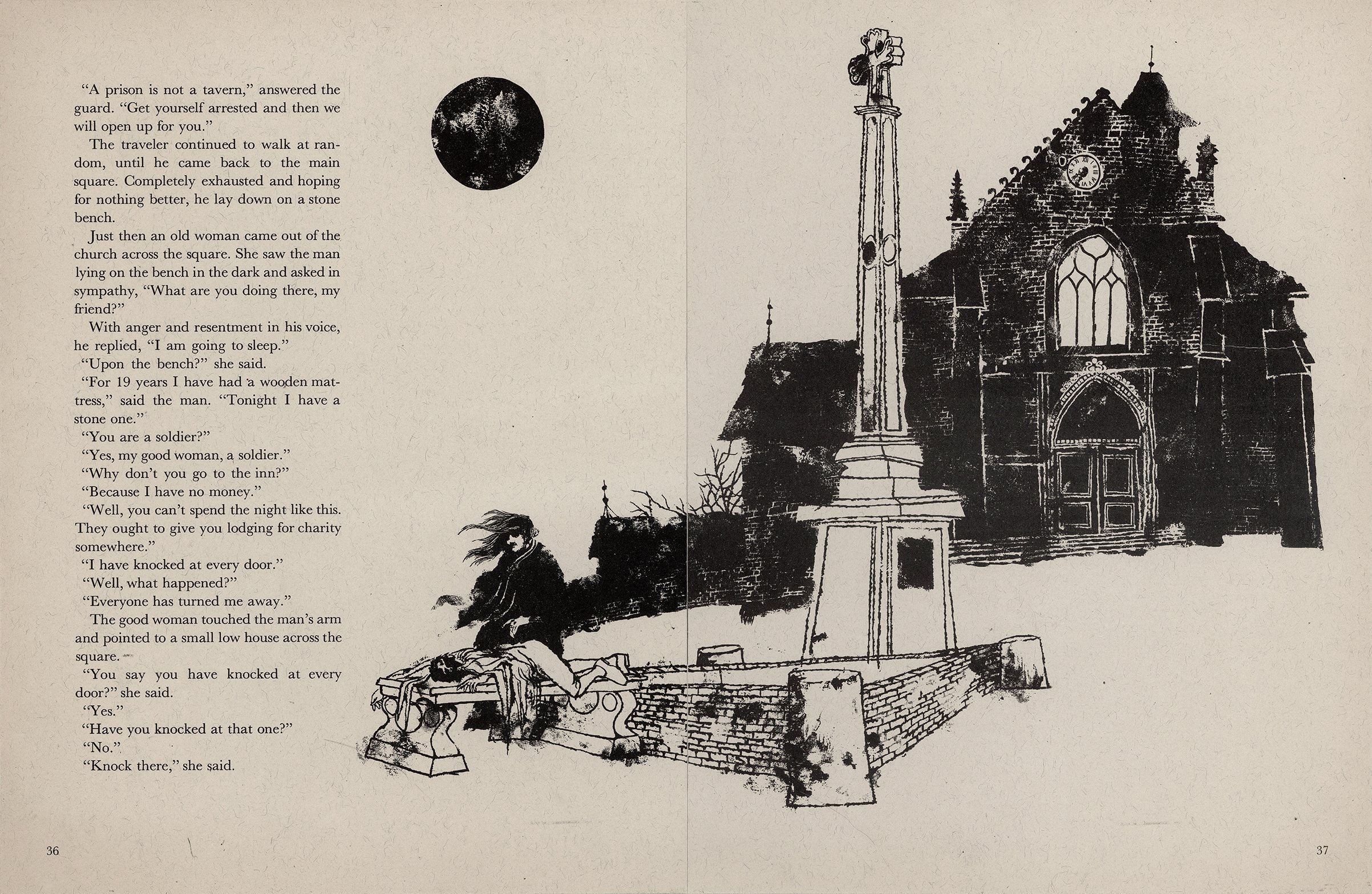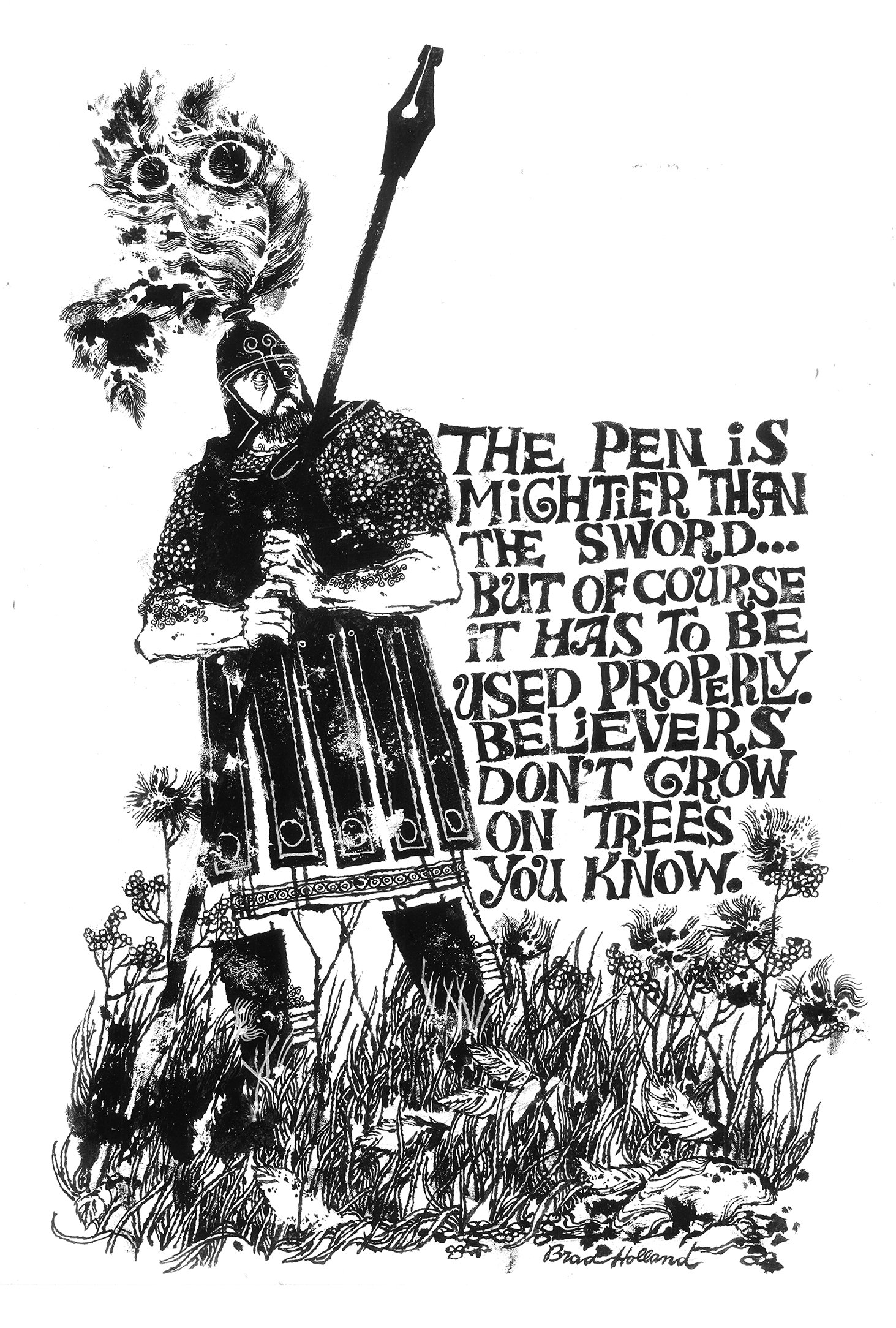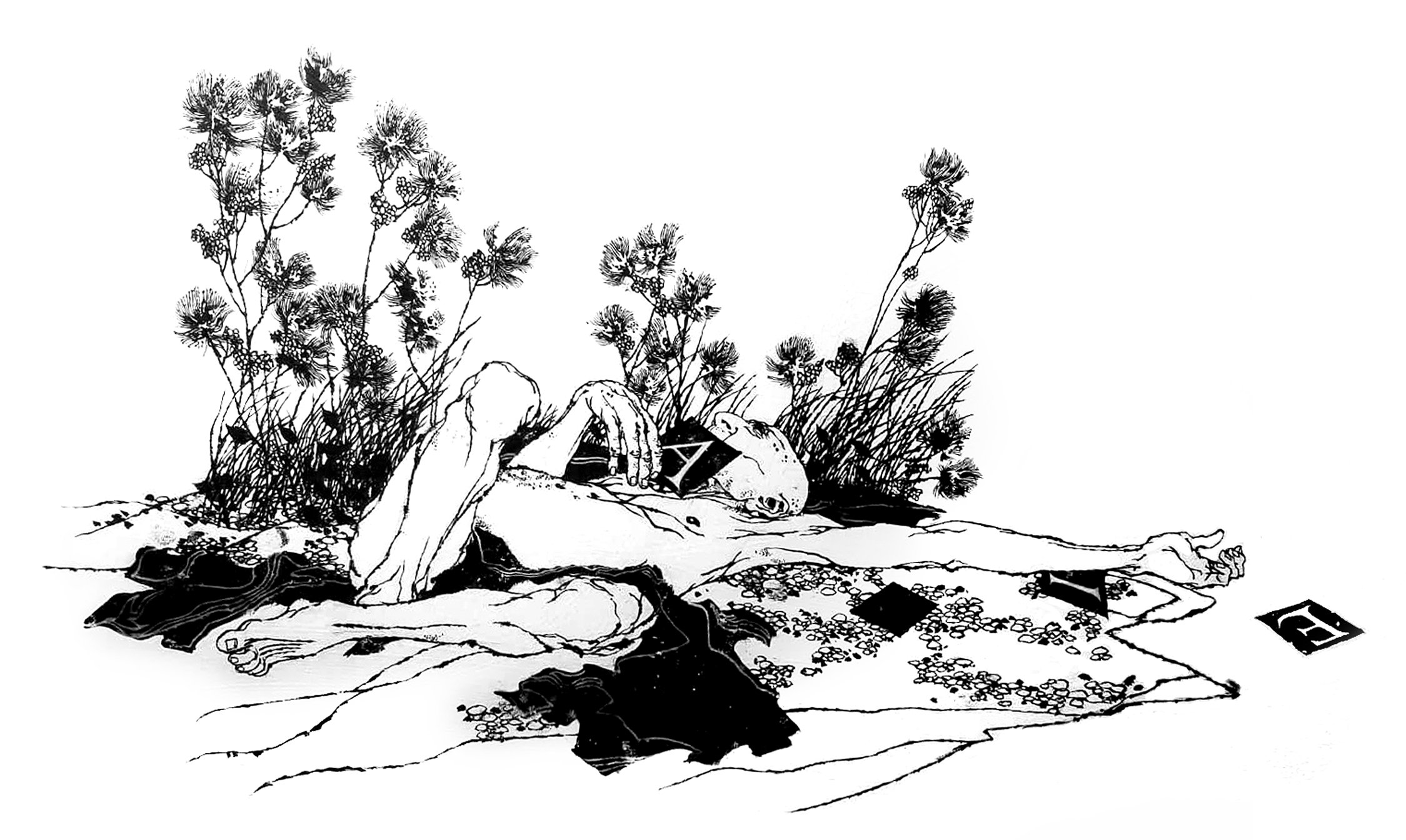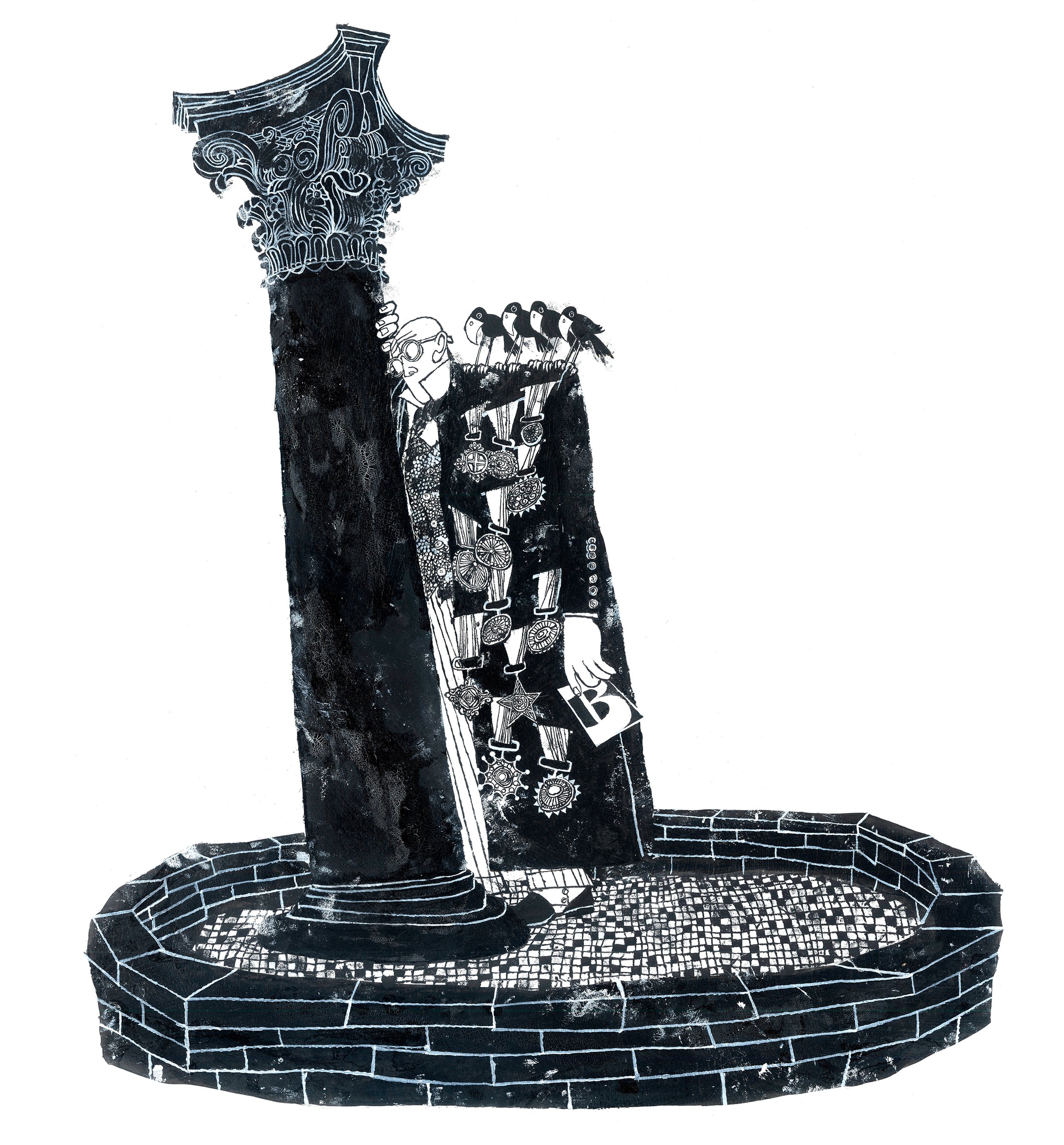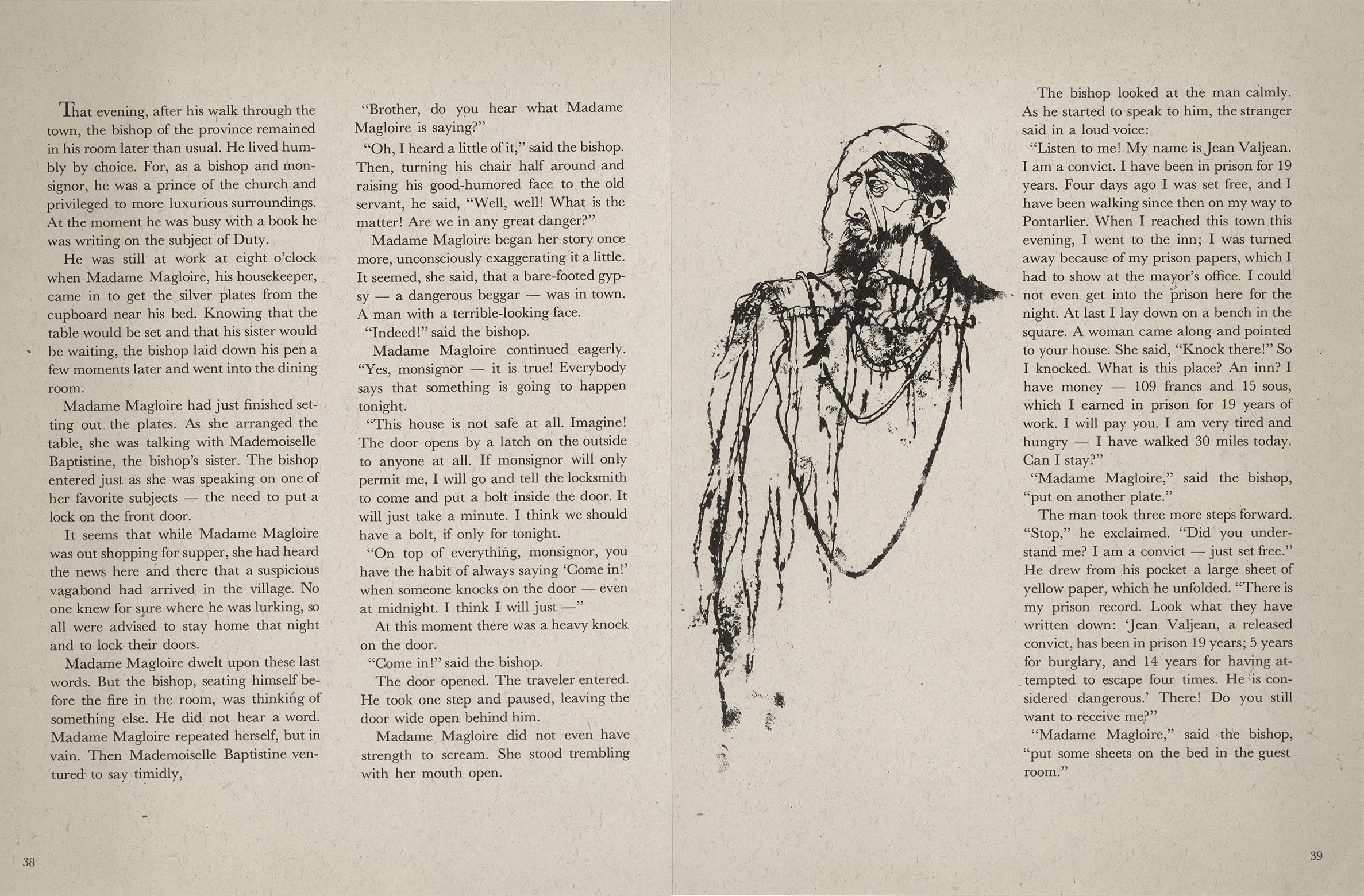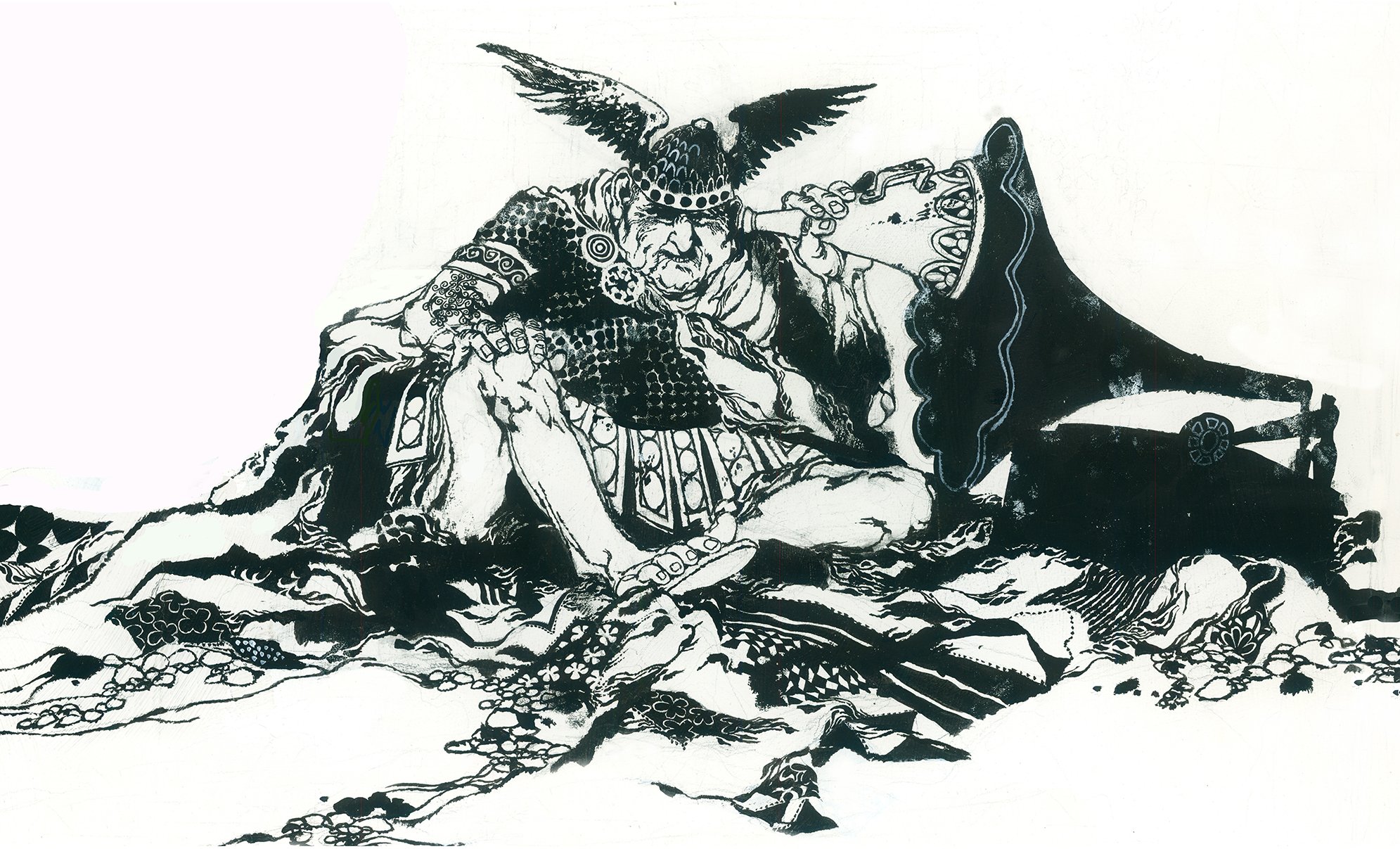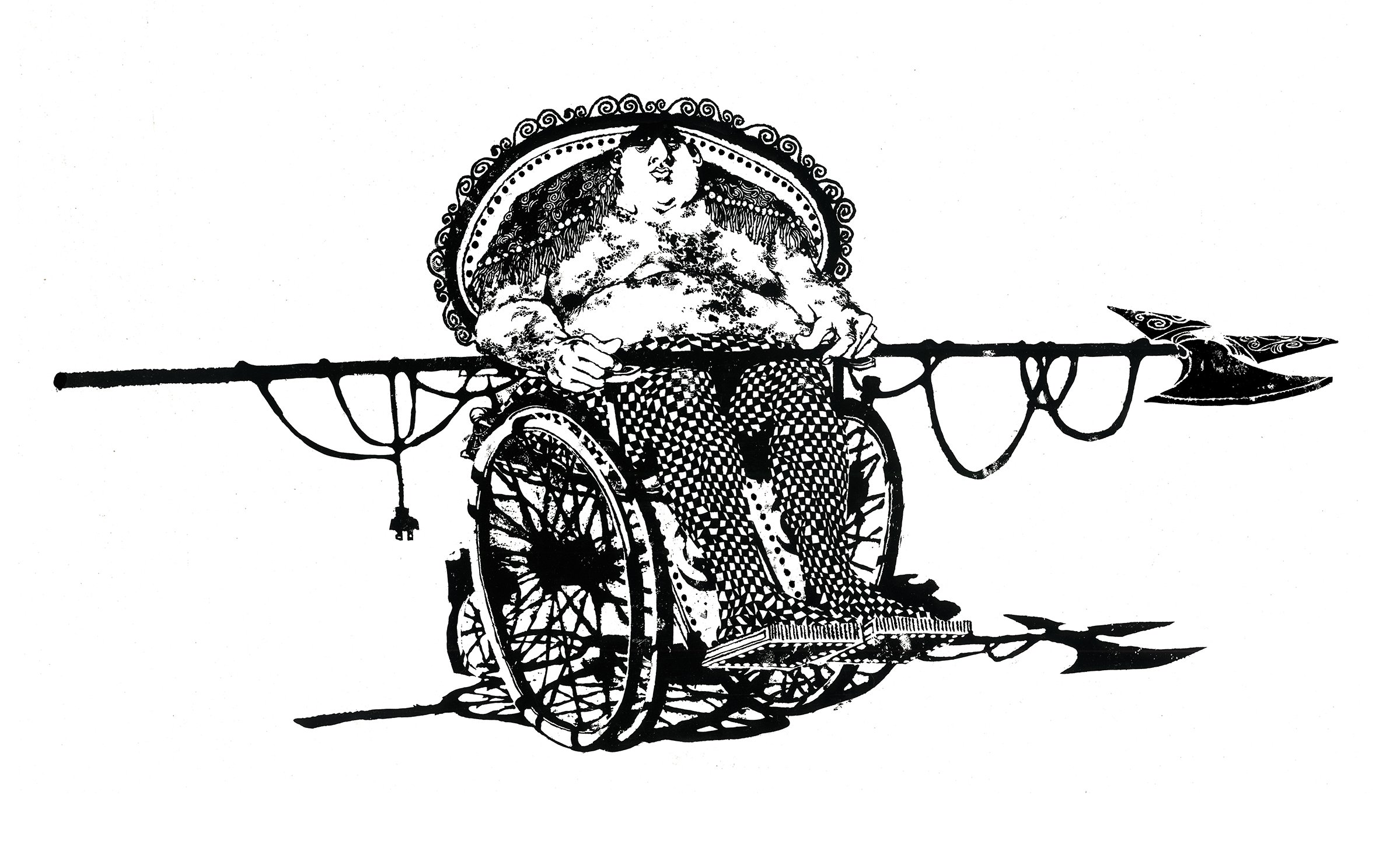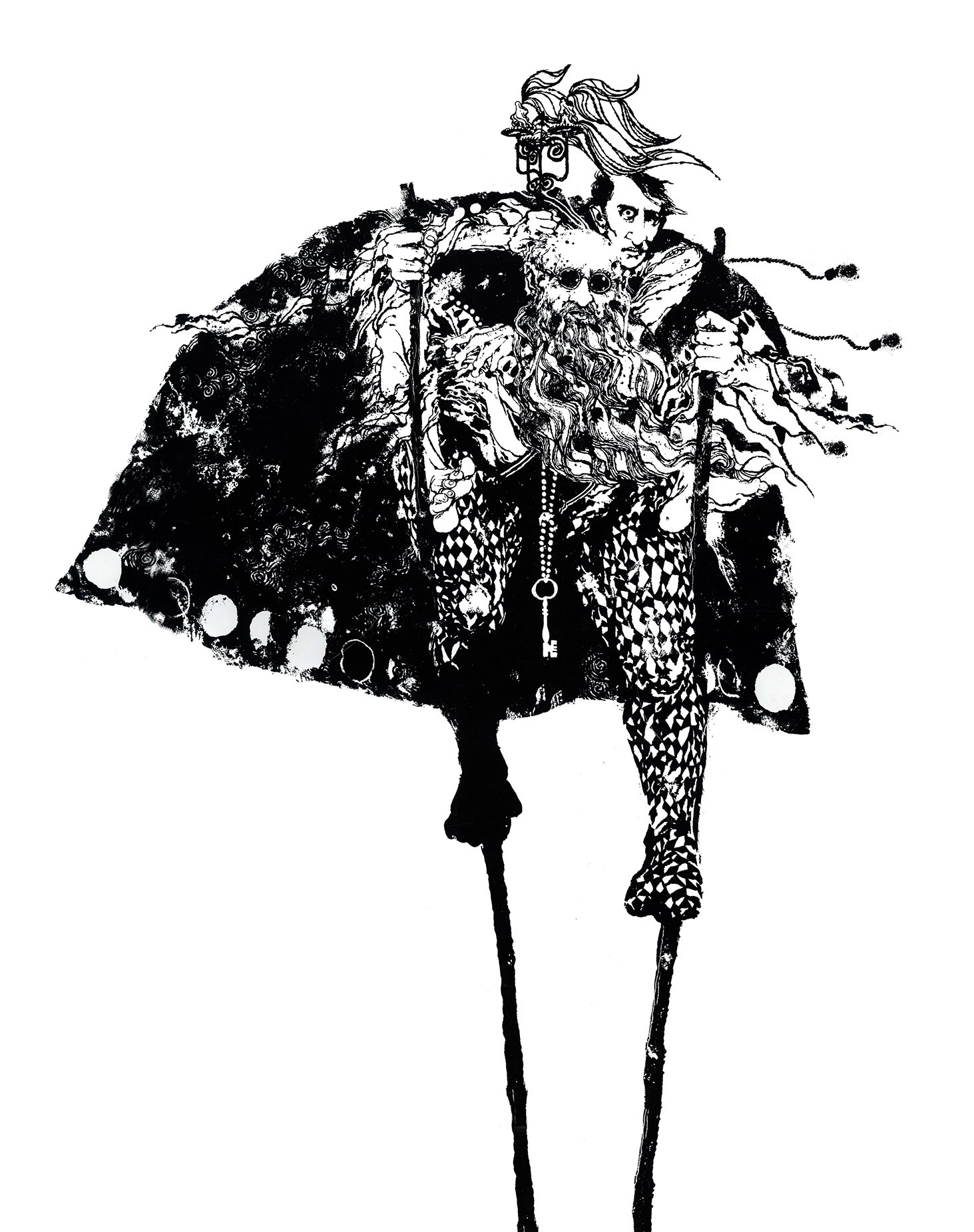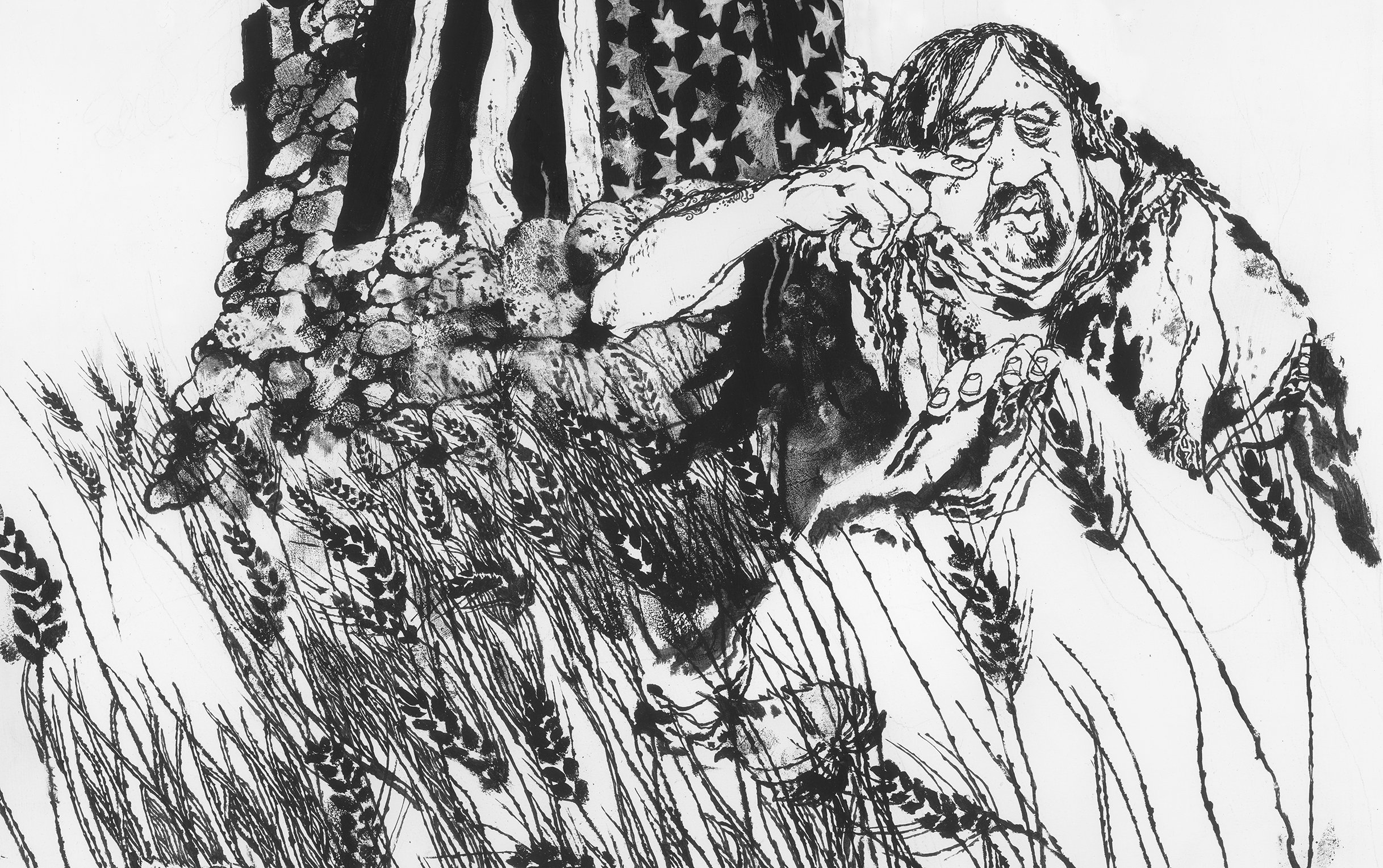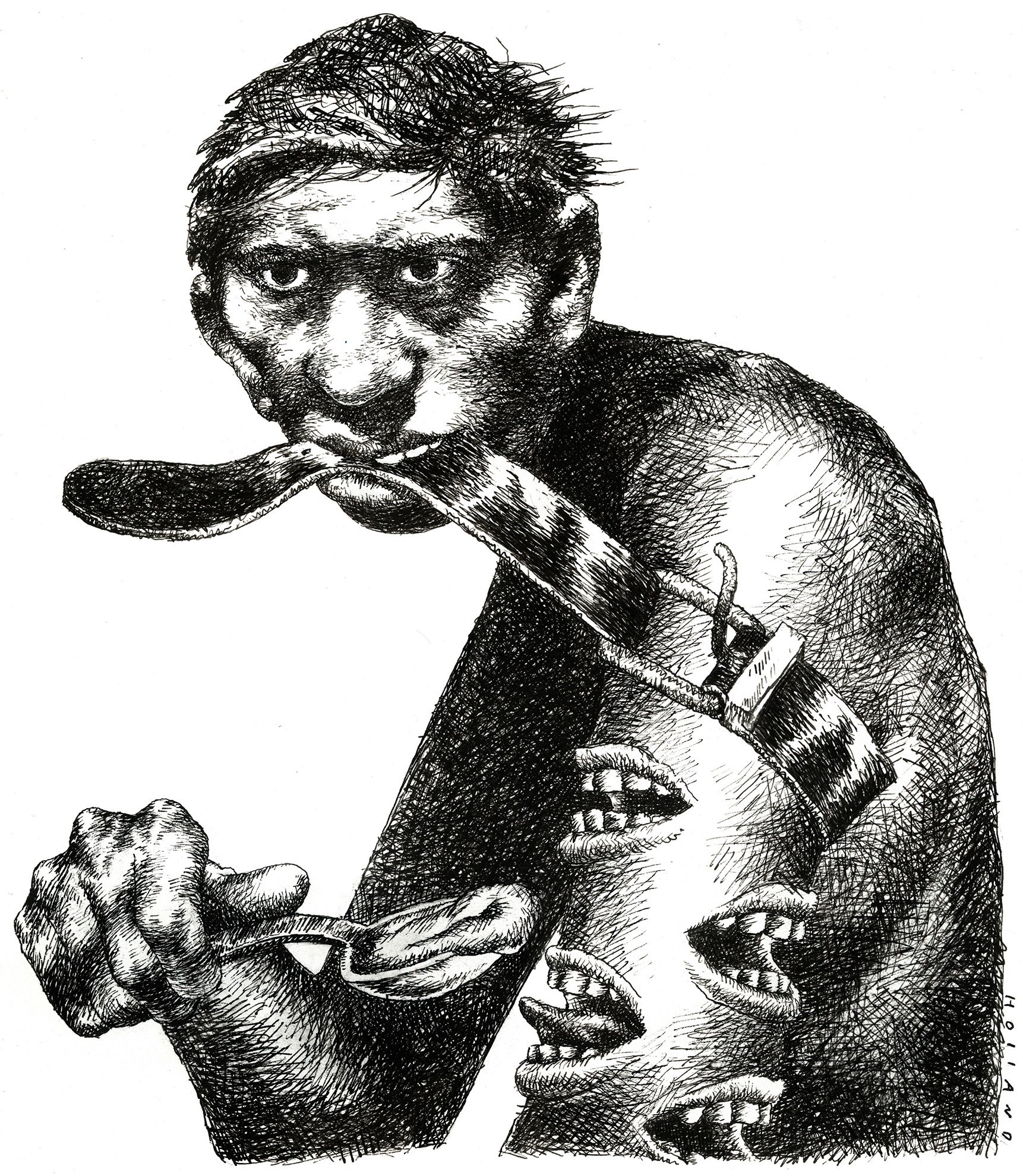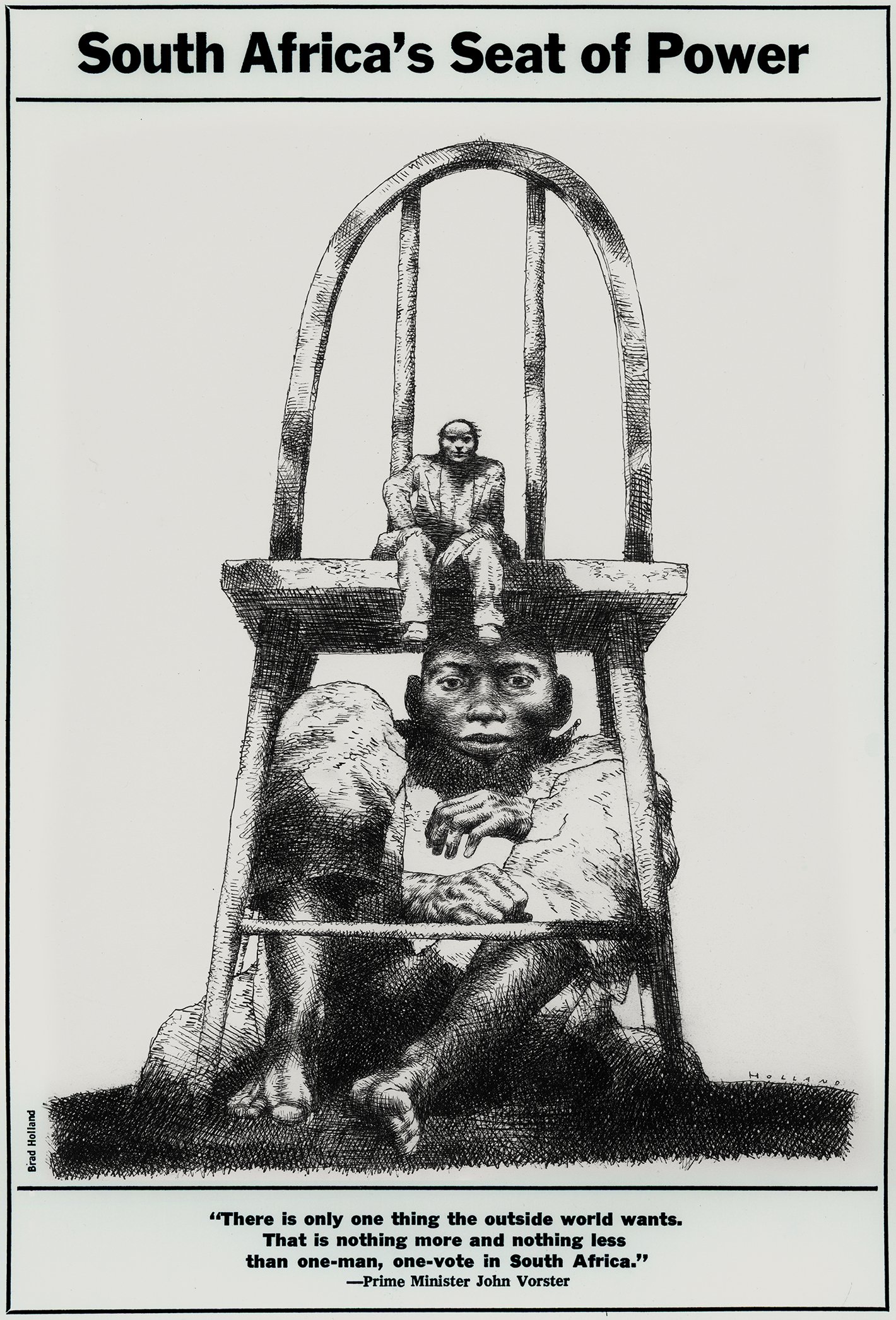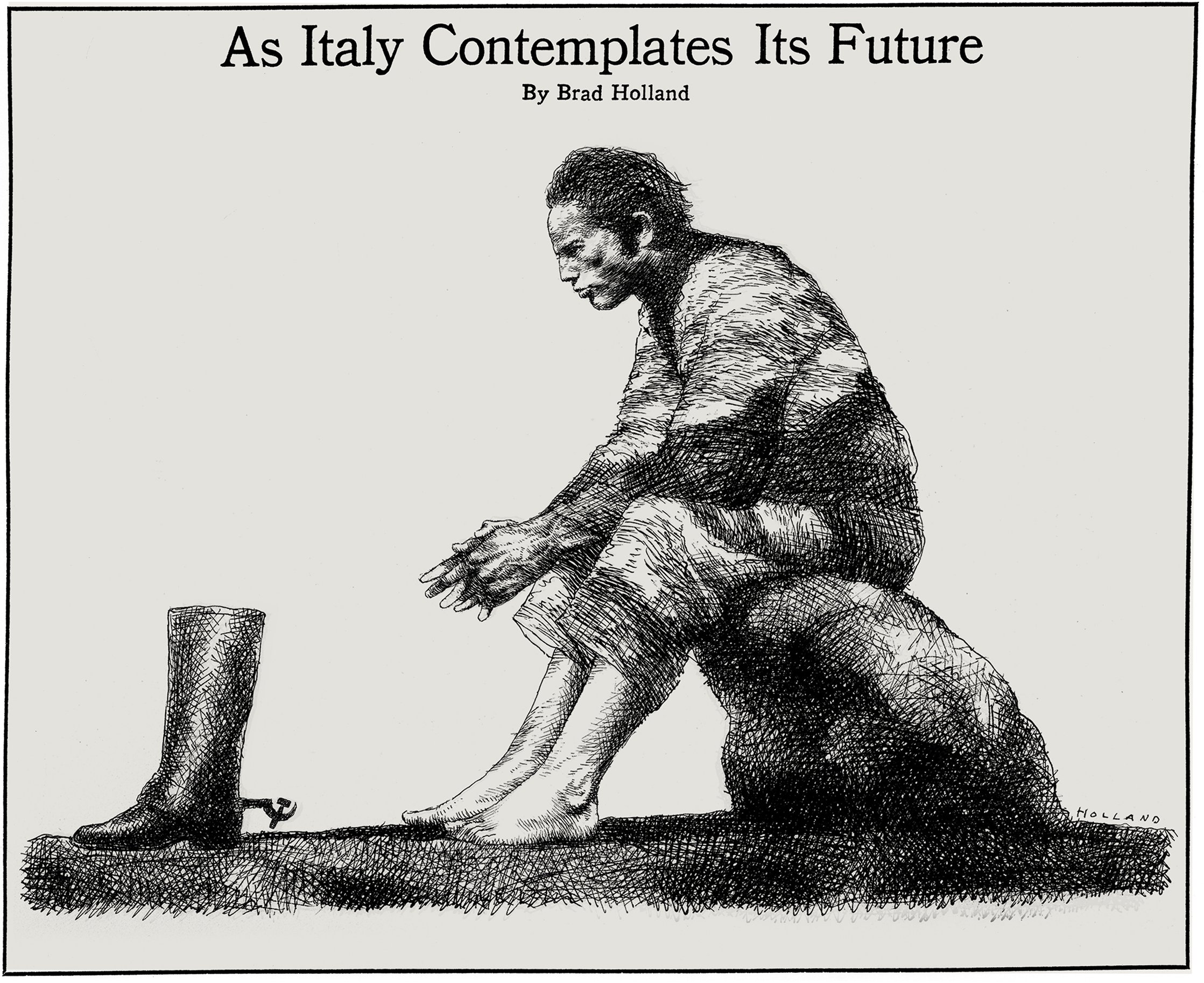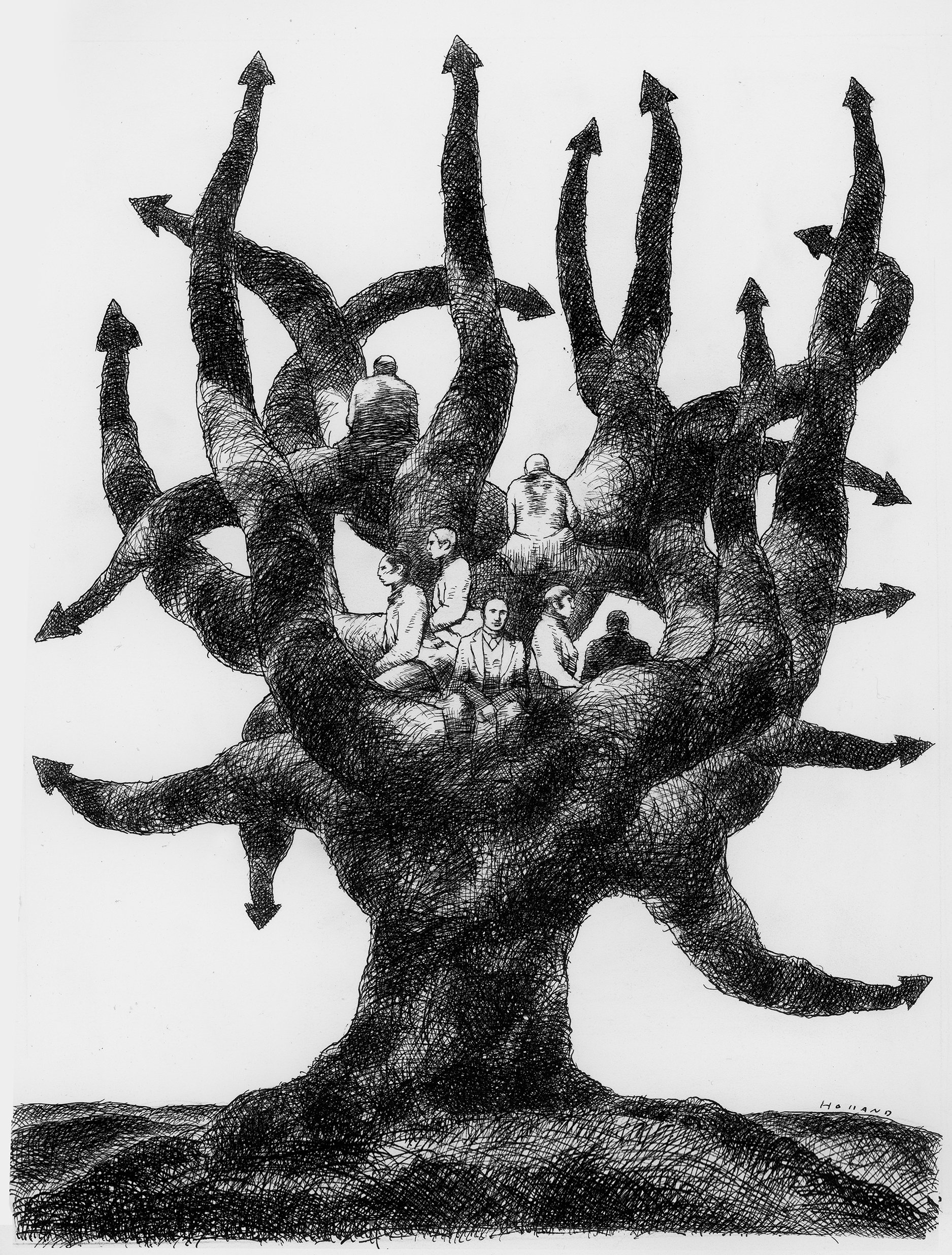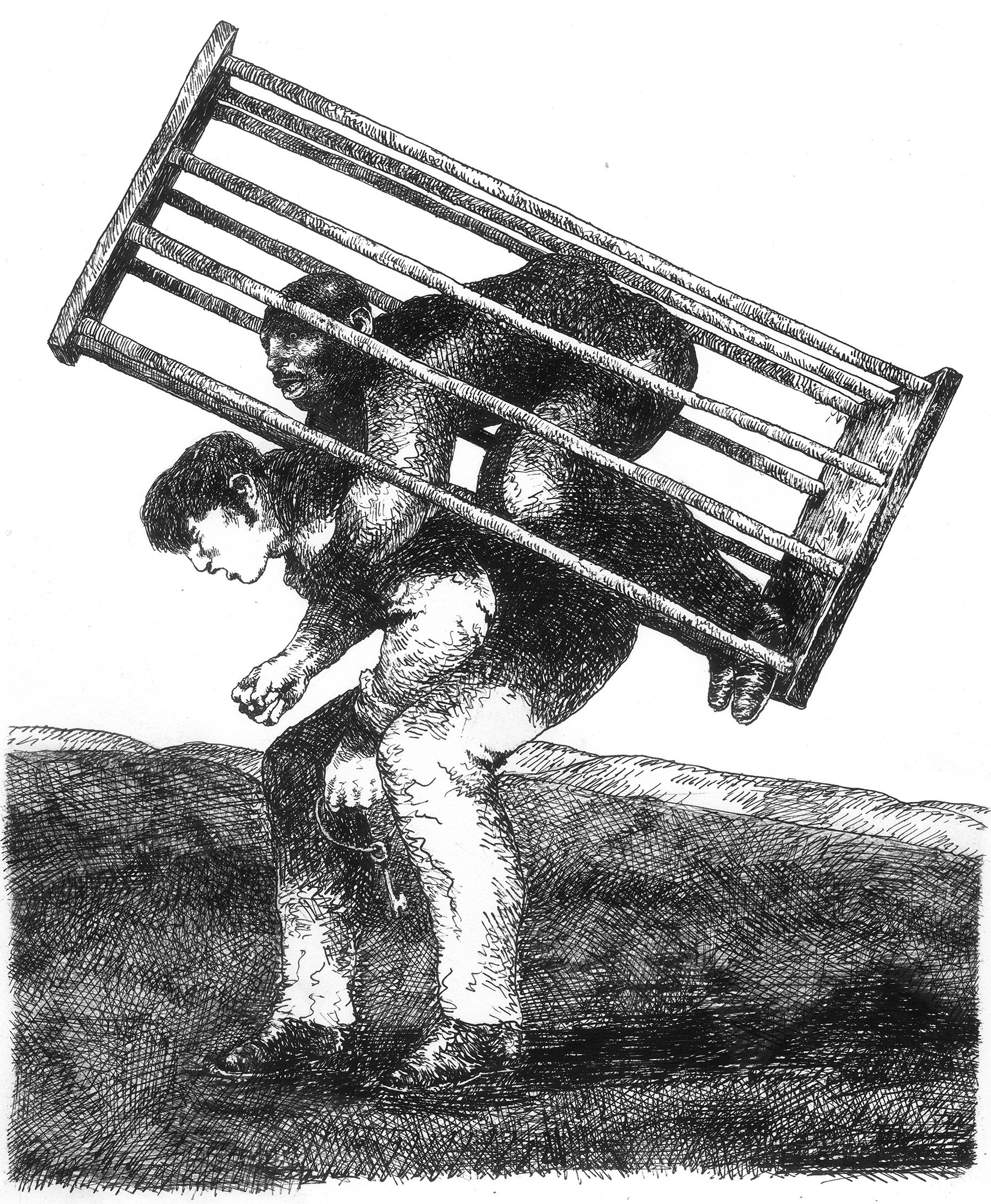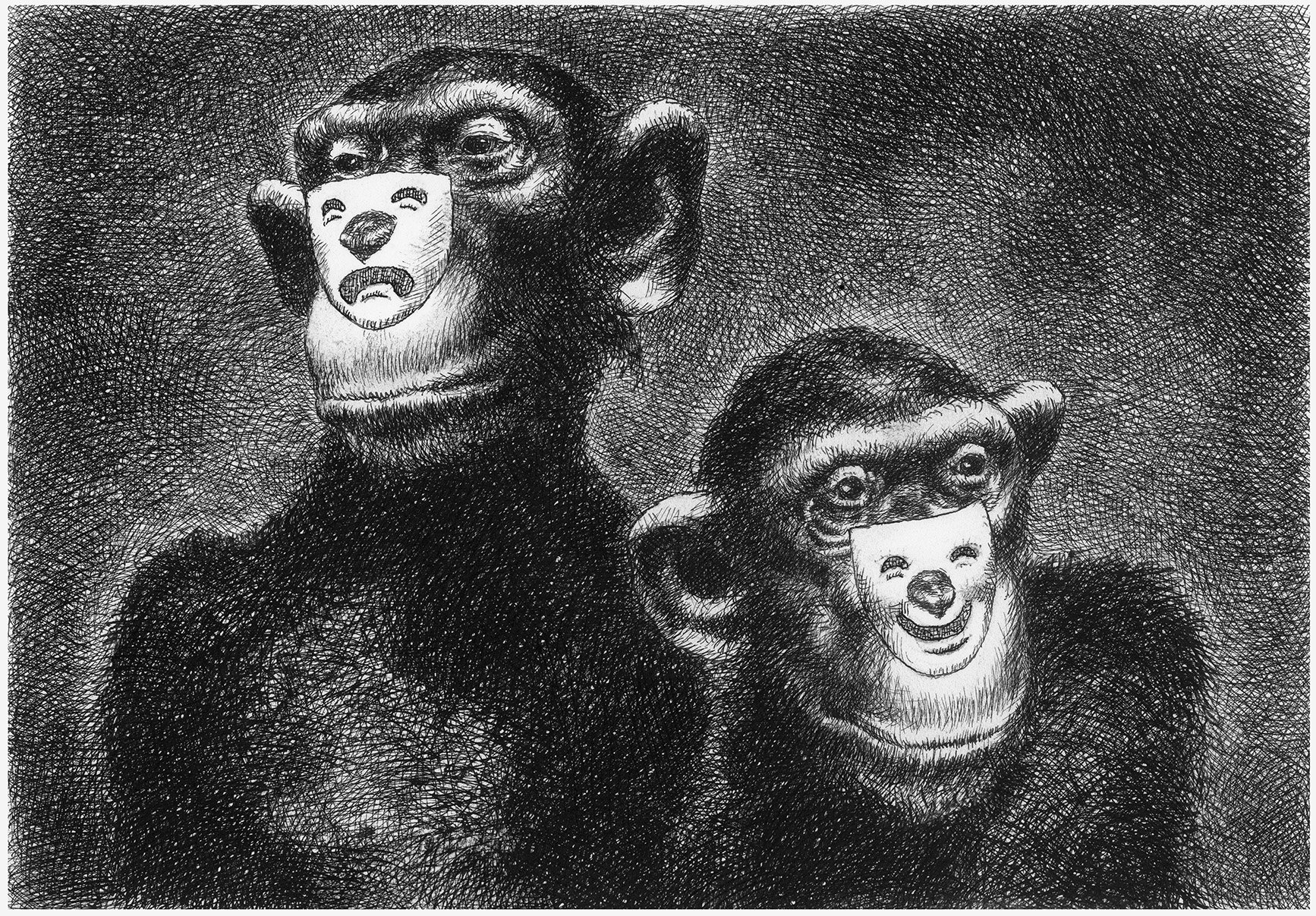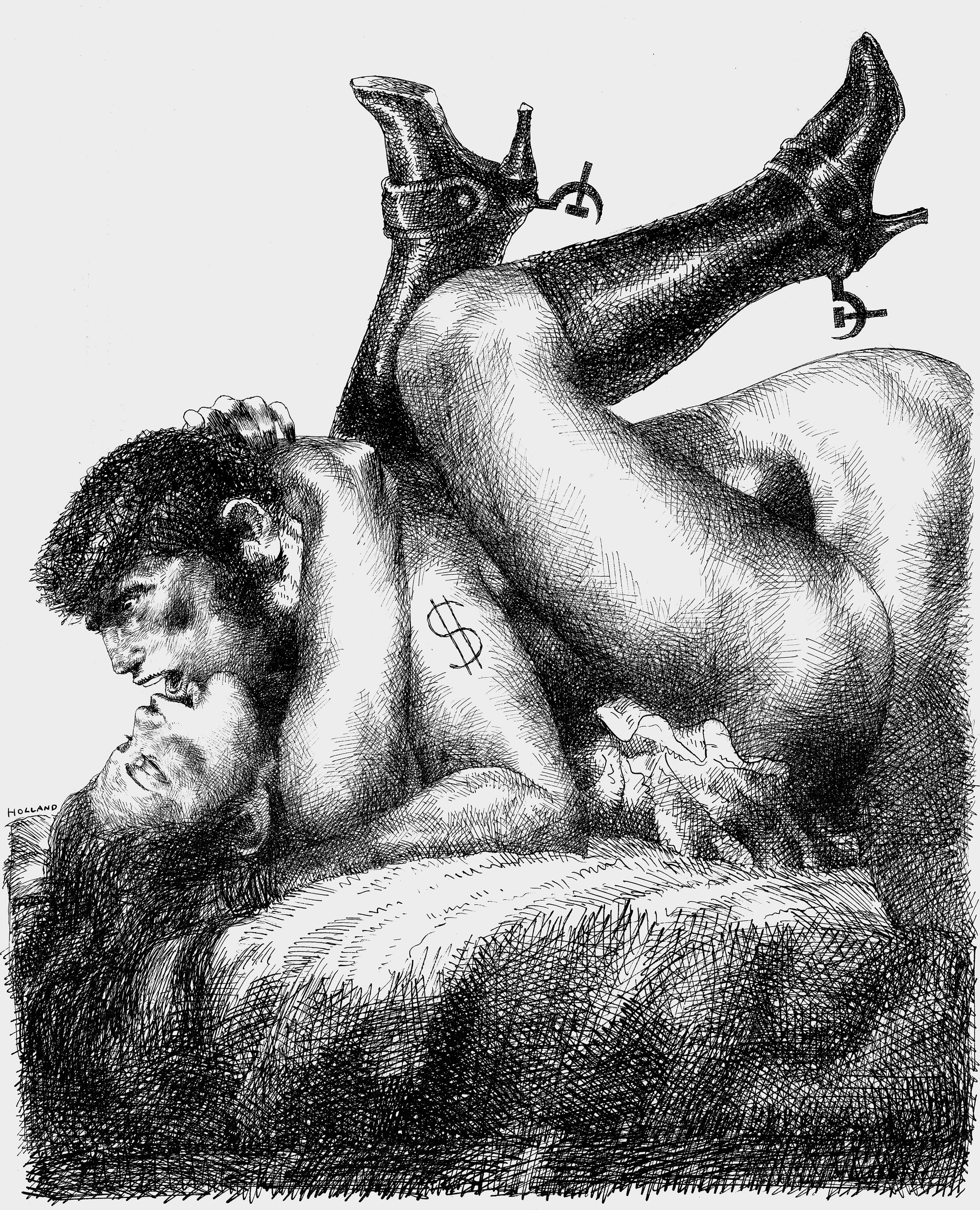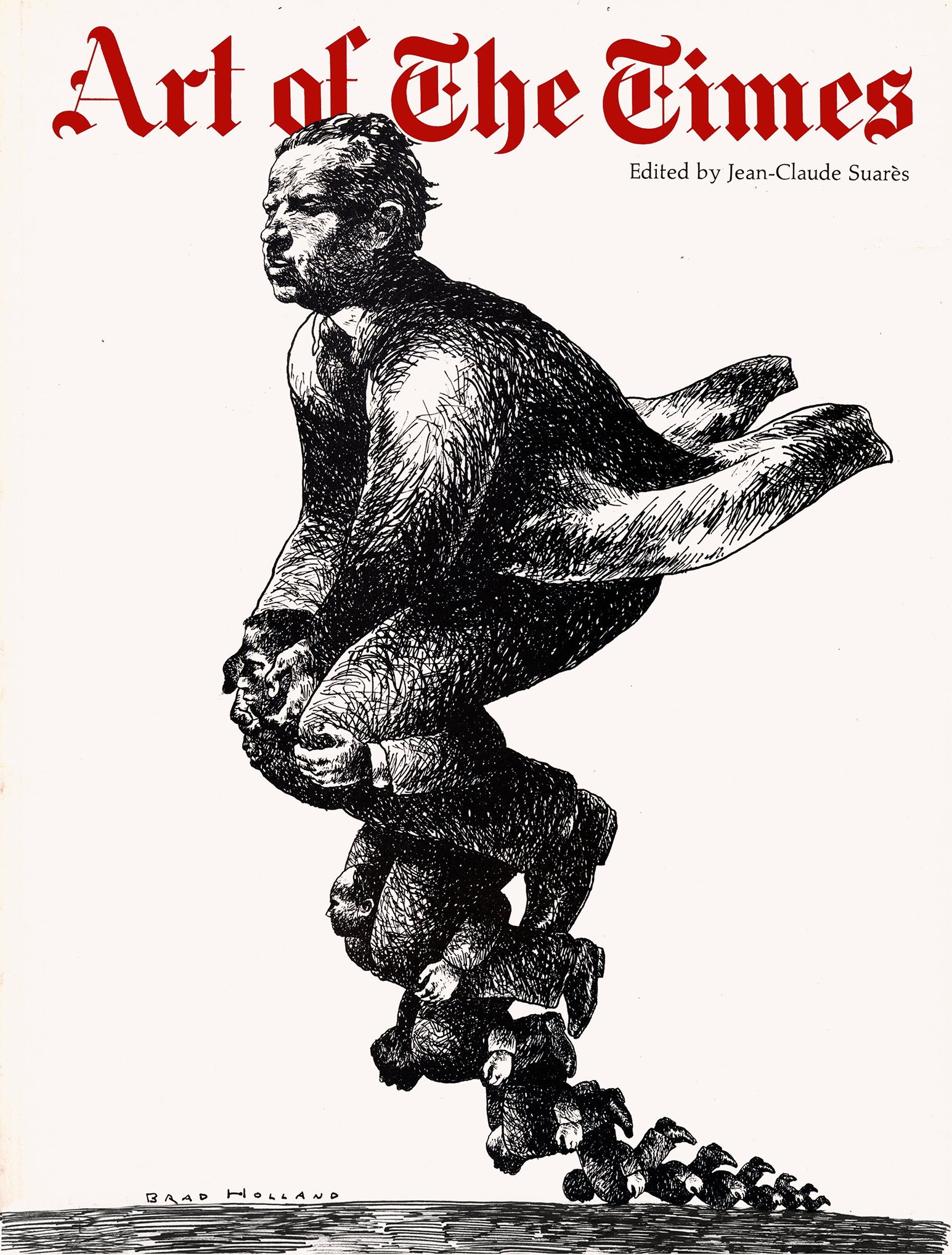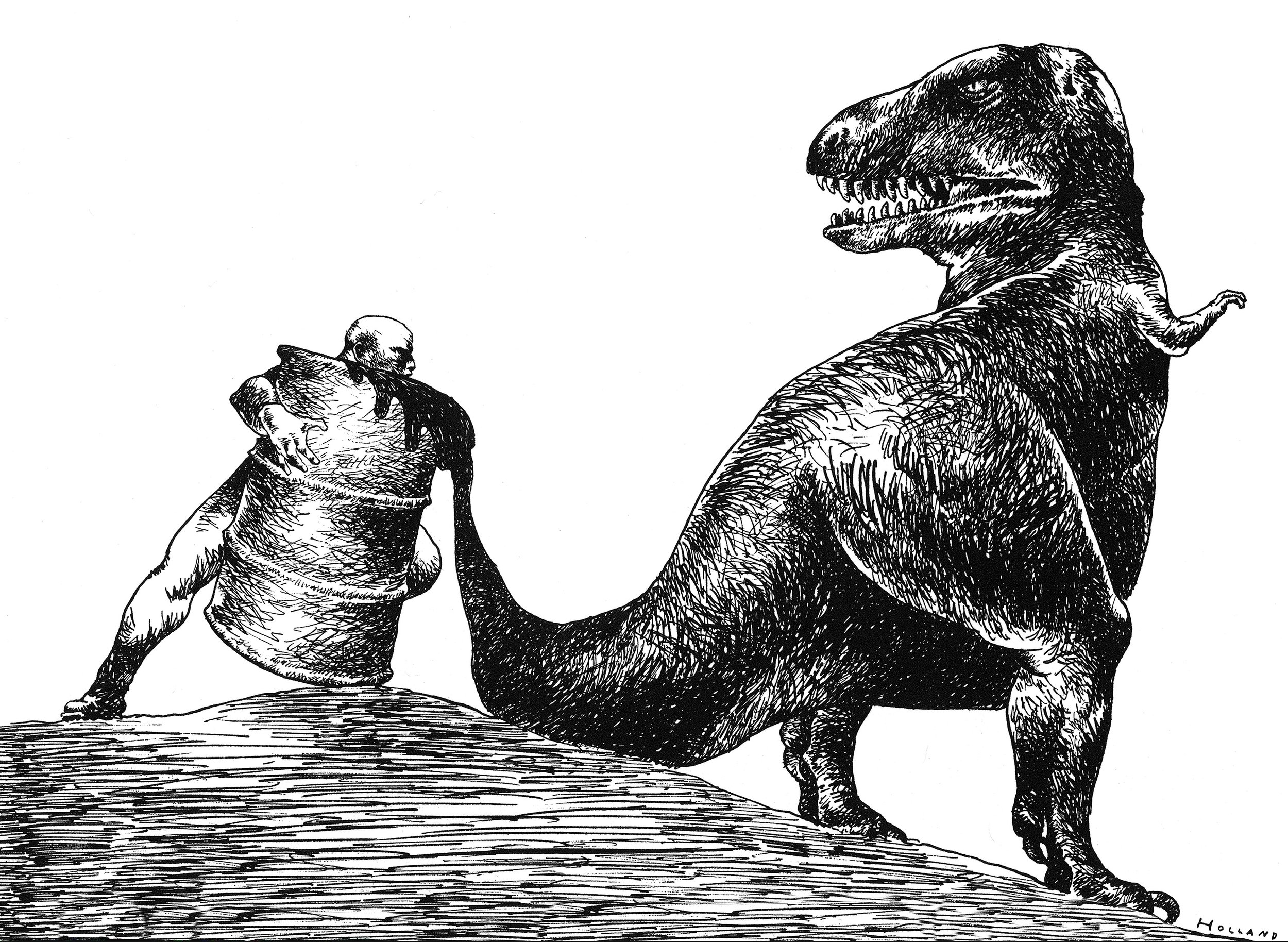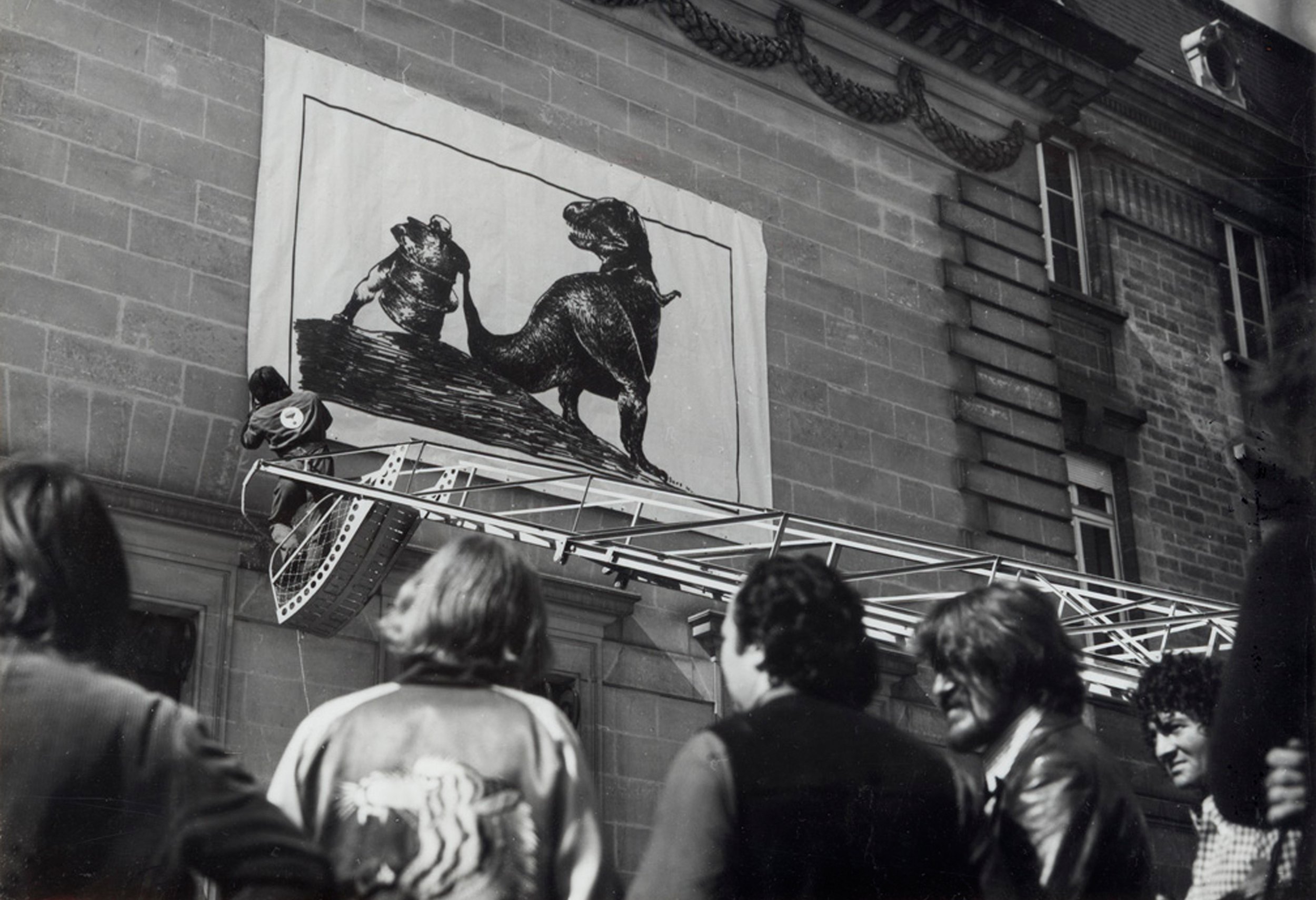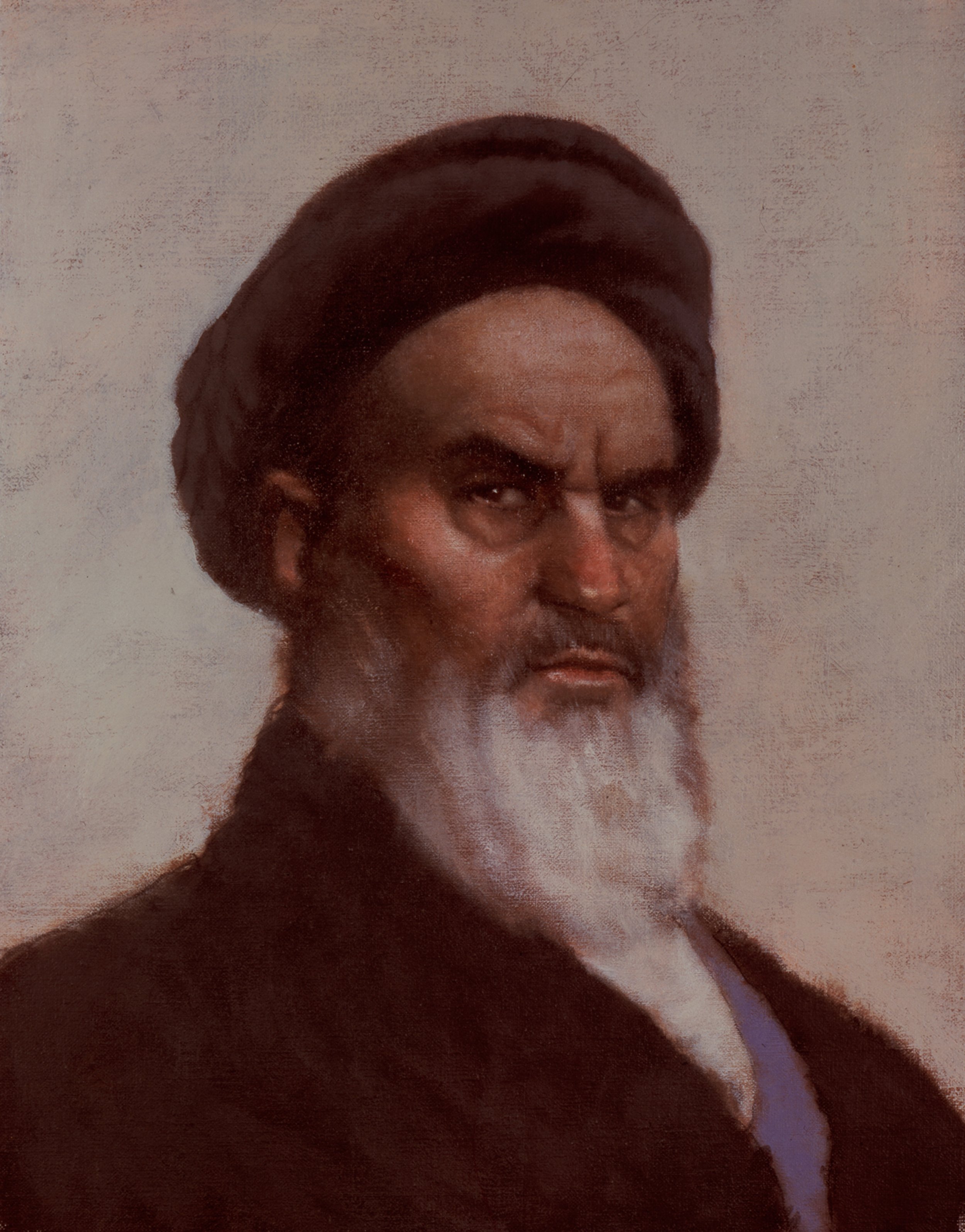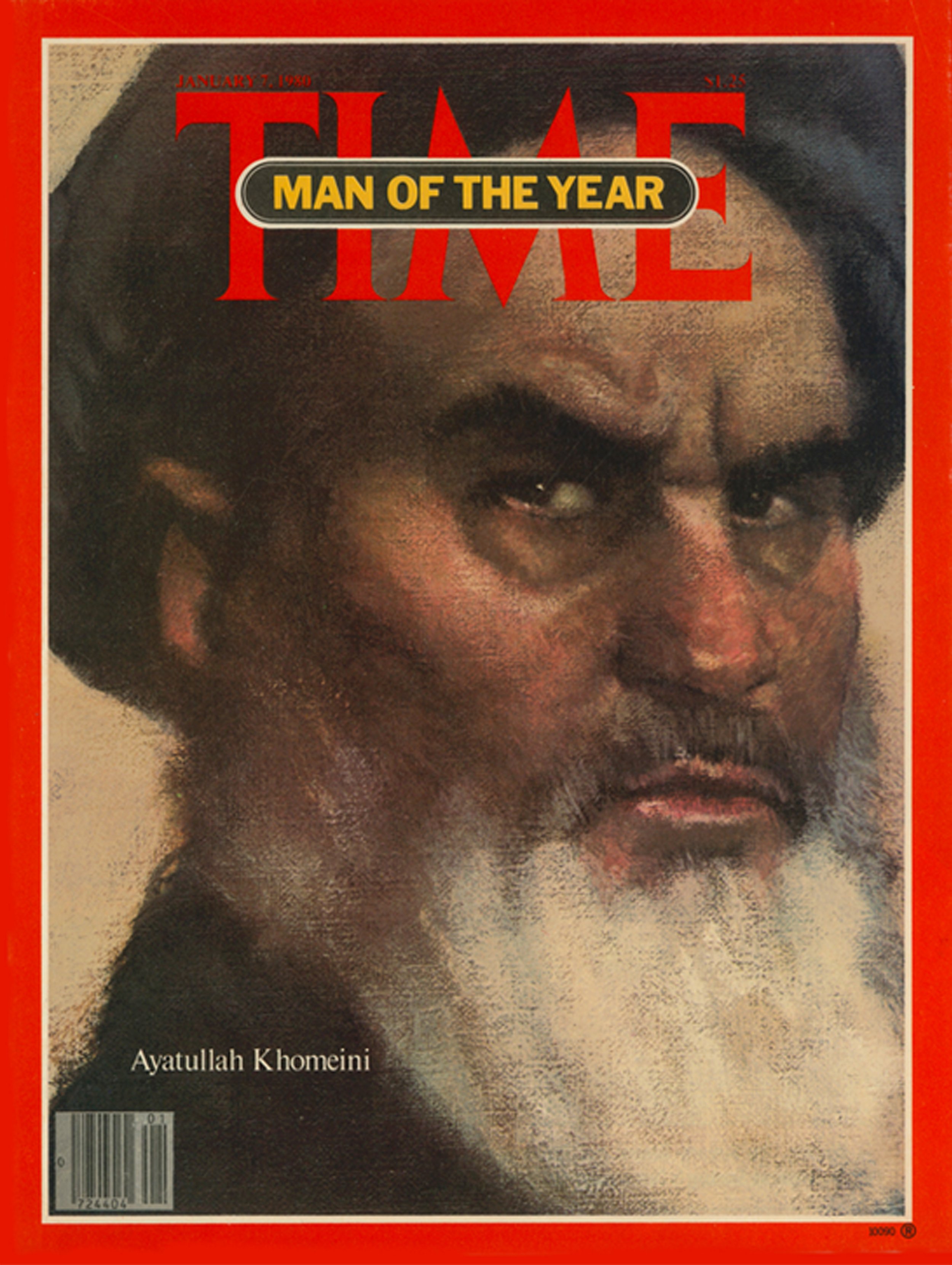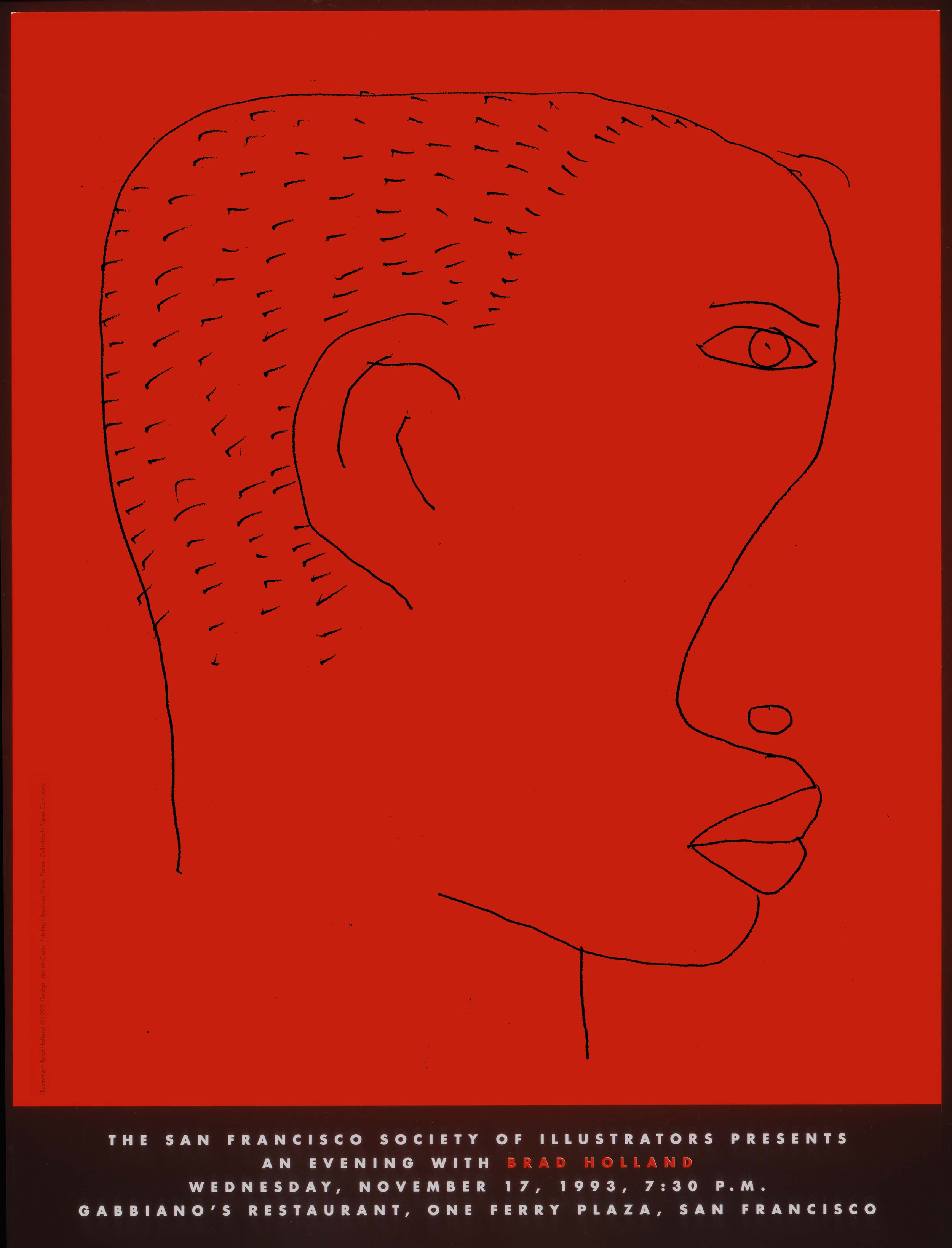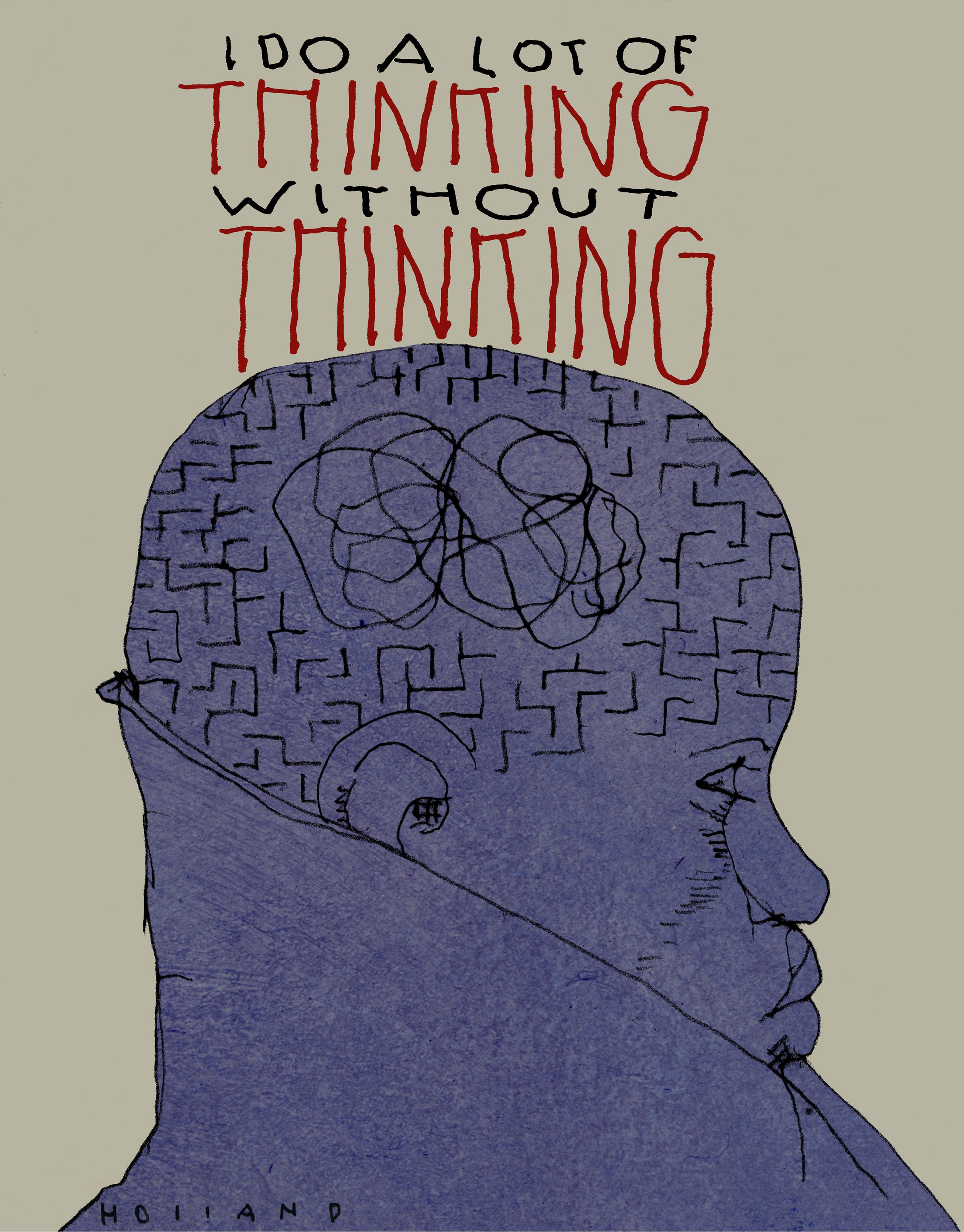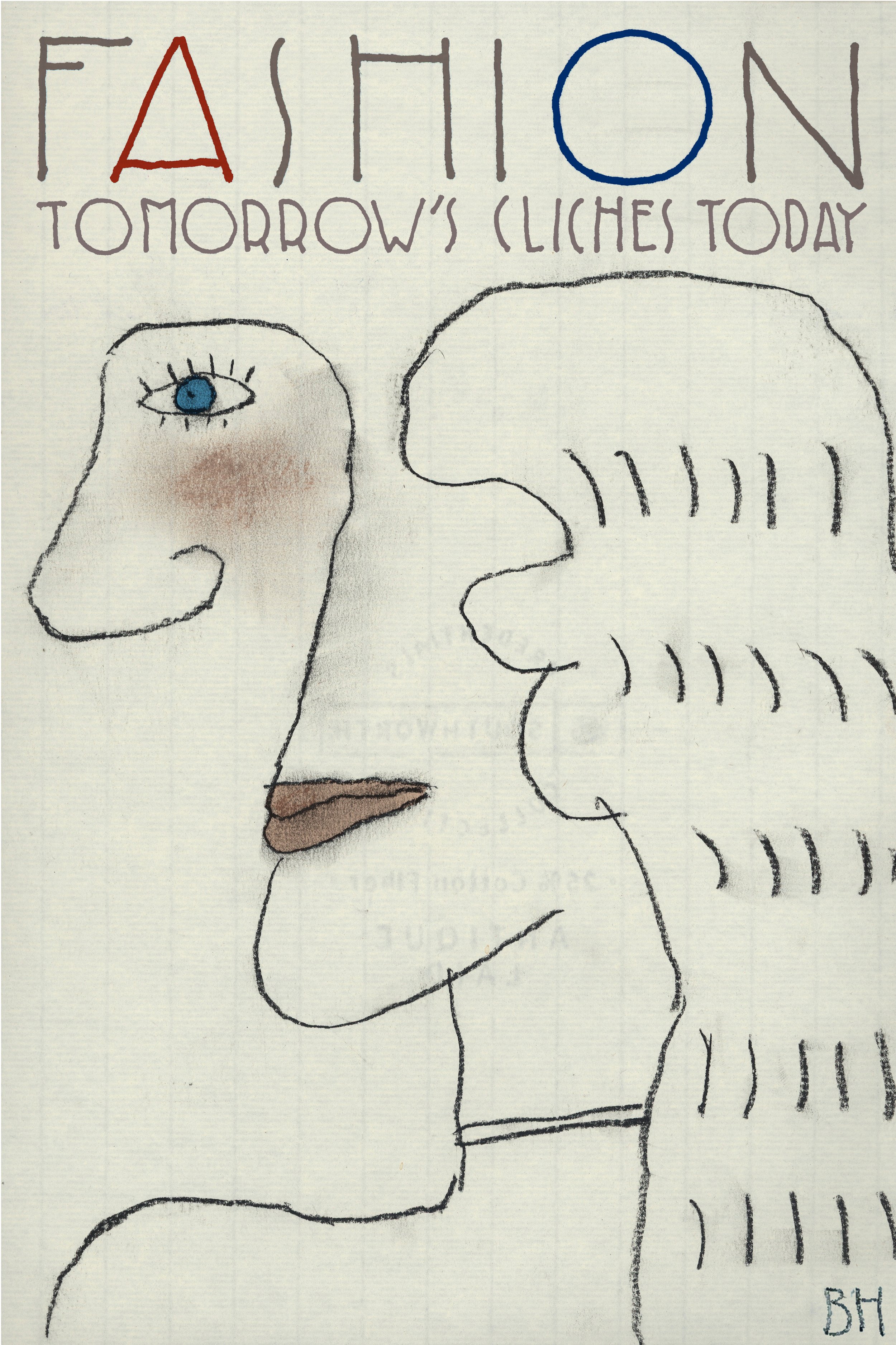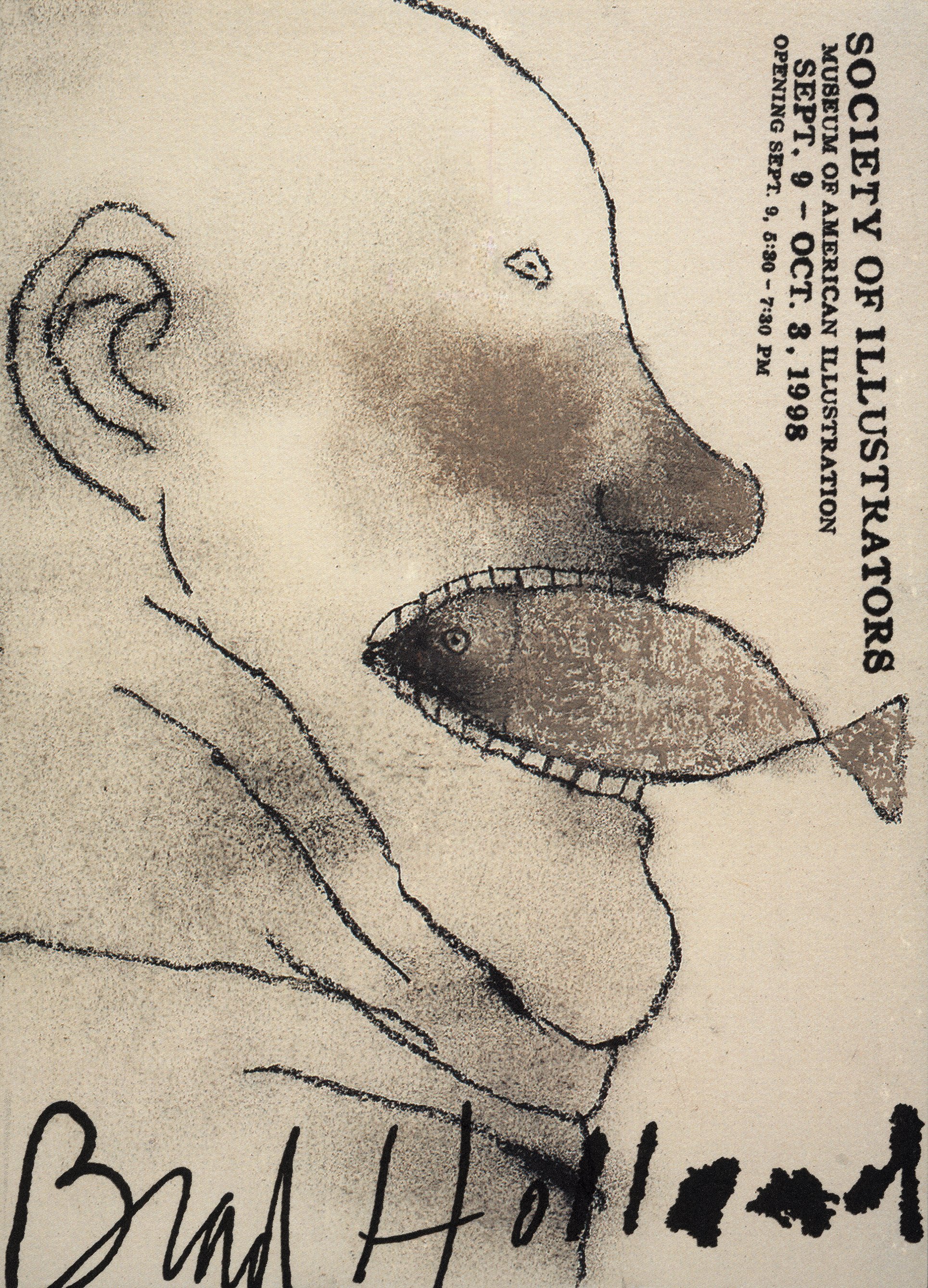A Freaking National Treasure
A conversation with illustrator Anita Kunz (The New Yorker, Rolling Stone, Time, more).
A conversation with illustrator Anita Kunz (The New Yorker, Rolling Stone, Time, more).
—
THIS EPISODE IS MADE POSSIBLE BY COMMERCIAL TYPE
By any measure, Anita Kunz has built a dream career.
She’s won every award, been inducted into every hall of fame, won every medal and national distinction. When her native Canada ran out of honors to bestow, the country minted a postage stamp in her honor.
Over the last 40 years, the Toronto-based illustrator has created covers for The New Yorker, Rolling Stone, Time, and many (many!) others. On top of that, she’s now authored two volumes of her own work.
“She is,” as Gail Anderson, her former Rolling Stone collaborator puts it, “a freaking national treasure.”
And yet, despite all that success, Kunz confesses to still battling with self-doubt. No matter how great the genius or how many accolades hang on the wall, the familiar feeling of insecurity and inadequacy spares no one it seems. Is this good enough? Am I good enough? Every thinking creative person faces these questions at some point in their career.
While the universality of self-doubt may serve as consolation for those wrestling with some type of creative crisis, today’s guest has a different attitude about it. Instead of trying to quash self-doubt, “embrace it,” she says.
“Self doubt is fuel—a generative force. Allowing a measure of uncertainty fosters experimentation, playfulness, and an open-mindedness that helps keep the ego in check.” And in a profession like editorial illustration, where rejection is ever present, self-doubt can transform into a survival skill.
In this episode, we delve into all of this, and we’ll talk about Kunz’ recent turn as an author, her favorite art directors, and that time she collaborated with an artistic monkey named “Pockets Warhol.” We also go into a dark moment when she was embroiled in a nightmarish copyright lawsuit. And, because it’s 2023, we’ll talk about what artificial intelligence means for her profession.
Anne Quito: Anita, I’m so pleased to finally be here. Since we first spoke I’ve watched, listened, talked to some of your colleagues. So I was thinking we’d start from the beginning. When we first corresponded, we chuckled at the notion that we share kind of the same name.
Anita Kunz: That’s right.
Anne Quito: And then you said that your ancestors trace back to Transylvania. Can you talk a little bit about your background and your family?
Anita Kunz: Well, sure. Yeah, so we are from a long line of people from Transylvania. In the 12th century there was a group of German people who went and settled in Transylvania, which, you know, is Romania.
And so I think what happened was that they, at that time, I mean this is so long ago, but I think at that time they needed to settle Romania, and I think a lot of Germans went and made their homes there. They were farmers and peasants and I think they were given a pretty good deal. I think they were given land and they didn’t have to pay taxes for five years.
And I just recently have been doing a bit more research into it and I find it really fascinating. We went there a few years ago and it’s beautiful and rugged and the, you know, the mountains are just, it’s just beautiful.
People think it’s very weird, and I remember my mother didn’t really talk about it that much because she didn’t like the way people talked about her people. She didn’t like the whole vampire thing, right? But anyway, if anybody is interested in Transylvania, King Charles has an Airbnb there and you can go, and one of these things that I discovered is that he is a very distant cousin to Vlad the Impaler. So there is a Transylvania connection. But that’s the extent of what I know.
Anne Quito: That’s incredible. So good. And your last name—I always have this hunch—I mean, I’m a reporter and I meet a lot of people and sometimes someone’s last name, or I would say often, gives a clue about their ilk. And your last name is Kunz, German for “art.” As if you are destined for this profession.
Anita Kunz: I guess so. I guess so. It’s very, very close. It’s “kunst,” but, yeah it’s, it’s very close.
Kunz’ uncle Robert Kunz (above)—a major influence for her—was an illustrator in Toronto.
Anne Quito: Yeah. Was art a big part of your upbringing? I know you were influenced by your uncle. Maybe you can talk a little bit about that.
Anita Kunz: Yeah. My first, and one of my biggest, influences ever was my uncle Robert Kunz. And he was an illustrator. And this was way back, way back when, and his motto was “Art for Education.”
And so, kind of from that, I learned that it would be great if art could serve some kind of a purpose or be useful in some way. And it didn’t just need to be decorative, it could perform a function. And he was a huge inspiration. Not only was he an illustrator, he illustrated all the textbooks when we were in high school and he did the “Children’s Corner” in our local paper in Toronto. He was just amazing.
But also, he was just a quintessential artist. He did weavings, and he made architectural freezes, and landscapes, and all that kind of stuff. But what I loved about him is that he also influenced me on my worldview, which is that he had a studio on the lake. He was an environmentalist, and he knew the names of all the animals. So I loved that whole, that aspect, of him too. So, yeah, the first big influence for sure.
Anne Quito: I’m going to make a sharp turn to magazines. Because when you spoke, you said you’ve always loved magazines and this is what you wanted to do. Can you talk a little bit about why? I know you did some early work in advertising as well, but what made you fall in love with magazines?
Anita Kunz: Well, you know, I didn’t know what I was going to do. When I went to art school, I went to the Ontario College of Art, and the only thing that I knew was that I wanted to draw pictures and I needed to make a living. It was as simple as that.
So I went to college and I thought, well, I guess I’ll be a children’s book illustrator. And then I developed this kind of very cute style. And then I did some advertising. But actually, I did quite a bit of advertising and I was able to, you know, I was lucky to make some money, but I got tired of drawing little animals in skirts and making cute stuff.
And I wanted to grow and I wanted to do things that were really interesting to me and things that were more political. And anyway…
Mick Jagger and Keith Richards as Fred Flintstone and Barney Rubble for Rolling Stone.
Anne Quito: I heard you describe your very first paintings as “very, very dark.” Is that true?
Anita Kunz: Okay, so I went through a phase where I did really cute stuff. But then what happened was, I became very influenced by some of the British artists. And what happened at that time, and this really catapulted me into magazine work, was that two great art directors came to Toronto through Toronto to New York via the UK. And it was Robert Priest and Derek Ungless.
A Ralph Steadman portrait of Kunz.
And they went on to do great things in the magazine field. But what they did in Toronto was Weekend Magazine. And Weekend Magazine came out once a week and it was kind of a general interest magazine, but they were using people like Sue Coe for skiing, for a skiing article. They did a great cover of the Anti-Fur Industry by Ralph Steadman. And I just began to really love the work of the British illustrators.
And the work was darker. And I really tried to stretch instead of doing, you know, work that was cute and “palatable,” I just really wanted to get into doing some more substantial work and to really be more of an artist and make work that was much more personal. So that’s kind of where that’s where that started.
But also, when I started, there seemed to have been so many possibilities. I mean, these art directors were doing really amazing creative work. It was really out of the box thinking. I’ve been thinking, I knew I was going to talk to you about this. I’ve been trying to think of examples. I’m pretty sure it was Robert Priest, who was doing something for a magazine. It was a fiction piece, and it was about three very different characters. So he got three different illustrators to illustrate one piece. This is really amazing thinking.
So very, very early on I was drawn a little bit to dark work. But also I just loved, to me there seemed like endless possibilities in the magazine field.
Anne Quito: I hear some nostalgia for what was. Why do you think things changed so abruptly? Do you think it’s the speed of production? What happened?
Anita Kunz: We’re talking about a span of 40 years here. I don’t know how they got away with it, except that they were allowed to do really creative work by the publishers. By the editors. So I think it all goes up to who’s running the show.
But I do remember back then, doing all of this social- and politically-oriented work and having carte blanche, like having complete autonomy. That’s the kind of thing that I think is really different now. I would get a manuscript and I would be asked to give maybe one or two sketches. But I think back then there were a lot more art directors who were thinking in terms of, not style necessarily, just style, but that the illustrators, maybe, we had a brain and that we had thoughts about these things, and we had emotional reactions, and we had intellectual reactions to the piece, and then it didn’t just have to be the way it looked.
“Very early on I was drawn to dark work. But there seemed like endless possibilities in the magazine field.”
Kunz’ 2017 cover for Variety was a nod to a 1968 Esquire cover featuring Richard Nixon.
Anne Quito: Do you remember your first magazine cover?
Anita Kunz: The first cover…I’ll tell you the first illustration I ever did. The first public illustration I ever did, I got out of school and, you do everything that you’re going to do and, you spend hours putting together a portfolio and it has to be perfect. And you’ve asked all your teachers what you need to do. And, so I went out there and I got a—it was for Toronto Calendar magazine or something. It was about the “Great Canadian Bathtub Race.” And it was something so inconsequential. And I think it was maybe a three-inch wide spot.
And it was just really silly. It was just probably some little, I don’t even remember, some little race to do with charity. And I got the job on Friday, and I immediately went into an anxiety attack/panic mode. I cried all weekend. I delivered the job. I’m like, it’s so cute when I think about it now. I was just so desperate that this was going to be this incredible piece for the Great Canadian Bathtub Race.
It was just, it’s kinda sweet when I think about it now, but I guess they liked it. I must have chilled out a little bit after that, but I thought, “I can’t do this. This is so stressful. I can’t do this.”
Anne Quito: I want to go back to that emotional rollercoaster, but first I’ve got to ask, what is the Great Canadian Bathtub Race?
Anita Kunz: I can’t really remember. Well, I don’t remember what it was, but I think it was just a silly thing. I assume it was done for charity. But I mean, that was my big splash into the field of illustration.
Anne Quito: I want to go back to what you said about art directors and freedom. And your work has been, as we all know, has been published in every major magazine over the four decades: Time, Newsweek, GQ, The New York Times, The New Yorker. Can you tell me what makes a good art director?
Anita Kunz: I actually have an awful lot to say about that because without great art directors illustration really can’t thrive. The ones who are the most open-minded and interested are the ones that, you know and, in my view, offer the most creative freedom, I think are the best. And I am so endlessly lucky that I’ve gotten to work with these incredible people. I’ll name some of them if you don’t mind.
In Toronto one of the first great art directors I worked for was Louis Fishauf. And he was at Saturday Night magazine. And this was after my cute phase. This is when I was doing serious illustration. But the subjects that he gave me to illustrate, I mean, I remember there was one about Helmut Rauka, who was a Nazi war criminal found living in Toronto, and the assignment was to basically read it and come up with a couple ideas and that was it. It’s a far cry from what happens now where it seems like almost every detail we’re being told exactly what to draw. But, I had such a visceral reaction to the story. I think that always helps come up with a better image.
I’m just going to interject here and say, I moved to England for a while and I went to see the art directors there. And I went to see Gary Day-Ellison at Picador Books, I knew he was a great art director, and the first thing he asked me was, “What do you read?” I mean, that sounds like such a nothing question, but it was so that he could know what kind of jobs that I could do my best at.
I worked for Steve Heller. I worked—I was in the right place at the right time. Tremendous luck. Arthur Hochstein. I got to do Time covers. And I did some Canadian Time covers for Edel [Rodriguez]. But, I didn’t want to make a list for you because I knew that if I left some people out, I would feel terrible for a week after. But just all this wonderful work that we illustrators used to get, you know?
I used to get two or three jobs a week and I just wrote down some of the topics all over the place, but really interesting. Socially- and politically-oriented subject matter about things like marijuana legislation, chronic fatigue syndrome, Viagra—I did a Time cover about Viagra—American politics, motherhood. I did the sex column for GQ. Censorship, the drug wars, gun control, child abuse, politics. This was pretty heavy stuff.
And a lot of us illustrators because we were given this great, tremendous freedom, I really think it was a little golden age in the eighties and nineties. I didn’t realize how great it was and how lucky I was to have that kind of freedom to make pictures and have everybody see them. It was amazing.
Anne Quito: I love hearing those stories, but as we know with great freedom, the burden goes to the illustrator to come up with a novel, original solution. Now, I spoke to one of your former art directors at Rolling Stone, Gail Anderson. I said to her, “What would you ask Anita if you could ask her anything?” Actually, her real answer is, “Can I buy one of her paintings?”
Anita Kunz: Oh, but I’ll send her one. Oh my goodness.
A 1987 Rolling Stone cover portrait of Michael Jackson
Anne Quito: But her real question is—I’ll read it—she says, “How has she kept it going at such a high level for so many years?” She says, “I mean, I go back to 1994 with Anita, and that was a long time ago. Anita’s managed to get better and better and has never rested on her multiple laurels.” How do you keep it going? How do you keep it fresh?
Anita Kunz: Well, that’s, that’s incredibly sweet. I think Gail is one of the great art directors. I loved working for her. First of all, I could talk for an hour about Fred Woodward. Maybe we can talk about him. But just working for Gail. You know, she was—she is—one of the greats, and I don’t think a lot of people realized at the time that Fred was doing all these amazing spreads and designing all this great stuff, but so was Gail.
I think a lot of people may have assumed that it was all Fred, but she has always done this, like, amazingly terrific stuff. And I certainly was hoping that she would get the art direction job after Fred left, but you know, she’s absolutely amazing.
But I could ask her the same thing. How does she keep it going? But I think I just have a restlessness. There’s all kinds of stuff I still need to do, feel like I want to do. As I get older, I feel more of a sense of urgency, like, “Oh, I want to do this,” and, you know, “I need to do a book about this.” So there’s all this stuff I still want to do.
Also, I’m absolutely terrible at boredom. Some dark things happen when I’m bored. I really need to keep—I need to keep busy. The pandemic was, you know… I don’t know. I had to do something, so I painted 400 pictures of women to know.
Anne Quito: That’s incredible!
Anita Kunz: But I got stuff done. I just am very restless as a person and I just need to keep doing stuff. So that’s the real answer. But thank you Gail.
Anne Quito: I’m going to go back to the book and the 400 portraits in a second. But I want to ask you—so you are restless, you are thinking of ideas. What happens if you ever get stuck? I always ask this because, as a writer, there are some things like “walk around the block,” “drink a lot of water.” I don’t know, some weird tactics. But it’s never worked for me. My only thing is to start. I wonder if you’ve ever experienced the so-called block on a deadline?
Anita Kunz: Yeah. Oh, sure. Yeah. I don’t think there are any artists or writers who don’t. But I think sometimes I remember in the past I just got really tired of doing the same thing and using the same formula. And I just thought, “That’s it.” And I got some clay and I started playing with clay and I just needed to pound out some of the frustration.
But I think I try something different. I think that’s the answer. Just I try something different. But it happens a lot and I think whatever you can do I think everything that you said is right, go for a walk.
But I’ve put together all these quotes for students and I can’t remember who it was. It may have been Chuck Close, maybe it was Milton, it was probably Milton Glaser, who said, “You just have to sit down and keep going and it’ll come back.” You know, it’s not always about inspiration. It’s about just sitting down and actually getting the work done and it will come back. And I’ve found that there are always ups and downs, but it will come back. Or maybe it won’t. I don’t know. It hasn’t—I’m still doing it. I don’t know.
For a 1989 Rolling Stone feature titled “In Search of Historic Elvis,” Kunz portrayed the King throughout history.
Anne Quito: You’re still doing it. You’re living proof that it works. You’ve also talked a lot about handling rejection. Now in those 10 tips you give to creatives you’ve written, I think, a list that you constantly update maybe. But one of them I was really struck by. You said, “Embrace self-doubt. It will propel you forward.” Now I have a follow-up question there. Self-doubt can sometimes be interpreted as a lack of confidence. It can be a negative. But how do you spin that? How do you propel that forward? And also where does the artist’s ego or voice come into this interplay?
Anita Kunz: First of all, rejection is so commonplace in the arts. You really have to develop a thick skin. So I don’t really quite know how I did it, but the whole thing about moving through the gut churn or whatever. Milton Glaser said that. So what I’ve written for students is really stuff that I never knew. I was wondering why, when I was young, like, “What’s wrong with me? Why am I always dissatisfied?” And, you know, “What can I do?” And, “What can I do to be better?” And, “What’s wrong with me?”
I always used to think that kind of stuff, but I never learned anything in school about that. What we learned in school was that, “Here’s how you do the job and here’s what you do. But none of the surrounding things. So yeah, it’s just moving through it, and I think the bottom line is just, it’s something that you feel that you need to do. And so whatever it takes, it just needs to be done.
And I don’t know where I developed that kind of tenacity. I think I was just always really stubborn. And I still have a lot of rejection. It’s really common. And I think it’s important for students to know that. It’s not them.
Anne Quito: I wanted to probe more on the self-doubt thing. I wonder how you feel whenever you submit an illustration. What are the feelings swirling around you? You talked about how you felt for the first illustration, you were wrecked with doubt and worry. Has that simmered down? How do you feel?
Anita Kunz: Thankfully it simmered down, otherwise I would’ve had to do something else. But when I do commercial illustration, every one is really different. Every job has its own set of parameters. Sometimes they’re completely self-generated. But for the most part, when I hand them in, there’s no great eureka! There’s no great joy. I always think I could have done better. And when I see it in print, I think, “Ah, I should’ve done this, or I shouldn’t have done that.”
I listened to Barry Blitt’s episode—which was great, by the way—and I was actually interested to hear that he does things two and three times. So for somebody like him, I mean, part of what he does that’s so brilliant is that the work looks so effortless.
But anyway, I don’t really know too many artists who aren’t insecure or don’t have tremendous self-doubt. I think that’s kind of the nature of the beast.
“It was a golden age in the eighties and nineties. I didn’t realize how lucky I was to have that kind of freedom to make pictures. It was amazing. ”
“The New Yorker was 100% behind me,” says Kunz after another artist claimed Mohawk Manhattan (above) was a stolen idea.
Anne Quito: Can I ask you about what you described as maybe the darkest point in your career? Is that okay? I read about a lawsuit you were embroiled in—sorry to bring that up—with The New Yorker. I think it was a 1995 cover, and someone claimed that he had the same idea. But what really interested me was you saying that after that, you became a little paranoid?
Anita Kunz: Well, I was paranoid to begin with, but that didn’t help. Well, there was an artist who—after my first New Yorker cover, it was 1995, and I was so thrilled. And, first of all, Françoise [Mouly] is another person we could talk about for an hour. She’s amazing.
But yeah, so I did my first cover and it was called “Mohawk Manhattan,” and it was around the July 4th weekend, and it was all about, “America! Rah, rah, rah!” But I wanted to sort of do something about, you know, Native Americans, and that they were really the ones who were ripped off.
So I wanted to make a nod to Native Americans. You know, let’s think about that on July 4th. So I did “Mohawk Manhattan,” and it was an indigenous person with a Manhattan skyline. And so after, I was thrilled. My first job. I was so happy.
And Françoise called me and said, “There’s somebody here who said you stole his idea.” And I said, “Oh, okay. Who is it?” And she gave me information and I called him. And probably I shouldn’t—like now, that would never happen. Now, it would just be like, “Let’s get the lawyer.”
So anyway, he seemed to think that I stole this idea. I didn’t know who he was. Nobody I knew knew who he was. And he presented me with a lawsuit. It took four years in Manhattan civil court. It was kind of a nightmare. And the whole point was that it was a plagiarism lawsuit. He said I stole his idea.
But of course the further we went along, the more ridiculous it sounded. Really ridiculous. And then ultimately, of course, we won. But what ended up happening was now, if you become a copyright lawyer—it’s a precedent setting case.
Nobody has ever challenged the notion of copyright. So after all said and done, it’s something that young copyright lawyers learn about. So it’s a very famous case. But what you said is correct. I mean, when you’re accused of something like that you’re thinking, you know, “Maybe I was walking in New York and someone walked by with a t-shirt on and I subconsciously registered it.”
And so every time I did a job and the idea came too quickly, I remember thinking, “Oh, I must have seen it.” It really jeopardized my ability to come up with ideas. And of course, we know that ideas are not copyrightable. So it basically made that case. But yeah, that was a really low point for me.
But I have to say, The New Yorker was 100% behind me. Because if you’ve worked in this business long enough, you know that the ideas are something that we all use freely. I used to work for Newsweek and Time magazine, and sometimes they would come up with the same idea. That’s why we use ideas to, you know, to talk about concepts.
Kunz in her Toronto studio
Anne Quito: And also with social media, on Instagram. We’re saturated with images.
Anita Kunz: Yeah, absolutely.
Anne Quito: Have you gotten over this sort of paranoia or like double checking if someone has ever done the same construct?
Anita Kunz: Well, I think I understand that it happens. I remember my beloved—my great art teacher, Alan Cober, one time we came up with the same idea. It was for something about pollution. It was an Earth Day and we both did like a pig with, you know, and it was just, we laughed about it because that’s what happens.
But one of the things I do now deliberately is, before I submit something, maybe to The New Yorker, I’ll do a Google search and if it’s been done, I won’t do it. So I sort of preempt it just in case, but that’s fair enough. I don’t want to do something if someone else has done it anyway. It’s just courtesy.
Anne Quito: I want to shift to your techniques and tools. I know you told me that you still paint in this sort of era of digital illustration.
Anita Kunz: Yeah.
Anne Quito: You use acrylic paint and there’s a particular thing we had talked about. I said that I love how you render eyes and you said, “Oh, actually people have commented on how I render hands.”
Anita Kunz: Oh, that’s right.
Anne Quito: Can you talk about your hands, how you take care of them and why this fascination with hands?
Anita Kunz: I mean, it’s just the way I draw, honestly. When I started, I just tried to get it together to do a drawing quickly because there were always deadlines, and how to make something as expressive as possible. And I thought the use of hands always made something a little bit more, more expressive. I guess that’s the only word I can think of.
So that was something I think I probably overused early on, but when I started, the, the medium I’ve always worked in traditional media. Right now it’s acrylic. When I first started it was watercolor. But when I was working for magazines, everything had to be done so quickly.
So I couldn’t make a giant painting and use oil paints, although some people do. I don’t know how they do it. But, for me it was, if I had a day to do something, I had to do it quickly, and I had a certain amount of real estate to fill. And so for me that meant working in water-based materials, which I’m glad I did because it’s green. It’s safe. That stuff is safe to use. There’s no turpentine or benzene or anything like that. It’s all green.
And I still used traditional—I mean, I’ve sort of grudgingly learned Photoshop just because it’s something I have to do. Of course there’s no sending via FedEx the final art anymore. I need to be professional and properly scan and color correct and all that stuff.
But still, I like painting and these days I’m working less to specifics and I’m doing a lot of my own stuff. And so I’m just experimenting with working really big and trying different materials, trying acrylic. Painting big forces you to change the nature of the way that you work. So I don’t work with little tiny watercolor brushes as much anymore like I used to.
Anne Quito: That’s wonderful. You mentioned Milton Glaser a couple times. I was with him till, you know, his last years working in his studio and working on a book, and his hands, to the last day, were perfect.
Anita Kunz: Really?
Anne Quito: No shaking. I think one time he experienced a little tremble and he said something about—is it Matisse?— leaning into how your hand shifts? And he did a portrait just sort of like deliberately with a shaky hand. But, he also said that “the brain is directly connected to the hand.” And it’s a weird statement. I have never stopped thinking about it. But whenever I see him, I look at his hands and they’re perfect.
Anita Kunz: That’s amazing. I was so in awe of him. I think the few times that I met him, I probably didn’t notice that much. But certainly I think he was absolutely one of the greats.
Anne Quito: I want to talk about your fascination with portraiture. You’ve done many, many portraits, but I particularly love your self portraits. I found one—you as Frida Kahlo. You as Albrecht Dürer. You as Mona Lisa. Can you talk a little bit about your approach to portraiture and why you chose some of these characters to embody you?
Anita Kunz: Yeah. When I think back, I really did start doing mostly socially- and politically-oriented work and using metaphor and, to illustrate these things. But I think when I started working with Fred Woodward—he’s the one that gave me my first portrait assignments.
And it was one of those things—I didn’t deliberately say, “Okay, I’m going to do portraits now.” But I think the first thing I ever did for him was Ray Charles, and it was for the Dallas Times Herald or something. [Ed: Woodward was briefly the art director at Westward, the newspaper’s Sunday magazine. He left to become the art director at Texas Monthly]. And from that point on, he just kept giving conceptual portrait assignments.
And I thought they were great. I mean, I loved doing them. I think I spent the majority of the years after doing almost predominantly portraits. But there was a lot of portrait work to be had—conceptual portraits. There was a lot of great stuff going on in the magazine world.
I was working for Time, Newsweek, The New York Times, Ms., Entertainment Weekly, Premiere. And they all wanted portraits because that’s what they were reporting on and what people, politicians, celebrities, were doing. So I shot off into the direction of doing almost entirely portraits, which I actually loved doing.
I wasn’t necessarily interested in, for Rolling Stone, doing some of the celebrities. I wasn’t as interested in painting the celebrities as I was why are they celebrities? That sort of was the backstory to that. But to your question I can’t remember why I did those three. I did three portraits of myself as my heroes, basically.
I think artists typically do self-portraits. Some artists do it more than others. And I always need portraits for things—you know, author’s photos—but I want to give them some art instead. It was just an homage to three of my favorite artists.
And I put myself as them, and I called them, “Three Portraits with Facial Hair.” It was just a silly thing. But it was kind of my faves.
Anne Quito: You mentioned heroes. If you could pick three of your, let’s say, heroes in illustration...
Anita Kunz: Oh, boy. Boy.
Anne Quito: ...who would it be?
Anita Kunz: Yeah, see now I’m going to feel bad because the second I stop talking to you I’m going to think of 10 others. But I would say that my favorites are always Ralph Steadman, Sue Coe, for just the incredible work that she does as an illustrator and also now is a fine artist. And I’m going to also at this point say Marshall Arisman. Because there’s no one who helped me more when I started. I was in Toronto for a while, moved to England for a while, and then came back to Canada wanting to work for the US market because the US market was huge.
So I gathered up my courage and I went to see Marshall Arisman. And he was so kind to me. And he gave me names of people to go see, and he really kind of jump started my career. He was extraordinary. And of course his work, you know, he was such a kind man just by himself, but the work was extraordinary.
Here was somebody who was thought of as an illustrator, but absolutely straddled that fence into fine art beautifully. And his work was beautiful, and moving, and touching. So those are three, but there are tons more. Lots more.
SNL alum John Belushi on a 2015 Rolling Stone cover
“I’m sounding like a real grouch, but I really don’t like collaborating.”
Anne Quito: What you said about Marshall Arisman is so true. I met him, and that is perfectly accurate. Kindness and genius bundled in one.
Anita Kunz: Absolutely.
Anne Quito: If you could commission any artist or illustrator, I don’t know, in history to paint your portrait, who might it be?
Anita Kunz: Yeah. I really, I don’t know. I don’t know. I mean, I’ve had my portrait done by a few people, but I think I’ve already had one done that I’m going to stick with. And it’s a picture that Ralph Steadman did of me riding a camel. And that’s hanging in my house. And if nobody else ever paints my portrait, I’ll be happy about that. I’ll be happy with that one.
But my favorite illustrators are ones who are incredible thinkers, who are concerned for humanity, who just go ahead and do what they feel like they’re meant to do. And they’re just incredible. But definitely at the top is Ralph.
Anne Quito: What a trip! Ralph over Leonardo da Vinci. Vermeer. Incredible.
Anita Kunz: Yeah, no, Vermeer would’ve been cool. I didn’t realize I could go back that far.
Anne Quito: I spoke to Mark Heflin, at American Illustration, and he has only loving words to say about you. I asked him a few questions, but he basically just sent me sort of this really loving, almost essay about how you’ve contributed to the illustration industry, not just about your work, but like how you’ve really been a voice for this industry. He gives three ingredients to describe your work: beauty, humor, and insight. Are those three things you try to balance?
Anita Kunz: That’s, that’s incredibly kind. I’m not quite sure what to say. That’s, that’s incredibly kind. I love Mark. I love what he’s doing. The American Illustration Annual, you know, right from the beginning—if you look at even the early annuals, you’ll see such an extraordinary array of illustration work. You know, everybody had a different style. Everybody was completely autonomous. It was really about their personal vision. It was much more like an art book than an illustration annual.
And the fact that he keeps doing it. And at that time, that was really a testament to the kind of autonomy that we all had. But anyway, I’m so grateful that he keeps this incredible book going. So he’s, yeah, he’s a dear friend.
“I love drawing monkeys,” says Kunz, who volunteered at a Canadian primate sanctuary during the pandemic.
Anne Quito: I love listening to your tirade against collaboration. I think I heard it in another—I love how you said, like, “You have to be given permission to realize your vision,” to be able to, like, I love this sort of assertiveness about “individual vision.” However … you’ve collaborated with a monkey.
Anita Kunz: Oh! I was wondering where this was going. Okay. I’m sounding like a real grouch, but I really don’t like collaborating. Because when I collaborate with somebody, I keep thinking what do they want and how do I please them instead of keeping it to what I think is best. But yes, I have collaborated with the monkey.
I’m glad it’s leading to this. So for about five years—I haven’t done anything recently, because Covid changed all of that—I was volunteering at a monkey sanctuary, the only primate sanctuary in Canada that rescues pet monkeys and monkeys who have spent their lives in labs, and they give them a good retirement.
So it was, for me, it was just really interesting because I love drawing monkeys anyway, and I just think they’re so human-like and I think we’re so monkey-like, and so just from that standpoint it was really amazing to sort of just be around monkeys. But one thing that they do that I think is really kind of interesting is that there’s a white-capped capuchin monkey that they named “Pockets Warhol” because he looked like Andy Warhol with his hair, and he really likes painting.
So there’s one person there who works with him and she puts out paint and he sits there and he makes these paintings. And it’s really good for one of the things that with captive animals you try to keep them busy and keep them happy and not just have them sit in cages. You try to keep them occupied. So that’s one thing that he likes to do. He just loves painting and the sanctuary sells them, and he really helps to keep it going.
But what I did once is I thought, “Well what, what would happen if I collaborated with him?” Just for fun, just to see what would happen. And so I gave a painting and he started working on it. Actually, we did this a few times now that I think about it. But the first one ever was a picture I did of a woman and a monkey, and he looked at it and he painted over it and I think he improved it. But then the very last thing he did was he put a slash over the woman’s head. And I thought, “Whoa, that’s a political comment right there, isn’t it?”
But that was just one of those fun things that you know it was just, it was really fun and hopefully helpful for the sanctuary.
Anne Quito: I love that. And you’ve done a portrait of Ellen DeGeneres together?
Anita Kunz: Yes, we did. Because Ellen is such an animal lover. Yeah. Oh, wait! We did a portrait of Ricky Gervais too!
Anne Quito: Oh my goodness!
Anita Kunz: Because Ricky Gervais is actually a supporter of the sanctuary, too.
Anne Quito: You mentioned volunteering at sanctuaries. I was wondering, it sounds like you might be working all the time and very busy with illustration work, steeped in this industry, in this profession. But do you have hobbies outside of illustration, or art, or your profession? What do you like to watch? What do you like to read? Any guilty pleasures we should know about?
Anita Kunz: Oh, of course Lots of guilty pleasures. I just finished watching Black Mirror—oh my goodness! Anyway, if you haven’t watched it yet, the first one is about AI. But as far as anything else, I am not a polymath. I’m terrible at everything else. The only thing I can do is illustrate, seemingly. So thank goodness I was able to be so lucky as to have found so many great art directors to work with.
But yeah, I’m not very good at other things. I’m a terrible cook. I really don’t, you know, I’m not much good at anything else. But I have to say, going back to my uncle, I love being in nature. I love spending time in nature. I love kayaking and being out in the winter. So I’m a big nature lover and a big you know, animal advocate. You know, I do as much as I can, but I’m not working all the time, especially now.
I spend tons of time working on a project and now I feel like I’m a little bit between projects, but there’s always stuff to do. Like, you know, I need to organize my last project and it’s going to be a traveling show. So there’s all kinds of stuff that needs to be done for that. So there’s always, there’s always stuff to do.
Anne Quito: I also heard that you might be an incredible snowboarder.
Anita Kunz: Oh, well, I was certainly one of the first, but I haven’t done it recently. My bones are getting a bit creaky for that, but I used to love it. Yeah, I used to love it. We were the young punks on the hill, but that was many, many years ago.
Anne Quito: I want to switch to your books. The 400 portraits and the books that you’ve mentioned. So from doing a lot of commissions and working for magazines, you’ve, I guess during the pandemic, began, these two and three—actually there’s a third one coming—you began these projects for yourself. Can you talk a little about, first about Another History of Art, which I love?
Anita Kunz: Well, thank you. Years ago, I think maybe 20 years ago, I started doing my own work. I wasn’t getting the kind of freedom that I liked anymore in the publishing world, and I just started trying other things. I started trying to paint really big. I actually tried an excursion into the art world, which failed miserably. I mean, illustration does not translate well into the art world, I have found. There’s some kind of a stigma. If you’ve been an illustrator, watch out.
But I had these paintings and I thought, even as I moved away from print, I always come back to print, and I think it’s interesting that this whole podcast is about, is print dead, because I always seem to come back to it.
So I made a whole bunch of paintings and the art world, somehow, I didn’t have the right pedigree or I don’t know what that was about, but, I thought, “Well, I think this might be a book.” So Another History of Art became a book. And it’s satirical—I think my work is satirical, but it always has kind of a dark undertone.
So really, it’s meant to be funny and it takes a look at the history of art and how there are hardly any women in it. And the history of art, as we’ve learned here, certainly is very European-based and everything. And so, I sort of re-did a lot of iconic paintings as if I had done them. It’s pretty cheeky. It’s a pretty cheeky thing. So that became a book.
Then what I started during the pandemic was this book of women you should know, Original Sisters. And at this point I’ve painted 400 and they’re very simple. For me it’s more about the content. You know, it’s, “Why don’t we know about these women?” The woman who discovered the nature of the universe and all these women who are extraordinary and that they should be household names.
And so during the pandemic I started to paint one a day. And it was really, really inspiring. It was also inspiring painting one portrait a day of an extraordinary woman in a pandemic where we were asked to mask up and stay home, you know, big deal. What I was painting was women who endured the Holocaust, and endured wars, and did these extraordinary things.
So it was a very interesting project to work on at a trying time for us. So I went back to print, I thought when I reached a hundred, I thought, “I think this might be a book.” So I reached out to Chip Kidd, who I adore, and said, “Do you think this might be a book?”
And so it became a book and, you know, a foreword by Roxanne Gay, which was like, couldn’t get better than that. So that became my second book. But in the meantime, I kept going and I’ve done 400 portraits. It’s going to be at the Rockwell Museum next summer.
And hopefully it’ll travel, because it’s just really, it’s super interesting and I made it really fun. You know, it’s colorful, and there are pirates, and there’s all kinds of stuff. It’s for kids, it’s for boys, it’s for girls. It’s been really fun and it’s been really interesting. I used bright colors.
Anyway, for me it’s just something, this is different from my other work because it’s just purely information. You know, these are women you should know about. And then I have another book coming out in the fall, and I’m actually working on another one. I really wanted to do something that’s a thinly-veiled book about parables, and having to do with the time that we live in and gender politics and the environment. And so that’s what I’m working on now. So I seem to be, I’m straight back to print no matter what, where I don’t never go too far, but I’m, but I, right back here.
Six of the more than 400 portraits Kunz created for her book, Original Sisters.
“I constructed a career that allowed me to work for the people I wanted to and not for the magazines I didn’t want to. I had autonomy. That was part of it.”
Anne Quito: It’s the right direction. You’ve told me that you’ve started writing, and I guess this parable book could involve a lot of writing. How is that going? Are you okay calling yourself a writer?
Anita Kunz: Well, I’m not a writer. The women’s book was really just factual, you know, it’s historical nonfiction. So it was a matter of just trying to write just enough about the woman to get people interested in their accomplishments. So, I didn’t have to write anything more than to explain the person’s accomplishments and do it in a way that was concise.
But yeah, I’m not a writer. And I also do everything backwards. The parable book will start from the paintings. The paintings are the jumping off point. And then I don’t have to write that much because I’m not actually comfortable writing.
Anne Quito: I’ve heard you give advice to your students that it’s important to have some kind of fluency to explain your ideas, is to have words to sort of explain your concept.
Anita Kunz: Absolutely. Especially now. When I think back to when I was doing all the magazine work, I felt as though, especially with somebody—we’ve hardly talked about Fred Woodward, but he was so important in my career—but it seemed as though I worked with Fred and that was it. I’m not sure he ever went back to any editors. I think he just had the final say. I’m not sure how prevalent that is now, but it just seemed that I was working with Fred and that was it. And it’s quite a bit different now anyway.
Anne Quito: I read that Publishers Weekly described your books as “trickster feminism.” Are you okay with the label “feminist”?
Anita Kunz: Of course. I mean, the textbook definition of feminism is giving women and men the same rights and opportunities. Who doesn’t want a fairer world? You know? It goes to everything, doesn’t it? Differently gendered people or races or anything. Who wouldn’t want a more fair world?
Anne Quito: So you mentioned you started 40 years ago. I imagine you might have experienced some sexism during the early years? Is that something that lingers and something you want to, I don’t know, address now?
Anita Kunz: When I came up, I went to a school called The Illustrator’s Workshop, and it was always men, it was always just white men. And I think they, they brought in Barbara Nessim for an afternoon, the great Barbara Nessim. She’s wonderful. She’s amazing. And that was really the only contact I had with a female illustrator.
And even when I was teaching, I was always the only female. And I used to get asked all the time, “Why aren’t there more women?” I think I have more sophisticated answers now but at the time, I kind of just, you know, stubbornly kept working and I didn’t really consider that there were fewer female illustrators. For me there were always more female art directors.
But now, the older I get the more I see. Yeah, there were some pretty, pretty nasty things. You know what? I’ve made a giant painting and I’ve put all the terrible things that people have said to me into the painting. And it’s a picture of a woman and they’re, they’re kind of like little gashes and little tattoos and everything. Probably I will never show them to anyone but it, it’s kind of helped me think, “Wow. That wasn’t cool. That wasn’t cool. That wasn’t cool. That wasn’t cool.”
I think there’s still an awful lot of work to do. I think it’s certainly better. I mean, there’s so many amazing young women artists and designers, and I mean, just extraordinary, extraordinary.
And again, it’s just having the opportunity. Just give us the opportunity and we’ll do our best. But you know, part of the reason for the book was to showcase—“Okay, you haven’t heard of a woman scientist. How about this one?” It’s a sort of a love letter to the women who have gone before me who have not been recognized or have fallen through the cracks, or who were marginalized. So it all comes out in the work.
A 2004 cover for The New York Times Magazine.
Anne Quito: I imagine the books are opening you up to new audiences, maybe younger audiences. It struck me how generous you are to keep, I guess, reintroducing yourself. You have all the accolades. You are in halls of fame. But every interview I listen with you, you are generously, sort of, recapping your career.
Anita Kunz: I’m happy to talk about this stuff because we have a small field here, and I think it’s important to help people who are coming up in the field. I remember very well the artists who we went to see, or who were my teachers. I remember very well the ones who were generous and the ones who didn’t tell us what kind of pencil they used. Come on.
You remember this stuff. It’s not such a big world and. And I think kindness, especially kindness, is really important. The thing about different audiences, you know, I mentioned briefly that I tried to get into the art world for a while and you know, that was me really trying to find a different audience. But it didn’t work. It didn’t work until recently.
And this kind of maybe goes to, sometimes you want to do something and you just have to wait for the right opportunity. There is now a gallery, Philippe Labaune Gallery, in Chelsea, among all the really important, fine art galleries, and he shows narrative art, and he shows print art, and he shows comics, and he shows cartoons.
And, so I actually finally did get into a Chelsea gallery. And Philippe Labaune is French. He’s from Paris. And if you’ve ever been to Paris, you’ll see that every block has bookstores and they love comics and they love narrative art.
So maybe print is not dead. It’s in Paris.
Anne Quito: What a quote! It’s not dead. It’s in Paris.
Anita Kunz: It’s just in Paris. Yeah, it’s in France.
A collection of Kunz’ covers for The New Yorker.
Anne Quito: I love that quote, “Print is not dead. It’s in Paris!” I want to ask you about the future of magazines and editorial illustration. Right now we’re saturated with talk about generative AI. And there was this, I think it was Cosmopolitan magazine who made a splash saying, “Oh, we collaborated with OpenAI and generated the first cover.” How do you feel about this? Is this a threat? Is it an opportunity?
Anita Kunz: You know, somebody asked me to write an article about it, and I don’t feel I have the facts yet, 100%. But I don’t like it. I don’t like it because, you know, a lot of the internet has been scraped. And a lot of the material is copyrighted material. I don’t like it. I don’t know where it’s going to end. Somebody told me that my work is being used by one of the big companies, Stable Diffusion.
And somebody told me, “No, it’s not just the work, it’s your name.” Apparently, any artist who goes to some of these platforms, you can type in your name and, “Do such-and-such, a dog, in the style of Anita Kuntz.” Well, I don’t like it because now I’m competing with myself for something that I would charge such and such for, now it’s being done with no input from me. To me, that’s identity theft.
In season six of Black Mirror, the first [episode], I loved it so much, it was actually about this, it was about identity theft. Because illustrating, it’s not just about style, it’s not just about the picture, it’s not just about a cool visual pun. Illustrators are, hopefully, we know about the world. We’re intelligent. There is intent. It’s not just a cute picture that we’re going to slap here. There are any other number of things that compel an artist forward, you know, choice.
When I was an illustrator I constructed a career that allowed me to work for the people I wanted to and not necessarily for the magazines I didn’t want to. So that was part of the deal for me was that I was able to make visual opinions and again, I had autonomy. I mean, that was part of it. It wasn’t just someone taking an arm from here, and a leg from here.
The thing that bothers me more than just how I think it’s going to affect artists and writers is how it’s going to affect culture. An already divided culture. I don’t know how we’re going to get together and continue to have any kind of a stable democracy when there’s the potential for making any politician say something and nobody will know if it’s real or not.
Being an illustrator everybody knew it was a painting. They knew it was a visual opinion. But with AI, that’s the part that really scares me. Like when there is no such thing as truth that we can all agree on, then what happens to democracy? So I think it’s actually a much bigger problem than how it’s affecting my field.
I keep actually reading everything I can about it. It’s really fascinating to me. Because when I started in the field, I remember when faxes came out. Wow, that was amazing. You know, I was mailing things or FedEx-ing things. And when computers came out, or the internet, it changed everything. And I think this is going to change everything too, but I’m not quite sure how yet. So that’s the question of the decade or the millennium or whatever.
Anne Quito: My last question. How would you like to be remembered?
Anita Kunz: You know, I would like, I would hope that I’ve contributed more than I’ve taken away. And that’s it. I hope that I’ve done more good than harm. And I think that’s all I can expect. Everything else is gravy.
“Three Self Portraits with Facial Hair,” from left: Kunz as Albrecht Dürer, Frida Kahlo, and Marcel Duchamp (after da Vinci).
For more on Anita Kunz, visit her website or @anitakunz on Instagram. Her books, Another History of Art (Fantagraphics) and Original Sisters (Penguin Random House) are available wherever books are sold.
More Like This
Back to the Interviews
He’s Never Felt More Naked
A conversation with illustrator Barry Blitt (The New Yorker, Air Mail, Entertainment Weekly, more).
A conversation with illustrator Barry Blitt (The New Yorker, Air Mail, Entertainment Weekly, more).
—
THIS EPISODE IS MADE POSSIBLE WITH THE SUPPORT OF MAGCULTURE LIVE
Barry Blitt wants you to laugh at him, not with him. Because laughing with him means you’d have to be where he is. And—“thanks very much!”—but he’d rather not. He’s happy enough just drawing for himself.
“I’m trying to make myself laugh,” he says. “That’s the point, that’s part of the process, it’s as un-self-conscious as possible.”
Blitt is a Pulitzer Prize-winning cartoonist and an Art Directors Club Hall of Famer. He’s been called one of the “pre-eminent American satirists.” And, in a recent interview, he was asked what makes him laugh. His answer? “Awkwardness. When people are uncomfortable.”
Which, as it turns out, is right in Blitt’s, dis-comfort zone. In the introduction to his 2017 book, Blitt sums up the effect of all that attention and all those accolades: “I’ve never felt more naked,” he wrote.
Artists are especially prone to self-doubt. They pour their hearts and souls into their creations, whether it’s writing, or photography, or illustration—or cartooning. Then they have to find the courage to put that work out into the world. A world full of critics, and judgment, and rejection.
“I don’t see how the work can be separate from who you are,” Blitt says.
And in today’s explosive media climate, where standing by your work can sometimes mean life or death, Blitt shrugs:
“It’s amazing that I haven’t been punched. But I’m only 65 and, you know, there’s plenty of time for that, I expect. Especially with the hostilities and tensions in the air.”
Regardless, Blitt continues to churn out work. He’s completed over 300 assignments for The New Yorker alone—more than 100 of them covers. That work led to his Pulitzer in 2020, “for work,” the committee said, “that skewers the personalities and policies emanating from the Trump White House with deceptively sweet watercolor style and seemingly gentle caricatures.”
We talked to Barry about how, and why, he made a Time magazine art director cry, about who and what makes him laugh, about his biggest paycheck ever, about what weed can do for your creativity, and about fighting every urge in his body to self-edit.
Patrick Mitchell: Women’s Wear Daily used these three words to describe you: clever, incisive, and humorous. Were they talking about your sense of style?
Barry Blitt: Uh, I have no idea, but the three words I use to describe Women’s Wear Daily are “capable,” “timeless,” and “daily.” Buy, no, I don’t think Women’s Wear Daily said anything about me.
Patrick Mitchell: No, they did. You were in Women’s Wear Daily. Anyway…
Barry Blitt: Oh, Peter Kaplan went there. He was the editor of the New York Observer. The much-loved editor of the New York Observer. And I believe he went to Women’s Wear Daily.
Patrick Mitchell: With a mission to amp up their illustration coverage?
Barry Blitt: He did love illustrators. The late, great Peter Kaplan.
Patrick Mitchell: So you went through quite an ordeal to get to New York City back in the—when was it? Late eighties? Early nineties?
Barry Blitt: Yeah, it was December ’89 that I moved down with my then-wife. I like the expression “my then-wife.” I’ve always wanted to introduce someone, “This is my then-wife.” But yeah, what happened was my then-wife, got a job at Sports Illustrated. We were living in Toronto. She was an art director. And it still may be one.
Patrick Mitchell: But in order to work here, you needed, I think they call it an O-1 visa now, but you need to have achieved some sort of level of skill in your chosen profession to be able to work here.
“I think luck plays an incredibly big part of anyone’s—whatever they’re doing. We’re all in a pinball machine here.”
Barry Blitt: This story could take up the whole interview, by the way, because neither of us drove and we had cats and we hired a car to drive us down with our cats. Maybe that’s not as interesting a story as now that I recall it, but yeah, it was complicated for me because she had a visa and I didn’t, but I was already doing freelance work in the States.
So I got here and kept working for quite a few of the same clients, but all my checks were mailed back to my accountant in Toronto who put them in the bank for me.
Patrick Mitchell: In addition to not driving. You also don’t cash checks?
Barry Blitt: No, I cashed checks, but I couldn’t because I couldn’t be working out of here. I wasn’t technically supposed to be living here and drawing a paycheck.
Patrick Mitchell: Where was your first place in New York?
Barry Blitt: It was West 87th Street, just west of the park. Brownstone. [It] had a little backyard. You, I don’t think I knew you then.
Patrick Mitchell: No, we worked together in Detroit, I believe, when you were living in Toronto.
Barry Blitt: Toronto. Right.
Patrick Mitchell: I think the first time we worked together would’ve been ’87-ish. So you were clearly already a legend.
Barry Blitt: I remember the drawing. It was, well, I won’t describe it, but it was split down the middle and it was a night scene and a day scene, and there was a little figure...
My first collaboration with Barry, a full-pager for the Detroit Free Press Magazine, c. 1987
Patrick Mitchell: Yeah. So you were on the Upper West Side, off the park. Do you remember—was there a big first meeting in New York as a New Yorker?
Barry Blitt: I remember the first time I went to The New Yorker, I was already living here and I went and met Chris Curry [Illustration Editor at The New Yorker]. And she looked at my portfolio in the waiting room in the hall.
Patrick Mitchell: Before The New Yorker, who were your clients then, as a younger-but-established illustrator?
Barry Blitt: I wasn’t established. I was a young pup. And, yeah, there was, like, Savvy Woman, and there was Cooking Light and, there was Entertainment Weekly. I did a lot of stuff for Entertainment Weekly that went on for a long time. And there was the New York Observer, there was Spy. Spy magazine was one of the first I worked for. Geez, I guess Robert Priest of GQ. And there were sure a lot of magazines. And Fast Company, of course. And Hans Teensma at New England Monthly. They were one.
It’s all who you know, by the way.
Patrick Mitchell: I read that you did a sequence for Saturday Night Live in ’96. I was unaware of that. What was that?
Barry Blitt: That was J.J. Sedelmaier, the great animator. He was doing small segments with Robert Smigel. They did a thing called “Real Audio” where they would take a chunk of an interview with Larry King and Ross Perot, in the case of the one I worked on (see video, below). And then we just did crazy images with the two of them, like in different crazy situations, just skipping randomly from one situation to another.
Blitt’s collaboration with animators J.J. Sedelmaier and Robert Smigel for Saturday Night Live, c. 1986
So they’re sitting in the studio and they’re talking, you hear the talking going on the interview and then, all of a sudden, they’re wearing armor or they’re in a science fiction scenario.
Patrick Mitchell: So it was like an animated version of that puppet show, Spitting Image. How long did you live in Manhattan before you moved out to Connecticut? And I know you lived in Greenwich before.
Barry Blitt: I have a bad temperament. So New York was very exciting for me. I was, like, maybe 30. So technically still alive. But I found the air difficult. And the noise difficult. And so I guess—I moved in December ’89—probably by ’92 I was worn down and we started looking around in neighboring towns. And so I was only in Manhattan for a couple of years and change.
Patrick Mitchell: And then Greenwich, which I assume was for the schools because you had a kid?
Barry Blitt: No. No pup yet. Sam wasn’t born until ’96. So there’s no reasonable explanation why we ended up in Greenwich. It seemed clean and quiet. It was the first place we looked and, actually, walking down the street there was a for sale sign on a house. And the first house that I saw. It was kind of crazy.
Patrick Mitchell: And now you’re in Litchfield?
Barry Blitt: You can call it that. I guess that’s one interpretation.
Patrick Mitchell: And I understand your house once belonged to Arthur Miller and Marilyn Monroe.
Barry Blitt: Yeah, it’s true. It doesn’t lend me any glamor.
Patrick Mitchell: Speaking of Connecticut, I saw a quote of yours in Politico, where you said “I was made for quarantine. There’s not much call to leave.” You know the pandemic is over, right?
Barry Blitt: Is it over? I mean, I know it’s “officially” over. I know that’s what “they” want you to think.
Patrick Mitchell: You’re like a Japanese soldier on some island in the Pacific.
Barry Blitt: I guess. I mean, you can make fun. But, yes, I’m finding the reintegration into society—not that I was ever, you know, fully part of it—but it’s difficult. I’ve really gotten used to sitting in my room and drawing a bit, playing the piano a bit, you know, whatever. Having a sandwich...
Patrick Mitchell: I couldn’t agree more. Every time I’m out with someone, I have to comment on how really weird it seems. Even though that was only two years, there’s just something that feels unnatural about being in public with people.
Barry Blitt: Right. It’s quite awful. I’m going to Montréal this weekend and I’m really not looking forward to all that not-alone time.
Patrick Mitchell: Well, that’s a perfect segue. I want to hear about your growing up in Montréal. You were born there. Were your parents natives of Montréal?
Barry Blitt: Yeah, my parents are native Montréalers. Their parents came from Ukraine and from Russia and, you know, scattered around that area. But yeah, we were all Montréalers.
Patrick Mitchell: What did your parents do?
Barry Blitt: My father was … he was sort of a crab. Sort of a sand crab. My father was a salesman. He wasn’t happy with what he was doing.
Patrick Mitchell: Tell me about him.
Barry Blitt: Yeah Ron Blitt. I mean, he encouraged me to draw and I shouldn’t have so much hostility really. He was easily irritated and sports was very important to him.
Patrick Mitchell: What did he do for a living?
Barry Blitt: Well, he was like a—he was a peddler when we were younger. Then he inherited some real estate from his father, and he handled that—you know, rentals for tenants—for a while. And then he played a lot of tennis after that. And watched a lot of baseball and hockey.
Patrick Mitchell: And did your mom work?
Barry Blitt: My mom worked at a library for a while before she married Ron. She taught grades one, two, and three, But yeah, she stopped that. And she did do some tutoring while I was growing up, and the little kids would come to the house and I would, you know, make them laugh while she was trying to teach them English or math.
Patrick Mitchell: Siblings?
Barry Blitt: Siblings. Yes. A younger brother, Ricky.
Patrick Mitchell: Where would we find Ricky?
Barry Blitt: Ricky’s in Hollywood writing movies.
Patrick Mitchell: Any movies we’ve seen?
Barry Blitt: He did a movie with the Farrelley Brothers called The Ringer, about a guy who fixes the Special Olympics. And I think he’s working on something now with the Farrelleys again with Jack Black in it.
Patrick Mitchell: So who in your family did you get your humor from?
Barry Blitt: My father made a lot of jokes. I never thought he was particularly funny, honestly. But he was constantly—when he wasn’t incredibly irritated—he would be making a lot of jokes. And I think my brother and I inherited the need to be funny, if not the actual sense of humor. I don’t feel like anything in my sense of humor that’s anything like his.
Patrick Mitchell: So you developed a sense of humor because your father’s was not up to par? Or in order to relate to him?
Barry Blitt: No, I think that it was that the three of us had a need to be funny. I think it was because we were all small, and insecure, and self hating. And I could go on in this direction.
Patrick Mitchell: That all makes sense. It’s a universal theme.
Barry Blitt: It was a coping mechanism and an overcompensation.
Patrick Mitchell: But it worked in your case?
Barry Blitt: I guess so. I mean, I didn’t get beat up ever, which is amazing because I always had a big mouth.
“One of the first to hire me when I moved to New York was Steven Heller at the NYT Book Review. You’d be called in and he would hand you a manuscript and say, ‘Monday.’ And then you would leave.”
Patrick Mitchell: Yeah. Well, I’m going to get to that. As a kid growing up in Montréal, were you speaking mostly French or English?
Barry Blitt: No, no. We grew up in Côte Saint-Luc, which was mentioned in National Lampoon once as having a higher density of Jewish people than Israel. It was a small neighborhood and every kid I knew was Jewish, pretty much. Jewish and English. We were anglophones, as they call them in Quebec.
Patrick Mitchell: Well, that’s yet another sort of, uh …
Barry Blitt: Contradiction?
Patrick Mitchell: Well, no. It makes you more of a minority, right? In a place like Montréal? Weren’t they really hopped up on speaking French?
Barry Blitt: Yeah. Well that also got more intense later. A lot of English people left in the seventies and eighties. There were some political events. But when I was growing up, English was still the main language there. Now you can’t have a sign on a store without it being either only French, or French has to be, like, twice the size of the English. And there are language police who go around and measure.
Patrick Mitchell: ‘May-sure’?
Barry Blitt: They may-sure.
Patrick Mitchell: So what made you laugh as a kid, you know, aside from your father and your brother? What kinds of things?
Barry Blitt: I can’t stress it enough: My father didn’t make me laugh. Mad magazine made me laugh and, uh …
Patrick Mitchell: … The Smothers Brothers?
Barry Blitt: The Smothers Brothers? I guess they made me laugh. What TV made me laugh? My brother and I would be sitting, you know, in front of the television for hours.
Patrick Mitchell: Well, we’re roughly the same age, so F Troop?
Barry Blitt: F Troop, I guess. That was funny. I liked Get Smart. I thought that was incredibly funny.
Patrick Mitchell: Very funny.
Barry Blitt: And there were those two superheroes. When superheroes became big, there was Captain Nice and Mr. Terrific. Do you remember those two?
Patrick Mitchell: No.
Barry Blitt: You don’t, you weren’t watching enough American TV, Pat.
Patrick Mitchell: Captain Nice?
Barry Blitt: Yeah, you look those up later.
Patrick Mitchell: I will. But no I Dream of Genie? No Green Acres?
Barry Blitt: I mean, I watched them, but I didn’t retain anything of them. There were a lot of shows that just made almost no impact. You mentioned F Troop, and I can picture all the characters and the uniforms and the arrows in the hats. But I, they really made almost no impact. I never think about Larry Storch.
Portrait of the artist as a young man: Blitt at 13, above, was featured in an article in The Montréal Star
Patrick Mitchell: The Addams Family and Get Smart were probably the truly most genuinely funny.
Barry Blitt: And The Addams Family was a New Yorker creation. You know Charles Addams.
Patrick Mitchell: So I was going to ask you, we know what made you laugh. What made you cranky, other than your old man? Where do you get your crank from?
Barry Blitt: Do you have a long weekend? Yeah, things bother me. I don’t like noise. You know, it’s mostly noise. And my brother used to—we shared a room—and my brother would snore, and that was difficult for me. And by ‘snore’ I just mean he breathed audibly. We didn’t have noise canceling headphones in those days.
What else made me cranky? I mean, you know, I had a bar mitzvah and I had to join the synagogue and I really, really loathed that. You know, I was a member of the choir and I’d have to go for practices and Hebrew school.
Patrick Mitchell: Was school rough?
Barry Blitt: I beg your pardon?
Patrick Mitchell: Was school rough? Were the kids in school difficult to deal with? Well, no, like did you have a hard time getting along in school?
Barry Blitt: I mean, I didn’t do scholastically well, but I had a lot of friends. You know, because I met the other funny kids and became friends with them. And I’m still good friends with some kids that I knew when I was five and six years old.
Patrick Mitchell: Where do you land on the Class Clown-O-Meter?
Barry Blitt: Well, I mean, what, what are the terms and the lengths? What are we talking about here?
Patrick Mitchell: Well, I guess, you know, as I’m thinking about asking the question, I think a lot of confidence comes with the ability to be the class clown, right?
Barry Blitt: I got kicked out of Hebrew school. I will say that. For acting crazy. But I was quieter in public school. I wasn’t that brazen, really.
Patrick Mitchell: All right, so we talked about what made you laugh and where you got your crank. Where did the creativity come from?
Barry Blitt: Geez, I don’t know. It’s like saying, “Where did the ideas come from?” It’s just, I would draw all the time and I was encouraged. I mean, my grandfather, my mother’s father, who had a blouse factory, was a Sunday painter and would copy Norman Rockwell. And he was also left-handed.
So when he saw his little grandson drawing cartoon characters with his left hand, they made a fuss over me when I was young. So positive reinforcement. And that’s probably a big part of it, but I was drawing all the time. I mean, all kids draw when they’re really young. But I guess some get made a fuss over and they continue to do it.
Patrick Mitchell: What were you drawing in those days?
Barry Blitt: Early on, Popeye. I was a Popeye freak. So I was drawing all manner of Popeye and his different characters. And Flintstones, I think I drew Flintstones off the TV. That was like, like that was a big watershed moment. I was at my grandparents’ house and I did that and there was some screaming when they saw it. And then as I got older and saw my first Mad magazine, I was copying more Drucker’s style. And not only copying, I was tracing them, too. I was excited by the visuals in Mad magazine. I attempted to draw like that for many years.
“Early on, I was a Popeye freak. So I was drawing all manner of Popeye and his different characters.”
Patrick Mitchell: And hockey players, apparently.
Barry Blitt: And hockey players. Yeah. I mean, it was a hockey household. I was late to that. I probably didn’t start following hockey until I was 11 or 12, which is pretty ancient. My father had a tremendous collection of hockey magazines, and hockey cards, and stuff. There was plenty of “scrap,” as they say. Reference to draw from.
Patrick Mitchell: But drawing hockey players actually took you somewhere.
Barry Blitt: I guess it was around that time that I started to be able to capture a likeness, more or less. And that was probably a big thing.
Patrick Mitchell: But you actually did some business drawing hockey players.
Barry Blitt: Yeah. So what I was going to say is I got a lot of encouragement as far as capturing likenesses. “Oh my God, it looks exactly like him!” It’s a lot of that sort of thing. And then I had an idea to try and meet hockey players. And I would do a drawing of, you know, say Ken Schinkel or Eddie Shack.
And when the Pittsburgh Penguins came to town, I would go to their hotel and wait in the lobby. And then all the players, you’d see them coming back from practice. And me and a friend would go up to one guy and say, “Hey, I drew your picture. Would you give me tickets for tonight?” And that became a whole thing. And then I would draw every team.
And those were my Saturdays. We’d be going downtown on the bus to the hotel where the hockey players stayed.
Blitt’s first published work—at the age of 15—was for the NHL’s Pittsburgh Penguins and Philadelphia Flyers, c. 1974
Patrick Mitchell: How do you grow up in Montréal, the home of one of the most legendary hockey teams ever, and become a Pittsburgh Penguins fan?
Barry Blitt: That was because of all the teams that my friends or my brother and I would pursue, the Penguins, I guess because they were, like, a nowhere team and no one knew who they were, they were just so thrilled and excited—or seemed to be—by you know, some kid drawing their pictures. And they brought me on the team bus, and they used my drawings in their program—that was about one of my first printed gigs.
I was drawing the Pittsburgh Penguins for their playoff program in, like, 1974 or 1973. And then the team went bankrupt and I was getting settlement letters for the next year. I don’t know if I ever received any money for that at all, but...
Patrick Mitchell: Have you saved any of that work?
Barry Blitt: Yeah. I’ve got that.
Patrick Mitchell: And can we see that work?
Barry Blitt: Yeah. I’ll show you (see above). Also, I had a friend in class—I don’t know what’s become of him, Freddie Bandel—who said, “I’ll be your agent.” And he wrote to every team and said, you know, “My client will illustrate your yearbook.” And the Philadelphia Flyers were happy to buy drawings at, I think, $5 each. And so I drew their whole team.
Patrick Mitchell: What was Freddie’s cut?
Barry Blitt: I don’t remember. I don’t think Freddie wound up with anything. He was just happy to have the printed stationary from the Flyers.
Patrick Mitchell: He just needed a client on his resume
Barry Blitt: I guess. I’d like to know where Freddie is now.
Patrick Mitchell: I read a quote and, and I wonder if this started in high school, you said about cartooning, “Part of it is trying to get in trouble. You’re looking where the line is and seeing how much you can step over it. And I do that in my personal life too. I try to anger and piss people off a bit to try to see what I can get away with.” Have you ever been punched in the face?
Barry Blitt: I have not been. It’s amazing that I haven’t been punched. But I’m only 65 and, you know, there’s plenty of time for that, I expect. Especially with the hostilities and tensions in the air.
Patrick Mitchell: But was that true back then too?
Barry Blitt: It probably was. I had some crazy friends—one in particular—who was just not afraid. Like, he would go over to the school bully and act crazy, and just goad him, and taunt him, and bring him this close to punching him. And it was funny as hell. And I think I learned that from my friend Andy.
Patrick Mitchell: All right, so you go to college. Where’d you go?
Barry Blitt: I went to Concordia University in Montréal.
Patrick Mitchell: And studied…?
Barry Blitt: I studied illustration and I had a great teacher, Susan Hudson, who’s a wonderful artist and illustrator. But you know, at university I had to take other classes and stuff. And I had a really horrible art history class that was incredibly boring. And some English classes that were awful. I mean, I can’t remember any of my non-illustration classes there. You know, the fact that they’re not memorable…
Patrick Mitchell: They really should let you take art history, like, in your 40s when you’re actually really interested in art history.
Barry Blitt: That’s a nice idea. Like when you’re immobile. But so, after a couple of years of that—I mean, I learned a lot cause I hadn’t any art training before—I was drawing the hockey players with the big heads and the minuscule bodies without any formal art training. After going to Concordia for a couple of years, I switched to Ontario College of Art in Toronto. And was just full-time, full-bore illustration and design classes.
Letters from Barry
If you hired Barry, pre-email, you got a nice hand-written letter (manners, amirite?) with the artwork. I saved many of them.
Patrick Mitchell: Did your work then look anything remotely like it does now?
Barry Blitt: I mean, I made this discovery of using a pen and non-waterproof ink so that after you’ve done your line work and you put wash over it, it bleeds, which is something I still do. And I sort of found that in art school. Art school’s great for trying new things because God knows I haven’t done that in a long time.
Patrick Mitchell: Was a career plan starting to take shape?
Barry Blitt: Probably unconsciously it was. I mean, I hoped to be an illustrator. That’s what I was taking and that seemed to be a natural thing for me, considering I could draw a recognizable person. And I thought also of maybe being a caricaturist at events or something. I did that for a while too, which was bloody horrible. Jesus!
Patrick Mitchell: “I don’t look like that!”
Barry Blitt: Yeah, “That’s not my mouth!” Yeah, those were terrible. Oh my God. And I went out west at 18 and did caricatures in Alberta. In Lake Louise at a tourist hotel. And that was nice for meeting people. It was probably good for my personality, such as it is.
Patrick Mitchell: Did you put that deal together yourself or did you just show up with an easel?
Barry Blitt: No, I showed up. I had had friends who’d gone out there—it’s a real fun summer—and they’d gone out and were pot washers or elevator operators at the hotel, and I thought I would end up doing something like that. But then I walked into an art store that was at the hotel, and the lady who owned it said she was looking for a caricaturist. It was all—pretty much everything has been—a lot of luck and serendipity.
Patrick Mitchell: Well, that’s a great segue to my next question. I’m going to quote you once again.
Barry Blitt: The segues are, they’re popping here!
Patrick Mitchell: Yeah. And I’m rotten with Barry Blitt quotes. Did you know there’s a page on the internet of Barry Blitt quotes?
Barry Blitt: I was not aware of that.
Patrick Mitchell: This one goes something like this: “My career path has unfolded organically, not unlike that of Forrest Gump.” And you’re already describing life just happening to you. Did you ever consider becoming a shrimp boat captain?
Barry Blitt: Well, shrimp isn’t kosher, Pat.
Patrick Mitchell: But you don’t keep kosher.
Barry Blitt: No, I don’t.
Patrick Mitchell: Come on Bubba Blitt Shrimp Company? Yeah! I could see a nationwide chain of Bubba Blitt Shrimp Companies.
Barry Blitt: Anyway, serendipity. You have to put yourself in the—I mean, I had to go out west. I had to go to Lake Louise for that to happen. But I think luck—I don’t know about you—but I think luck plays an incredibly big part of anyone’s whatever they’re doing. We’re all in a pinball machine here.
Patrick Mitchell: Yeah, but you did not say to yourself ever at any point “by the age of 40, I would like to be” whatever…
Barry Blitt: …Anything?
Patrick Mitchell: Yeah. Something.
Barry Blitt: I mean, sure I did. I wanted to be an illustrator. I wanted to work for Entertainment Weekly and The New Yorker. I went to those places. And other things didn’t turn out.
Patrick Mitchell: After college, after Alberta, you went to London. What was the point behind that?
Barry Blitt: The day that art school ended at Ontario College of Art, which is now called “Ontario College of Art and Design University,” by the way. But the day that school ended, I went to London because I had got some advertising scholarship that they give out at that school. And that scholarship was to work at Leo Burnett advertising in Toronto for over the summer.
So I did that between my second and third year at school. And then when school ended, I went to London because there was so much great illustration coming out of there at that time: Ian Pollock, and Robert Mason, and Russell Mills. And Anita Kunz was actually over there too, I think, working.
Patrick Mitchell: And Ralph Steadman.
Barry Blitt: Ralph Steadman, of course. A whole bunch of others. But I ended up, after not finding any work there, I brought my portfolio around in London and nothing really happened. But I did go visit Leo Burnett over there and they offered me a job. And so I was back in advertising and had sort of a dark, mildly miserable year there not doing what I wanted to do in any case.
“Françoise Mouly encourages me not to self-edit. Send her everything. She’ll worry about whether to say no or not. It’s nice to have that.”
Patrick Mitchell: Did you go straight to Toronto after that?
Barry Blitt: Yeah, I went from there to Toronto and I really had to recover from that trip.
Patrick Mitchell: But you’re now launching a career as an illustrator?
Barry Blitt: Yeah. Trying.
Patrick Mitchell: And who was your first paying client once you got to Toronto?
Barry Blitt: Well, there was maybe Toronto Life magazine would’ve been one of them. There was Canadian Business magazine. There was the Canadian TV Guide. The Toronto Star was hiring people. And The Globe & Mail.
Patrick Mitchell: The Globe & Mail published several magazines as I recall.
Barry Blitt: Yeah. But I think they hadn’t got into the mag game yet. When I first started when I got back there, maybe in ’83, they had yet to launch Report on Business magazine, which was a magazine I ended up doing a lot of work for. But this was just still for the newspaper.
Patrick Mitchell: Saturday Night?
Barry Blitt: Saturday Night. Yeah. That was the extremely cool magazine and I don’t think they hired me. And who can blame them?
Patrick Mitchell: That’s where you met your then-wife?
Barry Blitt: My then-wife. That’s right. At Report on Business magazine. She was made the art director of that magazine, and I was already doing regular work for them. And one thing led to another. Or whatever.
Patrick Mitchell: Let’s talk about how you work with editors. And I think your collaboration with The New Yorker has been very well-documented, so maybe, you know, Barry the Illustrator, working for magazines in the traditional, get a call, get an assignment, get published sense.
Barry Blitt: Right.
Patrick Mitchell: How did those relationships work?
Barry Blitt: Well, you just reminded me. One of the first places to hire me when I did move to New York was Steven Heller at the [New York Times] Book Review, who you know is, yeah he’s great.
Patrick Mitchell: Well, that’s one of those assignments you get that’s kind of a career maker, right?
Barry Blitt: Yeah. But he was, at the beginning, just assigning really spot illustrations in the Book Review. And I remember a typical meet and greet, or going in to get an assignment, you’d wait outside, you’d be called in, he would hand you a manuscript, physically hand it to you, and say “Monday.” And then you would leave.
Patrick Mitchell: What day was it?
Barry Blitt: It was probably Thursday. I would say it was a Thursday, but it could have been a Tuesday. Or else it was like a Tuesday-ish Wednesday. In any case, you had a few days to do something.
Patrick Mitchell: I know of all the times I’ve worked with you, I’ve given you little to almost no, and mostly no direction other than, “Here’s the story.” And I don’t say “Monday.” I’ve never said “Monday.” But do you feel like you have been able to avoid those really heavy-handed kinds of processes with art directors?
Barry Blitt: Maybe with experience. But no, I’ve been in lots of those situations.
Patrick Mitchell: I mean, it feels like actually, retroactively that crankiness is a really great asset in, that your talent actually makes you desirable and your crank means “don’t fuck with me.” You know? At least that’s how I perceived it.
Barry Blitt: Yeah, I mean at some point I realized the power of saying “no.” It’s like, you can be offered work and you need work, but you just know it’s going to be trouble and it’s just easier to say “no.”
Patrick Mitchell: That’s actually one of the great secret weapons. And most people need to learn that much sooner than they do.
Barry Blitt: And I’ve also unlocked the hidden power in “maybe.” But yeah, you can say what you want about the crank, but I try to keep it to myself. Although I have done some bad things with art directors now that I think of it.
Patrick Mitchell: Barry did a bad thing.
Barry Blitt: There was a situation with The New Yorker. I don’t know if we should even talk about this, but Owen Phillips—who used to be the assistant to Chris Curry at the magazine—he was checking on this drawing he was worried about. And I don’t blame him for being worried about it because I was probably handing in crap. But he wanted to see it as I was doing it. He wanted progress shots of it.
And I said, “No, I’m not going to work that way. I’m not going to do it”
And he said, “Okay, I’ll call you first thing in the morning.” (It was due the next day). “And we’ll see how you are then.”
I said, “Please don’t do that. I don’t want you to, I don’t want to show it to you.”
And so I was up at night, worried about it, and angry about it. And I knew he would call me first thing in the morning, before I was awake.
So I left a message on my machine: “Hi, this is Barry, please fuck off after the tone.”
And of course he called at 7:30 and got that message. And he was very diplomatic about it.
Patrick Mitchell: Well, again, you know, luxury of time and perspective, we talked about your sense of humor, we talked about your crank. And those skills actually combine. Like, the humor lightens up the crank, the crank keeps the humor at bay. But strategically. And then you throw in, sort of, a skill that a lot of people don’t get until much later in life: the ability to know what’s right for you. Which, whether it sounds good or not with that art director, “this doesn’t feel comfortable to me. I know it’s going to make me miserable.” It’s understanding yourself.
Barry Blitt: Yeah. Well you’re giving me too much credit too, because I still have regular, bimonthly gigs that I just can’t stop. I don’t want to do them anymore. I know that they want me to do it, the magazines. Actually, I shouldn’t talk like that. Forget I said that.
Patrick Mitchell: So given what we were just talking about, do you ever hold back, edit yourself, either on your own or because the client said so?
Barry Blitt: I do drawings that I just assume no one will use. And sometimes I’ll put them on Facebook. Sometimes they’re, you know, too distasteful to put on Facebook, but my wonderful editor at The New Yorker, Françoise Mouly, we’ve had this conversation several times. She encourages me not to self-edit. Send her everything. She’ll worry about whether to say no or not. It’s nice to have that.
Patrick Mitchell: Well, it’s very smart on her part.
Barry Blitt: Yeah. And there’s been a couple of situations where—I did a drawing for when The Producers came to Broadway, and she sent a word to some artists about a cover about The Producers. And I did a drawing of an hysterical audience and there’s one person there, it’s Hitler. He’s sitting there. He’s not finding it funny in the audience. He’s sitting there scowling.
But I thought, you know, they aren’t going to let Hitler on the cover. So I did a patch and I covered Hitler up with an angry skinhead. And I showed it to her and she said, “Oh, isn’t this charming? But, you know, wouldn’t this work much better if it was actually Hitler himself?” And I just peeled it off. And then she, again, admonished me about self-editing.
Patrick Mitchell: Well, speaking of editing, I know your Obama New Yorker cover created a lot of controversy. I mean, it may be the cover that most defines you, whether you like it or not, but talk about how that process went.
Barry Blitt: The creation of that one, you mean?
Patrick Mitchell: Yeah. What was the inspiration behind it, and what was the reception both at The New Yorker and out in the world?
Barry Blitt: Aw, geez. That’s a dark time. Yeah, it was the election, it was the presidential campaign of 2008. Candidate Obama was really being smeared in the media. And I remember on Fox, he and Michelle did a fist bump at some event. And they called it the “terrorist fist jab” on Fox, which seemed absurd to me. And I was still listening to a lot of Rush Limbaugh then.
And I was still fairly Canadian then, and amazed by all things American. And I did that drawing. I had sent in a bunch of ideas about the campaign and about Obama and that one, it just took all the negative stuff that was being said about him, like everything, and putting it into one drawing.
So there was a burning American flag in the fireplace, because they were saying he was “un-American” or she was un-American. And there were a lot of elements. We even talked about putting a swastika in the drawing, but we didn’t go that far. And actually the original sketch had a bunch of right wing commentators looking in through the window. You know, they were angry and aghast seeing, you know, Barack and Michelle.
Patrick Mitchell: And this sketch was it a response to a request, or was it just on your mind?
Barry Blitt: No, I think it was just something. I can’t remember if they had sent out a request for Obama images or not. It’s possible. But Obama was the big story.
Patrick Mitchell: So you send it to Françoise ...
Barry Blitt: ... sent it to Françoise, who was very entertained by it and thought it was a provocative image. And God bless her, she loves provocative images. And she showed it to David [Remnick] and he liked it too. I think she was more rah-rah about it than he was. You know, he said, “This is great, let’s do this sometime.” And she said, “This is the time right now. We’ve got to do this now.” And I was amazed too. She said, “Go ahead.”
And so I drew the thing, it was a quick turnaround. I had to bring it into town because I don’t even know if I had a scanner then, or not a good scanner. But I brought the artwork in and went up to The New Yorker office and Françoise and I looked at it and we said, “This is the image that’s going to dissolve all that crap they’re saying about him. This is going to show how ridiculous everything is.”
And we went down to the production department to give them the image to process. And the guys working there sort of looked really nervous when they saw the thing. And, that seemed to be the reaction of everybody. The magazine comes out on Monday, but it’s released to the press the day before on Sunday. I assume that’s still the deal. I’m not sure.
But yeah, I was getting phone calls from the press on Sunday evening. The Huffington Post called to ask if I regretted it. It hadn’t even hit the newsstands yet and I was being asked if I regretted it. And those next few days were very insane and frightening.
Patrick Mitchell: Was Angela Davis the model for Michelle?
Barry Blitt: Right, exactly. Yeah.
Patrick Mitchell: And had you considered a woman in a burka? I guess you wouldn’t recognize it as Michelle.
Barry Blitt: Actually, it’s funny you asked that, because I think that was the way she was drawn originally. In the very first sketch, they were both in burkas. But then they were saying things about her and saying she was a black panther or a radical or, I can’t remember, it was something about “kill whitey” or something. There was craziness. The country really had to go through some things.
Patrick Mitchell: But you survived.
Barry Blitt: Yeah, I survived. I think by Wednesday or Thursday things had calmed down, but it really was, it was a scandal for a few days. It was all over the world. Like, I was seeing newspapers from all over the place talking about it.
Patrick Mitchell: If you had done that in the last five years, people might have been shooting at your apartment, you know?
Barry Blitt: Yeah. And things have, yeah, it’s a whole different deal now. There are some images I’d done before that that’ve gotten me into some trouble on Twitter.
Patrick Mitchell: Did anybody send you any sort of chilling messages?
Barry Blitt: Oh yeah, absolutely. Yeah. I got some scary letters. Yeah.
Patrick Mitchell: Did The New Yorker get you security?
Barry Blitt: No, no. I lived in, you know, the middle of nowhere Connecticut.
Patrick Mitchell: You mean “Nebraska”?
Barry Blitt: Exactly.
Patrick Mitchell: Well, so then, in the spirit of younger Barry, seeing how far you can push it, I think this was later, you did the [Mahmoud] Ahmadinejad cover.
Barry Blitt: Right.
Patrick Mitchell: Where he’s in a toilet stall and ...
Barry Blitt: Yeah. That was a better joke. I think that was an okay joke.
Patrick Mitchell: If people don’t remember, I think it was a thing back at that time, if you were...
Barry Blitt: ... what happened was there was a congressman, I think from North Dakota or South Dakota or Minnesota, one of those places, Larry Craig, was that his name? And he was arrested for soliciting sex in a bathroom in an airport by, what do they call it? You stick your foot under into the next stall, and that’s the way you signal that you’re “ready.”
Patrick Mitchell: Right.
Barry Blitt: Or “willing.”
Patrick Mitchell: It was a thing, I guess.
Barry Blitt: It was a thing. And it was a big news story. And right around the same time, Ahmadinejad of Iran came to the United Nations, and I don’t know what context he said it in, but he said there are no homosexuals in Iran. But it’s always nice to tie two disparate stories together. If you can make a joke out of two things that have nothing to do with each other.
And this, I don’t know, where out of the ether this idea came from, but it seemed like a funny idea to have Ahmadinejad himself aghast on the toilet as a foot was introduced underneath a stall.
Patrick Mitchell: Is there a fatwa on you?
Barry Blitt: Not that I... I probably would’ve heard.
Patrick Mitchell: All right. I can remember at least two times when you incorporated me into illustrations that I commissioned from you. Once it was for a story that we were doing about the sale of Fast Company and that made sense. But what about that other time? I can’t imagine I’m the first person you’ve done that to.
Barry Blitt: I don’t know. What is the other time?
Patrick Mitchell: You just had a character. It wasn’t about me. Just you chose to make the person in the drawing me.
Barry Blitt: Oh, right. As the devil in a, in a boardroom scene. Right?
Patrick Mitchell: Can I punch you in the face? I actually don’t remember. I just remember going, “I recognize that guy.”
Barry Blitt: Yeah, I remember that now that you mention it.
Patrick Mitchell: I thought it was hysterical, but is that the only time you’ve ever done that? It can’t be.
Barry Blitt: Drawn people into drawings? I can’t remember. It seems like something Mort Drucker would do. But I don’t know.
Patrick Mitchell: Why me?
Barry Blitt: Because you were at hand.
Patrick Mitchell: Let’s talk about money. How much do you get paid?
Barry Blitt: For what? I’m doing a lot of online stuff now and it pays much worse.
Patrick Mitchell: No, no. I don’t really want to know. That’s tacky. Plus, I saw you bite some lady’s head off for asking you that at an event. This is just a set-up to introduce and share a “special treat” with our listeners. But about 30 years ago, this was your answer:
Barry Blitt (in 1998): “Uh, $4500.”
Patrick Mitchell: Here’s the story: You had done work for a Fast Company feature. And, apparently, we were delinquent in paying for it. So one day, I come back to my office from lunch and there’s a voicemail waiting for me. I pick up the phone, and all I hear is piano. Kind of a ragtime riff. And then the voice of Barry Blitt, singing:
Oh, Faaaaaast Company,
Faaaaaast Company.
But they ain’t too fast
when it comes to paying me.
And then you said, “Where’s my check?” And hung up. But your message went viral. All day, my coworkers were popping in and out of my office: “Play the invoice song! Play the invoice song!”
Later, when you and I talked, I suggested upping the ante next time. I wanted a video invoice.
Barry Blitt: Oh, no kidding. That’s how that happened? It was your idea?
Patrick Mitchell: And did you pass on that opportunity?
Barry Blitt: No, I didn’t. I made you a video invoice (see below).
Patrick Mitchell: It’s a special treat. A piece of magazine history. I highly recommend checking out the dusted-off and digitally-remastered Video Invoice #3127, ©1998 in all its VHS glory, along with the full-length featurette, The Making of Video Invoice #3127, with cast and crew interviews, outtakes, dramatic behind-the-scenes revelations—the whole thing.
Barry Blitt: Let me just say that I think that’s a mistake, but you do what you have to do. You’re the art director.
Video Invoice #3127
Patrick Mitchell: But seriously, I don’t really want to know about your income. Clearly you’ve made a nice life as an illustrator. I guess the reason I ask—this has been something that’s been on my mind for 40 years. I remember once talking to an illustrator, not you, and in the course of the conversation they said something about their vacation house.
Barry Blitt: Ah.
Patrick Mitchell: And the narrative in our business has always been that illustrators get paid little-to-nothing and their work takes weeks to produce. So that math never made sense to me, about illustrators and vacation houses, and yet it’s somewhat rampant.
Barry Blitt: Vacation houses for illustrators? It’s rampant?
Patrick Mitchell: Well, I’m surprised at how many times I’ve heard illustrators talking about their summer house, or something like that.
Barry Blitt: Well, maybe these people came from money which allowed them to pursue a poor paying job like Illustrator.
Patrick Mitchell: I think the actual truth is an illustrator can do 40 illustrations in a day.
Barry Blitt: Oh, it depends on the illustrator. Some people put actual time into them. I’m lucky that my style, such as it is, you know, I’ll do a drawing once and if it turns out okay, if I can live with it being published, then I’ll hand it in. But usually, I know I can do it better. I try it again. The first one was better. I do a third one. I like the second one better. I ended up doing a drawing as many times as there is until the deadline.
Patrick Mitchell: Well, I guess digital changed everything too, because I remember, again back at Fast Company, hiring Paul Davis. He worked in oil, and he had to do a quick turnaround piece for us. And over the weekend, he shipped it and it was in this big box that had been built with wood to separate the packaging from the painting to protect the wet oil paint.
But let me ask you this: what is the most you’ve ever been paid for an editorial job? You don’t have to say what it was or who it was.
Barry Blitt: The most I’ve ever been paid for a—really? You want me to say?
Patrick Mitchell: What’s the biggest invoice you’ve ever sent for an editorial job?
Barry Blitt: I remember I did a gatefold thing for Sports Illustrated. That was a job I would never take unless it was some kind of incentive, like money, because it was a big pool scene with all these celebrities, you know, some were swimming, some were eating, some were sunbathing. It’s the kind of thing I hate to do and it’s low reward, except for any payday. And I think it paid maybe $18,000 or something. But maybe I have that completely wrong. I don’t know.
Patrick Mitchell: No, that sounds about right.
Barry Blitt: And I can’t imagine I was ever paid more than that for anything. I mean, The New Yorker, they have a deal where they sell prints of your covers, of the artwork you do. So every month you get a check. Sometimes it’s for a real pitance. In my case anyway.
Patrick Mitchell: But like, The New Yorker is a good example. You’re a regular contributor. You’ve done what, hundreds of covers, right? Over a hundred?
Barry Blitt: Over a hundred. Yeah.
Patrick Mitchell: But yet they still pay you as a contributor? Like, you’re not on any sort of retainer.
Barry Blitt: I’m not on staff, no. But I have a contract.
Patrick Mitchell: Oh, and so, loosely, what are your requirements?
Barry Blitt: The contract is just that if you do a cover and then you do another one in the calendar year, you get a bit more, incrementally more. But then it starts again at the beginning of the year.
Patrick Mitchell: Is there any language preventing you from working for competitors?
Barry Blitt: There is, yeah.
Patrick Mitchell: And who are their competitors? The Atlantic?
Barry Blitt: Is The Atlantic one? I mean, they don’t call so, I don’t know. The New York Times Magazine and New York magazine. I think those two.
Patrick Mitchell: And in the last couple years, you’ve started working for Air Mail Weekly.
Barry Blitt: Air Mail Weekly. Yes. Air Mail.
Patrick Mitchell: Is that a good deal for you?
Barry Blitt: Well, I’m delighted with the gig. I’m happy to have the gig. And it’s nice to work for Graydon [Carter] again. I worked for him at Spy, and at the New York Observer, and at Vanity Fair.
And now at Air Mail, this lovely online magazine he started. After he left Spy and went to New York Observer—I had worked for him at Spy and he called me to do something at The Observer. And I was excited that he remembered me and wanted me to do something for his new gig. And he asked me for a portrait of someone.
I said, “How big should I make it?”
And he said, “Make it the size of a softball.”
Patrick Mitchell: But I know in talking to you in preparation for this thing for weeks, that there are a couple days a week that are really crazy for you, and I assume that’s around Air Mail.
Barry Blitt: Yeah. And my Air Mail deadline is today and I do something online for The New Yorker called “The Kvetch Book,” and that’s just a weekly online drawing. And that’s also a Thursday deadline. I don’t know how I’ve managed to have both those days be the same deadline.
Patrick Mitchell: And how are we doing for today?
Barry Blitt: Today we’re doing okay. I did a drawing that almost made sense for The New Yorker. And for Air Mail, I got a call yesterday from the art director saying, “Oh, by the way, our theme of this issue is south of France.” So I was able to do a Rudy Giuliani face down on the beach in the south of France for that. So I handed that in.
Patrick Mitchell: So we’re good.
Barry Blitt: We’re more or less good, yeah. There’s still some wrangling, but yeah.
Patrick Mitchell: I asked you this about when you were young. What makes you laugh now? What’s funny to you? TV, books, magazines, the world, neighbors. Who really cracks you up? Or can you be cracked up at this age?
Barry Blitt: Yes, I can absolutely be cracked up. I’ve been watching the five seasons of Louis CK’s TV show.
Patrick Mitchell: Are we allowed to laugh at Louis CK?
Barry Blitt: I think we are. Yeah. I mean, some of it, there are certain jokes he’s made that in light of the last few years are really cringeworthy. And the Cohen brothers crack me up. And many cartoonists and illustrators crack me up. You know, Anne Telnæs and John Cuneo crack me up. And Ross McDonald cracks me up. It’s too big a list. Curb Your Enthusiasm cracks me up, no matter how many times I see it.
In the Matter of Blitt v. Trump
Patrick Mitchell: Speaking of Ann [Telnæs], I wanted to share this quote of yours on Trump. It makes me laugh. You said, “He’s sculpted out of some kind of pudding. I think it looks like his face is sort of melting, slowly.” But I want to ask you, so you’ve spent a good portion of the past decade, unfortunately, thinking about Trump, drawing Trump, and so I have two questions. It can’t be healthy having that much Trump in your life.
Barry Blitt: It’s not, it really isn’t. And it’s corrosive. And I’m glad this interview is only audio and not visual, because it’s not done me any good.
Patrick Mitchell: But there’s nothing you can do about it, right? You’re obligated.
Barry Blitt: I could do other things. But I still have the need when doing cartoons for a publication to be topical, you know? I have done stuff that wasn’t topical and you always feel a little bit better after that somehow.
Patrick Mitchell: Well, you do. And that actually gets to my second question because. I mean, you do probably, but I do too. And this is as much an observation as a question from someone who, in a very unhealthy way, allows Trump and cable news—I’m talking about myself now—this cable news mess that follows him occupy too much of my time.
I’ve wanted a politician, or a pundit, or an expert to clarify things, to make things make sense, to make me feel better about the world. And after spending so much time over the past couple weeks researching you and looking at your work, I almost feel like—this is sort of a revelation—that you and some of your contemporaries, your work may actually be the answer.
Because you can say what needs to be said without saying it. At least not spelling it out in words. It’s just the style of your drawing, the innuendo, and the, sort of, metaphor that you bring into it. I’ve just found it, in a lot of cases, where that was the answer I was looking for, that nobody talking at me can give me.
“If Trump’s president again, I can’t believe I will stay here.”
Barry Blitt: Do you watch political TV? Do you watch the news much?
Patrick Mitchell: Yeah. Too much. I have friends who worry about me. And I had to get off Facebook because the first four years of Trump, I vented so vehemently on Facebook that I just had to get off of it.
Barry Blitt: I don’t watch any political TV. If there’s a—if Trump, if an indictment is announced, you know, I might run to the TV for that 15 minutes or something. But generally, I don’t. Because it is...
Patrick Mitchell: Well talk about that because I think you can help me and maybe a lot of other people who—you know, we’re in a business where we’re sort of programmed to be aware, and to read, and to listen—but I know, intellectually, that cable news is not necessarily the most informative.
Barry Blitt: Yeah. It’s not even informative. But I just don’t like someone talking at me. And it seems like Fox started it. I don’t know if they did, but it’s really become so divisive and so polarized. It’s just no fun. I don’t even like to hear the things that I believe shouted back at me stridently by some clown on TV.
But unfortunately, I’m not immune here. I’ve sort of got hooked on Twitter, and I’m finding that really unhealthy. I’m going to have to stop doing that.
Patrick Mitchell: But again, because it’s a requirement of your job, you feel like you can be well informed without those things?
Barry Blitt: Without TV? Absolutely.
Patrick Mitchell: And so where do you turn?
Barry Blitt: There’s lots of news aggregation sites. There’s Memorandum, which has both left and right. And there’s Twitter. And there’s Drudge, which has become much less right wing than it used to be. And The Washington Post and the Times. And, I mean, I’ll even go to Breitbart sometimes if I can stand it. But it’s important to flip around.
Blitt accepts the 2020 Pulitzer Prize for Editorial Cartooning from Columbia University President Lee Bollinger. (Jose Lopez/The Pulitzer Prizes)
Patrick Mitchell: All right. Here’s a series of—it just feels so cliché to call them “rapid fire”—but I’m going to throw some things out at you and just ask your thoughts on them. And the first one is: Cartoonist.
And the reason it’s in this list is because in all my research, I’ve always found it jarring when people refer to you as a cartoonist. Because since day one, I’ve always known you as an illustrator. But does that matter to you? Is there a difference? And what do you call yourself?
Barry Blitt: I call myself “Daddy Sir.”
Yeah, I never thought of myself as a cartoonist, really. And certainly I set out to be an illustrator. At Entertainment Weekly, though for some reason I got asked to do a half page cartoon about something and ended up doing that regularly.
But even then, it still felt more like an illustration gig, even though I was getting to write little captions—sort of jokes.
Patrick Mitchell: And yet you won a Pulitzer Prize as a cartoonist.
Barry Blitt: Yeah, that’s many years later yet. I mean, I was doing these weekly cartoons for Entertainment Weekly, I guess they were cartoons, and then Bill Clinton got in trouble with Monica Lewinsky and suddenly that became pop culture. Everyone was covering that. I mean, I don’t think the first George Bush was being...
Patrick Mitchell: ...was cleaning up his DNA?
Barry Blitt: No. Although he did throw up on the Japanese prime minister, I think. But that’s another story. But with Bill Clinton, suddenly I was getting asked to draw him for Entertainment Weekly in those cartoons I was doing and from The New Yorker as well. And, yeah, after a while I sort of fell into that in a way.
Patrick Mitchell: Well, are you actually doing any commissioned illustration anymore?
Barry Blitt: Sure. Mm-hmm. I mean, there’s not much around, but I’m doing some, yeah. Absolutely.
Patrick Mitchell: All right, speaking of the Pulitzer Prize, the next thing is: Short Pants.
Barry Blitt: Yes. My wife bought me a pair of—I wanted comfortable pants because really comfort is the most important thing at this age. Or really at any age. And these, sort of, yoga-type, kind of loose fitting pants that end just above your ankle...
Patrick Mitchell: …Clam diggers?
Barry Blitt: Maybe even a little higher. Is that what they’re called? Clam diggers? I thought maybe they were...
Patrick Mitchell: Capri pants!
Barry Blitt: Maybe they’re Capri pants! Let’s call them Capri pants. Yeah, I was wearing them all the time and that’s become a thing.
Patrick Mitchell: Safe to say that you were the only person in Capri pants at the Pulitzer ceremony?
Barry Blitt: Certainly the only male. Yeah. I dressed funny for that. But I had a nice white blazer.
Patrick Mitchell: And an incredible hat.
Barry Blitt: Did you see a picture of it or what?
Patrick Mitchell: Yeah, there’s a picture of you accepting your award…
Barry Blitt: Ah, okay.
Patrick Mitchell: …In your short pants.
Barry Blitt: Right. I see. Good laugh at that?
Jell-O shots with the (ex) President
Patrick Mitchell: To this day. All right: Canada.
Barry Blitt: Canada, yeah. Like Neil Young and, and Barbara Streisand. Is she Canadian?
Patrick Mitchell: No.
Barry Blitt: Sorry, let’s start this again. Canada.
Patrick Mitchell: Celine Dion.
Barry Blitt: Celine Dion, right? Yeah. She can’t sing anymore, apparently.
Patrick Mitchell: Do you miss it?
Barry Blitt: Canada? Do I Miss Canada?
Patrick Mitchell: Or Celine Dion’s singing. Either. You can take either one.
Barry Blitt: I’m going to answer your second question first. Sure I miss Canada. I miss my friends in Canada. And I miss my youth in Canada. My mom’s still there. And, uh, I love Canada. I have a feeling I’ll end up living there again. Especially if things get much uglier. I mean, if Trump’s president again, I can’t believe I will stay here.
Patrick Mitchell: So my next one is: Citizenship. Did you retain both?
Barry Blitt: I did retain both. I was recently told that you couldn’t always do that, and it’s a relatively recent thing. I was sort of surprised to hear that, that it was in the eighties or nineties.
Patrick Mitchell: What was behind getting citizenship?
Barry Blitt: What was behind citizenship is that my wife had moved down from Toronto and we got married and I was able to give her a green card as long as I was a citizen And it was time.
Patrick Mitchell: So it was for practical purposes.
Barry Blitt: It was practical and it, well, yeah. Why else does one become a citizen?
Patrick Mitchell: Well, you don’t well up when the “National Anthem” plays.
Barry Blitt: Well, I’ll tell you, I don’t well up when the “National Anthem” plays, although if it’s a moving rendition of it I might. And Angie makes fun of me when we went to the ceremony and I became an American citizen. I was surprisingly a little bit moved by it and wasn’t cracking a lot of jokes. And was repelling her jokes.
Patrick Mitchell: Zarley Zalapski.
Barry Blitt: Zarley Zalapski was traded to the Hartford Whalers by the Pittsburgh Penguins. He was a defenseman. He was traded right before the Penguins won their first Cup. So I guess that would’ve been 1990. Yeah, they traded him and got Ron Francis and Ulf Samuelsson in return. That was a great trade.
Patrick Mitchell: I only ask that because I remember, years ago, I was a big sports card collector, and periodically hockey cards would show up. And I did get a Zarley Zalapski and I saved it because it was the least-sporty name of an athlete you could come up with. And when I found out that you were a big Penguins fan, I faxed you my Zarley Zalapski card.
Barry Blitt: I like when people used to fax images. Sometimes the New York Observer at the very last minute when I would do portraits for them, they would fax me like a person to draw and you couldn’t tell if they had a mustache or if it was the back of their head. It was very, very bad resolution.
Patrick Mitchell: Okay: The Half-Tones.
Barry Blitt: The Half-Tones was a jazz band of all illustrators that I became part of, well, I don’t know how many years ago that was probably 15 years ago maybe. Or, and it was Joe Ciardello and Michael Sloan and Robert Saunders and James Steinberg and Richard Goldberg and Hal Mayforth. If I’m forgetting anyone, it’s only because I’m old. But that was a wonderful thing.
Patrick Mitchell: When was the last time you played?
Barry Blitt: The last time we played, I mean, everyone’s moved far apart and there was the pandemic and it’s been a while. A smaller group of us with an actual guitarist who was a non-illustrator—as eccentric as that is—we had a Half-Tones II group: Ciardello, Sloan, me, and Chris Mariner, who's an actual musician. And that was really, it was really fun to get together with those guys and play music.
Patrick Mitchell: Do you get a chance these days to play with other people?
Barry Blitt: Not as much. As I mentioned my hermitude. I’m mostly just sitting in my room, you know, playing the same song over and over again.
“I’ll do a drawing once and if it turns out okay, if I can live with it being published. But usually, I know I can do it better. I try it again. The first one was better. I do a third one. I like the second one better. I ended up doing a drawing as many times as there is until the deadline.”
Patrick Mitchell: Okay. All right, back to the rapid fire: Weed.
Barry Blitt: Weed. That’s part of a healthy diet. I think it’s FDA approved. And I think for generating ideas, I mean, if you’re seriously asking me, I think it helps now and then. For me, just speaking for myself, if I’m leaning on it every day of the week, it sort of stops. It nullifies itself. But once in a while, it’s a great kick in the ass.
Patrick Mitchell: Well, I was speaking to a very trusted friend recently, having an intellectual discussion about edibles. And she made a compelling case for giving it a try. I mean, there’s a lot of negatives with alcohol and if you’re looking to get mellow, you might seek alternative routes.
Barry Blitt: That doesn’t make me mellow at all.
Patrick Mitchell: Well, I talked to our mutual friend, who’s had some experience with this and the question really became, what do you want out of it? And under what circumstances would you want to do it? And so, for our weed curious listeners, any recommendations? And do you take edibles?
Barry Blitt: Sure, yeah. I know someone who makes marijuana sugar, which is great. I mean, if you’re asking me why I use it, I think ...
Patrick Mitchell: Well, yeah. There’s a lot of questions like does it help you be more creative?
Barry Blitt: The only reason I use it is, it’s sometimes good for work. And sometimes it’s disastrous for work. You get a ton of ideas, because it does tend to focus you—probably like Ritalin does—and you’re making yourself laugh, and scribbling stuff. And then you look at it later, and sometimes it’s crap. And not just sometimes. But it does get a lot of stuff on paper and I find it good for generating creative energy.
Patrick Mitchell: Well hopefully we’ll get some weed sponsors for the podcast. All right, moving on: Françoise Mouly.
Barry Blitt: Yes. Françoise is a person dear to my heart. Someone I’ve worked with for a really long time. I guess it might be the longest working relationship I’ve had. And, she’s just, her instincts are great. There’s so often she’ll see something in a drawing and say, “That doesn’t work.”
And I disagree with her with every creative instinct I have. And then, of course she was right afterwards. That seems to be the rule. It’s always like that. But she’s wonderful to work with and has a great spirit for provocative stuff and for saying the right thing in the work.
A Covid-era piece for Air Mail
Patrick Mitchell: People tend to stay at The New Yorker for a very long time.
Barry Blitt: Some do, yeah.
Patrick Mitchell: How long has she been there?
Barry Blitt: Well, the first time I met her, I had gotten to know Chris Curry a little bit, as I told you, I had an interview with her, and Françoise wasn’t there yet. And then when Françoise started working there, Chris kindly brought me over to Françoise’ office and introduced me to her.
And I went in and talked to Françoise for a little bit and I didn’t realize I was sitting in her chair. But she didn’t say anything because that kind of stuff doesn’t bother her.
Patrick Mitchell: It was a “meet cute.”
Barry Blitt: It was. It really was a meet cute.
Patrick Mitchell: So she’s been there 25 or so years.
Barry Blitt: Yeah, this was ’93, so that’s close to 30, I think.
Patrick Mitchell: That’s a miracle in this business! Okay: Edel Rodriguez’s Trump work.
Barry Blitt: I love Edel Rodriguez’s Trump work. And I think the thing mostly that’s remarkable about it is that it’s what they say art should do. He sort of created his own visual language around Trump. There’s lots of people drawing Trump’s caricature in any way you can think of.
But he’s created this, you know, monochromatic, or at least flat-colored, template. And, immediately, it’s recognizable. And he is able to program so many ideas into that particular style. So I’m sort of in awe of that.
Patrick Mitchell: I haven’t seen anybody accomplish anything like that with what he’s done with Trump. And it’s not just Time magazine. It’s all over the place.
Barry Blitt: Right. Der Spiegel.
Patrick Mitchell: We should also give a shout out to your friend at The Washington Post who you mentioned to me. I checked out her work and it really is amazing.
Barry Blitt: Ann Telnæs.
Patrick Mitchell: So people check out Ann Telnæs.
Barry Blitt: Yeah. She’s a great caricaturist. And an animator as well. And her ideas are hilarious.
Patrick Mitchell: As is her Trump. Next: Deadlines.
Barry Blitt: Well, all I can say is if you add another “s” to deadlines, it’s “deadliness.” Ah, deadlines. Yeah. It’s fun to, sometimes, when we talk about pushing the line and stepping over the line, I’m afraid I’ve had some trouble with deadlines. I once made an art director at Time magazine cry because I was late with something and I’m not sure why I would mention that now. Yeah.
Deadlines are hard. Often, like, I’ll have a drawing and it’s finished, but I know I can do it better. Think I can do it better. And the deadline comes and goes and I’m still working on another version of it. And really, in retrospect, I would’ve been better off just making the deadline and stopping myself.
Patrick Mitchell: We’re in the digital age now, but I feel like either you mentioned or—we’ve all done this, at some point, had to drive work somewhere.
Barry Blitt: Oh, geez. Yeah.
Patrick Mitchell: What’s the farthest you’ve gone to deliver?
Barry Blitt: I’ve gone to the airport, I mean, I didn’t drive a car until much later in life. I’ve gotten in taxis in New York, when I lived there, and said, “I’ve got a huge tip for you if you can get me to FedEx by 9:15.” And then tear down the streets. I remember that with a Washington Post job. Yeah, I’ve had some hairy, you know, I’ve gone to...
Patrick Mitchell: ... So you haven’t had to drive from Connecticut to Manhattan to deliver something at midnight?
Barry Blitt: None of that. In Montréal, I once had to get to the FedEx desk at the airport. Maybe that was the most dramatic. There were helicopters above, like, firing at me ...
Untitled Hitler sketch, c. 2015
Patrick Mitchell: But now, because of the digital age, you’ve had to become an expert scanner, right? Because you do your own digitization.
Barry Blitt: Yeah. The digital age has changed all illustrators’ lives. And writers too. But they used to drive reference [materials] to my house. They’d have photos of Cher, and the driver would wait outside and I’d draw Cher or Sting, or whoever I was drawing at that time, and then give it to the driver.
And now it’s crazy easy to scan something. I still don’t know how to use Photoshop. My life would be so much more complete if I could figure out how to move things around on my drawing in Photoshop. People have tried to show me the lasso tool but I don’t just don’t know what to do.
Patrick Mitchell: Our friend would recommend that as an opportunity for a gummy.
Barry Blitt: I don’t understand that sentence.
“Our friend would recommend that as an opportunity for a gummy.”
“Our friend would recommend that as an opportunity for a gummy.”
Patrick Mitchell: Our friend uses gummies when it’s time to do intensive Photoshop work.
Barry Blitt: Oh really?
Patrick Mitchell: Yeah. And I thought that was genius. And I thought, well, you know, there are times when you just need to—I just don’t associate weed with productivity. But apparently I’m wrong about that.
Barry Blitt: It’s good for creativity. I mean, I wouldn’t—I try not to drive.
Patrick Mitchell: Okay. No, we’re not going back. We’re going to keep going: Air Travel. I read that you once went 18 years without flying.
Barry Blitt: I did go a long time without flying. I finally went to visit my son who lives in London now, and I went, I guess when he graduated college over there. So that was, I don’t know how many years ago.
I’ve been flying since. I’ve been flying for the last eight years or so. Although I finally flew, Covid-wise, I flew to visit him again a few months ago.
Patrick Mitchell: So is it fear of flying or just airport hassle or…?
Barry Blitt: No, it’s fear of flying at the hub of it. Then there’s airport hassle in a ring around it. And then there’s the further control issues, getting to the airport, traffic. I hate traffic. That’s another thing that drives me crazy, by the way. Yeah, it’s a control issue, I think. But I’m working with Dr. Mennesson on it, and I’m making some big strides.
Patrick Mitchell: Do you have a flight on the calendar coming up?
Barry Blitt: I do not, thankfully. I wouldn’t be this voluble and easygoing if I had a flight to be nervous about.
A recent piece for Air Mail
Patrick Mitchell: All right, I’m almost through with you. I’m going to read two quotes about you.
Barry Blitt: Okay.
Patrick Mitchell: And two quotes from you, and then follow up with the question, and then I’d like a follow up to that.
Barry Blitt: Okay.
Patrick Mitchell: In two parts.
Barry Blitt: Okay. Go ahead.
Patrick Mitchell: This is David Remnick, editor of The New Yorker: “For nearly a generation now, Barry Blitt has been the sharpest and funniest political artist in the United States.”
Barry Blitt: Okay. Stop it.
Patrick Mitchell: And here’s Steven Heller: “There can be no disputing that Blitt has earned a vaulted place in the pantheon of 21st century political satirists.”
And now two quotes from you. “I’ve tried not to get too obsessed about it, the Pulitzer. And now I’m back to working and beating myself up every day. Resting on this kind of laurel is probably dangerous for me.”
And this one: “At this point, I’m just living out my remaining time.”
So my question is—and I already know your answer to this, but let’s workshop a new one.
Barry Blitt: Let’s workshop it.
Patrick Mitchell: Do you ever let yourself take in and savor your accomplishments? I mean, I could totally see a Mark Twain Award or a Kennedy Center Honors for Barry Blitt.
Barry Blitt: You’re bullshitting me, but ...
Patrick Mitchell: ... that would be totally within the realm of possibility.
Barry Blitt: Well, yeah. Adam Sandler got one, so I guess anyone can get one.
“I just don’t like someone talking at me. It seems like Fox started it. I don’t know if they did, but it’s just no fun. I don’t even like to hear the things that I believe shouted back at me stridently by some clown on TV.”
Patrick Mitchell: And so, I mean, at some point us old guys have got to be able to celebrate our success. Or what’s it all for?
Barry Blitt: You know, I go through my flat files of drawings looking for something and sometimes I’ll see drawings that make me laugh, that I’m pleased with. I mean, I don’t know if that answers your question.
Patrick Mitchell: Well, I mean, I, I say this as someone close to your age, at some point you’ve got to be able…. I’m close to your age…
Barry Blitt: Oh, I thought you said “cage.”
Patrick Mitchell: I’m close to your cage too. But, at some point you just have to let yourself— you have to celebrate your success. You have to own what you’ve accomplished. And you’re a legend in our business. There’s just no two ways about it.
Barry Blitt: Oh, Jesus. I think you’re mixing me up with somebody. I’m happy to be working. And I’m happy to have great gigs, you know? It’s thrilling to do a New Yorker cover or to do anything for The New Yorker. Or to do stuff for Graydon Carter. And yeah, I don’t have big complaints. The last few years have been great as far as work goes. And it’s nice to get good input, but I get bad input too, you know.
Patrick Mitchell: But even bad input is good input because input means people are paying attention.
Barry Blitt: I don’t know about that. I mean, if someone’s punching you in the face, they’re paying attention.
Patrick Mitchell: That’s negative reinforcement.
Barry Blitt: I guess.
Patrick Mitchell: All right. Last question: you wake up tomorrow, all your bills are paid, there’s no deadlines. What would you do?
Barry Blitt: I would do, probably, what I always do, which is try to make myself laugh. You know, sit at the drafting table and make myself laugh. Sit at the piano, make myself laugh. I think there’s—a good portion of it is trying to generate some laughter, you know, out of thin air for myself. Yeah, I mean, I’m always drawing and I expect that’s what I’ll be doing until they, you know, load me into my flat files.
Patrick Mitchell: Actually, I could see you have a Godfather ending. You know, you’re out there in the tomato vines...
Barry Blitt: Right.
Patrick Mitchell: ... putting an orange in your mouth and you keel over.
Barry Blitt: I can definitely see the keeling over. The keeling over. I mean, I think about that all the time.
Patrick Mitchell: Would you be wearing short pants?
Barry Blitt: There’s much more to me than the short pants. But I appreciate you dwelling on them. I honestly do.
Patrick Mitchell: Well, I tried to make you the greatest illustrator of our time, but you weren’t having it. So I went back to the old short pants.
Barry Blitt: Yeah. Well, it’s hard to argue against short pants.
Back to the Interviews
Something More Personal
A conversation with illustrator Brad Holland (Playboy, Time, The New York Times, more).
A conversation with illustrator Brad Holland (Playboy, Time, The New York Times, more)
It’s 1967 and your train from Sandusky, Ohio, just rolled into Grand Central. You’ve got a suitcase in one hand and your portfolio in the other. You exit the station and take a right, uptown, before realizing it’s the wrong way. (It’s ok, you’re not from around here). So you turn around, and head down to 223 East 31st Street, the studio of the celebrated designer Herb Lubalin, who was about to give you your first assignment in the big city.
And so begins the career of legendary illustrator Brad Holland — a 50-plus-year career that put him on the Mt. Rushmore of contemporary American illustration alongside Milton Glaser, Edward Sorel, Ralph Steadman, Seymour Chwast, and the recently-departed Marshall Arisman.
When you begin your career in the Summer of Love, at some point the conversation is gonna turn to sex. After turning in his first piece to Lubalin’s Avant Garde, a magazine with mild sexual themes, Holland’s next few assignments came from magazines who liked it a little rougher: Screw magazine and The New York Review of Sex, before finally landing a steady gig at Hugh Hefner’s Playboy.
As Playboy’s legendary art director Art Paul would soon find out, Holland wasn’t like other illustrators. Inspired by Gary Cooper’s Howard Roark in the movie The Fountainhead, who battled against conventional standards and refused to compromise with the establishment, Holland was not willing to execute the spoon-fed instructions given by magazine art directors. He revolutionized the illustrator-for-hire dynamic. It changed everything.
In this episode, Holland talks with our editor-at-large and esteemed design critic, Steven Heller, the co-chair of the MFA Design Department at the School of Visual Arts in New York, an Art Directors Club Hall of Famer and AIGA Medalist, who also calls Holland one of his oldest friends and mentors.
They talk about their early days together, what it’s like to tell your mother that you’ve finally sold a cover illustration—to Screw Magazine, how to say NO to a creative director, how to crop an Ayatollah, and—spoiler alert—how to avoid getting mugged in Alphabet City.
Holland hit the big time when he began illustrating a recurring feature for Playboy called Ribald Classics.
Steven Heller: I want to start by saying that Brad is the oldest friend I have on the planet (that I know of), and Brad came into my life at just the right point. He became my teacher, my mentor, my role model. And we haven’t really talked an awful lot in the last 20 or 30 years, so this is a great opportunity to talk about what we’ve been through in that amount of time and particularly how his work not only affected me but affected the magazine business in general, of which I’ve been a part.
So the first question I have is more of a “conversation piece.” I remember when you got off the bus from Fremont, Ohio. It was one of those places…
Brad Holland: … Beyond the Hudson.
Steven Heller: … Beyond the Hudson. And we met when you came and answered an ad for a magazine that I was doing and didn’t know squat about magazine design, but you had already plunked yourself down in New York City. And your first illustrations were in Avant Garde with Herb Lubalin as art director.
And just to start off, I’d like you to recall what that period was like for you.
Brad Holland: The first thing is, it was the so-called “Summer of Love.” Remember? Everybody was supposed to be going to San Francisco with “flowers in their hair.” I, apparently, caught the wrong bus because I came east and I had no flowers whatsoever in my hair. And I did come, I’d come a long way…. I had left my job in Kansas City. I’d been working at Hallmark.
Well, thank you for the kind words, first of all. I didn’t mean to be impolite. I didn’t want to cut you off at the time.
Anyway, I had been working in Kansas City for two years. I had left Ohio when I was 17, when I graduated from high school and went to Chicago.
I’d never been to a big city before, so I didn’t exactly know what I was going to do when I got there, but I figured I’d find out once I got off the bus in Chicago. I worked there for 18 months and then I got a job at Hallmark where I became a supervisor and did a lot of book illustrations, which gave me a good portfolio.
And I just quit my job and came to New York with absolutely no idea of where I was even going to stay the first night. I didn’t know anybody. I stopped off in Ohio. My grandfather just had his leg amputated. And so I spent a month there driving him up to Toledo so he could learn how to walk with his artificial leg. Then I caught the bus to New York.
Steven Heller: But did you have a sense of what the good magazines were?
Brad Holland: Oh no. The best thing you could do about magazines was just go to the newsstand and look at them and see which ones look like they might use me. The thing that made a difference in my case was Herb Lubalin was art directing a funny magazine called Fact in those days. And Fact was one of Ralph Ginzburg’s fairly eccentric publications. He had published Eros back when I was working in Chicago, and I don’t remember how many issues it had—it was a quarterly, and it has a hardcover, kind of based on Horizon magazine. And he had some good people, except that he decided to be clever. Since it was a magazine designed around erotic art, he decided to mail it from Blue Balls, Pennsylvania, and Intercourse, Pennsylvania. And he sent the subscriptions out from those two cities and the government got him for pandering.
“I had been working in Kansas City for two years, and I just quit my job and came to New York with absolutely no idea of where I was even going to stay the first night. I didn’t know anybody. I stopped off in Ohio. My grandfather just had his leg amputated. And so I spent a month there driving him up to Toledo so he could learn how to walk with his artificial leg. Then I caught the bus to New York.”
Steven Heller: Yes. Pandering was the charge.
Brad Holland: He had used the US mail to pander. And that closed down the magazine. His second one was Fact, which was kind of a combination of Consumer Reports and The National Enquirer. It was full of articles about how Coke was going to give you cancer and so on. But the one thing about it was Lubalin was such an adventurous art director that he would design every issue using one artist to do black and white artwork for all the articles.
And I started following this because my friend Jim Parkinson had told me about it at Hallmark. Parkinson is a great lettering artist. And Lubalin of course used typography beautifully. So Jim was the one who told me about Fact, and I began following it.
Lubalin used type beautifully in Fact, but he also got artists to do single issues, and they would do everything. And a lot of artists would just paint pictures and then they’d be running in black and white. But there was one issue just before I came to New York, it was done by Etienne Delessert and used his ink drawings beautifully. And so I had, in my mind, when I got to New York, I was going to see Herb Lubalin, and I didn’t waste any time. I got off the bus. I mean, I got off the train rather. I took a bus to Sandusky, and then caught a train from Sandusky to New York. Anyway, I got off the train and put my suitcase—I had a suitcase and a portfolio—put my suitcase in a locker. They still had lockers in Grand Central Station in those days. And I went to a telephone booth and called Lubalin’s office.
They wouldn’t look at my portfolio, but they said I could drop it off. So I dropped it off. I went out on the street. I didn’t know New York at all. Didn’t know anybody. I found myself on 42nd Street and I started walking one block, and I was on 43rd Street. So I knew I was walking in the wrong direction. I was headed for, I think it was 31st. So I just went in the other direction, walked on down until I found the place, dropped off my portfolio, and went down to Greenwich Village. I had located it because I’d seen a cartoon with a hippie standing on the corner of Sixth Avenue and Eighth Street, so I knew roughly where Greenwich Village was. And I got something to eat. I went back to the studio, went back to Lubalin’s office, and he had a job for me, except I had to do it in two days.
Magazines designed and art directed by Herb Lubalin, who was an early fan of Holland’s work.
Steven Heller: And you had no place to live.
Brad Holland: Well I asked him, and yet I didn’t have any art supplies either. So I asked him where I could find an art store and he said, what, neighborhood do you live in? And I said, I got a locker at Grand Central Station.
And he said, “How long have you been in New York?” And I said, “What time is it?” I’d been in New York for four hours at that point. I found a hotel in Times Square, and I went to the Walgreens that was on the corner of Seventh Avenue and 42nd Street—that famous old Walgreen’s that you used to see in the movies.
And I bought a spiral notebook, to use for paper. And I got a couple pencils and a plastic sharpener, and I did sketches. I turned in sketches the next day and finished art two days later. So I had my first job.
I have to say though, that Fact had gone out of business because Ginzburg got sued again, by Barry Goldwater. He had hired psychiatrists to analyze Barry Goldwater, so called, since none of them had ever met Goldwater or treated him or analyzed him. They were just giving their political opinions. And Goldwater sued him. That’s the reason that there is the so-called Goldwater rule I guess.
Steven Heller: And he won.
Brad Holland: Psychiatrists aren’t supposedly allowed to give their opinions about somebody’s mental health unless they’ve actually talked to the person and analyzed them. At any rate, what Lubalin told me was he wanted to publish a portfolio of my drawings because I had this whole portfolio of unpublished drawings that I had done while I was at Hallmark. And he said, “But you better talk to Ginzburg about that. And you better talk to him fast, because he’s leaving for prison next week.”
So I got an appointment to see Ginzburg, and he was indeed going to Allenwood, and he was looking for someone to edit his new magazine, Avant Garde, which is the publication that I did my first job for. Since I wasn’t ready to edit Avant Garde, he wasn’t particularly interested in me. And I said goodbye to him, and I never saw him again actually.
—
Steven Heller: When you finally got a place to live, it was on the Lower East Side.
Brad Holland: The first place was the Collingwood Hotel. I worked for two weeks in Times Square, and then I moved to the Collingwood Hotel on 35th Street, which is Little Korea now. But it was a hotel they said you could—this was great—you could rent it by the day or the hour. And you didn’t have to have any luggage.
I had a room that had been used by a prostitute before. And for the first month that I lived there I got for a discount because the lock on the door didn’t work. So every night I would push the bed up against the door—in case anybody tried to break in, I figured that would alert me. And I would feel all these calls for the prostitute who had had the room before me.
However, it did give me a telephone. There was a phone strike on in New York. And if I had gotten an apartment, I couldn’t have gotten a phone. So for six, seven months, I worked out of that hotel room. I went down to 23rd street and I got a great big drawing table. It was five feet by about four feet. I carried it on my back, back to the hotel. I didn’t have money for a cab, so I carried it in two pieces. I carried the drawing table on my back from 23rd Street to 35th. I went walking into the hotel lobby like some sort of laborer with this big, giant—it looked like a door, I think to most people—on my back. I got into the elevator, carried it up to I think the ninth floor I think is where I was living. And then I went back and got the stand and carried it back separately. So I had a drawing table and got some lights, and I was in business.
Steven Heller: And you were taking your work around the city?
Brad Holland: Yeah. I was taking a portfolio out every day. I was meeting an old girlfriend—or at least a woman I had dated in Kansas City—she came here to visit me for a week. She stayed at the, gosh, what was that an old hotel on 32nd Street?
Steven Heller: The Martinique?
Brad Holland: It was an old, abandoned hotel that I think had been a big headquarters for the communist party once. And she was a very elegant college graduate. So I think I’d set her up in the wrong hotel as it turned out, but anyway, it was close to the Collingwood and we, spent the week together just traipsing around. This was the height of the 60s. It was the Summer of Love. The Beatles had just released the Sergeant Pepper album.
Everything was kind of a hippie culture… suddenly, you know, the word “hippie” had emerged just that year. The big song that year was A Whiter Shade of Pale, still probably the best song out of the 1960s, as far as I’m concerned. So it was a great week and we decided to meet again at Christmastime in Chicago, where I had some friends from when I worked there. So I decided I’d show my portfolio at Playboy while I was in Chicago. And that was how I got what turned out to be a 30-year run with that magazine.
Steven Heller: So you met Art Paul at that point?
Brad Holland: I went to Chicago and I visited my old employer, who I worked for for 18 months back when I was a teenager. And somebody there said, “Playboy’s looking for work like this.” So I took my portfolio up and dropped it off. And the next day I came back, and this beautiful receptionist said, “Mr. Paul would like to see you.”
So Art invited me in and asked me if I’d like to do work every month. And he said it was the most original portfolio he had seen in years and wanted to use me in every issue. Suddenly, you know, just months after going freelance, I was as secure as I needed to be for that stage of my life.
Holland’s portrait of Playboy art director Art Paul, and the sketch and finished versions of one of their first collaborations.
Steven Heller: So then you moved down to the Lower East Side?
Brad Holland: Seventh Street and Avenue C.
Steven Heller: It was an apartment that basically had hot- and cold-running people through it at all times. In terms of magazines, where did you want to be? What did you want to do for them?
Brad Holland: That would take longer to describe, and no one would believe it if I did. What I was looking to do was not magazines. I wanted to do books of my work. I really wanted to do books the way people do record albums. I wanted to just do a series of drawings and take them around to a publisher. It would publish them as a book. Well, that turned out to be a pipe dream, and I needed magazines to do work. So my concept then became, I found out, in fact, I found it out with my first job at Playboy. Art Paul had his assistant George Kenton call me with an assignment—it was a PG Wodehouse article. And I was so excited to get the work. It’s going to be a double-page spread. I was still living in the hotel at those days. This was just about a month after I’d shown Art my portfolio, right after Christmas. And George said, “We’ll send you your idea.” And I thought, “What do you mean?” You’ll send me my idea.? I thought artists did their own ideas. And he explained, no, that’s not the way it works. “We at Playboy, we come up with all the ideas and then we send them out to illustrators. We pick the illustrator whose work matches the kind of idea that we have.”
So I turned the job down.
I said, “If you ever can’t think of an idea, give me a call and I’ll do my own ideas.” So I, I turned the job down and then I started kicking myself because I was hoping that maybe if I turned it down they would let me do what I wanted to do. And I was badly mistaken. So for the next couple of days—it was January of ‘68—I started just walking around New York, kind of kicking myself for having overplayed my hand. And damned if two days later, Art Paul called me and he said, “Brad, I’m so disappointed. I hear you turned down our job.” So I thought, well, here’s my chance, now I can just say, well, yeah, send me my idea and I’ll do whatever you want.
And instead I did it all over again. I said, “I only want to do my own ideas.” You know, I said, “Well, what’s the point of doing ideas if you don’t do your own, or something like that, and Art explained why. He said “We can’t get illustrators to do the kind of work that—most illustrators want to do very literal work. And we can’t find people to do the kind of ideas that I want to see in the magazine.” And he said, “Do you think you can come up with a better idea than my staff?” And I didn’t know what the hell to say. Finally, I just said, “Well, I don’t know if I can do anything better, but I know I can do something more personal.”
And there was silence on the other end of the phone for just a fraction of a second, and Art says, “That’s a great answer, Brad. Go ahead and do something more personal.” And so I did, and I got my first job at Playboy. It was scheduled for the June issue. And in May I moved to the Lower East Side, counting on Playboy now for regular work every month.
And nothing happened. The magazine came out and there, the article wasn’t in it, my picture wasn’t in it. July came. Same problem.
Steven Heller: This was for the Ribald Classics?
Brad Holland: No, this was for the article by PG Wodehouse. It was an article about how he couldn’t get good servants any longer. He’s worried about getting good servants and I’m living in a room at a hotel that a prostitute found to be out of her league. So yeah, I wondered what had happened to the job in Playboy. I thought, well, surely they didn’t like it or something, They’re not going to run the thing. And I still couldn’t get a phone because the phone strike was on. So I went to a payphone.
I’d walk up to Times Square every day from 11th Street and Avenue C. They had a bank of payphones up there with big phone books that you could use. And I just went up there and I’d call every day. I’d make an appointment to show a portfolio, and then anytime anybody seemed interested in work, I’d have to kind of call them to say, “Any jobs for me today?”
It was very embarrassing, but the phone strike didn’t end until August. So I was, for three months, I was without a phone. And at one point I was so broke that I scrounged up five cents to go buy a candy bar, except the price of candy bars had gone up to I think to seven cents or something. And I was walking around the street, I found a $20 bill on the street, and boy did I live off that $20 bill for the next two weeks! I bought eggs and yogurt. And then all of a sudden, I called Playboy one day and they said, “No, no, no, Art loves the piece, but instead of running it in June, the way we schedule, we want to make a big issue out of it, and we want to run that along with a picture of you, in the December issue, and then start the Ribald Classics right after that.”
So I toughed it through the summer. I did a job for Redbook.
Steven Heller: Was that done for Bob Ciano?
Brad Holland: Bob Ciano gave me a job at Redbook I got enough money to buy a bed, and on the way home to the hotel I got followed. Most people think muggings occur in the middle of the night or something, but they don’t. They follow people home. And they get them in the vestibule of their building between one door and the interior door.
So I went in and, you know, stupidly, I collected my mail and these two guys come in with knives and they had me cornered in the vestibule and just automatically I tried to fight with them and I got my arm cut. So I learned, to look both ways before I entered the building after that, and never to enter a building. If anyone was 50 feet either side of the door. I never collected mail on the way in any longer. I just ran in and went to my apartment. But any rate I did manage to buy a bed. It was a used bed. I had a pair of box springs and a mattress, but now had a drawing table, lights, an air conditioner and a bed.
So what more did I need?
Steven Heller: You needed more clients, I suppose.
Brad Holland: I had a few clients, I was picking up work. I had already done work for do Gent, which was kind of an imitation of Playboy. There was Gent and what was the other one?
Steven Heller: There was Dude and Gent.
Brad Holland: Right. I don’t remember the art director’s name, but I did a very nice picture for them. $50. And I was doing work for Evergreen Review. I had started doing work for Ken Deirdorff. Ken was great. He had already given me several assignments, and they usually paid about $150 too, and I was doing some book jackets for Random House. They paid $150. I was doing work for Bob Sculladery. I went in and took him my portfolio, but I didn’t have any type on my work. In those days we designed our own jackets. We had to order the type. We got $150. We had to do three color separations, which meant doing three black plates and designating the colors to be used on each.
And we had to do our own type, and we paid for the type out of our own pockets. And since I had gotten my type connections from Lubalin, I was using the Composing Room, which was the best type house in town, but probably the most expensive as well. But I had a really nice catalog as a result of it.
So Sculladery had said, “Well, how do we know you can use type? “And answer was, “Well, probably I can’t,” but Jim Parkinson in Kansas City had kind of schooled me to the fact that there were different typefaces. He showed me this one has feet and this one doesn’t, and he told me not to mix sans serif with this, and not to mix Caslon with Bodoni, or something. So I had a kind of rough idea about type. I figured I’d just teach myself the rest.
“I’d seen ‘The Fountainhead’ while I was in high school, and Gary Cooper in that movie said that he would work for anybody as long as they let him do what he wanted. I saw that movie and I thought, ‘You know, that sounds right. That sounds about right to me.’”
Steven Heller: So, how did your strategy work? You would always say that you wanted to do your ideas, not other people’s ideas. There was a certain Ayn Rand quality to it.
Brad Holland: Yeah. Directly from Ayn Rand. I’d seen The Fountainhead while I was in high school, and Gary Cooper in that movie said that he would work for anybody as long as they let him do what he wanted. He designed garages for people in gas stations. I saw that movie when I was in high school and I thought, You know, that sounds right. That sounds about right to me. It’s right up my alley.
Steven Heller: And that’s what I thought when I met you and you announced that that was your strategy and preference. And we met at a friend’s house on East 10th Street, and his mother was an Ayn Rand-ist.
Brad Holland: Oh was she? I didn’t know that.
Steven Heller: She used to go to the Nathaniel Branden Institute every week and would take me with her.
Brad Holland: Oh, did you, go to some of those?
Steven Heller: I did go to some of those. So aside from the movie, and aside from the book, I got a mouthful of what you were doing.
Brad Holland: Ayn Rand was still around in those days. She had a half-hour program on WBAI in the mornings.
Steven Heller: So you were an iconoclast, among other things.
Brad Holland: I was just a Boy Scout from Ohio.
Steven Heller: You were a Boy Scout from Ohio, but you go in with demands to the art directors and editors. And you would tell me often about encounters you would have with the editors.
Brad Holland: [Laughs] They thought I was being arrogant. I was just trying to be—listen, here’s the deal: I was offered a scholarship to Ohio State in high school as a writer, and my high school English teacher, who had recommended me from, was very disappointed that I didn’t go into writing.
So I figured when I was in Chicago, see, I thought, when I went to Chicago, that artists were really artists. And they did what they wanted to do. I didn’t realize that the whole business of art broke down into fine art and commercial art. And if you did fine art, you couldn’t do anything realistic any longer, because that was—those were the days of abstract expressionism.
Picasso had said that after me, there can be no more realism because you can make wine from grapes, but never the reverse. And then along came out Reinhardt who was painting these black-on-black paintings and saying he was the ultimate artist. He had taken art as far as it could go.
And it couldn’t go any further. He had solved the problem, all the problems that had bedeviled artists for centuries, it was all done. It was all over. And the only thing now was to politicize art and start making art responsive to political needs. He didn’t go that far. That was what followed him.
My idea when I came to New York was if I couldn’t do what I wanted to do as an artist, I’d go into writing and do it there. And I just decided to make a kind of a make-or-break logic. I wasn’t trying to be an egotist. I just figured if I couldn’t do the kind of work I want to do, I’d rather do something else.
A selection of pieces from Holland’s first portfolio.
Steven Heller: So when you went to The New York Times…
Brad Holland: … I didn’t go, I was taken. There were three art directors who were responsible for what I wanted to do, making me successful. Herb Lubalin was the first, but I never worked with him again. Art Paul was the most important because he gave me this high profile in the highest-paying magazine in the world. I was getting a thousand dollars a month from Playboy, and that was 1968 money. I looked it up a year ago or when I wrote an article about it—it would be $5,000 in today’s money. So I was already getting the equivalent of $5,000 a month for doing one picture. And it was in a—you know, Playboy had a huge circulation in those days, I think it was over 6.5 million—so I had a huge circulation and a popular magazine, being well paid for it. And I never had to show them a sketch for any of those Ribald Classics ever. They sent me a job usually about three days before it was due. I’d do it in three days and send it back. And that was the way we worked for 20 years. It was a great relationship. At one point, Art began to disapprove, though. I began to start doing work that was a little too cartoony for Art’s taste. And he said so. And he rejected two pictures that I did. He was talking about getting rid of me at that point, if I wanted to keep doing pictures in that manner. And I said, “Well, no, I don’t want to do them in that manner that badly.”
So I went back to doing pictures the way I had been doing them. And he was right. Looking at those couple of exceptions now, I was trying too hard to fit into the hippie culture that I had become part of when I met you, because you were art directing—we met you were already art directing The New York Free Press. And I’d seen the ad. I was looking to get involved in the hippie papers and I had The Village Voice, and I saw that ad that you would run. I called you up, and you told me to meet you at this apartment. So I got there.
And here were a bunch of kids who had just graduated from college or from high school acting really cool and kind of eyeing me like when I used to catch the bus east from Arkansas. I would get on a bus that had come out of Los Angeles and switched—the Ozark Stages would connect in St. Louis. But by the time I got on the bus, it was headed east from California, and everybody on the bus had been on board for like a day and a half. They all knew each other. And I’d get on in St. Louis and everybody looked at me like the new kitten in the litter. And that was kind of the way you and your pals looked at me that day when I showed up with this big portfolio and all these pictures.
Steven Heller: Well, I think it was the largest portfolio anybody ever saw.
Brad Holland: But the pictures were big. I needed a big portfolio. So at any rate, yeah, we did that job. We did your publication, the one that you did with your bar mitzvah money. And in the middle of it, your art director friend quit. And you and I ended up on the floor of my apartment pasting up ads. I tried to find a bunch of illustrators to do work for it. And I said I was going to just kind of bring some people into it. I got some friends and I said, “We’re doing this magazine and I just want you to do whatever you want to do.” Well, at this time, I already had the idea that we would get pictures that were separate from the articles.
I mean, this was the reason I wanted to get into the hippie press: Every magazine that I was showing my work to wanted to art direct me. And I figured, well, maybe the hippie press will be different because you know, everybody’s making it up as they go along there. And if I get in there, maybe I’ll meet some young people who will become art directors, and then we can work this thing out. You guys were more my age than the art directors I was working for. Most of the art directors I was working for were in their thirties or forties, and you were just a few years younger than I was. So I figured I would be more with people my own age, if I got into the hippie press. Because I was still 23 when we met.
Steven Heller: But you were working for glossy magazines.
Brad Holland: Yeah, I had worked for Redbook by then. And Redbook was a big magazine and one of the highest-paying publications. Redbook and McCall’s were run out of the same office. And McCall’s was that place where Bernie Fuchs was making a huge splash in those days, doing all those Kennedy articles and so on. McCall’s was one of the highest-paying magazines in the world as well. And Redbook was kind of the little sister publication. But they were high quality.
“I wanted to work for Walt Disney, you know. I’ve written about it. I applied for a job at Disney when I was 16, got rejected when I was 17. And then I figured I’d have to go to plan B. Unfortunately, I didn’t have a plan B, so that’s when I got on the bus and went to Chicago and figured I’d just make it up as I went along.”
Steven Heller: So was illustration for you a “quintessential” art?
Brad Holland: No different than I would’ve treated fine art if I’d gone into fine art. I had no art education when I went to Chicago. I wanted to work for Walt Disney, you know. I’ve written about it. I applied for a job at Disney when I was 16, got rejected when I was 17. And then I figured I’d have to go to plan B. Unfortunately, I didn’t have a plan B, so that’s when I got on the bus and went to Chicago and figured I’d just make it up as I went along. I did apply for a job at Disney one more time while I was in Chicago. Got rejected a second time.
So then I figured I would just go into a fine art, and that was when I found out that fine art was supposedly a very different thing. If you were an illustrator, you weren’t doing anything important. If you were a fine artist, anything you did was important. This was the era of the topless cello player. Remember Charlotte Mormon? I think she began playing the cello topless, and by the time she was finished, she was playing the cello naked. But this was the era of topless, cello players, and self mutilators. And I figured that if this is what art is all about, I don’t want anything to do with it. And in the meantime, I had gone beyond Norman Rockwell, which is what I thought of illustration.
In Chicago I had the great Chicago Art Institute where it was free admission during the day, and I worked downtown so it was only about six blocks from there. I’d walk over during lunch hour, and lunch hour could last all day because we didn’t have much work at the studio. We’d usually have to do paystub jobs at night. But during the day, I’d wander through the Chicago Art Institute. I saw Rembrandt’s etchings, which I thought were ink drawings. I didn’t know what etchings were. I saw Edward Hopper’s Nighthawks, which I didn’t like. I thought it looked unfinished. I didn’t realize he would later be one of the biggest influences on my painting style, but it began there. I saw Winslow Homer, whose paintings I’d seen in encyclopedia. At that age I couldn’t have told Michelangelo from Leonardo. I was that ignorant of the fine art world.
Steven Heller: I seem to remember you were in the Brandywine School as well.
Brad Holland: Yes. I was very big on the Wyeths. Although I liked N.C. more than Andrew, and he was a big influence.
Steven Heller: So take us to the Times, because that is where…
Brad Holland: … Well, it began with you because you were doing The New York Free Press when it morphed into Screw, and you were Screw’s first art director. So how did you feel when you learned that the Free Press was folding, or it was in decline at any rate, and Goldstein and and what’s his name, Jim Buckley, were starting the sex paper of which I have to say was, this was predicated on the fact that there had been a Supreme Court ruling about a movie, a Swedish movie called I Am Curious Yellow, that showed intercourse on the screen for the first time. And the Supreme Court ruled that it wasn’t pornographic. So what happened at the New York Free Press that got you into becoming a pornographer?
Steven Heller: Being 17 and not knowing any better. I wanted to do cartoons and you wanted to publish in the Free Press, and I told you that only I could run…
Brad Holland: Yes, you were the only artist to be in the Free Press.
Steven Heller: But then we started the New York Review of Sex, and you started doing drawings that looked very much like the Ribald Classics, except with a little more genitalia.
Brad Holland: Yeah, with quite a bit more. In fact, some fairly large. You had asked me what I wanted to do with the new magazine. Steve’s being modest. Steven art-directed Screw until the Free Press folded and what the Free Press had become—which was basically a neighborhood, leftist newspaper—kind of morphed into the New York Review of Sex, which to give it its true name was the New York Review of Sex & Politics because it was basically the New York Free Press with what they used to call “tits and ass.”
So it was masquerading as a sex paper, in which it ran articles about brothels in Saigon—that was a way of getting into the Vietnam war articles. And then there weres coverages of gay bars. This was before the Stonewall, in fact Dan Mauer and I went down to the Stonewall one night before the riots to get in. And we were supposedly doing an article. I was going to do some drawings, Dan was going to write the article. Dan had just come back from Vietnam. And the two of us went to the Stonewall one night to check in and spend a little time in there. I don’t know whatever became of the article. I never did any drawings. But yeah, I did drawings for the New York Review of Sex & Politics.
When you asked me what I wanted to do, I said, “Well, just give me a quarter of the editorial page.”
And you said, “Well, what would you do with it?”
And I said, “Well, I’ll do whatever.”
And you said, “Fine.”
So that was the way we started that one. You were the second in the league of art directors who just let me do exactly I wanted to do. And I did it for, I think, what were you paying? Fifteen bucks?
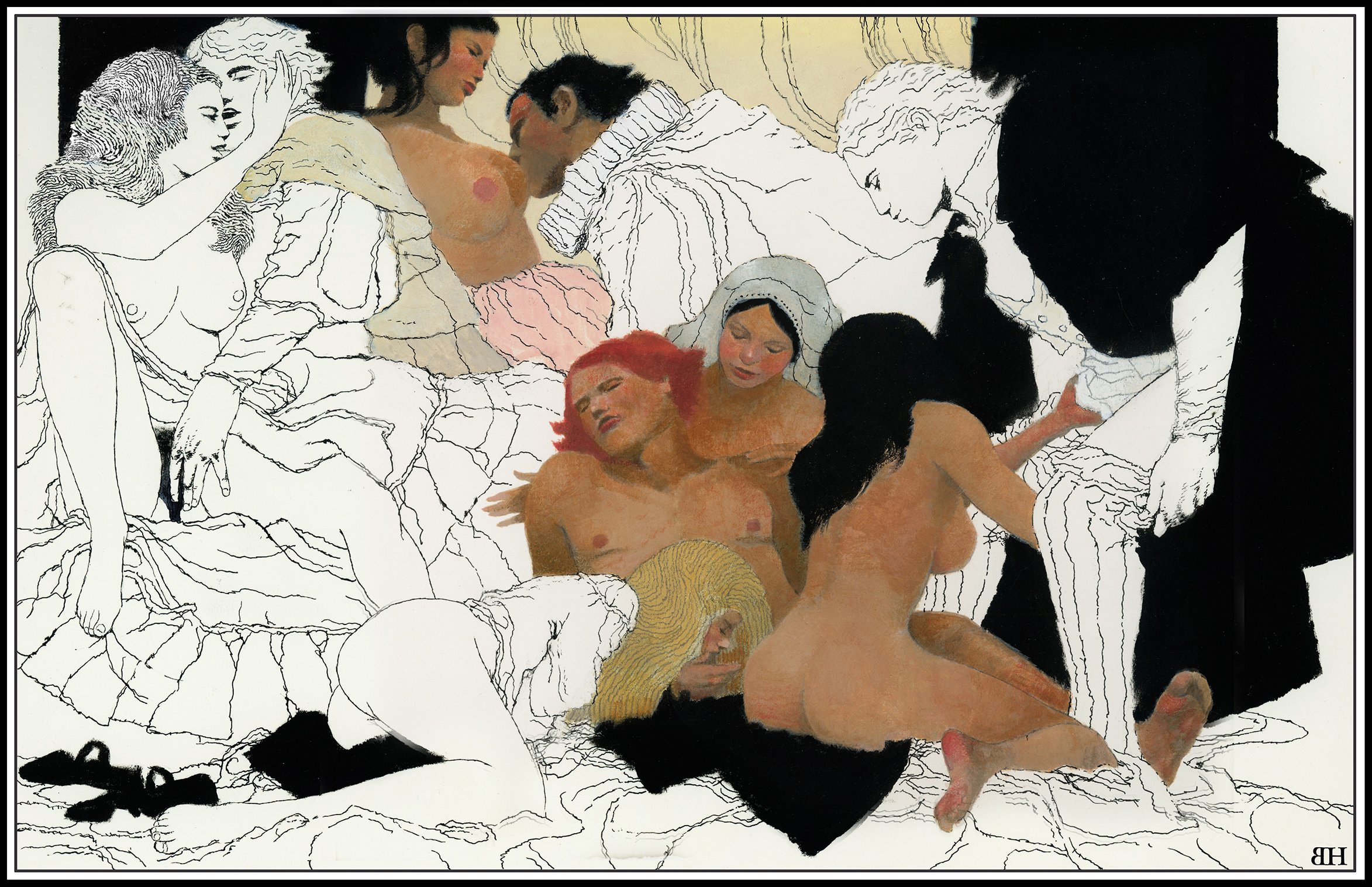
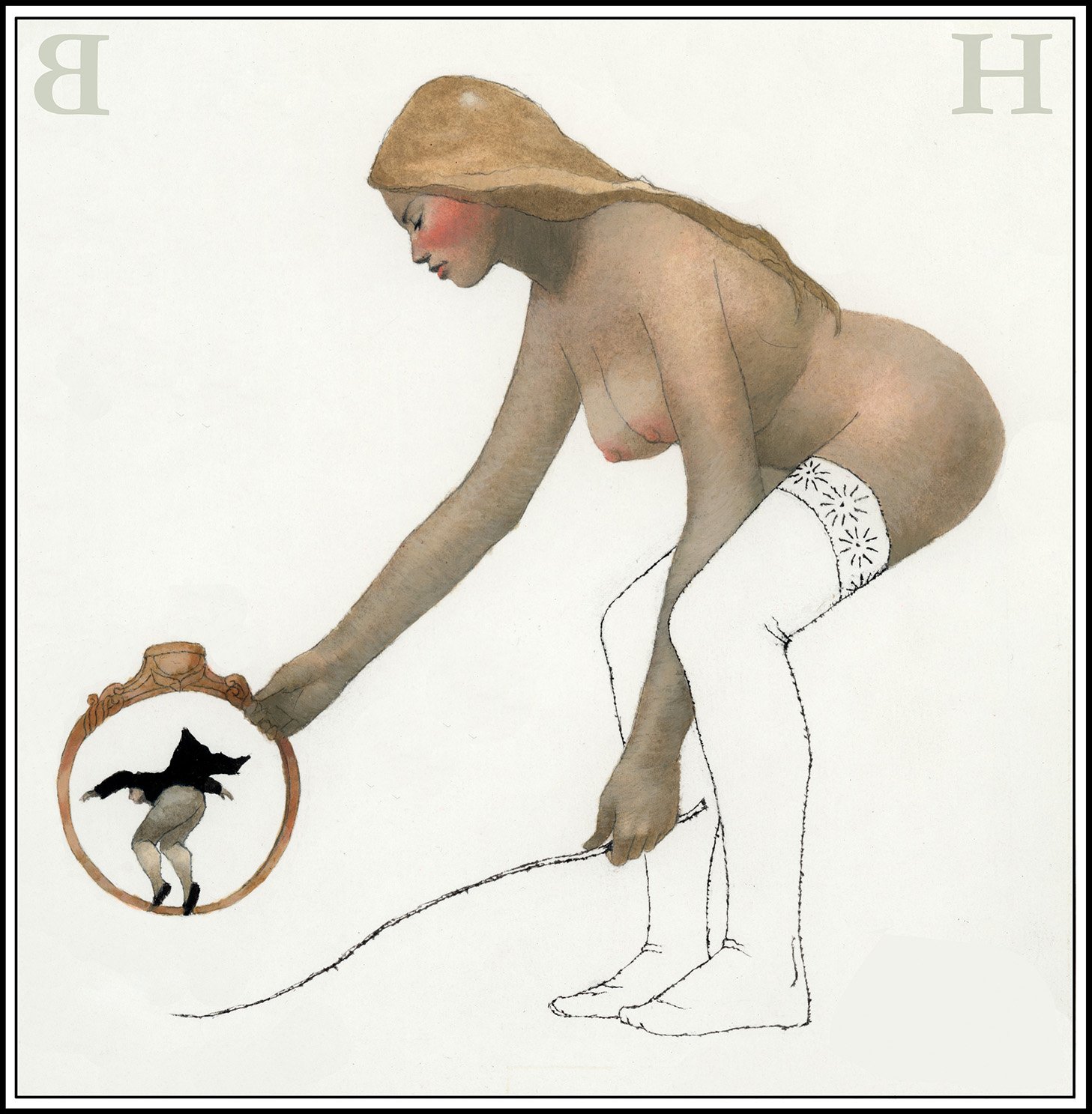
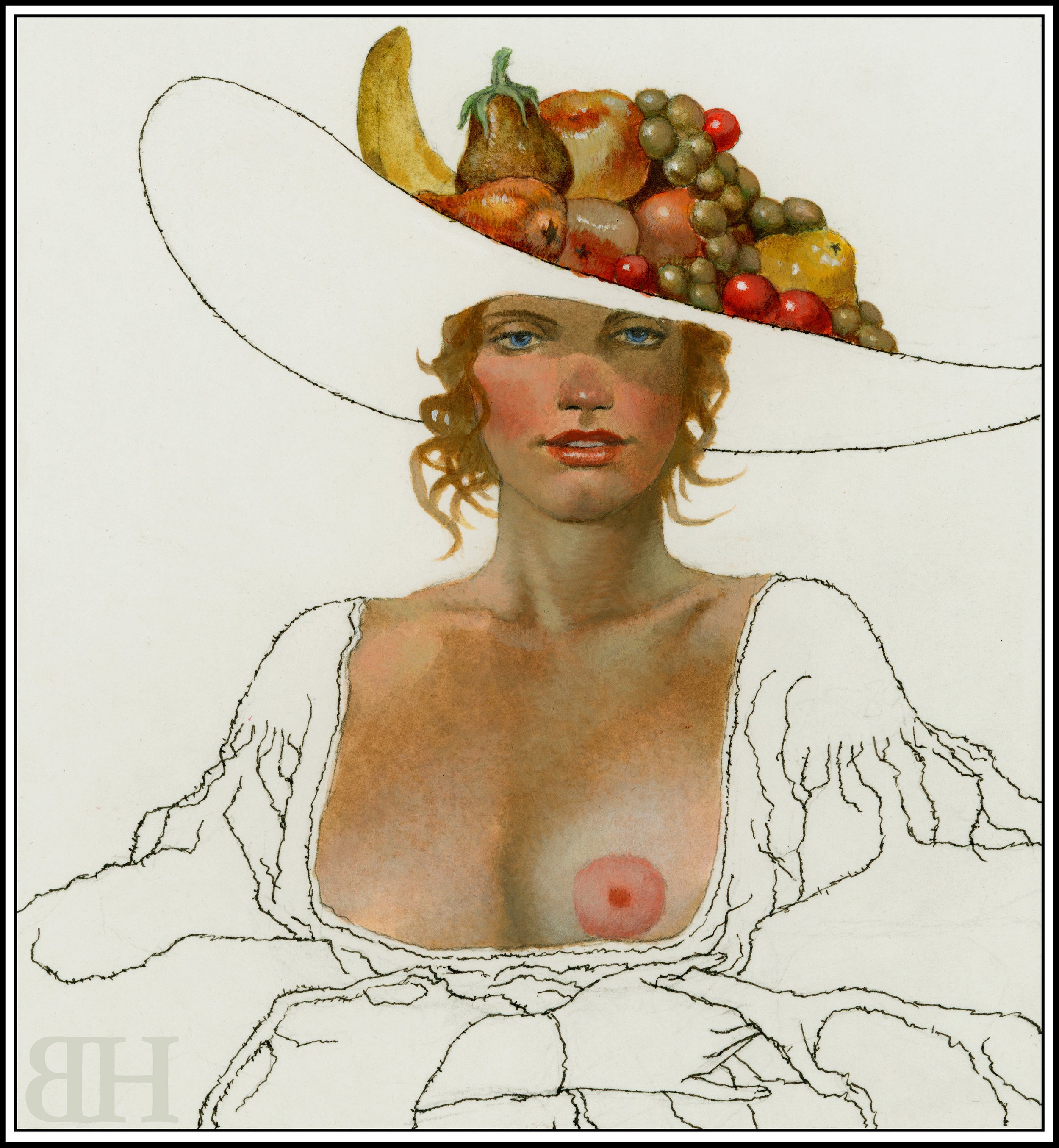
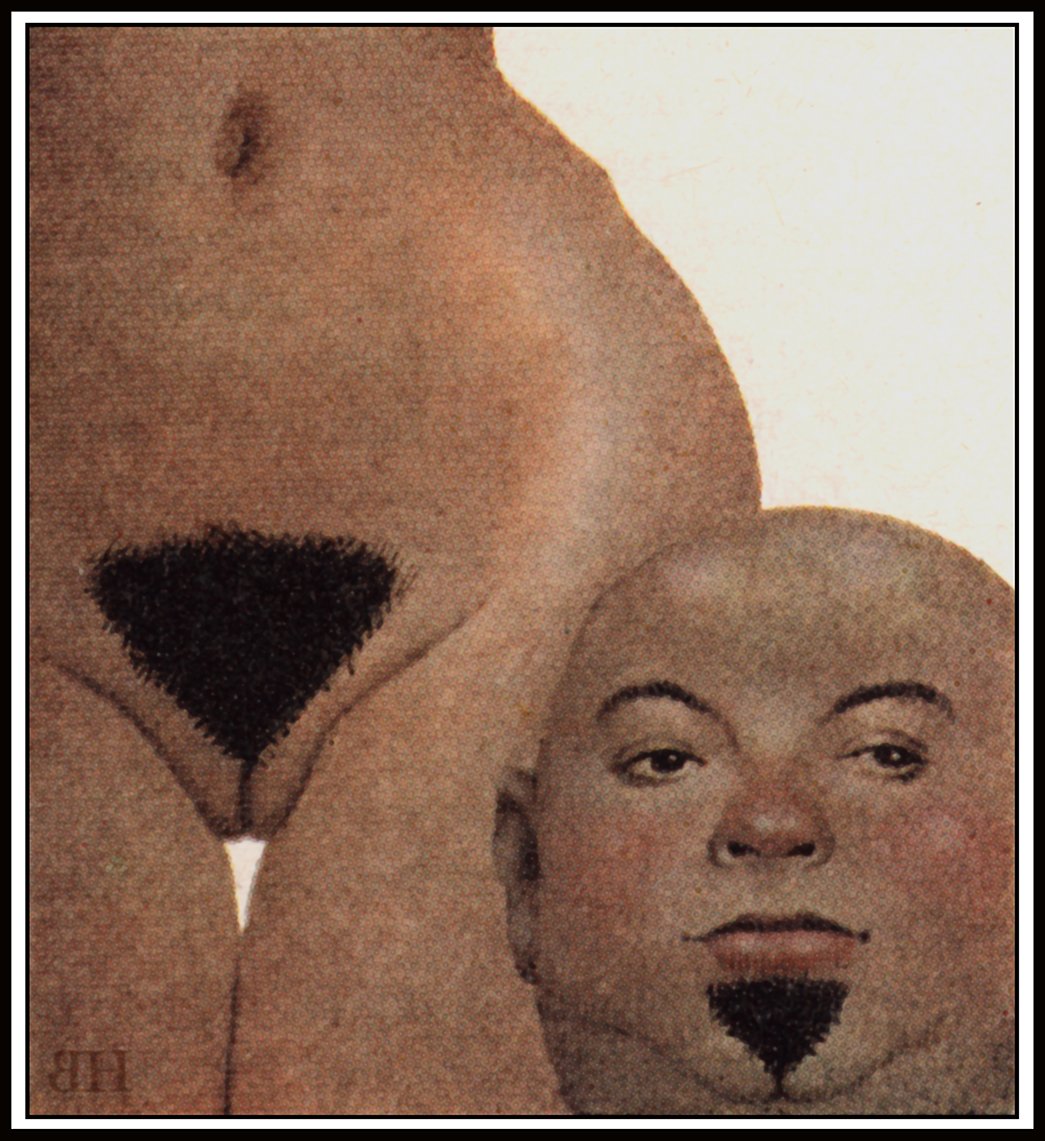

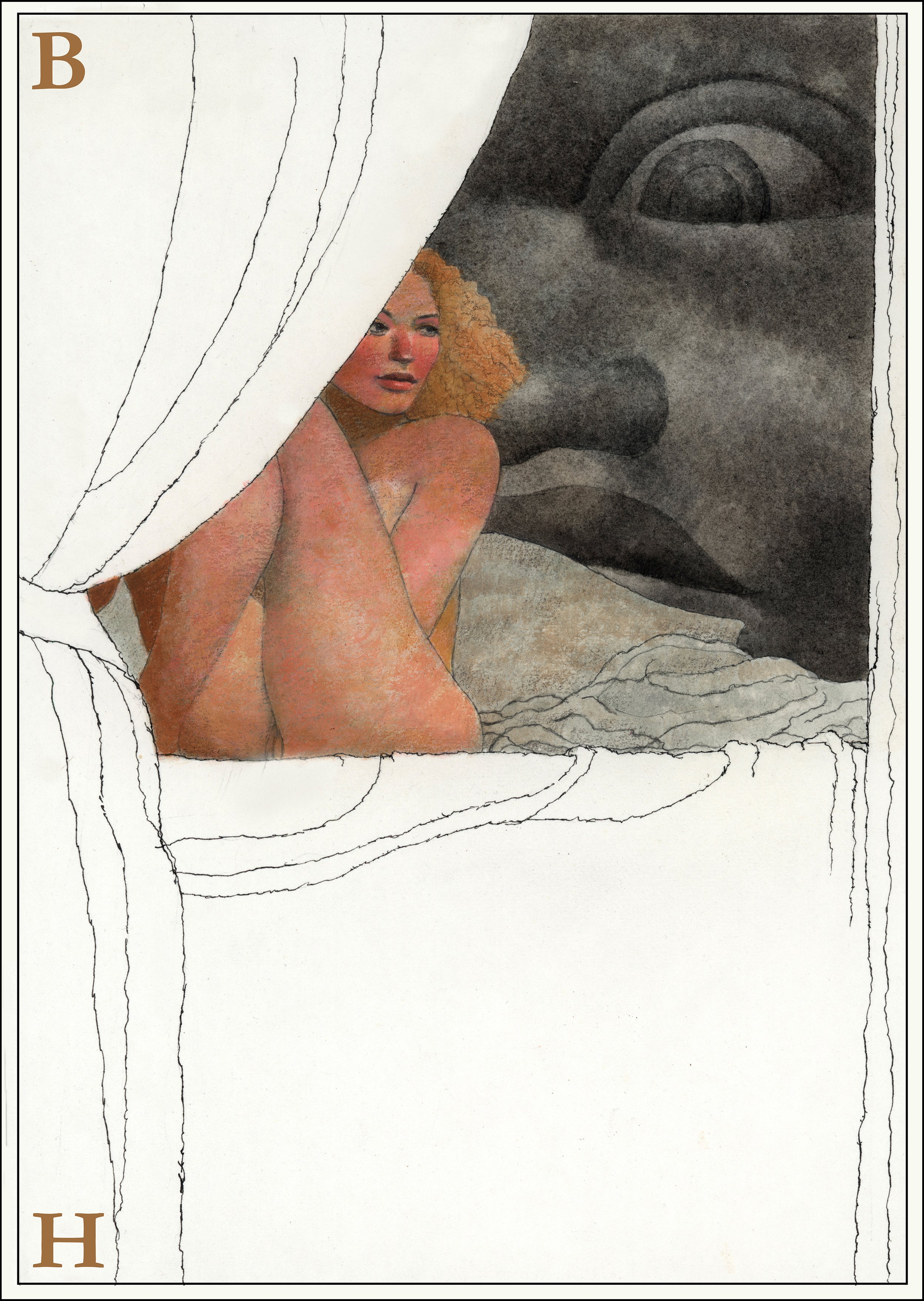
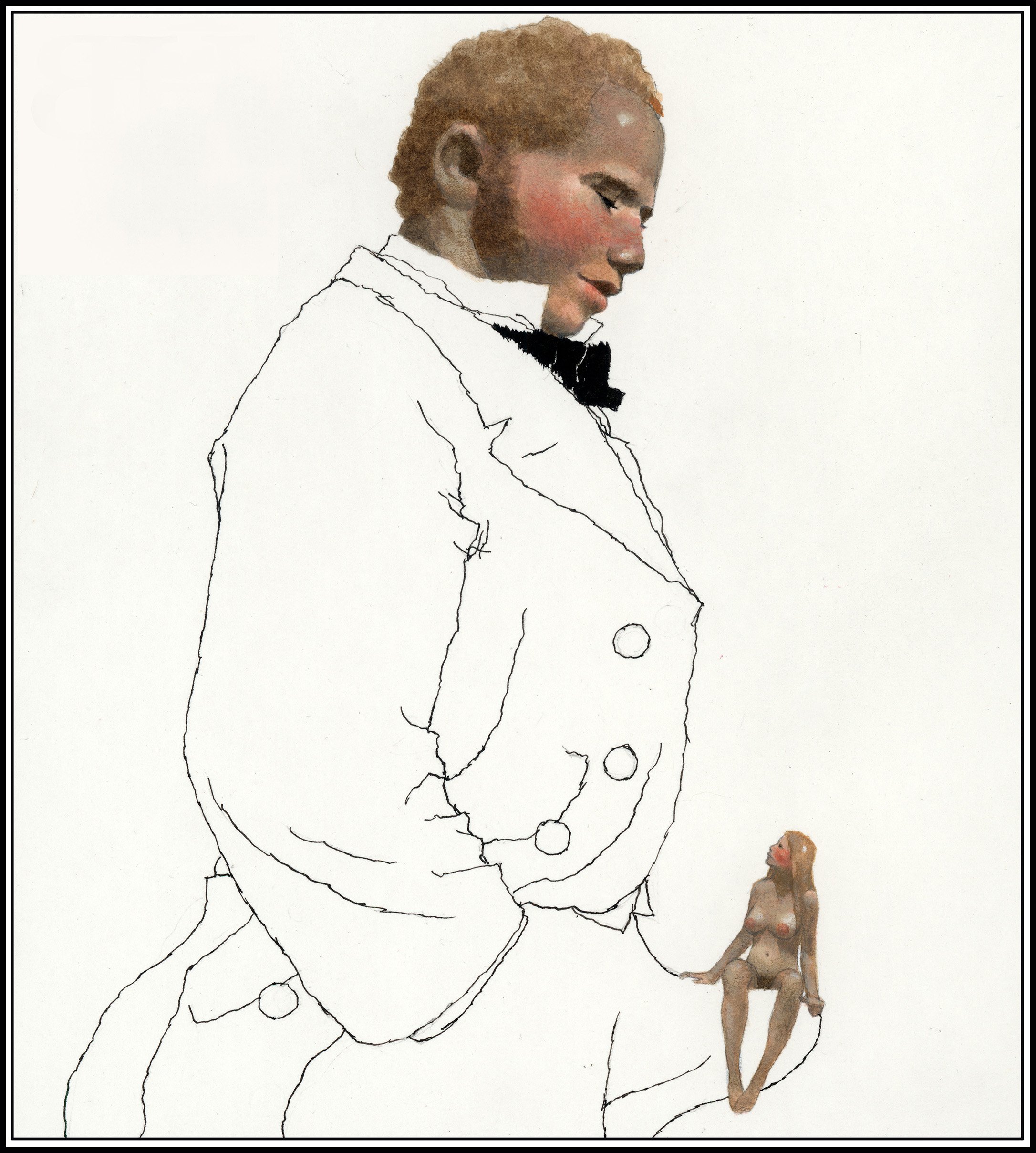
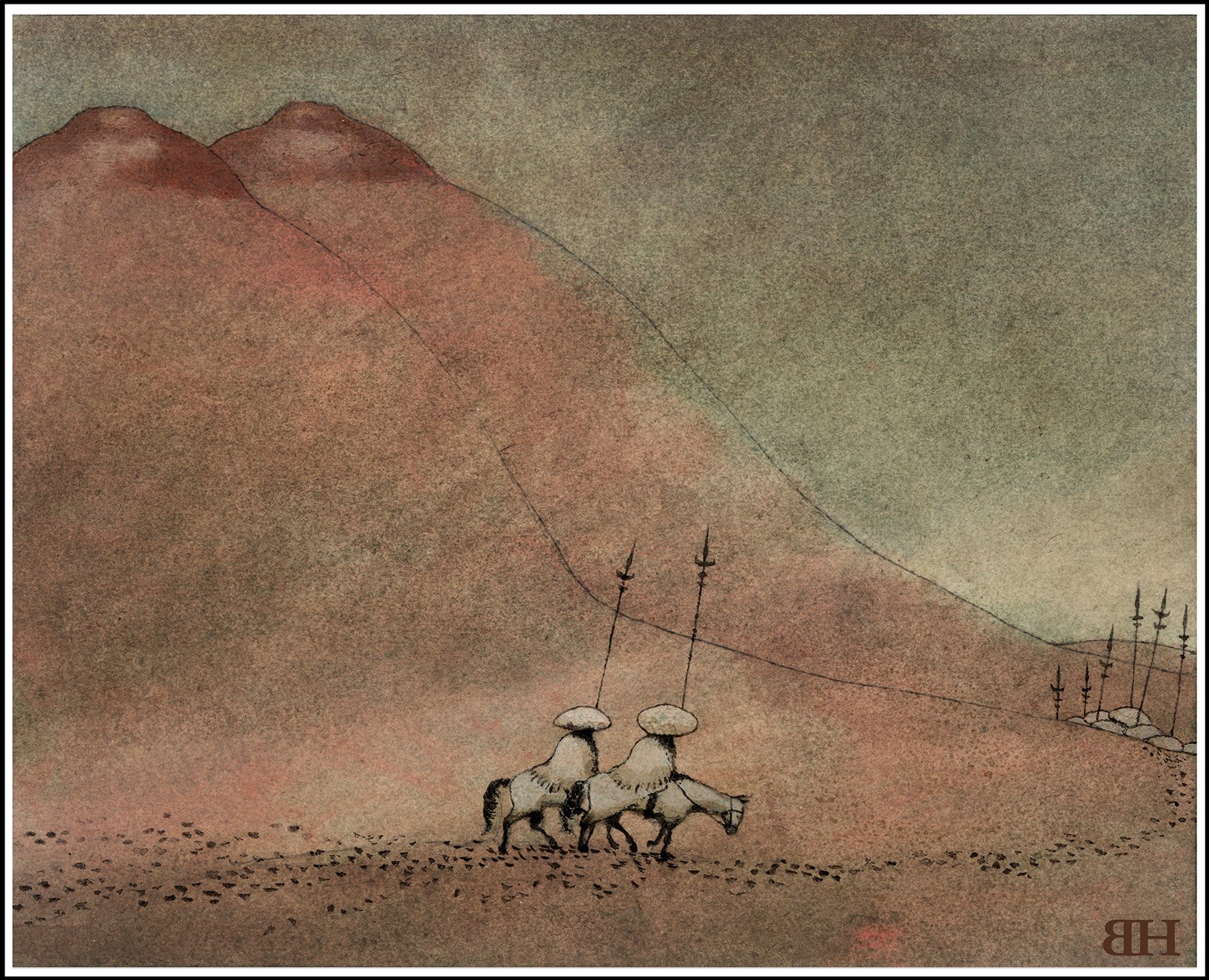
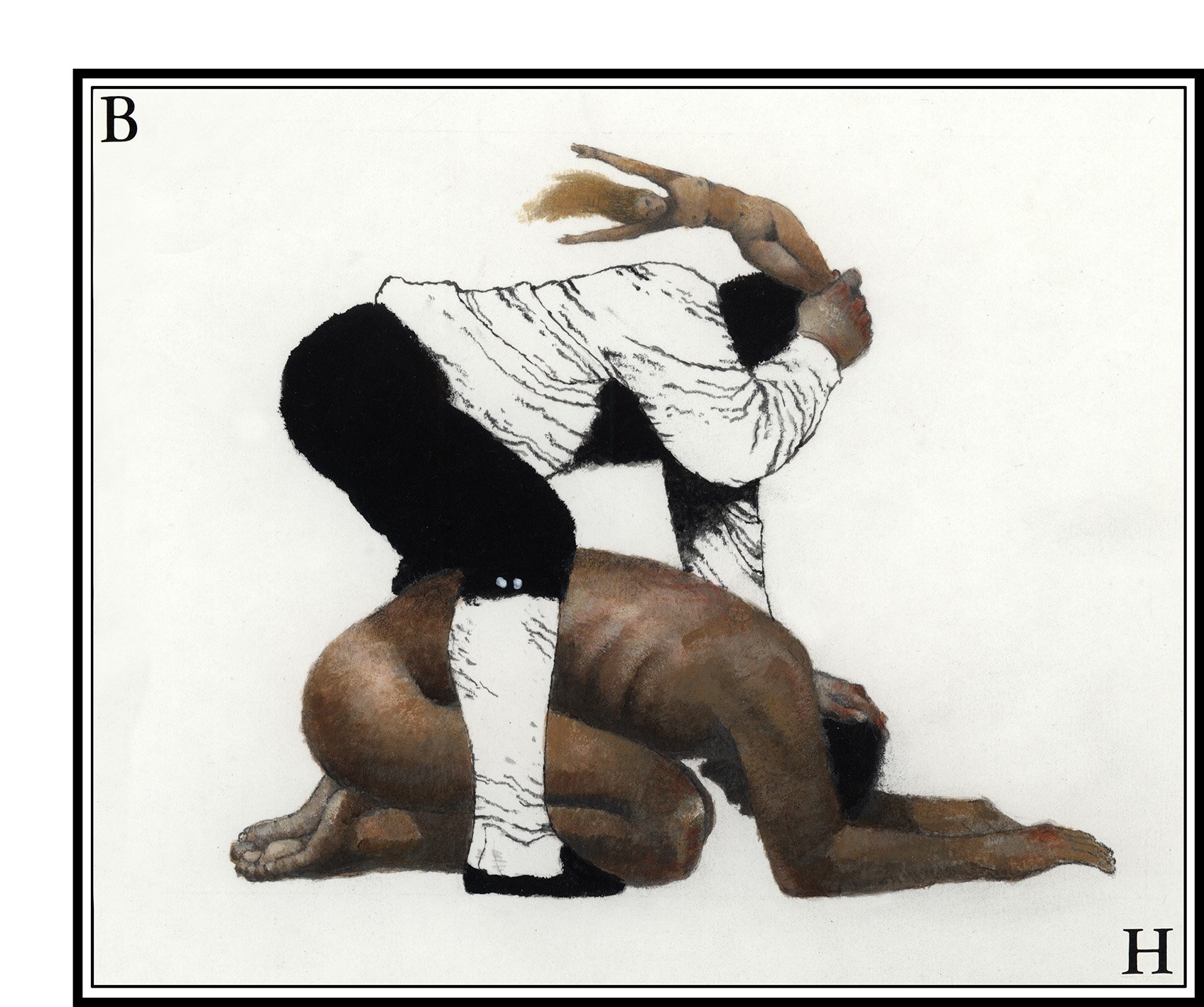
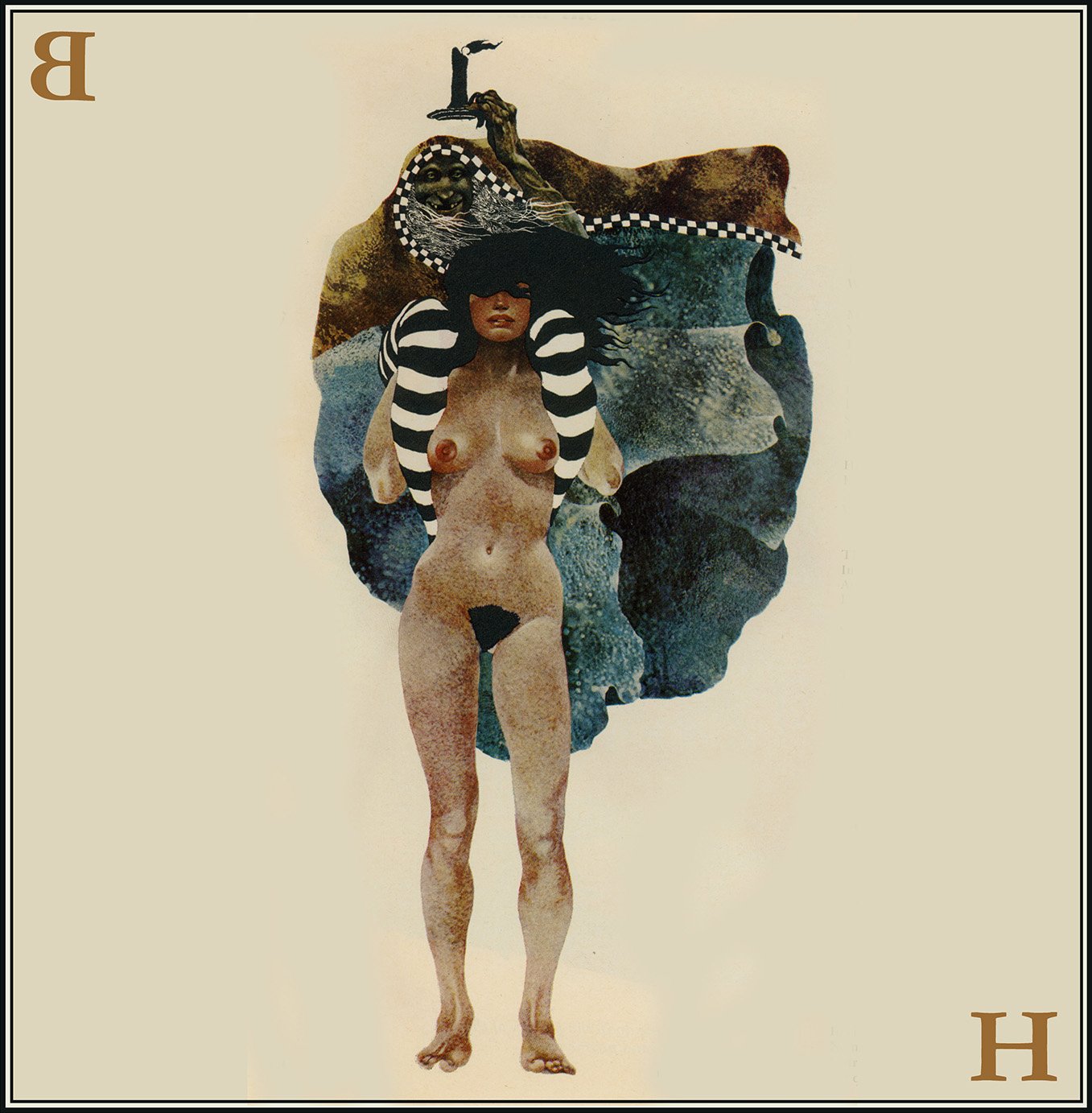
A sampling of Holland’s pieces for Playboy. Many of these pieces were used in the 1986 Kim Bassinger/Mickey Rourke film, 9 1/2 Weeks.
Steven Heller: If you were lucky we paid you. [Laughs].
Brad Holland: Well, I did, four drawings for Screw under four different names that made it look like you had four different artists. I did an Edward Gorey-style drawing. I think I did a Jack Davis-style drawing. I did one of my own, and I may have done a Leonard Baskin drawing. I can’t remember.
Steven Heller: You did a number of Leonard Baskin drawings.
Brad Holland: A lot of Baskin drawings.
Steven Heller: So how did the leap to the Times happen?
Brad Holland: Well, after you left Screw to work on the Review of Sex & Politics, which later added “Aerospace” to the title since the editor had been a paratrooper. It was the New York Review of Sex & Politics & Aerospace. Do you remember the slogan for the newspaper?
Steven Heller: “A Symptom of our Times,” right?
Brad Holland: It was The New York Review of Sex & Politics: A Symptom of Our Times, which is a way of saying, “Sorry for all the naked pictures, but we have to do it in order to get readers.” That was essentially the way the paper functioned.
Otherwise, it was very political.
So anyway, as far as JC Suares, who had been your boss when you signed on after high school to edit—Steve should be telling this himself but he’s going to be too modest to tell it—Steve graduated from high school when he was 17 and got a job working for the Free Press as a summer job.
And JC Suares was art directing the thing. And JC had just come out of the Army himself and was doing drawings very much like David Levine and art directing the Free Press. Steve got this job and Suares got a better job and left overnight! So Steve was left learning to art direct The New York Free Press kind of on his own and just making it up as he went along.
So when Steve started art directing—Steve, when you started art directing the New York Review of Sex & Politics, Suares came back to art direct Screw, and he has also got a job moonlighting, or maybe “sunlighting” might be a better word, for The New York Times, working kind of day jobs at the time.
And you all had moved into 80 5th Avenue and Screw moved just down the hall from us. So Steve and his crew were in an office on one end of the hall in New York Review of Sex & Politics, and Screw was down on the other end producing Screw. And the two rival sex papers were running out of the same floor, and people were running back and forth between the floors, and Suares came in one day, mostly, I think, to just kind of razz Steve and give him a hard time. And I happened to be sitting there, and Steve introduced us and he said, “Oh, I’ve been, you know, I’ve been following that work you’re doing in Playboy. And one day, he came in and he said, “Hey, how would you like to do for The New York Times work like you’re doing for Playboy?”
And I said, “Yeah, sure,” thinking he was just making it up, but damned if he didn’t, you know, the next day we were headed up to The New York Times.
Suares was the only art director in the hippie press who drove a Bentley to work. He had two of them. And he was very much offended if you referred to one of them as a Rolls Royce. Bentleys, in his mind, were superior to Rolls and he definitely had a Rolls.
He was not making the money from Screw. I have to mention that he was a descendant of the banking Suares family in Alexandria, Egypt. And they had left the country during the Nasser revolution back in the fifties. He had gone to Yale, and, I think, dropped out and then went to Pratt because he wanted to be an artist. Anyway, he took me up to The New York Times and introduced me to Harrison Salisbury. They were just starting the op-ed page, and Harrison asked me how I saw my work being used, how I saw illustration being used on the op-ed page, because they had never run art on the editorial page before.
Holland’s portrait of a young Steven Heller, his long-time friend and collaborator.
Steven Heller: It has to be said that the op-ed page existed because Lou Silverstein started it, and used people like Ralph Steadman, along with other European artists.
Brad Holland: Did he use them before Suares?
Steven Heller: He used them before Suares, and Suares was a good choice because he was already fluent in that language of European illustration.
Brad Holland: I came in with Suares so I attribute everything to him.
Steven Heller: So when you came into the op-ed page, there was this overlay of surrealist work, all linear —his studio, in fact, Suares’, was called Data Studios.
Brad Holland: Yeah that’s right.
Steven Heller: So he had that sensibility.
Brad Holland: Oh yes. Suares had a definite background in all that.
Steven Heller: So that’s when your work began to change. You were doing that kind of comic strip, R. Crumb-related stuff, and then it kind of morphed into what I consider the first link, the junkie drawing—the junkie drawing with the mouths and the arm.
Brad Holland: Yeah, that was one of the first drawings I did. Harrison asked me how I saw my work being used. He called it illustration, and I said, well, I don’t really think of it as illustration. I didn’t know what to say. And I kind of stammered around for a second. And then I thought I had a great angle. I said “Just imagine that you lock the writer in one room and the artist in another, and you give them both the same assignment. And then you put this stuff together.” The writer gives you an article, and the artist gives you a picture, and you just put them together. As long as they run tangent to each other, that qualifies as a direction.
I’d never used that line before but I began using it after that. The example I always used to use when I was arguing with art directors about it, I said, “Take the most famous illustration in Western art, which would be the picture of God, creating Adam on the Sistine chapel ceiling.”
And I said, “Why does it not illustrate the story?” The story has God breathing life into Adam. It doesn’t have them touching fingers. Why did Michelangelo paint God breathing life into that? Because on the Sistine chapel ceiling, it would look like a kiss and it wouldn’t have given the impression that Michelangelo was trying to convey. But everybody who’s ever petted a cat in the middle of winter knows that sparks jump. Or when you shake hands with somebody and static electricity jumps, or when noses come too close in dry weather, just before a kiss, a spark will jump. And Michelangelo must have recognized that and turned the breath of life into the touch of the hands. And I said, I don’t know, a single person, art critic, preacher, anybody who has ever criticized that painting because it doesn’t illustrate the biblical language.
Everybody takes it for granted because the Hebrews, when they wrote the Bible, were using a verbal metaphor: God breathes life into a person. And so that comes from the belief that when you die, you breathe your last breath. So if the breath leaves your body, signifies your dying, it must’ve been the breath of life coming in from God.
It was a perfect metaphor, but it was a verbal metaphor. And what I was looking for was visual metaphors that didn’t simply imitate the verbal. And so, for example, once I had a job to illustrate a glass ceiling, and I did a picture of a guy who was climbing a flight of steps, only when he got to one step, the next step was too big. A step that he couldn’t have made. It was a glass ceiling, except there was no glass ceiling. So I took it into the editor and he said, “The article’s about glass ceilings. Where’s the glass ceiling?” I said, “It’s glass, you can’t see it.,” and then I tried my Michelangelo story on him.
That way, I, began to explain at least to some, that what I was looking for was a visual counterpart to whatever verbal information they had in the text. I began with trying to explain it to Harrison that day, because over the first year or so, I was having a hard time explaining what it was that I was trying to do besides being a jerk, which is what some thought I was just being.
Holland’s work with JC Suares for The New York Times Op-Ed page.
Steven Heller: So the op-ed page allowed you to follow that strategic idea, that philosophical idea that you had.
Brad Holland: I did pictures. Well, for one thing, Watergate came along and with Watergate, I didn’t have to follow the story. In fact, the story evolved so fast that usually by the time story was written, there was too little time to do a picture, just, to go with it if you wanted to get it out overnight. So I began just doing pictures following the news. One week I did four different pictures about Watergate. One of them was Nixon on a top of all these subordinates—each subordinate was smaller than the one above him. Nixon was at the top, Halderman right under him, Ehrlichman right under him, John Dean, right under him. And I didn’t know the rest, so I made them all generic, but each one got to be so small that they were eventually just a chain of people collapsed. it was used on the cover of the first catalog of op-ed work. It was one of three drawings I did that week. And I just took them all up to the Times and dropped them off, and they just applied them to articles as the articles came in.
So I didn’t read a single article for any of those pictures.
Steven Heller: When I first went to the Times as art director of the op-ed page, you gave me three books. One was Kathe Kollwitz. The other was Heinrich Kley. And I think George Gross was the third.
Brad Holland: I don’t think so. I didn’t like George Gross. It would likely have been Baskin, but I couldn’t promise that. I know I tried to get you to write to Baskin to get…
Steven Heller: Well I did, and I got him to do stuff for us.
Brad Holland: Yeah, he did Nixon and who else?
Steven Heller: He did Ford.
Brad Holland: Oh yeah, he did Nixon and Ford, and he did them on the back of other drawings. And they were about a year after you wrote him the letter, you wrote him a letter. It took a year for him and he sent a letter back along with a picture of Nixon and a picture of Ford drawn on the back of some other drawings that I guess he discarded. I was trying to get you to use all kinds of people like that.
Steven Heller: When did magazines start to change in terms of your own work?
Brad Holland: Well, what made a big difference was when we had that show in Paris and The Art of the Times book came out, because my work was on the cover of that. The Art of the Times came out around the same time as The Art of Playboy, because Playboy had a traveling exhibition called “Beyond Illustration” that Art Paul was doing.
Steven Heller: That was at the Huntington Hartford Museum.
Brad Holland: Well, that’s where it came, but it had traveled around Europe first. it was previewed over there. And one of the pictures that I had done for Playboy was used as a poster for that, and then came The Art of the Times book, which came out and my drawing was on the cover of that. So from that point on, people kind of came to me for the kind of work I wanted to do.
One of the things that I did early on when I worked in Chicago, I was looking at portfolios of the kids who came to our studio, looking for work. They’d show us these portfolios. And they had Time covers and record album covers, and the guy I was working for John Dieszecki, he made a point of saying, “Don’t show this kind of stuff, because everybody knows you didn’t do Time covers, your work doesn’t look like it’s ready for Time. You should be doing small jobs. Do a catalog for a small company that nobody’s ever heard of and show that in your portfolio.” I took that idea to heart myself, and when I did my portfolio, I did all black and white work, except for a few color things that I had done at Hallmark. I showed almost all black and white, and the idea was that most people relegated black and white to spot illustrations. And I learned at Hallmark that editors don’t pay a lot of attention to work that they don’t think is important. And so I figured I could break in by doing work that most artists didn’t want to do.
And I would take the smaller jobs and usually get to do them in the way I wanted. I think it worked out. That was part of my strategy: to take the smaller jobs and do them the way I wanted. So after a while I had a portfolio of things that looked like I wanted to do them.
And pretty soon I began getting calls to do that kind of work.
Holland’s 1979 cover for Time’s Man of the Year issue featuring Iran’s Ayatollah Khomeini: The original, Holland’s crop, and the final printed cover.
Steven Heller: And pretty soon after that, other people started doing your work as well.
Brad Holland: I couldn’t do anything about that. Could I?
Steven Heller: No, but it did mark a shift in the overall style and concept.
Brad Holland: Well, it worked against me at Time magazine. For example, one guy came along who was very good. And again, he came doing somebody else’s work and then started doing mine and going around to all my clients. And he had heard stories about how artists, you know, some art directors had a hard time working with me, and he kind of promised tha he’d be easy to work with. So I remember I kind of got booted out of Time after doing a whole bunch of covers for them.
Steven Heller: Was the Ayatollah the first cover you did?
Brad Holland: The Ayatollah was, yeah, the first cover that I did for them. That was an odd case too, because they asked me to do a picture of the Ayatollah, and I didn’t like working from photographs but they gave me a whole bunch of press photographs and I found one of them that was a three-quarter view and had the features of his face, but it was shot with a flash. So it had that back-shadow that flashes always have. So I modeled my own face—because I looked enough like the Ayatollah, I thought—I modeled my own face in three-quarter view and had my wife at the time take a photograph of me.
So I used the lighting from my face and the structure from the Ayatollah, his face, but they had asked me to leave a lot of space above the turbin. Just leave a lot of space for all the type that they wanted to add. So I did this painting. It was about, maybe 18 by 24. I took it up and they loved it and they photographed it and they did a cover based on the dummy. I said I wanted to make a few changes on it. I took it back to work on it and I just, I didn’t like it. There was something—it just looked wrong to me.
They gave you a cover in those days. It was a celluloid cover with a Time logo on it. The Time logo is fantastic. It makes anything look good when you put it on with that red board or the red and white border and the Time logo, unlike the Newsweek logo, which would make even a good picture look bad, Newsweek had that clumsy drop-shadow, lowercase type that ran about one third down the way of the cover. You could hardly do a picture and cram it in under the Newsweek logo. The Time logo made everything look fantastic. So they gave you this transparent logo—it was life-size and you could drop it on anything. And I just happened to drop the thing on my Ayatollah picture. And I thought, my God, if, it weren’t for all this space around it, this would be a fantastic cover.
So I take some white sheets of paper and I began blocking out everything on my painting until I had the thing right down to the size of the celluloid sheet with the logo on it. I thought, “That looks fantastic. I’m going to try to persuade them to do it.
I thought no, they’ve already shot the thing and they’ve already done a dummy with the whole thing. It’s already probably been okayed by the editors, and once it’s been okayed no one’s ever going to raise the issue ever again. The only way to do this is to cut the damn picture out of the canvas. So I took a matte knife and I cut the thing out of the canvas until it was literally 8 inches by 10. Gone is the 18-by-24 canvas. I send up a little painting, 8 inches by 10, and they freaked out. What are they going to do?
Well, they had already covered themselves. They, you know, it was a Man of the Year cover. They had already covered themselves. They had four other artists doing covers. One person was doing a very radical cover. One was doing a Persian miniature. There was, I think somebody else doing one, and then then there was mine. So I figured, well, they’re covered. If I’ve ruined this one, I’ve just ruined it for me. They’ll get one of the other guys to do the cover anyway. So I sent it up, and it worked out perfectly. It was exactly the way the cover should have run—all that extra space was ruining the dynamic of the cover. So after that, they asked me to do all kinds of other covers. I must’ve done 10 after that. I don’t think any of them ever ran. They kept them in the morgue in case—there were all these Russian premiers, all of whom were elderly. I think Brezhnev was on his last legs, and they knew that Andropov and Chernenko were after him, and
And they were equally old, at any moment the premiership could change. So I ended up doing all the contenders for the Russian premiership, some of them were very nice. And then I did [Zbigniew] Brzezinski for Time. I think it was one of the best covers I ever did. It never ran. I’ve got it on my website. I think it was one of the best portraits I ever did, but it didn’t run.
“Well if the internet isn’t the end of Western civilization, what has to happen is we need the kind of people art directing the internet like [Steven Heller], [JC] Suares, Art Paul, Dugald Sturmer, and Richard Gangel. We need people with that kind of clout working for internet publications. ”
“I did [Zbigniew] Brzezinski for Time. I think it was one of the best portraits I ever did. But it never ran.”
Steven Heller: What did you want to accomplish by sticking with illustration? Was there something you needed to say that could only be said through mass media?
Brad Holland: Well, Reagan changed tax policy and created a bunch of tax shelters that fine artists agents wanted to take advantage of. And I got offered a couple of deals. This was back in the eighties. The deal was that you would do all the work for a fine art lithograph, and you would be paid a fairly decent sum of money by some investor. The work would never be published. This was kind of like a scene out of The Producers or something. The idea was they were creating something that they would make a down payment on. The down payment would be the payment to the artists, but then they would write the work off as a loss, and they would get a huge tax writeoff for it.
So the idea was that we were supposed to be doing fine art lithographs, but the deal was they would never be used. We would just be paid for doing the work. And I thought, well, hell, I could get a job as a caterer. You know, I might as well—if I’m going to get a tax-shelter job I might as well do something like that.
So I turned those jobs down.
But I was married at that point, and I wanted to buy a big house for my wife, so I started doing a lot of advertising and I already had the reputation for doing my own ideas. I got pretty much the kind of license that I wanted doing advertising as well.
Part of my strategy early on was simply to give an art director a lot of choices because I knew the old cliche, you give an art director three choices and they’ll pick the worst one. But I just decided, you know, I was fairly clever. So I would come up with a lot of ideas on the theory that I liked all of them and I’ve sent them several ideas so that if they picked one, it was at least one that I wanted to do. It might not be the one that I most wanted to do, but it would be one that I wanted to do. So I was happy with that. I’d save all the ideas and use them elsewhere for other things.
Nothing else I’d do for myself. So I’ve pretty much done what I wanted with my career so far. New things happen every day. I’m still—at the moment I’ve got about 15 ink drawings that I’m working on. And I’ll find a place for most of them I think somewhere down the line.
Some of Holland’s more recent work.
Steven Heller: There was a point where you moved from doing representational work that was somewhat expressionistic-impressionistic to “stick figures.”
Brad Holland: Oh come on. I wasn’t doing stick figures.
Steven Heller: You were doing primitive.
Brad Holland: What happened was I developed a bunch of ideas for sketches that I would turn into paintings, but the paintings looked overdone when I got done with them. They just looked like, well, this thing should have been left in the sketch stage. A friend, Roland Scotoni—a wonderful art director in Zurich who I had gotten to know—Roland had cooked up a deal with a publisher in a little town called Feldmeilen in Switzerland, just north of Zurich. And at the time I was thinking about quitting illustration. I had this friend, Gaillard Sartain, who’s an actor and had set out to become an illustrator.
Gaillard came to New York and did a few illustrations and then went back to Tulsa and became a local TV star, and then got into Hee Haw and got into the movie Nashville and then went out to Hollywood and he played lots of parts in lots of movies. He was in Mississippi Burning and Fried Green Tomatoes. He’s made quite a good career as an actor. He was filming Hee Haw one year, and I went out just to hang out with him. He wanted to show his work to Playboy. And so he and I were going to go to Playboy together and I was going to introduce him to everybody and take him around. By this time he was a big local star in Tulsa and in all the localities—Iowa, Texas, Arkansas—he had a weekly show, Friday, Saturday nights, whatever, called the Uncanny Film Festival. It was one of those things where he showed old monster movies and did a lot of schtick with Gary Busey, who was a guy who had gone to college with.
Gary was still using the name Teddy Jack Eddy in those days. And so, Gaillard and Teddy Jack Eddy were the stars of this local TV show. And then Gaillard went national when he got into Hee Haw. So I went out to hang out with him and at Hee Haw one week. I spent the week in Nashville with all those characters. And then Keith Carradine came by—they were shooting a scene at the Nashville airport for that movie Nashville. It was the assassination scene. And he said, “You guys want to be in the movie, come on by.”
Well, I was scheduled head out to Playboy and Gaillard was supposed to come with me, but he decided he was going to try to get into the movie.
So he hung out, and he and Carradine improvised a scene at the cafeteria that day. And it made it into the movie that was Gaillard’s entry into the movie business. At any event when I had gone out to California with Gaillard that summer, and I was trying to talk to all these screenwriters just about, because I was getting imitated—there were so many people imitating me beat that point. I thought, well, maybe the thing to do is get out of this business and get into screenwriting. Anyway I had wanted to write plays when I was younger. I had lots of ideas for movies. So we went out there and I met quite a few screenwriters, talked with them and I was just thinking of changing my name to Christian Bradford and starting in as a screenwriter.
But I came back and I had this, there was a letter waiting for me from Switzerland, from Roland Scotoni, if you forgot where the story started, and Roland had invited me to Switzerland for a month, all expenses paid, to just do lithographs at this company called Vontobel. They had used to make great big lithographs on these giant stone lithograph plates. So I went over there and I spent a month doing lithographs. And I began keeping a sketchbook. Nick Megalon, who used to be the editor at a Mad magazine. had done an article about me for American Artist magazine, and Nick was a great pen and ink artist. So he gave me some sketchbooks that he had bought and was afraid to use because the paper was too big.
And while I was over there, I started keeping sketchbooks. And when I came back, I got this offer. I’d done all these lithographs, but I had just been thinking about all these sketches that I had been doing. And when some jobs came up, I would do sketches and then turn them into paintings.
And then I would look at my work and I thought, well, the sketches look better. Roland called me then, and he wanted me to do the Swiss art directors club yearbook. He wanted me to do a painting for the cover And then all the inside pages would be the sketches that I did. And I said, I got a better idea. ”Why don’t I do the cover and all the inside pages fresh from, just from scratch. I’ve got all these ideas that I’ve done his paintings, and I think would look better as sketches.” So that was the way that started. I did 40 drawings for him, and we just applied them to this Swiss art director sketchbook, and it got a gold medal from the art directors club in New York.
And the Swiss art directors club would have given it a gold medal, except since they were the client, it wasn’t eligible. They gave me a silver medal. But that got the attention of some art directors who called, so all of a sudden I just began to get calls to do more work like that.
Steven Heller: What’s work like now magazines have gone digital?
Brad Holland: Well, we’ve been hearing about “print is dead” ever since David Carson began doing Ray Gun.
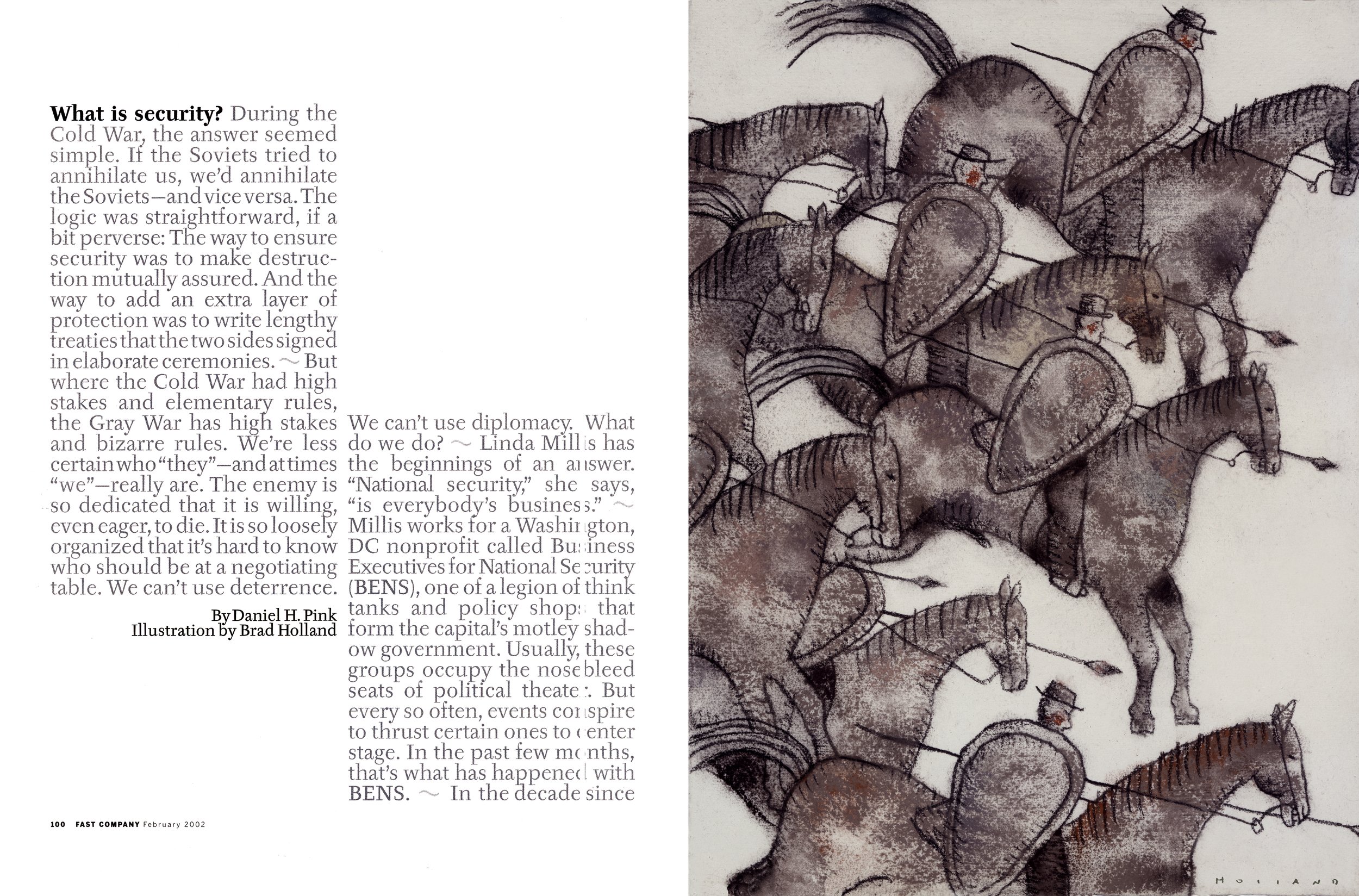
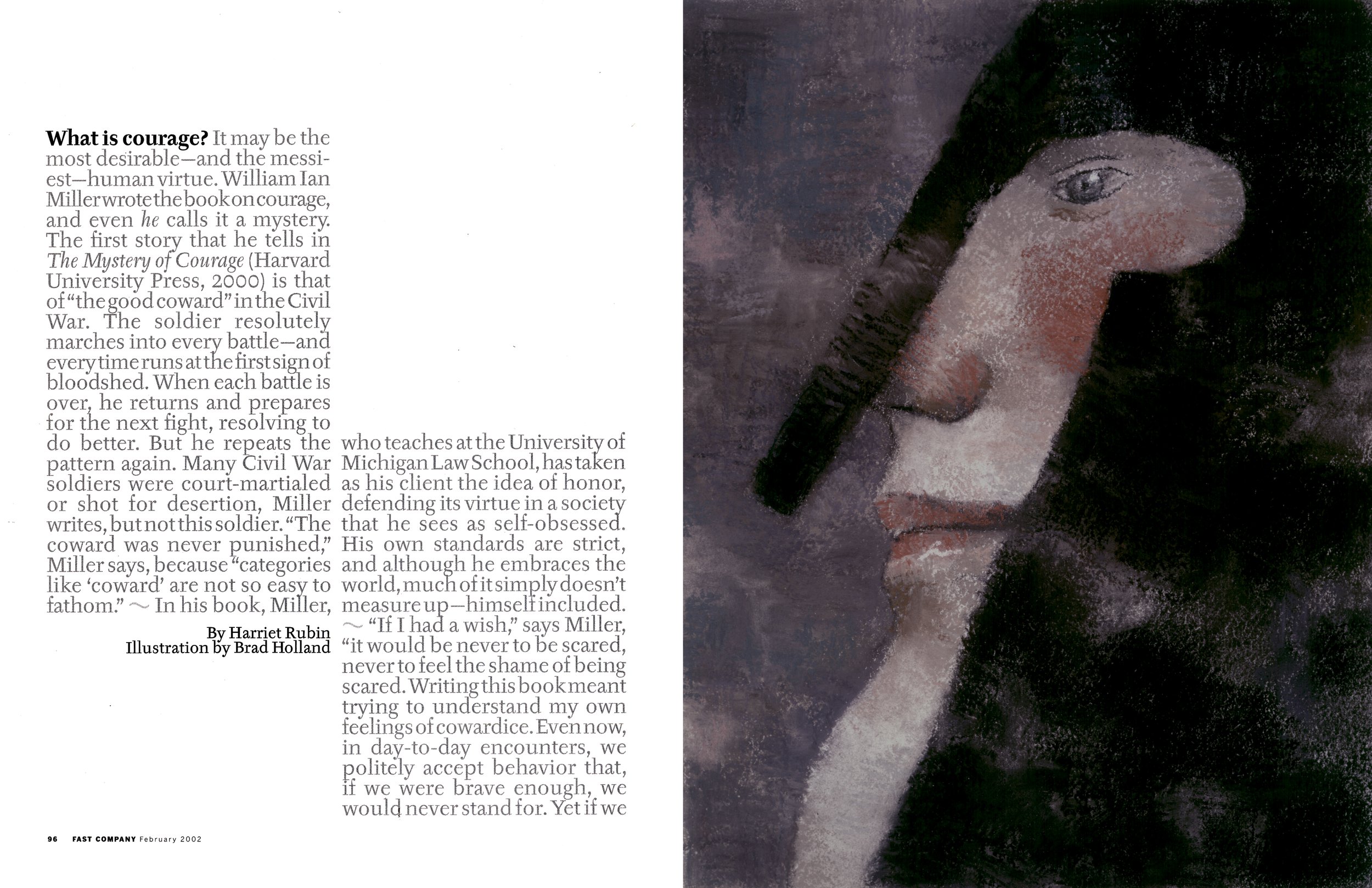

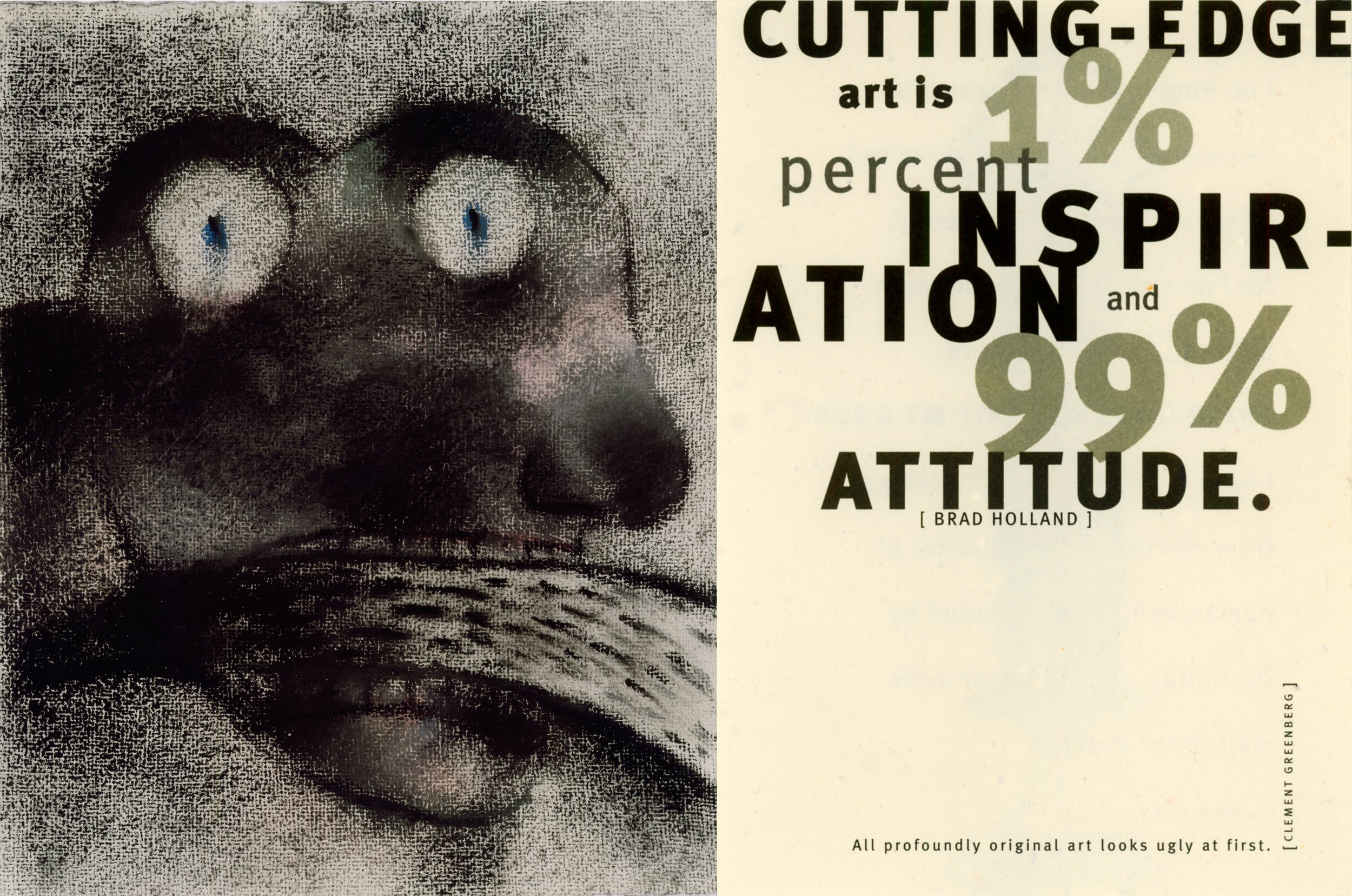
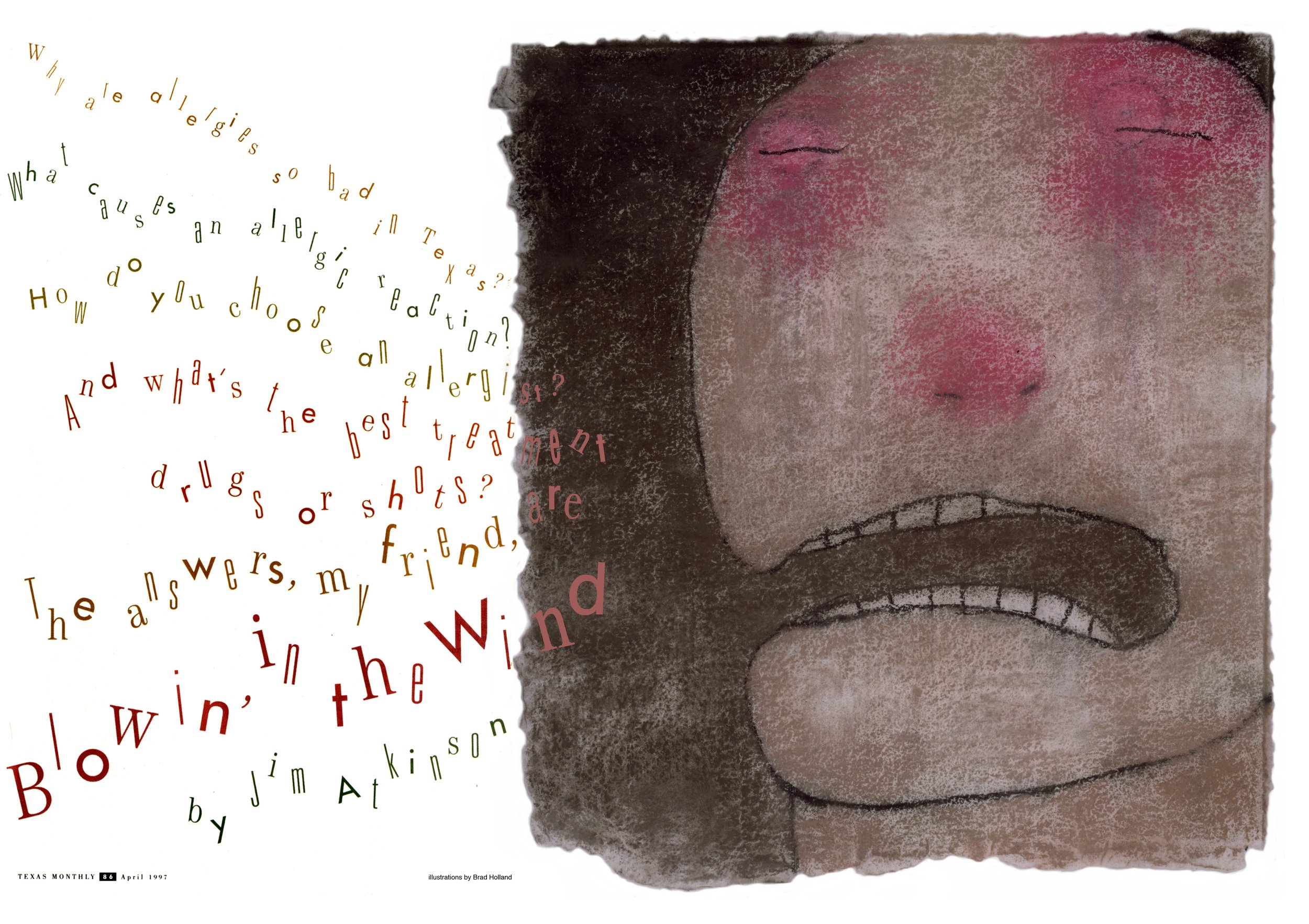
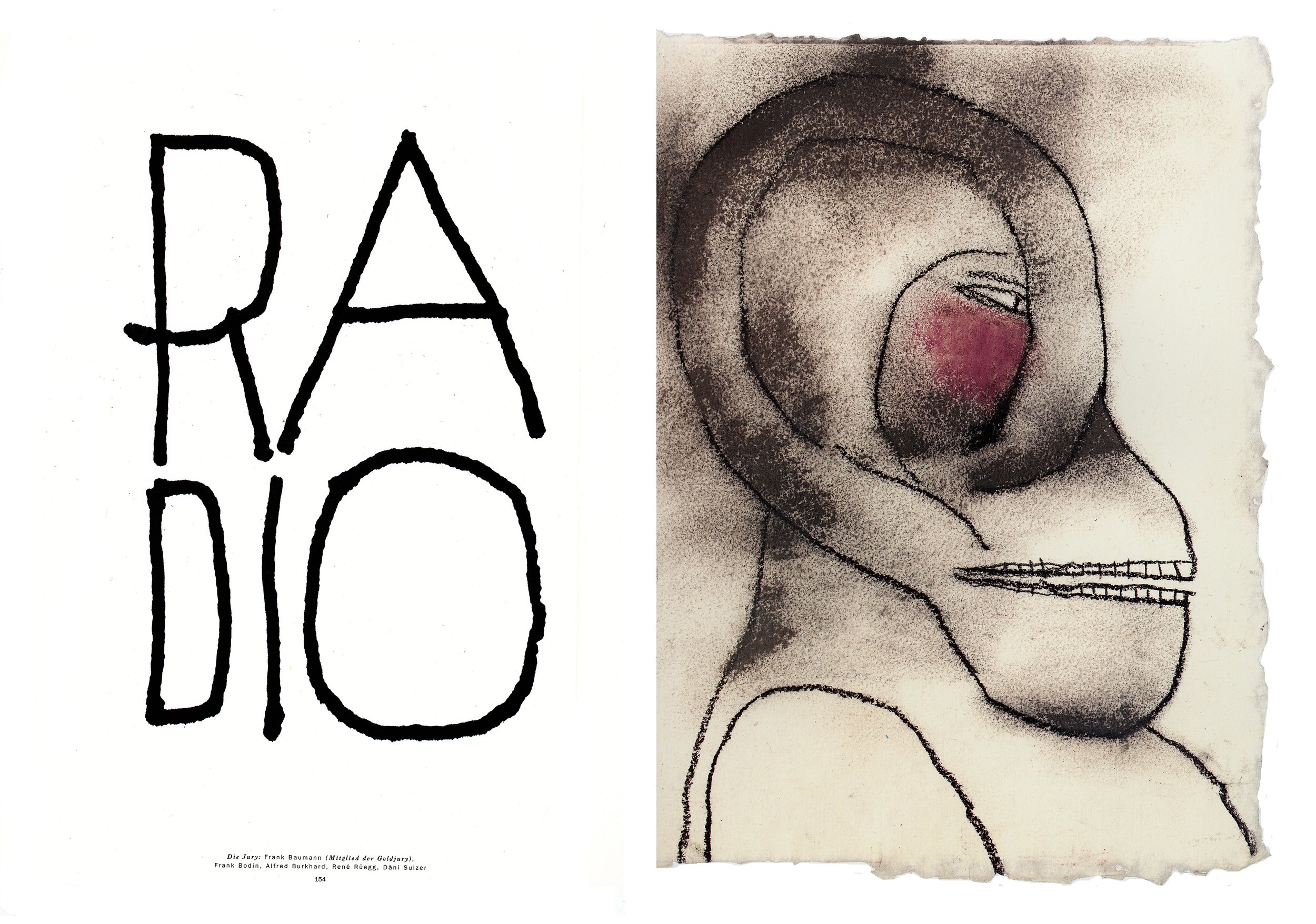
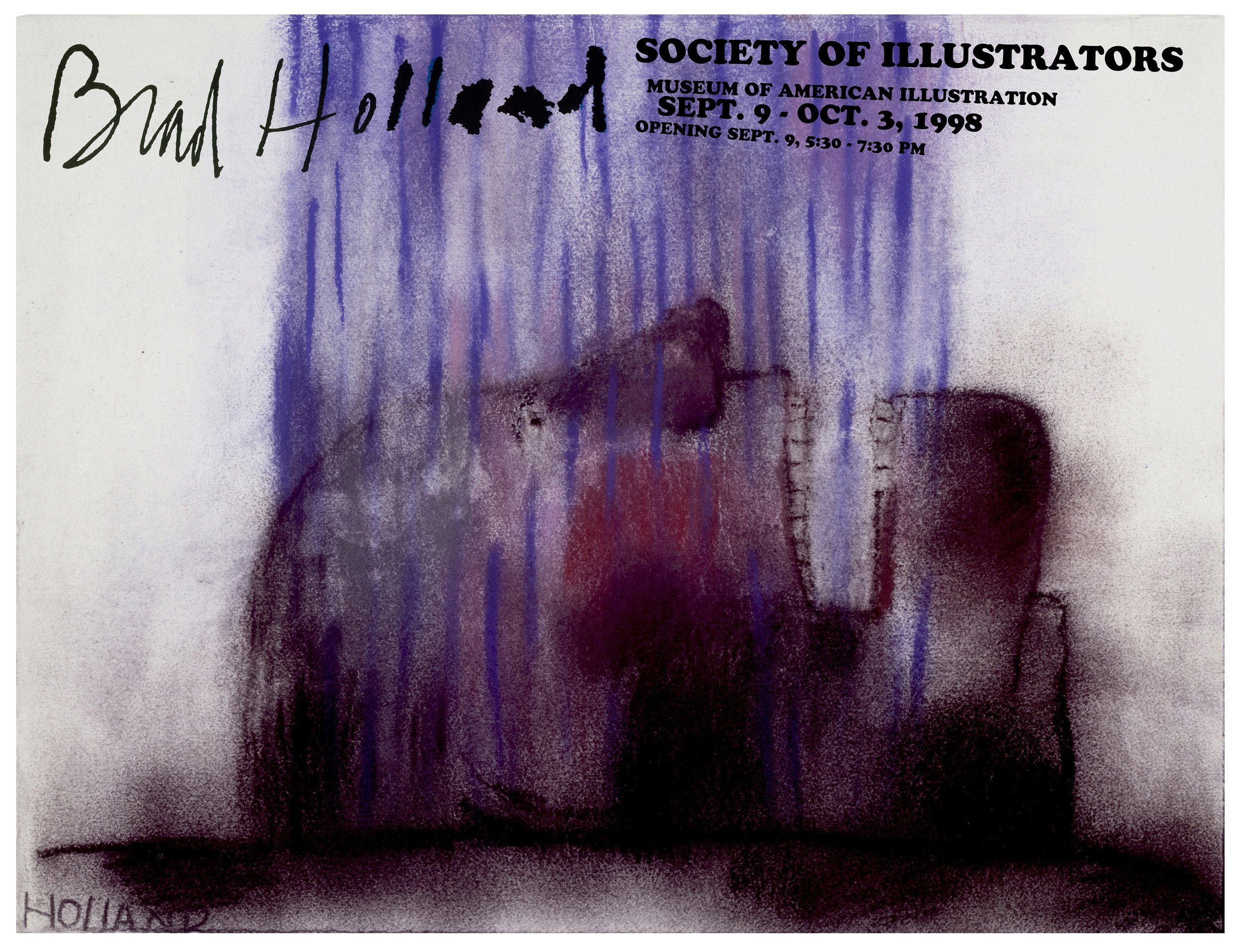
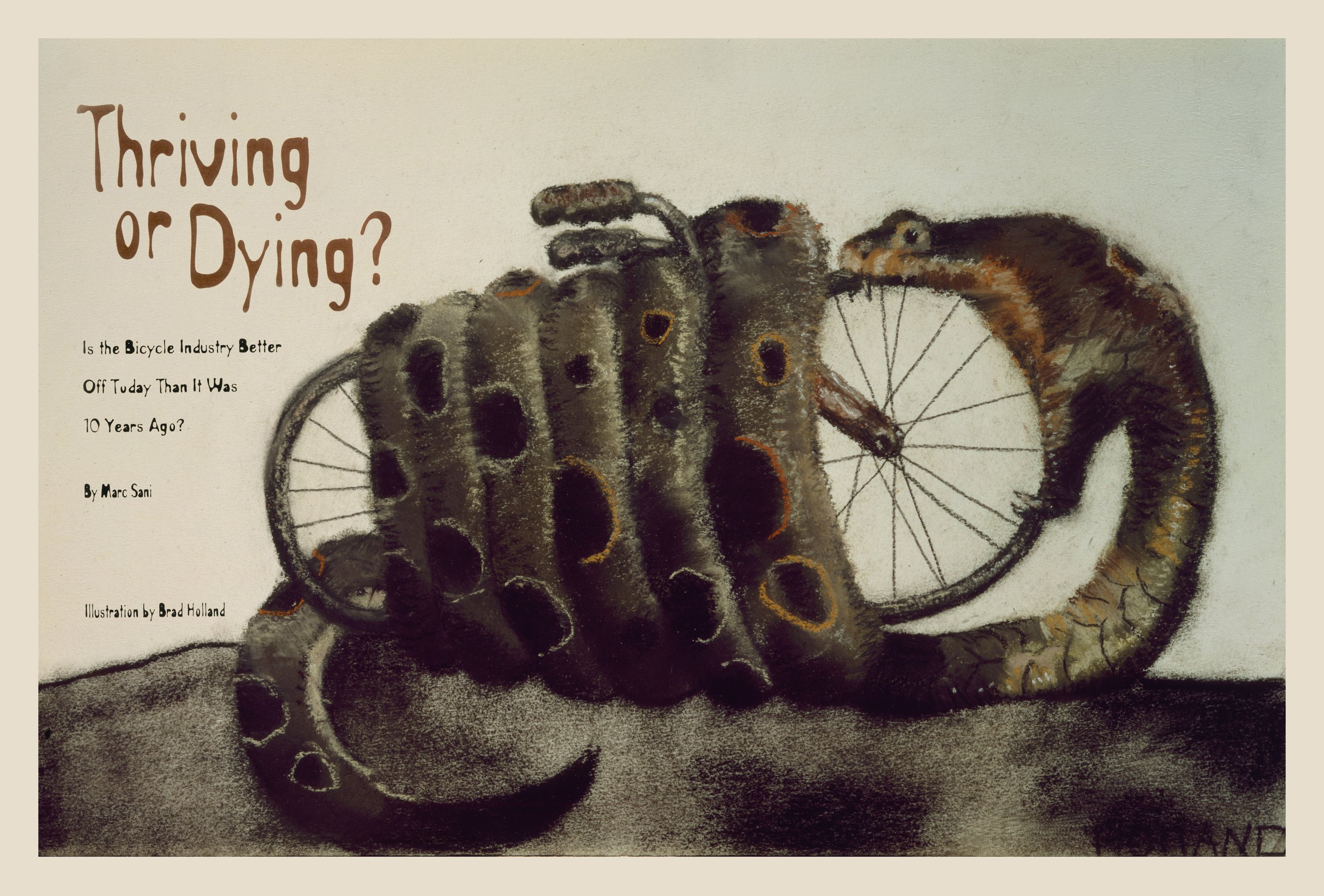
Steven Heller: So this show is Print is Dead. Is print dead?
Brad Holland: No. Now with the internet, well if the internet isn’t the end of Western civilization, which I do have a bet on, what has to happen is we need, the kind of people, art directing the internet that you and Suares and Art Paul and Dugald Sturmer and Richard Gangel. There were five art directors who really made a big difference back in the 1960s. And you were certainly one of them. We need people with that kind of clout working for internet publications.
Internet publications still have to work through the firewall issue.
Magazines need to find some way to get subscribers, and then they need to get through the technical problems. I did some work for a corporation and we went through all the spaces: that if I do the picture, this size, it’ll run in this format, on this device and this format on that device. So there’s still some technical problems that have to be solved with internet graphics, but we need the kind of independence on the internet that we were able to find in magazines.
We need to keep the tech companies from doing away with copyright. As you know, I got very involved in all this nonsense 20 years ago, much to my chagrin because I never wanted to be part of this. I ended up testifying before Congress, both the house and Senate, and we ended up fighting. We stopped the bill from passing, but the so-called “orphan-works” bill would have orphaned every work on the internet, not just from artists, but from ordinary people.
You know, if you put a picture on a Facebook page, that would have been an orphan, unless you had registered it, picture by picture by picture by picture. You would have had to have filled out a form and registered it with a commercial registry. They were introducing a law that would have allowed a so-called derivative work to be made out of any picture they took off the internet. So you could put a picture on a church social networking site or an internet site, some kind of Facebook page, and these internet spiders could harvest that work, declare it an orphan, plop an O on it.—it looked like a copyright symbol with an O on it.
And it would have been fair use for anyone to use. Stock companies could have taken those pictures, made slight changes called derivative works, which would have been legal, then copyright at that work in their own name, and then had machines crawl the internet to sue anybody who used one of their pictures.
You could have been technically sued, presumably for using your own picture if you had used a version of it that they had doctored in the internet,
Steven Heller: The internet has provided a lot of problems for creative people and non-creative people. I mean, the internet is an open pit of danger.
Brad Holland: Yes it is. And companies like Google are trying to make it more dangerous. They want it to open everything. The internet now allows you to take any of my pictures off the internet and use them for private usage. You know, you can’t do anything about that. And I wouldn’t want to, but this law, actually, the Senate passed a 20-page bill that we got down, It was going to open usage to all, all usage, any commercial usage, we got it rewritten to be for non-commercial uses. Then we heard that they had made one change. They only made one change to the bill, and they were going to vote on it. Well, they wouldn’t tell us what the one change was. So we had to look through the 20-page bill and sure enough, they had changed the word “non-commercial” to “commercial.” That one change to the bill would have opened everybody’s work workup for commercial usage, which meant that anything on the internet could have been used anybody for commercial purposes.
Steven Heller: What is the satisfaction or joy that you get from being an illustrator, from being an artist?
Brad Holland: I’m doing the same thing I did when I was five years old. Really. When I was five, I used to listen to the radio. We didn’t have a TV in those days, TV didn’t come until I was six. So I was doing comic strips. When I was four or five years old, like I loved L’il Abner. That was my favorite comic strip.
I wanted to do things like draw Lower Slobbovia and create characters like the Shmoo. I was a big L’il Abner fan and so I was doing comic scripts until I decided I wanted to do Walt Disney movies. and then I wanted to go to Disney, except that when I started thinking about Disney, I didn’t know what to do. I knew I wanted to write the stories, I wanted to animate the scenes, and I wanted to paint the backgrounds. Ha! Fat chance I would have ever done that at Disney. Once I got to Chicago and saw the Art Institute and began to see real art, my attitude about that changed. And since then, all I’ve wanted to do was do what I did when I was five, with the values that I’ve picked up along the way.
And I’m still doing it: I’m a mature five-year-old is what I am. I’ve gotten away with it all this time. Imagine that.





